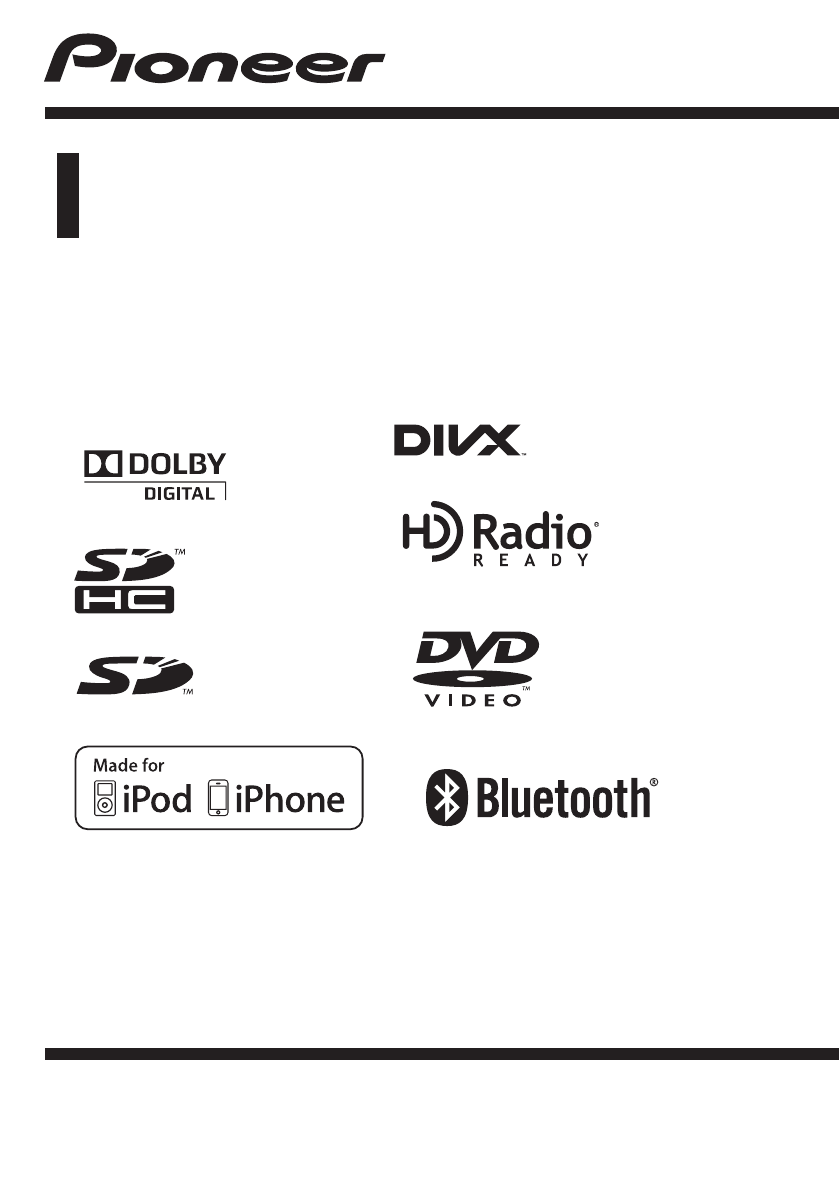User manual
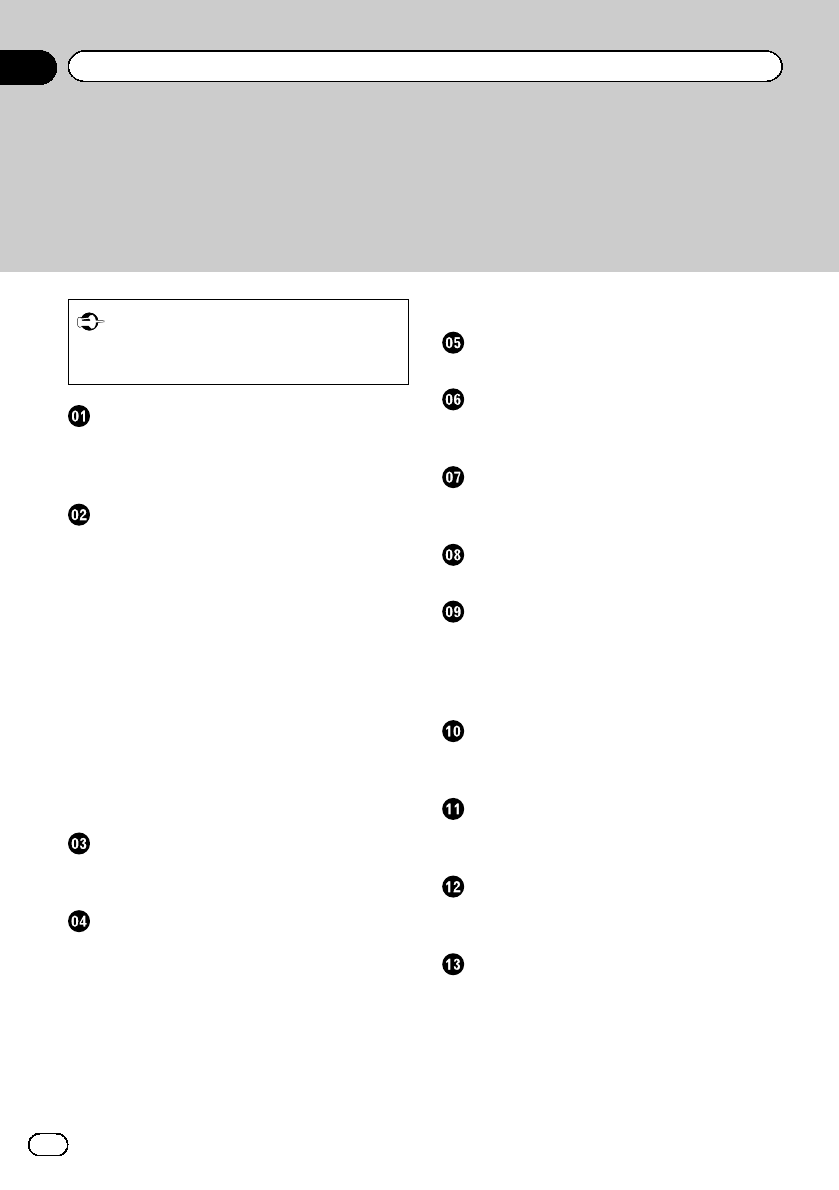
Thank you for purchasing this PIONEER product.
To ensure proper use, please read through this manual before using this product. It
is especially important that you read and observe WARNINGs and CAUTIONsin
this manual. Please keep the manual in a safe and accessible place for future refer-
ence.
Be sure to read this
!DVD video disc region numbers 8
!Handling guidelines 93
Precautions
IMPORTANT SAFEGUARDS 5
To ensure safe driving 5
To avoid battery exhaustion 6
Before you start
Information to User 7
For Canadian model 7
The Safety of Your Ears is in Your Hands 7
About this unit 7
About this manual 8
Operating environment 8
After-sales service for Pioneer products 8
Visit our website 9
Resetting the microprocessor 9
Demo mode 10
Adjusting the response positions of the
touch panels (Touch Panel
Calibration) 10
Use and care of the remote control 10
What’s what
Head unit 12
Remote control 13
Basic operations
Basic operations of this unit 14
Operating the scroll icon and the scrubber
bar 15
Activating the touch panel keys 15
Common operations for menu settings/
lists 15
Opening and closing the LCD panel 16
Ejecting a disc 16
Ejecting an SD 16
Setting the clock 16
Tuner
Introduction of tuner operations 17
Playing moving images
Introduction of video playback
operations 18
Playing audio
Introduction of sound playback
operations 21
Using Pandoraâ
Introduction of Pandora operations 23
Playing still images
Introduction of still image playback
operations 25
Introduction of still image playback as a
slideshow operations 26
Bluetooth Telephone
Introduction of Bluetooth telephone
operations 27
XM/SIRIUS tuner
Introduction of XM/SIRIUS tuner
operations 29
HD Radioätuner
Introduction of HD Radioätuner
operations 31
Detailed instructions
Storing and recalling stations 32
Storing the strongest stations 32
Tuning in to strong signals 32
Tuning in to strong HD Radio signals 32
Using iTunes tagging 33
Switching the media file type 33
Operating the DVD menu 34
Contents
En
2
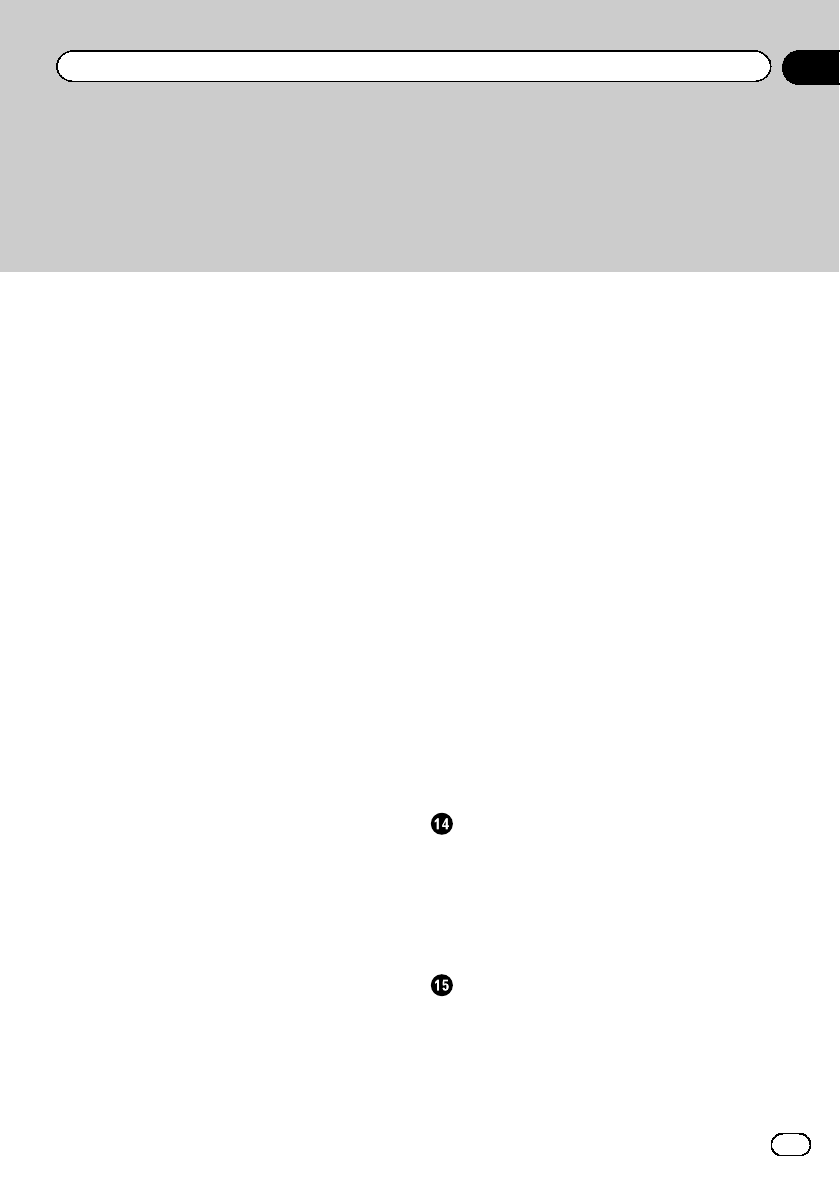
Operating this unit’s iPod function from your
iPod 34
Random play (shuffle) 35
Playing all songs in random order (shuffle
all) 35
Repeating playback 35
Playing videos from your iPod 35
Browsing for a video/music on the iPod 36
Resume playback (Bookmark) 37
Frame-by-frame playback 37
Slow motion playback 37
Searching for the part you want to play 37
Changing audio language during playback
(Multi-audio) 37
Changing the subtitle language during
playback (Multi-subtitle) 38
Changing the viewing angle during playback
(Multi-angle) 38
Return to the specified scene 38
Selecting audio output 38
PBC playback 38
Selecting tracks from the track title list 39
Selecting files from the file name list 39
Using S.Rtrv (sound retriever) 39
Changing audiobook speed 39
Displaying lists related to the currently
playing song (Link Search) 39
Playing DivXâVOD content 40
Capture an image in JPEG files 40
Changing the wide screen mode 40
Selecting and playing the QuickMix/station
list 41
Storing song information (bookmarks) 41
Switching the XM/SIRIUS channel selection
mode 42
Selecting an XM/SIRIUS channel directly 42
Using the MyMix function 43
Using the Game Alert function 45
Displaying the Radio ID 46
Switching the SIRIUS display 46
Using the Instant Replay function 46
Switching the seek mode 46
Switching the reception mode 46
Calling a number in the phone book 47
Selecting a number by alphabet search
mode 47
Using the missed, received and dialed call
lists 48
Setting automatic answering 48
Adjusting the other party’s listening
volume 48
Switching the ring tone 48
Using the preset dial lists 48
Making a call by entering phone number 49
Setting the private mode 49
Pairing from this unit 49
Using a Bluetooth device to pair 50
Connecting to a Bluetooth device
automatically 51
Switching visible unit 51
Displaying Bluetooth Device address 51
Entering PIN code for Bluetooth wireless
connection 51
Menu operations
Introduction of menu operations 52
Audio Adjustments 53
Setting up the DVD player 56
System settings 60
Entertainment settings 66
Customizing menus 67
Other Functions
Changing the picture adjustment 68
Setting rear monitor output 68
Adjusting the response positions of the
touch panels (Touch Panel
Calibration) 69
Using an AUX source 69
En 3
Contents

Using an external unit 70
Installation
Connecting the units 71
Installation 80
Additional Information
Troubleshooting 84
Error messages 86
Understanding auto EQ error messages 90
Understanding messages 90
Indicator list 91
Handling guidelines 93
Compressed audio compatibility (disc, USB,
SD) 95
iPod compatibility 96
Sequence of audio files 97
Using the display correctly 97
Copyright and trademark 98
Language code chart for DVD 101
Specifications 102
Contents
En
4
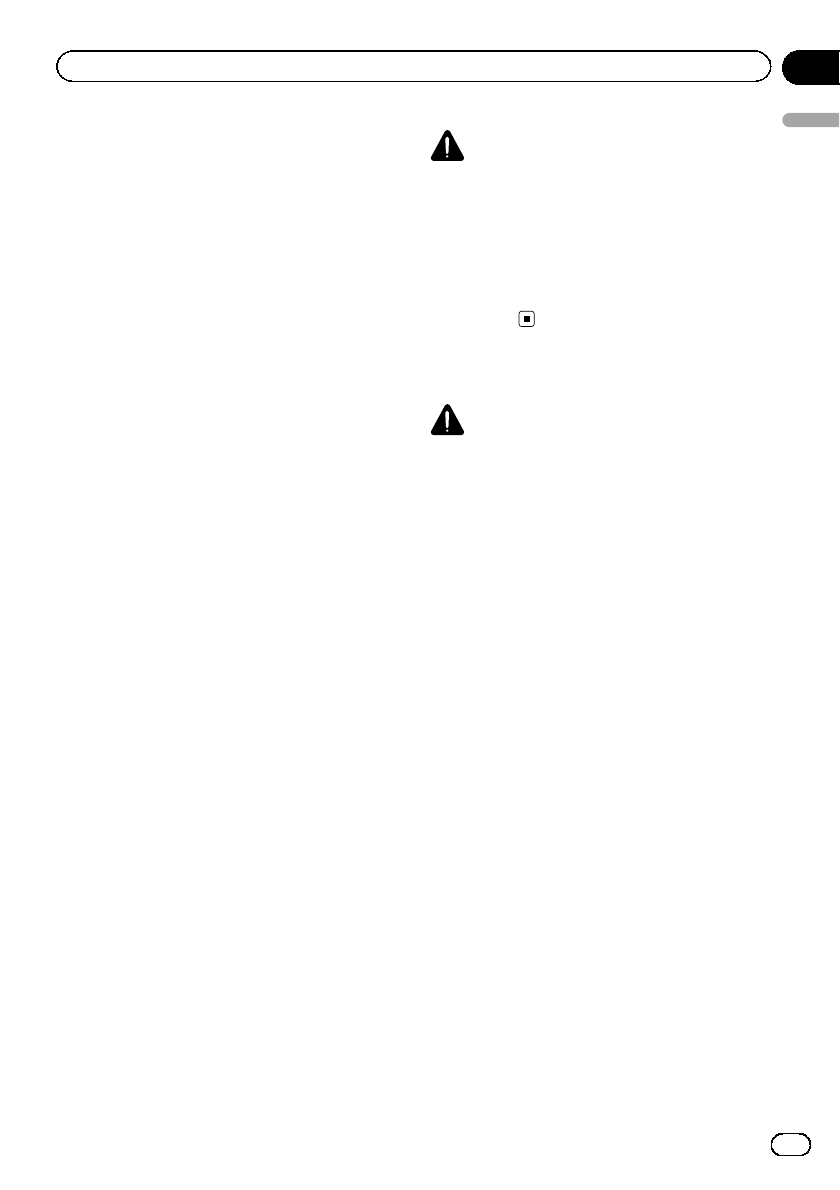
IMPORTANT SAFEGUARDS
Please read all of these instructions regarding
your display and retain them for future refer-
ence.
1Read this manual fully and carefully be-
fore operating your display.
2Keep this manual handy as a reference for
operating procedures and safety informa-
tion.
3Pay close attention to all warnings in this
manual and follow the instructions care-
fully.
4Do not allow other persons to use this sys-
tem until they have read and understood
the operating instructions.
5Do not install the display where it may (i)
obstruct the driver’s vision, (ii) impair the
performance of any of the vehicle’s oper-
ating systems or safety features, includ-
ing air bags, hazard lamp buttons or (iii)
impair the driver’s ability to safely oper-
ate the vehicle.
6Do not operate this display if doing so in
any way will divert your attention from
the safe operation of your vehicle. Always
observe safe driving rules and follow all
existing traffic regulations. If you experi-
ence difficulty in operating the system or
reading the display, park your vehicle in a
safe location and make necessary adjust-
ments.
7Please remember to wear your seat belt at
all times while operating your vehicle. If
you are ever in an accident, your injuries
can be considerably more severe if your
seat belt is not properly buckled.
8Never use headphones while driving.
9To promote safety, certain functions are
disabled unless the parking brake is on,
and the vehicle is not in motion.
10 Never set the volume of your display so
high that you cannot hear outside traffic
and emergency vehicles.
WARNING
!Do not attempt to install or service your
display by yourself. Installation or servi-
cing of the display by persons without
training and experience in electronic
equipment and automotive accessories
may be dangerous and could expose you
to the risk of electric shock or other
hazards.
To ensure safe driving
WARNING
!LIGHT GREEN LEAD AT POWER CON-
NECTOR IS DESIGNED TO DETECT
PARKED STATUS AND MUST BE CON-
NECTED TO THE POWER SUPPLY SIDE
OF THE PARKING BRAKE SWITCH. IM-
PROPER CONNECTION OR USE OF
THIS LEAD MAY VIOLATE APPLICABLE
LAW AND MAY RESULT IN SERIOUS IN-
JURY OR DAMAGE.
!To avoid the risk of damage and injury and the
potential violation of applicable laws, this unit
is not for use with a video screen that is visible
to the driver.
!To avoid the risk of accident and the potential
violation of applicable laws, no viewing of
front seat video should ever occur while the
vehicle is being driven.
!In some countries or states the viewing of
images on a display inside a vehicle even by
persons other than the driver may be illegal.
Where such regulations apply, they must be
obeyed and this unit’s DVD features should
not be used.
When you attempt to watch a video image
while driving, the warning Viewing of front
seat video source while driving is strictly
prohibited. will appear on the front display.
To watch a video image on the front display,
park your vehicle in a safe place and apply the
parking brake.
En 5
Section
01
Precautions
Precautions
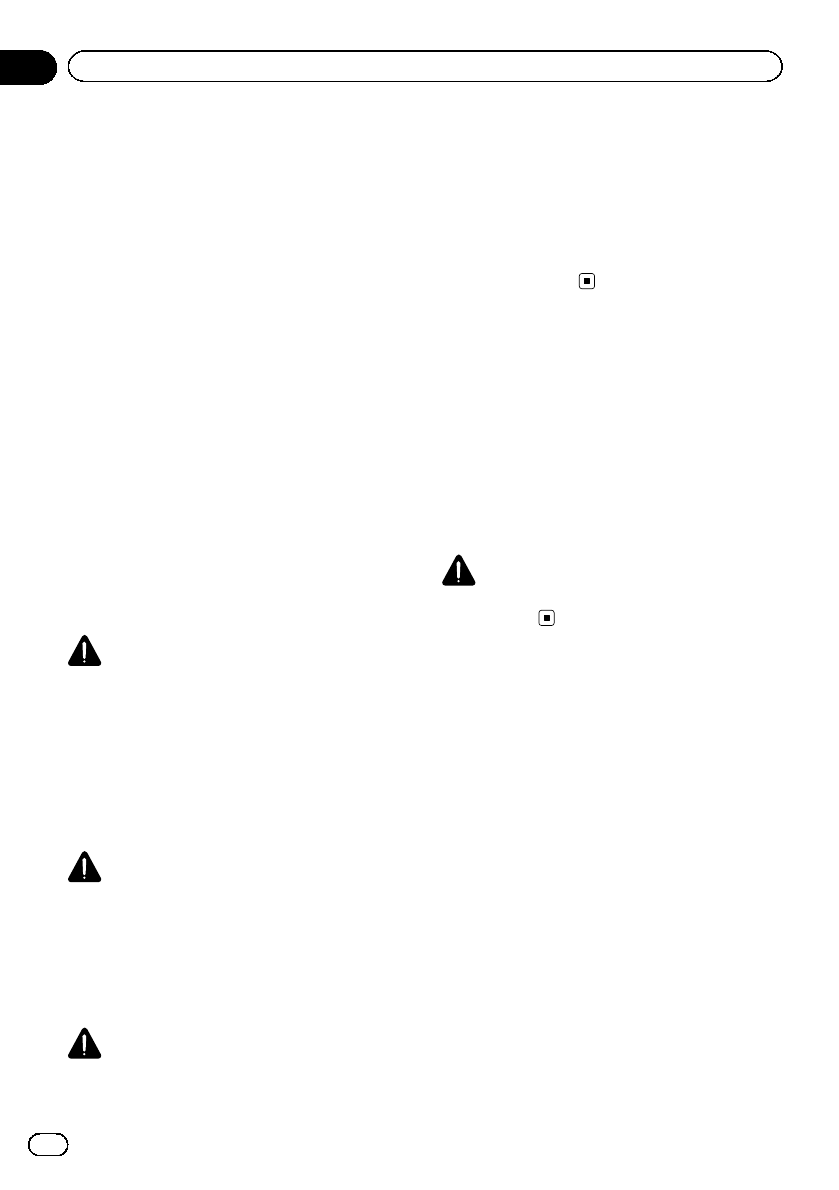
Parking brake interlock
Certain functions (Video viewing and certain
touch panel keys) offered by this unit could be
dangerous and/or unlawful if used while driv-
ing. To prevent such functions from being
used while the vehicle is in motion, there is an
interlock system that senses when the parking
brake is set. If you attempt to use the functions
described above while driving, they will be-
come disabled until you stop the vehicle in a
safe place, and (1) apply the parking brake, (2)
release the parking brake, and then (3) apply
the parking brake again. Please keep the
brake pedal pushed down before releasing the
parking brake.
When using a display connected
to REAR MONITOR OUTPUT
Passengers in the rear seat can also watch
moving images or still images if you connect
this unit to a display using the REAR MONI-
TOR OUTPUT.
WARNING
NEVER install the rear display in a location
where the driver can watch a DVD while driving.
When using the rear view camera
With an optional rear view camera, this unit
can be used as an aid to keep an eye on trai-
lers, or when backing into a tight parking spot.
WARNING
!SCREEN IMAGE MAY APPEAR RE-
VERSED.
!USE INPUT ONLY FOR REVERSE OR
MIRROR IMAGE REAR VIEW CAMERA.
OTHER USE MAY RESULT IN INJURY
OR DAMAGE.
CAUTION
!The rear view camera function is to be used
as an aid to keep an eye on trailers, or while
backing up. Do not use for entertainment pur-
poses.
!Please note that the edges of the rear view
camera images may differ slightly according
to whether full screen images are displayed
when backing up, and whether the images are
used for checking the rear when the vehicle is
moving forward.
To avoid battery exhaustion
Keep the vehicle engine running when using
this unit to avoid draining the battery power.
!When no power is supplied to this unit,
such as when the vehicle battery is being
replaced, the microcomputer of this unit re-
turns to its initial condition. We recom-
mend that you transcribe the audio
adjustment data.
WARNING
Do not use with vehicles that do not feature an
ACC position.
En
6
Section
01 Precautions
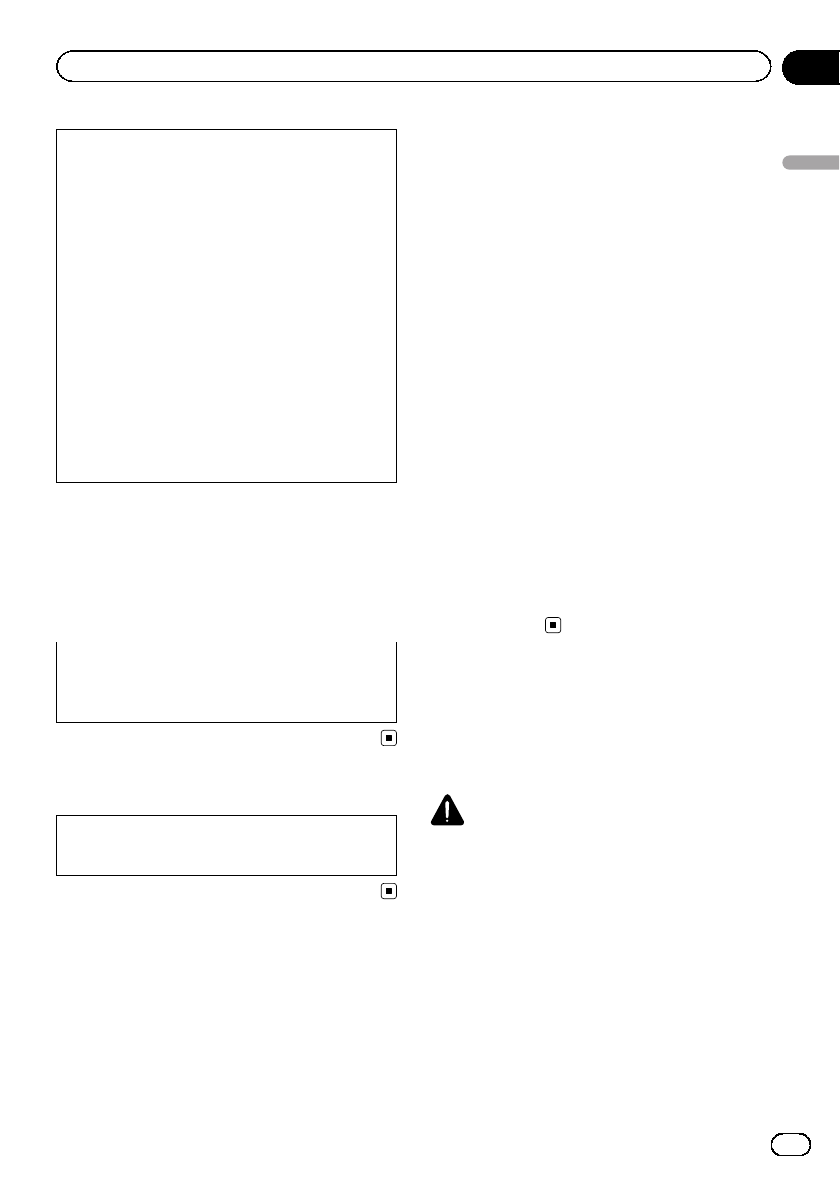
FCC ID: AJDK034
MODEL NO.: AVH-P6300BT
IC: 775E-K034
This equipment complies with FCC/IC radiation
exposure limits set forth for an uncontrolled
environment and meets the FCC radio fre-
quency (RF) Exposure Guidelines in Supple-
ment C to OET65 and RSS-102 of the IC radio
frequency (RF) Exposure rules. This equipment
has very low levels of RF energy that it deemed
to comply without maximum permissive expo-
sure evaluation (MPE). But it is desirable that
it should be installed and operated keeping the
radiator at least 20 cm or more away from per-
son’s body (excluding extremities: hands,
wrists, feet and ankles).
This transmitter must not be co-located or op-
erated in conjunction with any other antenna
or transmitter.
Information to User
Alteration or modifications carried out without
appropriate authorization may invalidate the
user’s right to operate the equipment.
For Canadian model
This Class B digital apparatus complies with
Canadian ICES-003.
The Safety of Your Ears is in
Your Hands
Get the most out of your equipment by playing
it at a safe level—a level that lets the sound
come through clearly without annoying blar-
ing or distortion and, most importantly, with-
out affecting your sensitive hearing. Sound
can be deceiving. Over time, your hearing
“comfort level”adapts to higher volumes of
sound, so what sounds “normal”can actually
be loud and harmful to your hearing. Guard
against this by setting your equipment at a
safe level BEFORE your hearing adapts.
ESTABLISH A SAFE LEVEL:
!Set your volume control at a low setting.
!Slowly increase the sound until you can
hear it comfortably and clearly, without dis-
tortion.
!Once you have established a comfortable
sound level, set the dial and leave it there.
BE SURE TO OBSERVE THE FOLLOWING
GUIDELINES:
!Do not turn up the volume so high that you
can’t hear what’s around you.
!Use caution or temporarily discontinue use
in potentially hazardous situations.
!Do not use headphones while operating a
motorized vehicle; the use of headphones
may create a traffic hazard and is illegal in
many areas.
About this unit
The tuner frequencies on this unit are allo-
cated for use in North America. Use in other
areas may result in poor reception.
WARNING
Handling the cord on this product or cords asso-
ciated with accessories sold with the product
may expose you to chemicals listed on proposi-
tion 65 known to the State of California and other
governmental entities to cause cancer and birth
defect or other reproductive harm. Wash hands
after handling.
En 7
Section
02
Before you start
Before you start
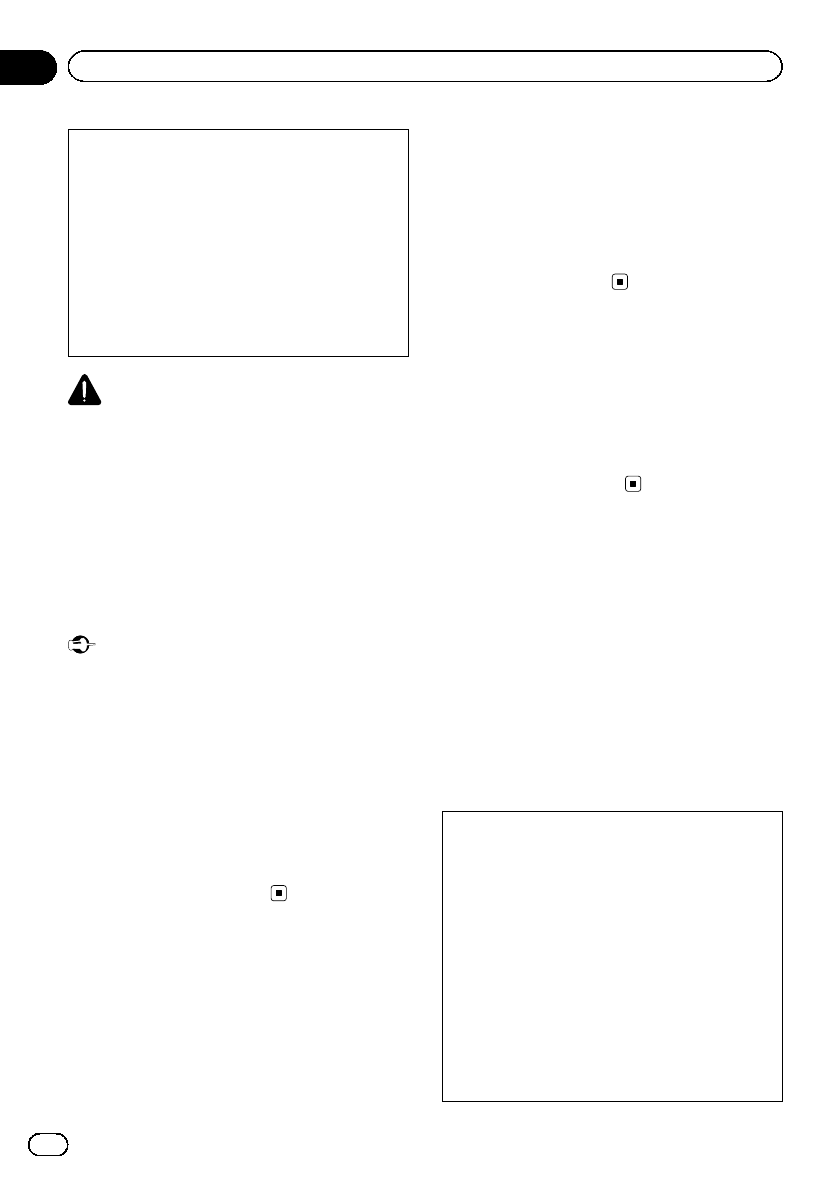
CAUTION:
USE OF CONTROL OR ADJUSTMENT OR
PERFORMANCE OF PROCEDURES
OTHER THAN THOSE SPECIFIED HEREIN
MAY RESULT IN HAZARDOUS RADIATION
EXPOSURE.
CAUTION:
THE USE OF OPTICAL INSTRUMENTS
WITH THIS PRODUCT WILL INCREASE
EYE HAZARD.
CAUTION
!Do not allow this unit to come into contact
with liquids. Electrical shock could result.
Also, damage to this unit, smoke, and over-
heating could result from contact with liquids.
!Keep this manual handy for future reference.
!Always keep the volume low enough to hear
outside sounds.
!Avoid exposure to moisture.
!If the battery is disconnected or discharged,
any preset memory will be erased.
Important (Serial number)
The serial number is located on the bottom of
this unit. For your own security and convenience,
be sure to record this number on the enclosed
warranty card.
DVD video disc region numbers
Only DVD video discs with compatible region
numbers can be played on this player. You can
find the region number of the player on the
bottom of this unit and in this manual (refer to
Specifications on page 102).
About this manual
This unit features a number of sophisticated
functions to ensure superior reception and op-
eration. All the functions have been designed
for the easiest possible use, but many are not
self-explanatory. This operation manual will
help you benefit fully from this unit’s potential
and to maximize your listening enjoyment.
We recommend that you familiarize yourself
with the functions and their operation by read-
ing through the manual before you begin
using this unit. It is especially important that
you read and observe WARNINGs and CAU-
TIONs in this manual.
Operating environment
This unit should be used within the tempera-
ture ranges shown below.
Operating temperature range: –10 °C to +60 °C
(14 °F to 140 °F)
EN300328 ETC test temperature: –20 °C and
+55 °C (–4 °F and 131 °F)
After-sales service for
Pioneer products
Please contact the dealer or distributor from
where you purchased this unit for after-sales
service (including warranty conditions) or any
other information. In case the necessary infor-
mation is not available, please contact the
companies listed below:
Please do not ship your unit to the companies
at the addresses listed below for repair without
advance contact.
U.S.A.
Pioneer Electronics (USA) Inc.
CUSTOMER SUPPORT DIVISION
P.O. Box 1760
Long Beach, CA 90801-1760
800-421-1404
CANADA
Pioneer Electronics of Canada, Inc.
CUSTOMER SATISFACTION DEPARTMENT
300 Allstate Parkway
Markham, Ontario L3R 0P2
1-877-283-5901
905-479-4411
En
8
Section
02 Before you start
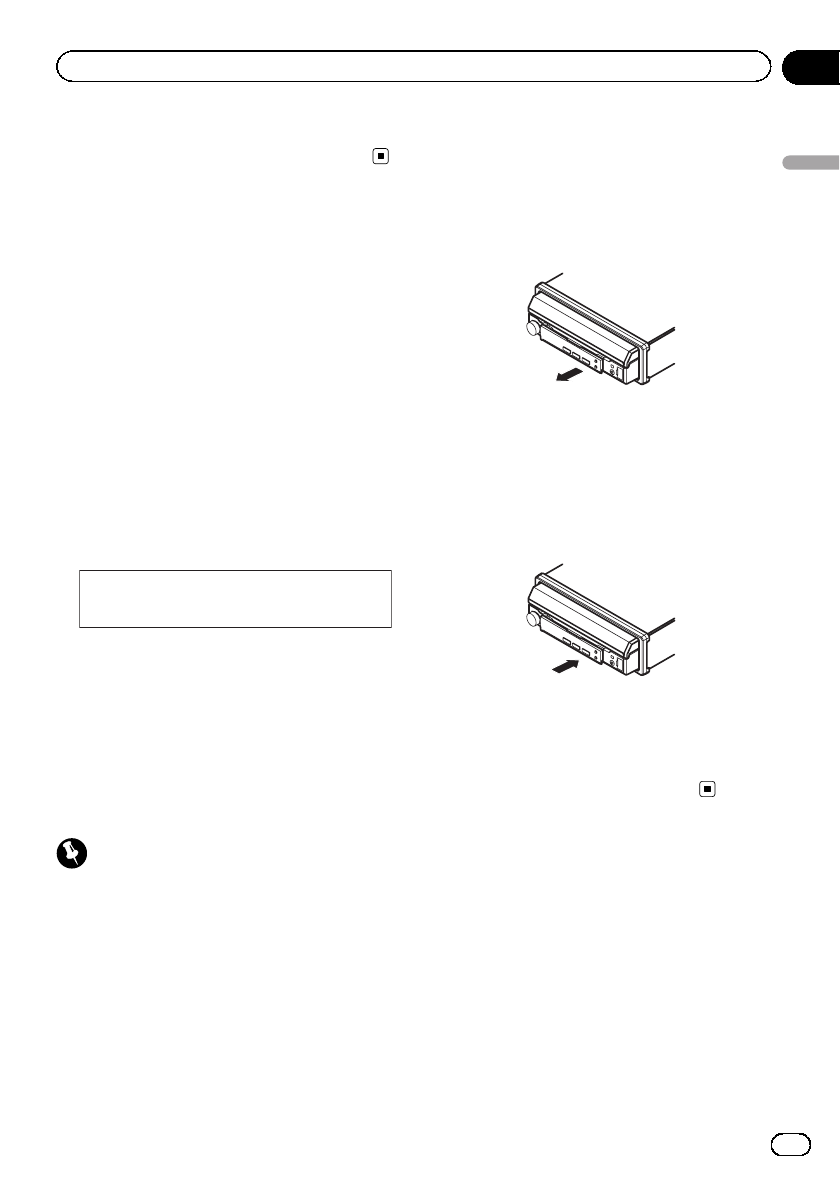
For warranty information please see the Lim-
ited Warranty sheet included with this unit.
Visit our website
Visit us at the following site:
http://www.pioneerelectronics.com
1 Register your product. We will keep the details
of your purchase on file to help you refer to
this information in the event of an insurance
claim such as loss or theft.
2 Receive updates on the latest products and
technologies.
3 Download owner’s manuals, order product
catalogues, research new products, and
much more.
4 Your feedback is important in our continual ef-
fort to design and build the most advanced,
consumer-focused product in the industry.
Serial number
Protecting your unit from theft
The front panel can be detached to deter theft.
!If the front panel is not detached from the
head unit within four seconds of turning off
the ignition, a warning tone will sound.
!You can turn off the warning tone. Refer to
Switching the warning tone on page 63.
Important
!Handle gently when removing or attaching
the front panel.
!Avoid subjecting the front panel to excessive
shock.
!Keep the front panel out of direct sunlight and
high temperatures.
!If removed, replace the front panel on the unit
before starting up your vehicle.
!To avoid damaging the device or vehicle inter-
ior, remove any cables and devices attached
to the front panel before detaching it.
Removing the front panel
%Pinch the top and bottom of its right
side and pull the front panel out.
Take care not pinch it too tightly or to drop it,
and also avoid contact with water or other
fluids to prevent permanent damage.
Re-attaching the front panel
1 Slide the front panel to the left.
The front panel and the head unit are con-
nected on the left side. Make sure that the
front panel has been properly connected to
the head unit.
2 Press the right side of the front panel
until it is firmly seated.
#If you can’t attach the front panel to the head
unit successfully, try again. Forcing the front
panel into place may result in damage.
Resetting the microprocessor
By pressing RESET, you can reset the micro-
processor to its initial settings without chan-
ging the bookmark information.
The microprocessor must be reset in the fol-
lowing situations:
!Before using this unit for the first time after
installation
!If the unit fails to operate properly
!When strange or incorrect messages ap-
pear on the display
En 9
Section
02
Before you start
Before you start
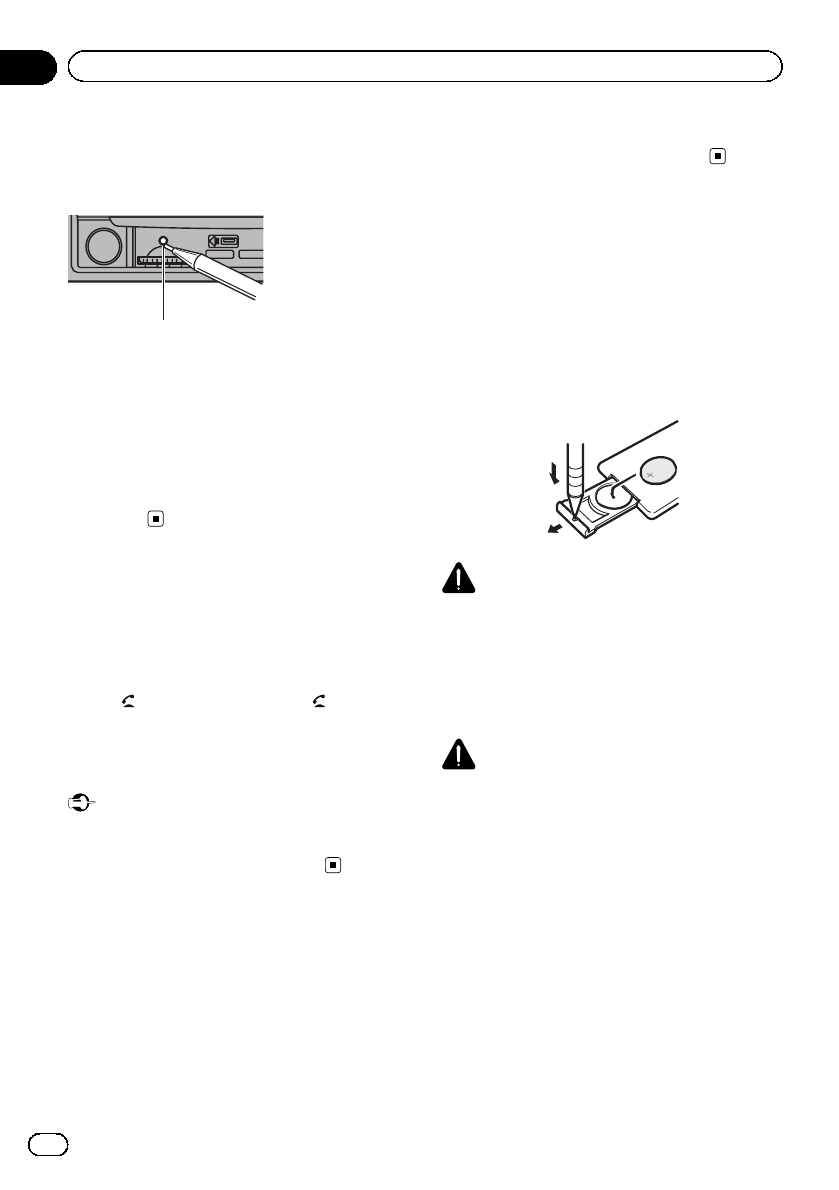
1 Turn the ignition switch OFF.
2 Press RESET with a pen tip or other
pointed instrument.
RESET button
Note
Switch your engine ON or set the ignition switch
to ACC ON before pressing RESET in the follow-
ing situations:
!After completing connections
!When erasing all stored settings
!When resetting the unit to its initial (factory)
settings
Demo mode
The feature demo automatically starts when
you select Off for the source and continues
while the ignition switch is set to ACC or ON.
To cancel the feature demo, press and hold
MUTE/. Press and hold MUTE/ again to
restart. Operating the feature demo while the
car engine is turned off it may drain the bat-
tery power.
Important
Failure to connect the red lead (ACC) of this unit
to a terminal coupled with ignition switch on/off
operations may lead to battery drain.
Adjusting the response
positions of the touch panels
(Touch Panel Calibration)
If you feel that the touch panel keys on the
screen deviate from the actual positions that
respond to your touch, adjust the response po-
sitions of the touch panel. Refer to Adjusting
the response positions of the touch panels
(Touch Panel Calibration) on page 69.
Use and care of the remote
control
Installing the battery
Slide the tray on the back of the remote con-
trol out and insert the battery with the plus (+)
and minus (–) poles aligned properly.
!When using for the first time, pull out the
film protruding from the tray.
WARNING
!Keep the battery out of the reach of children.
Should the battery be swallowed, consult a
doctor immediately.
!Batteries (battery pack or batteries installed)
must not be exposed to excessive heat such
as sunshine, fire or the like.
CAUTION
!Use one CR2025 (3 V) lithium battery.
!Remove the battery if the remote control is not
used for a month or longer.
!There is a danger of explosion if the battery is
incorrectly replaced. Replace only with the
same or equivalent type.
!Do not handle the battery with metallic tools.
!Do not store the battery with metallic objects.
!If the battery leaks, wipe the remote control
completely clean and install a new battery.
!When disposing of used batteries, comply
with governmental regulations or environmen-
tal public institutions’rules that apply in your
country/area.
En
10
Section
02 Before you start

!“Perchlorate Material –special handling may
apply.
See www.dtsc.ca.gov/hazardouswaste/
perchlorate. (Applicable to California, U.S.A.)”
Using the remote control
Point the remote control in the direction of the
front panel to operate.
Important
!Do not store the remote control in high tem-
peratures or direct sunlight.
!The remote control may not function properly
in direct sunlight.
!Do not let the remote control fall onto the
floor, where it may become jammed under the
brake or accelerator pedal.
En 11
Section
02
Before you start
Before you start
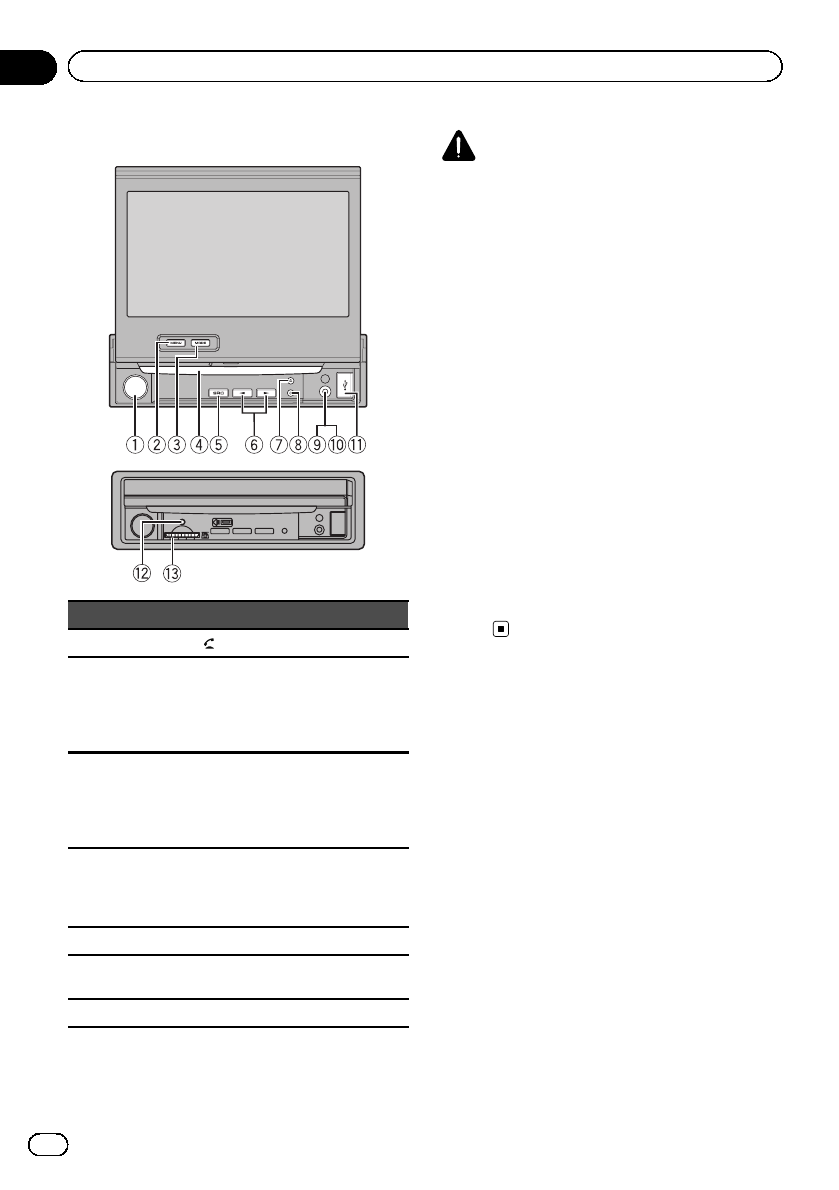
Head unit
Part Part
1Volume/MUTE/8OPEN/CLOSE
2
MENU
Displaying the
menu.
Returning to the
normal display.
9
AUX input jack
(3.5 mm stereo/
video jack)
Use to connect an
auxiliary device.
3
MODE
Turning the infor-
mation display off.
a
Auto EQ micro-
phone input jack
Use to connect an
auto EQ micro-
phone.
4Disc loading slot b
USB port
When connecting,
open the USB con-
nector lid.
5SRC/OFF cRESET
6c/d(TRACK/
SEEK)dSD memory card
slot
7h(eject)
CAUTION
!Use an optional Pioneer USB cable (CD-U50E)
to connect the USB audio player/USB mem-
ory as any device connected directly to the
unit will protrude out from the unit and may
be dangerous.
!Do not use unauthorized products.
Notes
!Insert it with the contact surface facing down,
and press on the card until it clicks and com-
pletely locks into place.
!When the navigation system is connected,
press MODE to switch to the navigation dis-
play. Press MODE and hold to turn the display
off.
Press MODE again to turn the display on.
!Press and hold MENU to display
Picture Adjustment.
Refer to Changing the picture adjustment on
page 68.
!For details on how to operate a navigation sys-
tem from this unit, refer to its operation man-
ual.
En
12
Section
03 What’s what
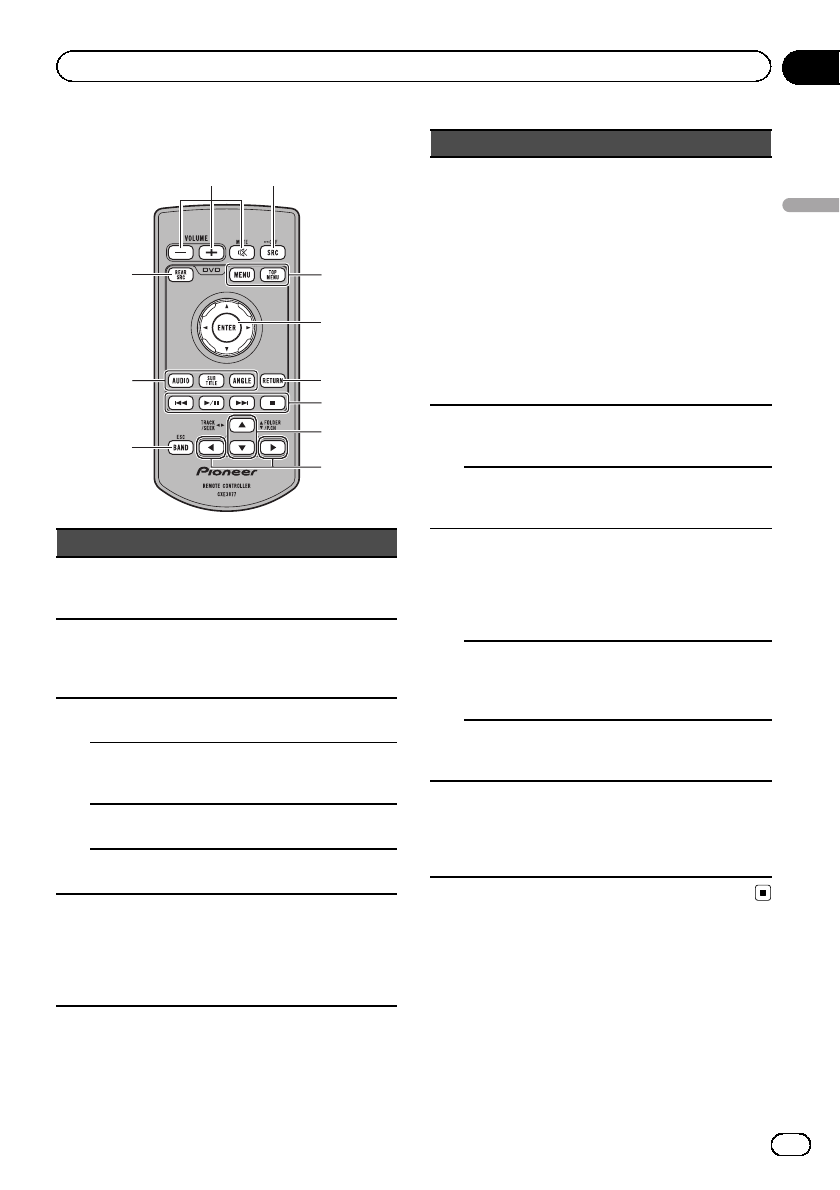
Remote control
1 5
6
Part Operation
1Thumb pad
Click to recall Menu.
Use to select a menu
on the DVD menu.
2RETURN
Press to display the
PBC (playback con-
trol) menu during PBC
playback.
3
fPress to pause or re-
sume playback.
o
Press to return to the
previous track (chap-
ter).
pPress to go to the next
track (chapter).
gPress to stop play-
back.
4a/b(FOLDER/P.CH)
Press to select the
next/previous folder.
Press to recall radio
station frequencies as-
signed to preset tun-
ing keys.
Part Operation
5BAND/ESC
Press to select the
tuner band when
tuner is selected as a
source. Also used to
cancel the control
mode of functions.
Press to switch be-
tween modes when
playing discs with
compressed audio
and audio data (CD-
DA) such as CD-
EXTRA and MIXED-
MODE CDs.
6
MENU
Press to display the
DVD menu during
DVD playback.
TOP MENU
Press to return to the
top menu during DVD
playback.
7
AUDIO
Press to change the
audio language during
DVD playback.
Press to switch audio
output for Video CD/
DivX.
SUBTITLE
Press to change the
subtitle language dur-
ing DVD/DivX play-
back.
ANGLE
Press to change the
viewing angle during
DVD playback.
8REAR SRC
Press to cycle through
all the available rear
sources.
Press and hold to turn
the rear source off.
En 13
Section
03
What’s what
What’s what
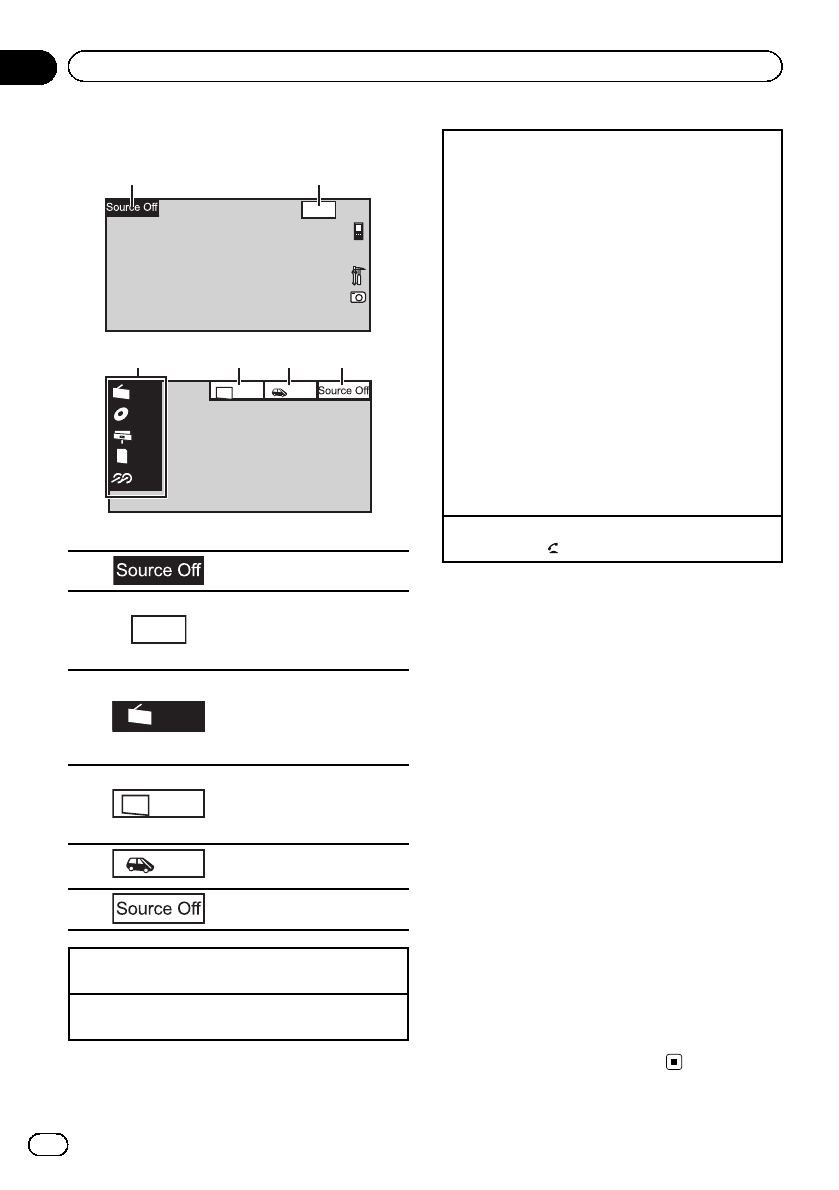
Basic operations of this unit
Wed 28 May
12:45 PM
1 2
Radio
Disc
iPod
SD
AUX
SD
Rear
View
Rear Front
3 54 6
Touch panel keys
1Displaying the source menu.
2Wed 28 May
12:45 PM
Switching to clock adjust-
ment display.
Refer to Setting the clock on
page 16.
3
Radio
Source icon
Selecting a favorite source.
When the source icon is not
displayed, it can be displayed
by touching the screen.
4Rear Front
Switching the output source
for the rear monitor.
Refer to Setting rear monitor
output on page 68.
5Rear
View
Switching the rear view
image on or off.
6Turning the unit off.
Turning the unit on using the buttons
1Press SRC/OFF to turn the unit on.
Turning the unit off using the buttons
1Press SRC/OFF and hold until the unit turns off.
Selecting a source using the buttons
1Press SRC/OFF to cycle through the sources
listed below:
Selecting a source using the touch panel keys
1Touch the source icon and then touch the desired
source name.
!XM –XM tuner
!Sirius –SIRIUS tuner
!Radio/HD Radio –Radio/Digital Radio tuner
!AV –AV input
!Disc –Built-in DVD player
!USB/iPod –USB/iPod
!Pandora –Pandora
!SD –SD memory card
!EXT1 –External unit 1
!EXT2 –External unit 2
!AUX –AUX
!When the source icon is not displayed, it can be
displayed by touching the screen.
!While operating the menu, you cannot select a
source by touching the source icon.
Adjusting the volume
1Turn MUTE/to adjust the volume.
Notes
!In this manual, iPod and iPhone will be re-
ferred to as “iPod”.
!The USB/iPod icon will change as follows:
—USB is displayed when a USB storage de-
vice is connected.
—iPod is displayed when an iPod is con-
nected.
—USB/iPod is displayed when no device is
connected.
!When appropriately set up, the image from
the rear view camera can be displayed auto-
matically. For details, refer to Setting the rear
view camera (back up camera) on page 63.
!An external unit refers to a Pioneer product,
such as those which will be available in the fu-
ture. Although incompatible as a source, the
basic functions of up to two external units can
be controlled with this unit. When two exter-
nal units are connected, the external units are
automatically allocated to external unit 1 or
external unit 2.
!If the HD Radio tuner is connected to this
unit, tuner source is skipped.
En
14
Section
04 Basic operations
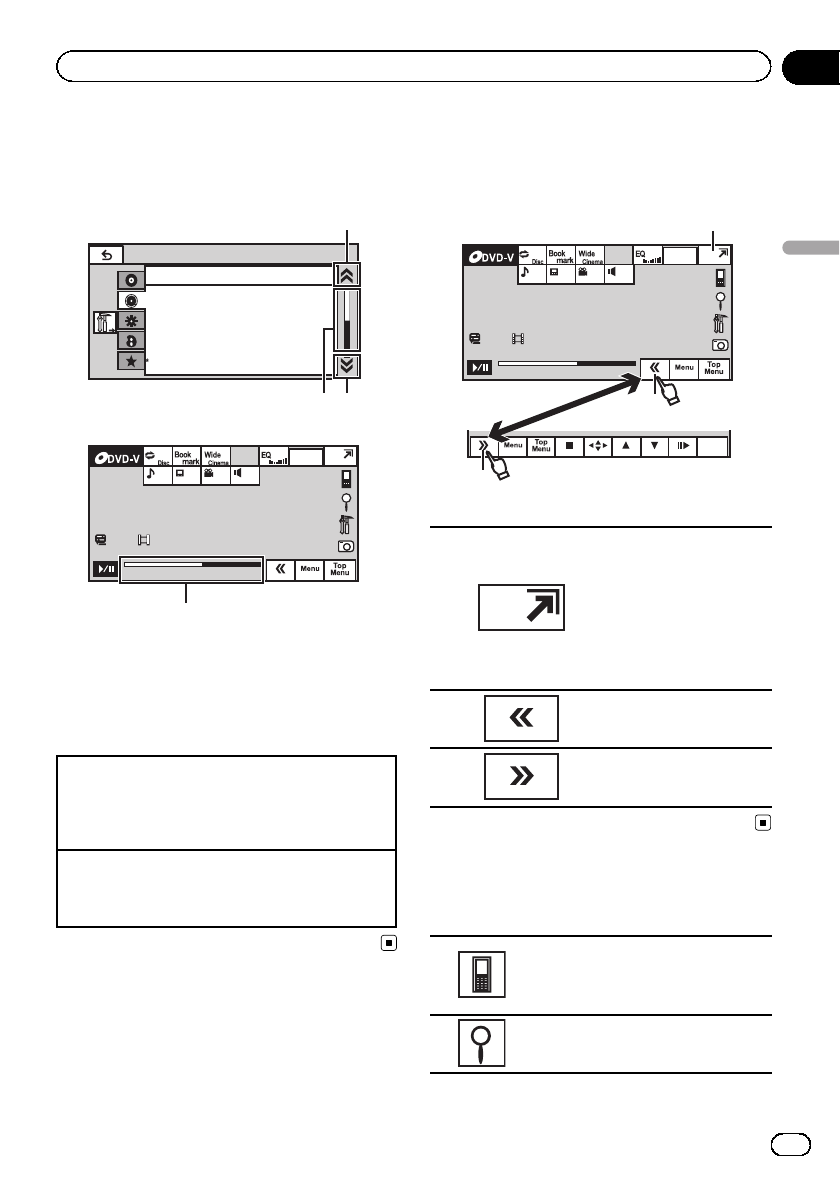
Operating the scroll icon
and the scrubber bar
Audio
Fader/Balance F/R 0 L/R 0
Super Bass
On
Graphic EQ
Auto EQ
High
Off
L/R 0Sonic Center Control
Loudness
Subwoofer
1
1
2
Wed 28 May
12:45 PM
01 01
812
01:45 -02:45
01 L+R
2
1Scroll icon
Appears when selectable items are hidden.
2Scrubber bar
Appears when the playback point can be spe-
cified or set by dragging.
Viewing the hidden items
1Touch the scroll icon or drag the scrubber bar to
view any hidden items.
!Also, you can drag the list to view any hidden
items.
Specifying the playback point
1Drag the scrubber bar on the screen.
(Not available when the scrubber bar is grayed
out.)
Activating the touch panel
keys
Wed 28 May
12:45 PM
01 01
812
01:45 -02:45
01 L+R
1
Return
3
2
Touch panel keys
1
Turning the display to simpli-
fied display.
Returning to the normal dis-
play by touching the screen
when playing moving
images.
Returning to the normal dis-
play by touching same icon
when playing audio.
2Viewing the hidden touch
panel keys.
3Shorten the touch panel
area.
Common operations for
menu settings/lists
Starting the Bluetooth telephone
menu.
Refer to Introduction of Bluetooth tel-
ephone operations on page 27.
Displaying the list menu.
Starting the search function.
En 15
Section
04
Basic operations
Basic operations
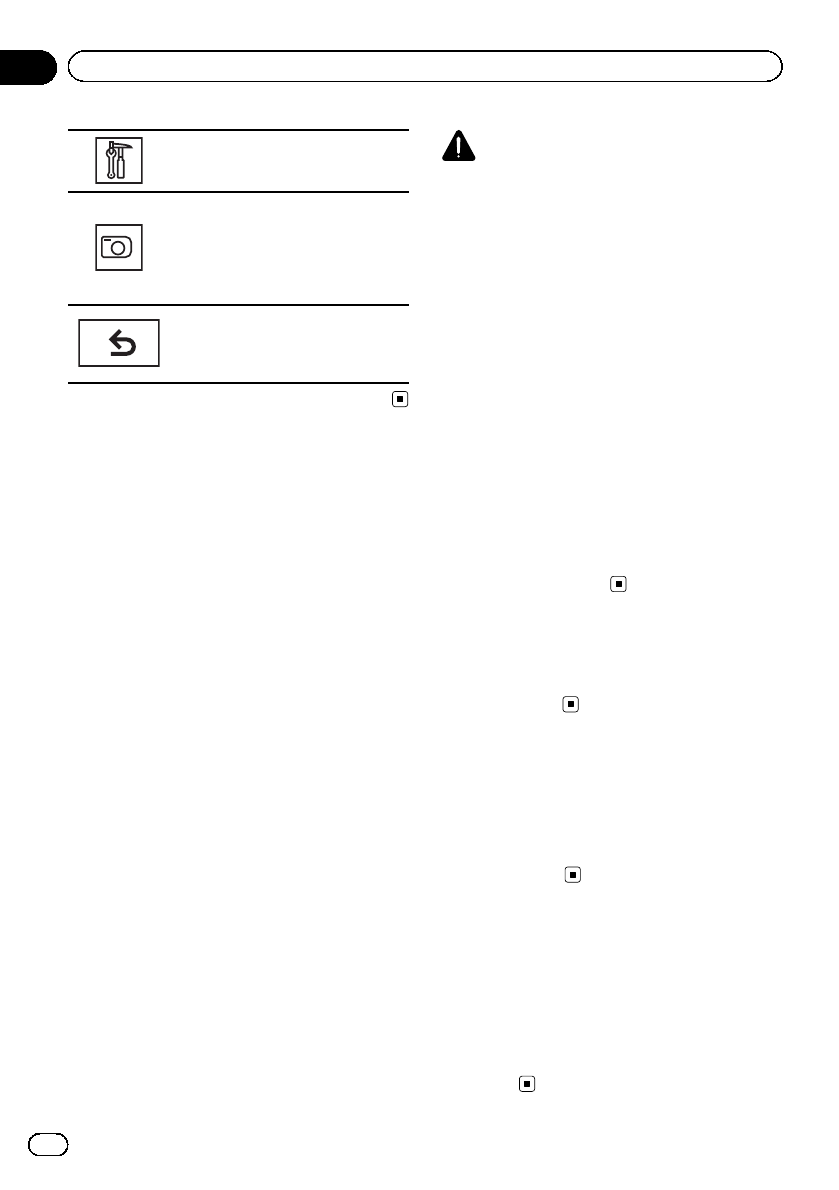
Displaying the menu.
Refer to Introduction of menu opera-
tions on page 52.
Displaying still images as a slide
show when listening to another
source.
Viewing slide shows.
Refer to Introduction of still image
playback operations on page 25.
Returning to the previous display.
Returning to the previous list/cate-
gory (the folder/category one level
higher.)
Opening and closing the
LCD panel
The LCD panel will open or close automatically
when the ignition switch is turned on or off.
You can turn off the automatic close/open
function.
!Do not close the LCD panel by force with
your hands. That will cause a malfunction.
!The automatic close/open function will op-
erate the display as follows.
—When the ignition switch is turned OFF
while the LCD panel is opened, the LCD
panel will close after six seconds.
—When the ignition switch is turned ON
again (or turned to ACC), the LCD panel
will open automatically.
—Removing or attaching the front panel
will automatically close or open the LCD
panel. (Refer to Protecting your unit from
theft on page 9.)
!When the ignition switch is turned OFF
after the LCD panel has been closed, turn-
ing the ignition switch ON again (or turning
it to ACC) will not open the LCD panel. In
this case, press OPEN/CLOSE to open the
LCD panel.
!When closing the LCD panel, check to
make sure that it has closed completely. If
the LCD panel has stopped halfway, leaving
it like this could result in damage.
CAUTION
Keep hands and fingers clear of the unit when
opening, closing, or adjusting the LCD panel. Be
especially cautious of children’s hands and fin-
gers.
%Press OPEN/CLOSE to open the LCD
panel.
#To close the LCD panel, press OPEN/CLOSE
again.
Turning the LCD panel horizontally
When the LCD panel is upright and hinders
the operation of the air conditioner, the panel
can be turned horizontally temporarily.
%Press and hold OPEN/CLOSE to turn the
LCD panel horizontally.
#To return to the original position, press and
hold OPEN/CLOSE again.
#The LCD panel returns to the original position
automatically, indicated with a beeping sound 10
seconds after operation.
Ejecting a disc
1 Press h(eject).
2 Eject a disc.
Ejecting an SD
1 Remove the front panel.
Refer to Removing the front panel on page 9.
2 Push an SD.
3 Eject an SD.
Setting the clock
1 Switch to Clock Adjustment display.
Refer to Basic operations of this unit on page
14.
2 Select the item to set.
3 Touch aor bto set the correct date
and time.
En
16
Section
04 Basic operations
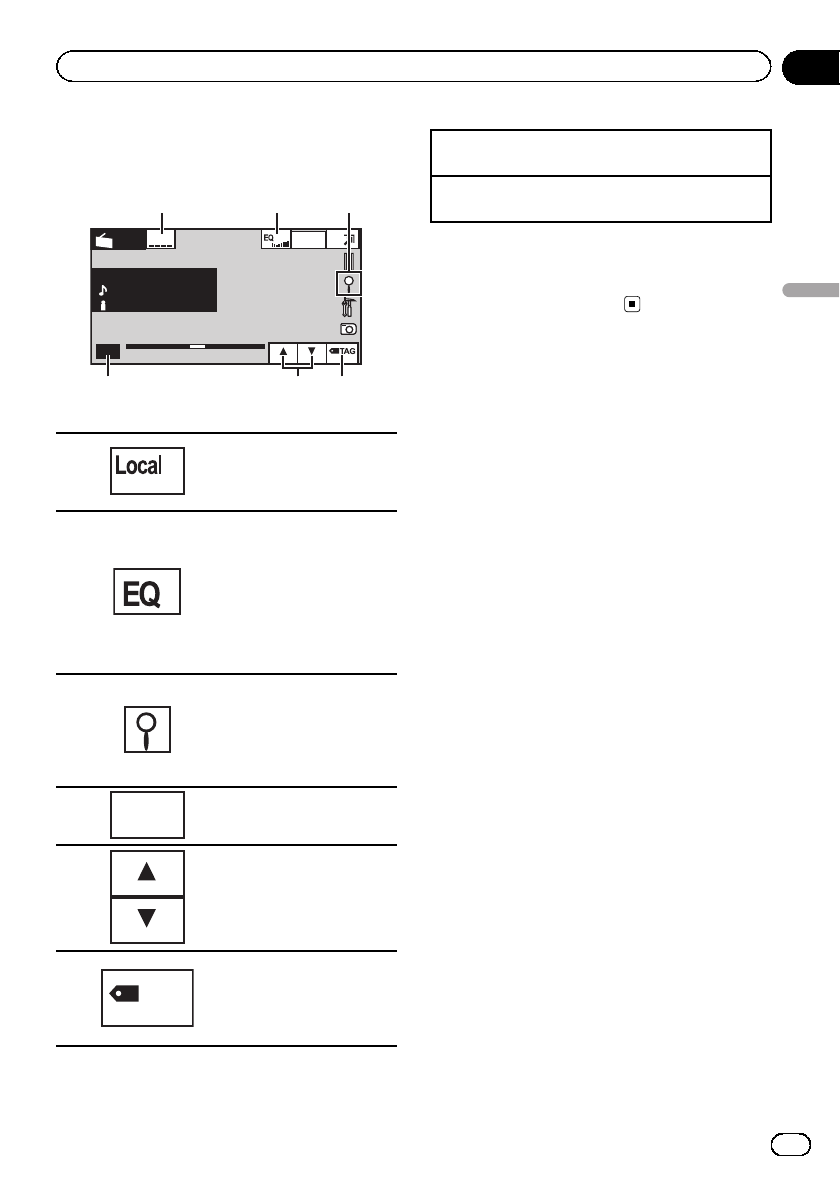
Introduction of tuner
operations
Wed 28 May
12:45 PM
P.ch
2
MHz
Band:
FM1
Abcdeabcdeabcde
Abcdeabcdeabcde
Local
Radio
87.9
87.9 MHz
Abcdeabcdeabcde
6
123
4 5
Touch panel keys
1
Turning local seek tuning on
and off.
Refer to Tuning in to strong
signals on page 32.
2
Switching the equalizer
curves.
Refer to Using the equalizer
on page 53.
Touch and hold for more
than two seconds to turn the
auto-equalizer on or off.
Refer to Using the auto-
equalizer on page 54.
3
Displaying the preset chan-
nel list.
Refer to Storing and recalling
stations on page 32.
Refer to Storing the strongest
stations on page 32.
4Band: Selecting a band (FM1, FM2,
FM3 for FM or AM).
5
Recalling radio station fre-
quencies assigned to preset
tuning keys.
6TAG
Saving song information
(tag) from the broadcasting
station to your iPod.
Refer to Using iTunes tagging
on page 33.
Manual tuning (step by step) using the buttons
1Press cor d(TRACK/SEEK).
Seek tuning using the buttons
1Press and hold cor d(TRACK/SEEK).
Note
Listening AM radio while an iPod is charged from
this unit may generate noise. In this case, discon-
nect the iPod from this unit.
En 17
Section
05
Tuner
Tuner
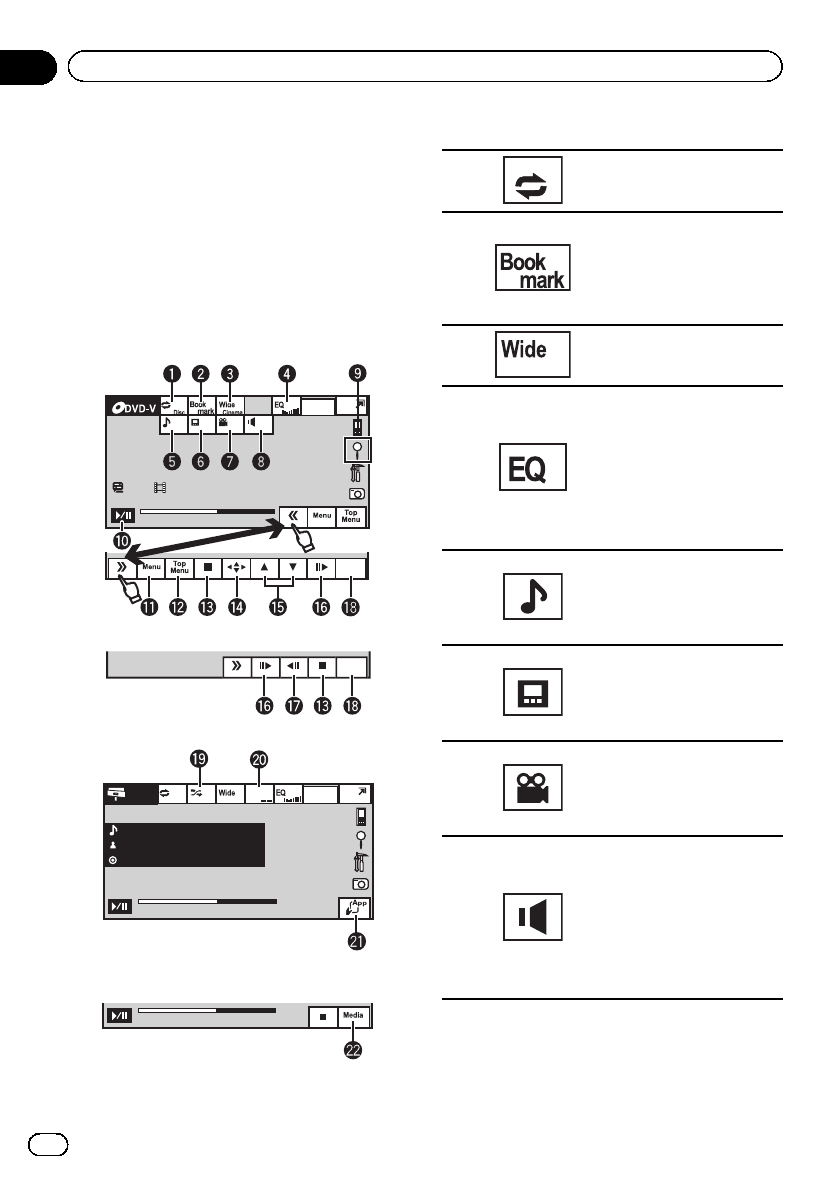
Introduction of video
playback operations
You can view DVD/DVD-R/DVD-RW/CD/CD-R/
CD-RW/USB/SD/iPod.
If an iPod with video capabilities is connected
to this unit using an interface cable such as
the CD-IU50V (sold separately), you can enjoy
the video contents of the iPod as an iPod
source.
DVD video
Return
Wed 28 May
12:45 PM
01 01
812
01:45 -02:45
01 L+R
Video CD
R
etu
r
n
iPod video
Abcdeabcdeabcdeabcdeab
Wed 28 May
12:45 PM
01:45
ALL Songs
S.Rtrv
-02:45
Abcdeabcdeabcdeabcdeab
Abcdeabcdeabcdeabcdeab
2067/12345
iPod
When playing a disc containing a mixture
of various media file types
01:45 -02:45
Touch panel keys
1
Selecting the repeat range.
Refer to Repeating playback
on page 35.
2
During playback, touch the
point at which you want to re-
sume playback the next time
the disc is loaded.
Refer to Resume playback
(Bookmark) on page 37.
3
Changing the screen mode.
Refer to Changing the wide
screen mode on page 40.
4
Switching the equalizer
curves.
Refer to Using the equalizer
on page 53.
Touch and hold for more
than two seconds to turn the
auto-equalizer on or off.
Refer to Using the auto-
equalizer on page 54.
5
Switching between audio
languages during playback.
Refer to Changing audio lan-
guage during playback (Multi-
audio) on page 37.
6
Switching between subtitle
languages during playback.
Refer to Changing the subti-
tle language during playback
(Multi-subtitle) on page 38.
7
Switching among viewing
angles during playback.
Refer to Changing the view-
ing angle during playback
(Multi-angle) on page 38.
8
Switching the audio output,
when playing video discs re-
corded with LPCM audio.
Refer to Selecting audio out-
put on page 38.
Switching between stereo
and monaural audio output,
when playing Video CD
discs.
En
18
Section
06 Playing moving images
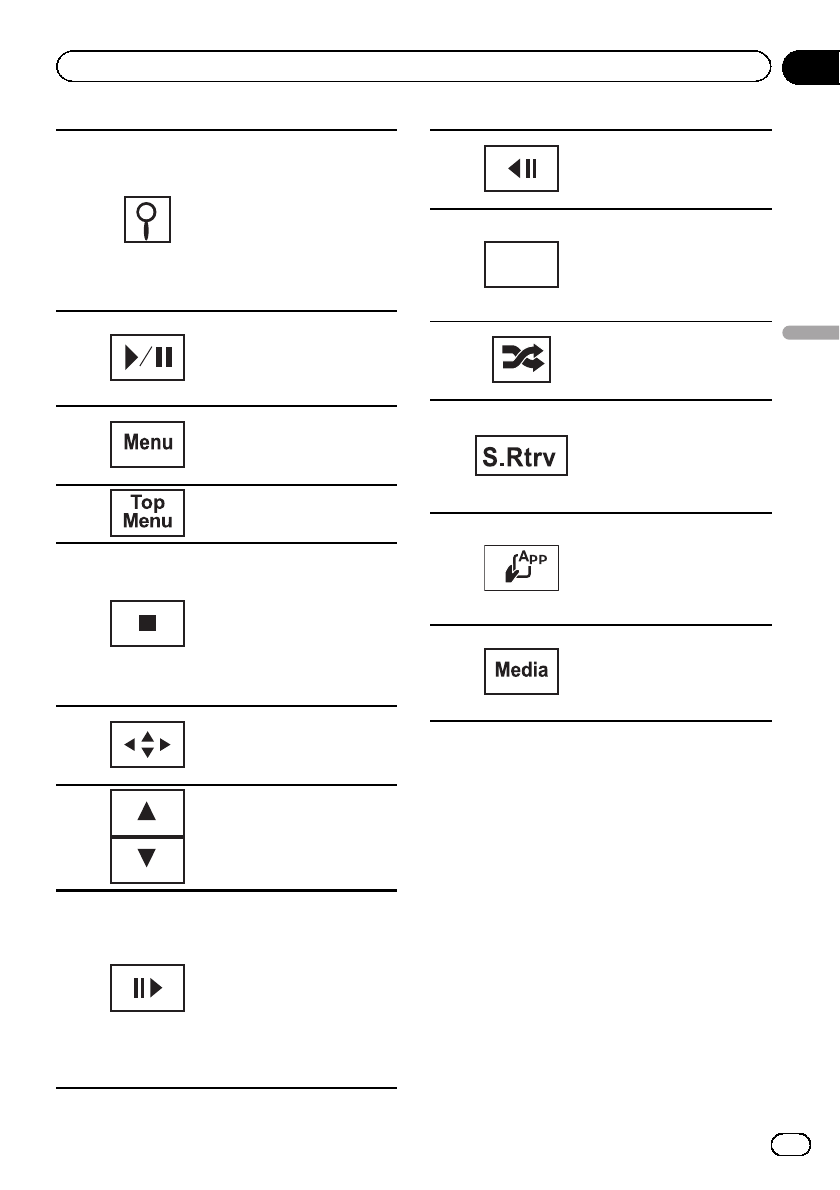
9
Starting the search function.
Refer to Searching for the part
you want to play on page 37.
Refer to Selecting files from
the file name list on page 39.
Displaying iPod menus.
Refer to Playing videos from
your iPod on page 35 and
Browsing for a video/music
on the iPod on page 36.
a
Pausing playback.
Returning to normal play-
back during paused, slow
motion, or frame-by-frame
playback.
b
Displaying the DVD menu
during DVD playback.
Refer to Operating the DVD
menu on page 34.
cReturning to the top menu
during DVD playback.
d
Stopping playback.
Stopping playback at the
point set in Resume play-
back.
Touch one more time to stop
playback completely when
playing DivX.
Refer to Resume playback
(Bookmark) on page 37.
e
Displaying arrow keys to op-
erate the DVD menu.
Refer to Using the arrow keys
on page 34.
f
Skipping to another title.
Selecting a folder during
DivX file playback.
g
Moving ahead one frame at a
time during playback.
Refer to Frame-by-frame play-
back on page 37.
Touch and hold for more
than two seconds to slow
down playback speed.
Speeding up the playback
speed in four steps during
slow motion playback on
DVD video/Video CD.
h
Speeding down the playback
speed in four steps, during
slow motion playback on
Video CD.
iReturn
Returning to the specified
scene to which the DVD cur-
rently being played has been
preprogrammed to return.
Refer to Return to the speci-
fied scene on page 38.
j
Playing the video on your
iPod in a random order.
Refer to Random play (shuf-
fle) on page 35.
k
Switching the S.Rtrv (sound
retriever) function setting
when playing a video on your
iPod.
Refer to Using S.Rtrv (sound
retriever) on page 39.
l
Conducting operation from
your iPod and listening to it
using your car’s speakers.
Refer to Operating this unit’s
iPod function from your iPod
on page 34.
m
Switching between media
file types to play on DVD/CD/
USB/SD.
Refer to Switching the media
file type on page 33.
En 19
Section
06
Playing moving images
Playing moving images
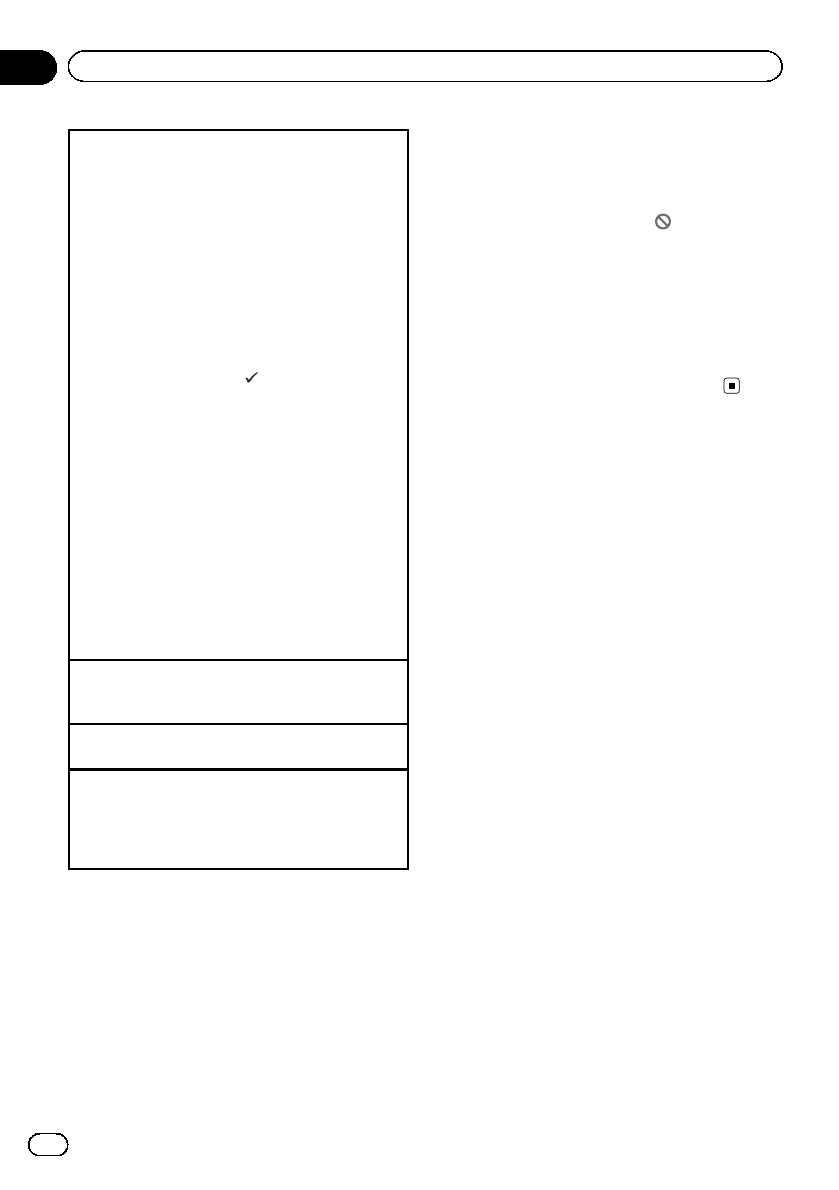
Playing back videos
1Insert the disc into the disc loading slot with the
label side up.
Playback will automatically start.
!If you are playing a DVD or Video CD, a menu
may appear. Refer to Operating the DVD menu on
page 34 and PBC playback on page 38.
!When the automatic playback function is on, the
unit will skip the DVD menu and automatically
start playback from the first chapter of the first
title. Refer to Automatic playback of DVDs on page
59.
!While an iPod is connected to this unit, PIONEER,
Accessory Attached or (check mark) is dis-
played on the iPod.
!When the source icon is not displayed, it can be
displayed by touching the screen.
!Disconnect headphones from the iPod before
connecting it to this unit.
!Depending on the iPod model and the amount of
data stored in the iPod, it may take some time for
playback to begin.
!Use the touch panel keys to select the iPod after
connecting it to this unit.
!No Device is displayed when disconnecting the
iPod.
!If a message is displayed after loading a disc con-
taining DivX VOD content, touch Play.
Refer to Playing DivXâVOD content on page 40.
Ejecting a disc
1Refer to Ejecting a disc on page 16 or Ejecting an
SD on page 16.
Selecting a chapter using the buttons
1Press cor d(TRACK/SEEK).
Fast forwarding or reversing using the buttons
1Press and hold cor d(TRACK/SEEK).
!Fast forward/fast rewind may not always be possi-
ble on some discs. In such cases, normal play-
back will automatically resume.
Notes
!This DVD player can play back a DivX file re-
corded on CD-R/RW or DVD-R/RW. (Please
see the following section for files that can be
played back. Refer to DivX video files on page
95.)
!Do not insert anything other than a DVD (-R/-
RW) or CD (-R/-RW) into the disc loading slot.
!If the bookmark function is on, DVD playback
resumes from the selected point. For more de-
tails, refer to Resume playback (Bookmark) on
page 37.
!Some operations may not be available while
watching a media due to the programming of
the disc. In such cases, the icon appears
on the screen.
!To ensure proper operation, connect the dock
connector cable from the iPod directly to this
unit.
!While the iPod is connected to this unit, the
iPod cannot be turned on or off.
However, the iPod can be turned on or off
when you select an SD as the source.
En
20
Section
06 Playing moving images
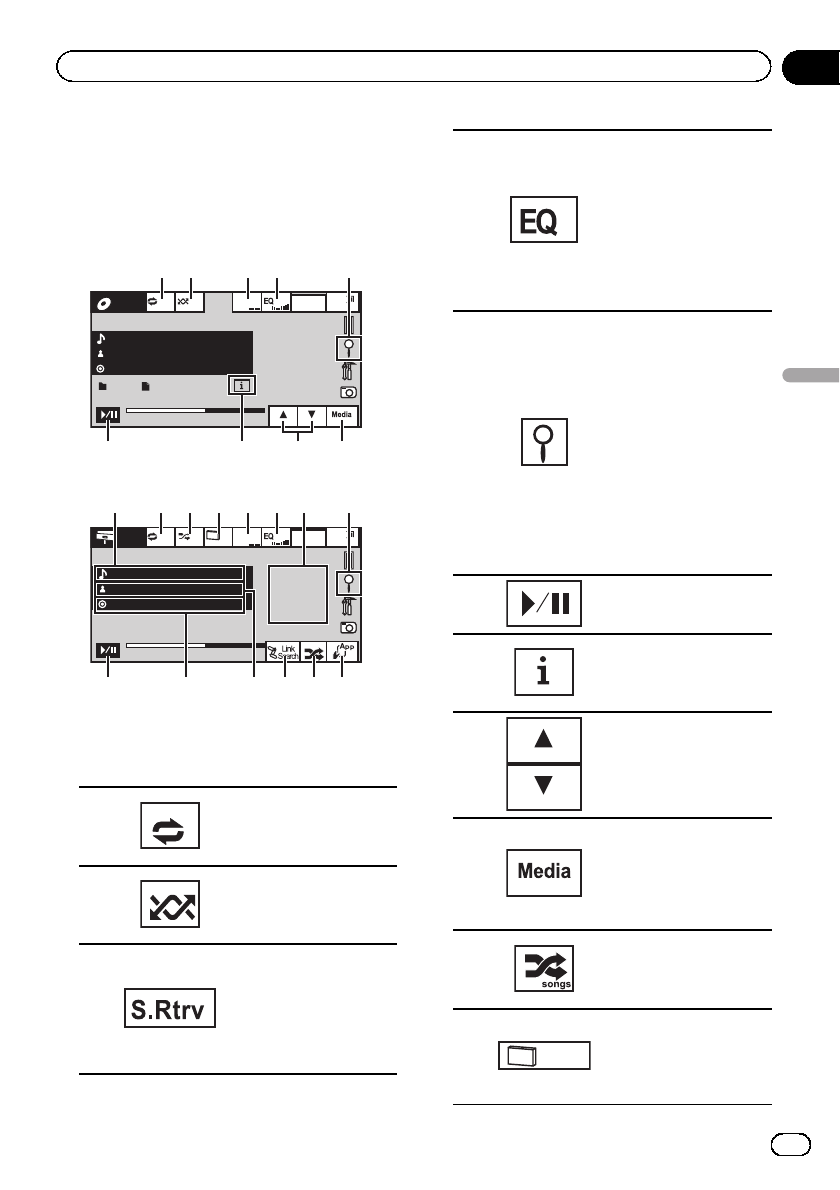
Introduction of sound
playback operations
You can listen to DVD-R/DVD-RW/CD/CD-R/
CD-RW/USB/SD/iPod sound files.
Audio CD
Abcdeabcdeabcdeabcdeab
Wed 28 May
12:45 PM
125
01:45
ROM ALL On/Off
S.Rtrv
-02:45
Abcdeabcdeabcdeabcdeab
Abcdeabcdeabcdeabcdeab
87
6
1 2 3 4
97
5
8
iPod audio
Abcdeabcdeabcdeabcdeab
Wed 28 May
12:45 PM
01:45
ALL Songs
S.Rtrv
-02:45
Abcdeabcdeabcdeabcdeab
Abcdeabcdeabcdeabcdeab
2067/12345
iPod
6h c d e
1 a b 3 4 5
g
f i
You can control an iPod with this unit by using
a cable such as the CD-IU50 (sold separately).
Touch panel keys
1
Selecting the repeat
range.
Refer to Repeating play-
back on page 35.
2
Playing songs in random
order.
Refer to Random play
(shuffle) on page 35.
3
Switching the S.Rtrv
(sound retriever) function
setting when playing
audio.
Refer to Using S.Rtrv
(sound retriever) on page
39.
4
Switching the equalizer
curves.
Refer to Using the equali-
zer on page 53.
Touch and hold for more
than two seconds to turn
the auto-equalizer on or
off.
Refer to Using the auto-
equalizer on page 54.
5
Displaying a list of track
titles to select songs on a
CD.
Refer to Selecting tracks
from the track title list on
page 39.
Displaying the file name
list to select the files.
Refer to Selecting files
from the file name list on
page 39.
Displaying iPod menus.
Refer to Browsing for a
video/music on the iPod
on page 36.
6Pausing and starting
playback.
7
Switching the text infor-
mation to display on this
unit when playing MP3/
WMA/AAC files.
8Selecting a folder.
9
Switching between
media file types on a
DVD/CD/USB/SD.
Refer to Switching the
media file type on page
33.
a
Playing songs on the
iPod in random order.
Refer to Random play
(shuffle) on page 35.
b
Changing the speed of
audiobook playback on
the iPod.
Refer to Changing audio-
book speed on page 39.
En 21
Section
07
Playing audio
Playing audio
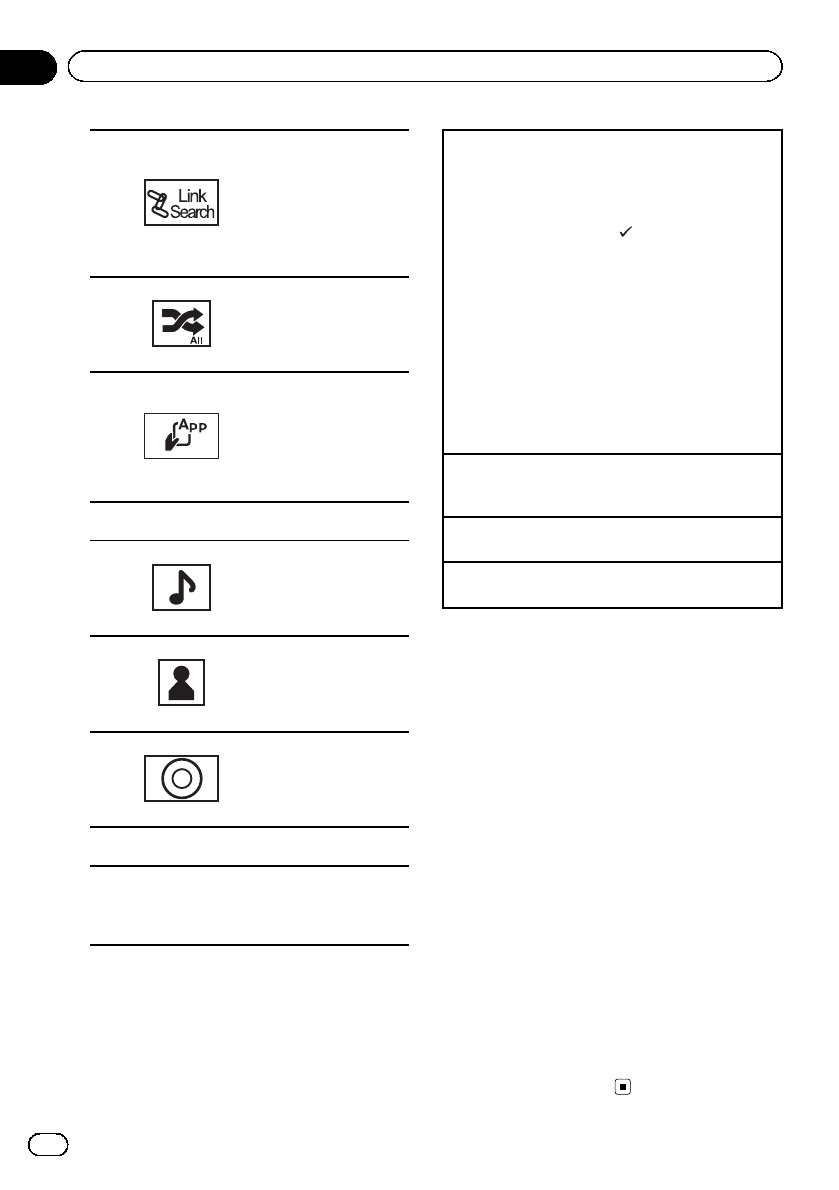
c
Switching to Link Search
mode to play songs re-
lated to the currently
playing song on the iPod.
Refer to Displaying lists
related to the currently
playing song (Link Search)
on page 39.
d
Playing all songs on the
iPod in random order.
Refer to Playing all songs
in random order (shuffle
all) on page 35.
e
Conducting operation
from your iPod and listen-
ing to it using your car’s
speakers.
Refer to Operating this
unit’s iPod function from
your iPod on page 34.
Text information
f
Displaying the Songs list
on the iPod.
Refer to Searching for a
video/music by category
on page 36.
g
Displaying the Artists list
on the iPod.
Refer to Searching for a
video/music by category
on page 36.
h
Displaying the Albums
list on the iPod.
Refer to Searching for a
video/music by category
on page 36.
Artwork display
i
Starting Album Link Search on your iPod
when you touch the artwork display.
Refer to Displaying lists related to the cur-
rently playing song (Link Search) on page 39.
Playing back sound
1Insert the disc into the disc loading slot with the
label side up.
Playback will automatically start.
!While an iPod is connected to this unit, PIONEER,
Accessory Attached or (check mark) is dis-
played on the iPod.
!When the source icon is not displayed, it can be
displayed by touching the screen.
!Disconnect headphones from the iPod before
connecting it to this unit.
!Depending on the iPod model and the amount of
data stored in the iPod, it may take some time for
playback to begin.
!Use the touch panel keys to select the iPod after
connecting it to this unit.
!No Device is displayed when disconnecting the
iPod.
Ejecting a disc
1Refer to Ejecting a disc on page 16 or Ejecting an
SD on page 16.
Selecting a track using the buttons
1Press cor d(TRACK/SEEK).
Fast forwarding or reversing using the buttons
1Press and hold cor d(TRACK/SEEK).
Notes
!When playing back files recorded as VBR
(variable bit rate) files, the play time will not be
correctly displayed if fast forward or reverse
operations are used.
!To ensure proper operation, connect the dock
connector cable from the iPod directly to this
unit.
!While the iPod is connected to this unit, the
iPod cannot be turned on or off.
However, the iPod can be turned on or off
when you select an SD as the source.
!If the characters recorded on the disc are not
compatible with this unit, those characters
will not be displayed.
!Text information may not be correctly dis-
played depending on the recorded environ-
ment.
!Disconnect the USB portable audio player/
USB memory when you are done using it.
!When you select Clock or Speana on Select-
ing the background display on page 66, the art-
work is not displayed.
En
22
Section
07 Playing audio
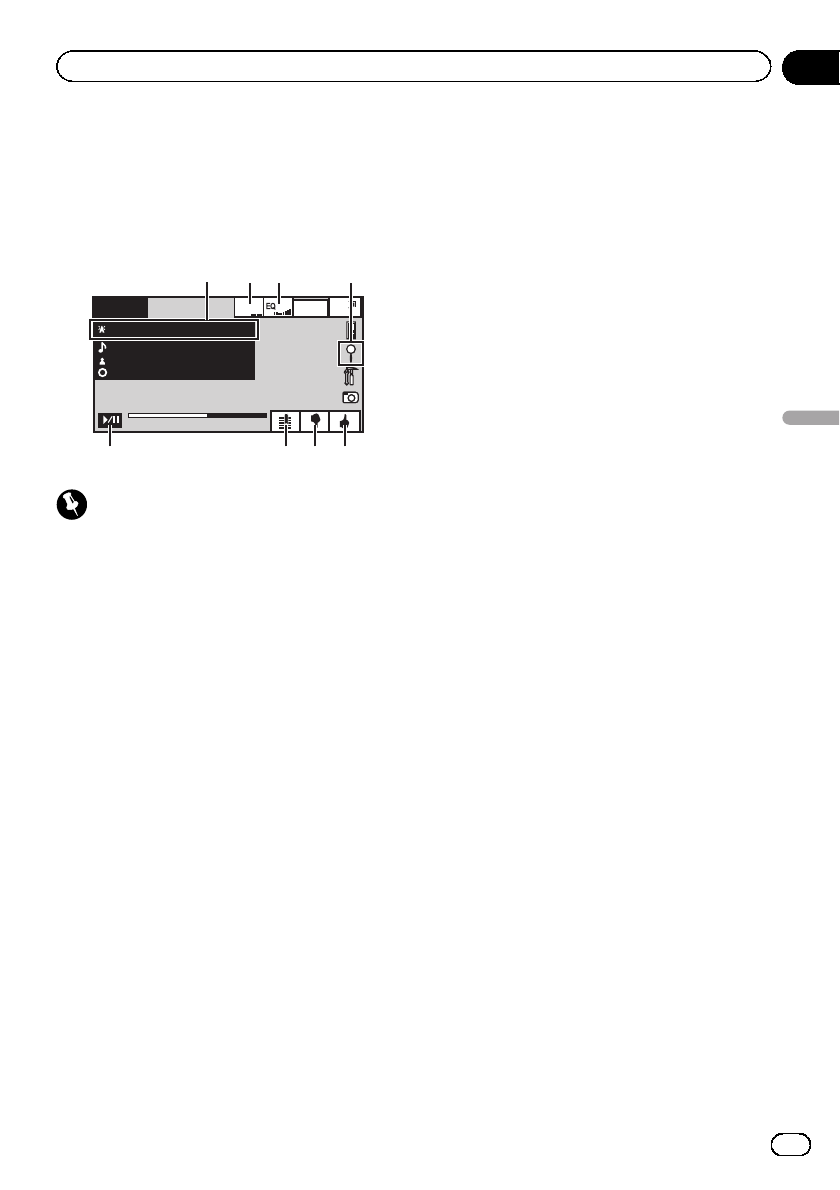
Introduction of Pandora
operations
You can play the Pandora by connecting your
iPod which was installed the Pandora applica-
tion.
Abcdeabcdeabcdeabcde
Wed 28 May
12:45 PM
01:45
Pandora
S.Rtrv
-02:45
Abcdeabcdeabcdeabcde
Abcdeabcdeabcdeabcde
Abcdeabcdeabcdeabcde
6
12 3
47
5
8
Important
Requirements to access the Pandora music ser-
vice using the Pioneer car audio/video products:
!Apple iPhone (first generation), iPhone 3G,
iPhone 3GS or iPhone 4 with firmware version
3.0 or later.
!Latest version of the Pandora application for
the iPhone, downloaded to your device.
(Search Apple iTunes App Store for
“Pandora”).
!Current Pandora account (Free account and
paid accounts available from Pandora; create
a free account online at
http://www.pandora.com/register or through
the Pandora application for the iPhone).
!iPhone Data Plan.
Note: if the Data Plan for your iPhone does
not provide for unlimited data usage, addi-
tional charges from AT&T may apply for acces-
sing the Pandora service via AT&T’s 3G and/or
EDGE networks.
!Connection to the Internet via 3G, EDGE or
WiFi network.
!Optional Pioneer adapter cable connecting
your iPhone to the Pioneer car audio/video
products.
Limitations:
!Access to the Pandora service will depend on
the availability of a cellular and/or WiFi net-
work for purposes of allowing your iPhone to
connect to the Internet.
!Pandora’s service is currently only available in
the U.S.
!Ability of the Pioneer car audio/video products
to access the Pandora service is subject to
change without notice and could be affected
by any of the following: compatibility issues
with future firmware versions of iPhones;
compatibility issues with future firmware ver-
sions of the Pandora application for the
iPhone; changes to the Pandora music service
by Pandora; discontinuation of the Pandora
music service by Pandora.
!Certain functionality of the Pandora service is
not available when accessing the service
through the Pioneer car audio/video products,
including, but not limited to, creating new sta-
tions, deleting stations, emailing current sta-
tions, buying songs from iTunes, viewing
additional text information, logging in to
Pandora, and adjusting Cell Network Audio
Quality.
Pandora Internet radio is a music service not af-
filiated with Pioneer. More information is avail-
able at http://www.pandora.com.
You can play the Pandora by connecting your
iPod which was installed the Pandora applica-
tion and starting up the Pandora application.
En 23
Section
08
Using Pandoraâ
Using Pandoraâ
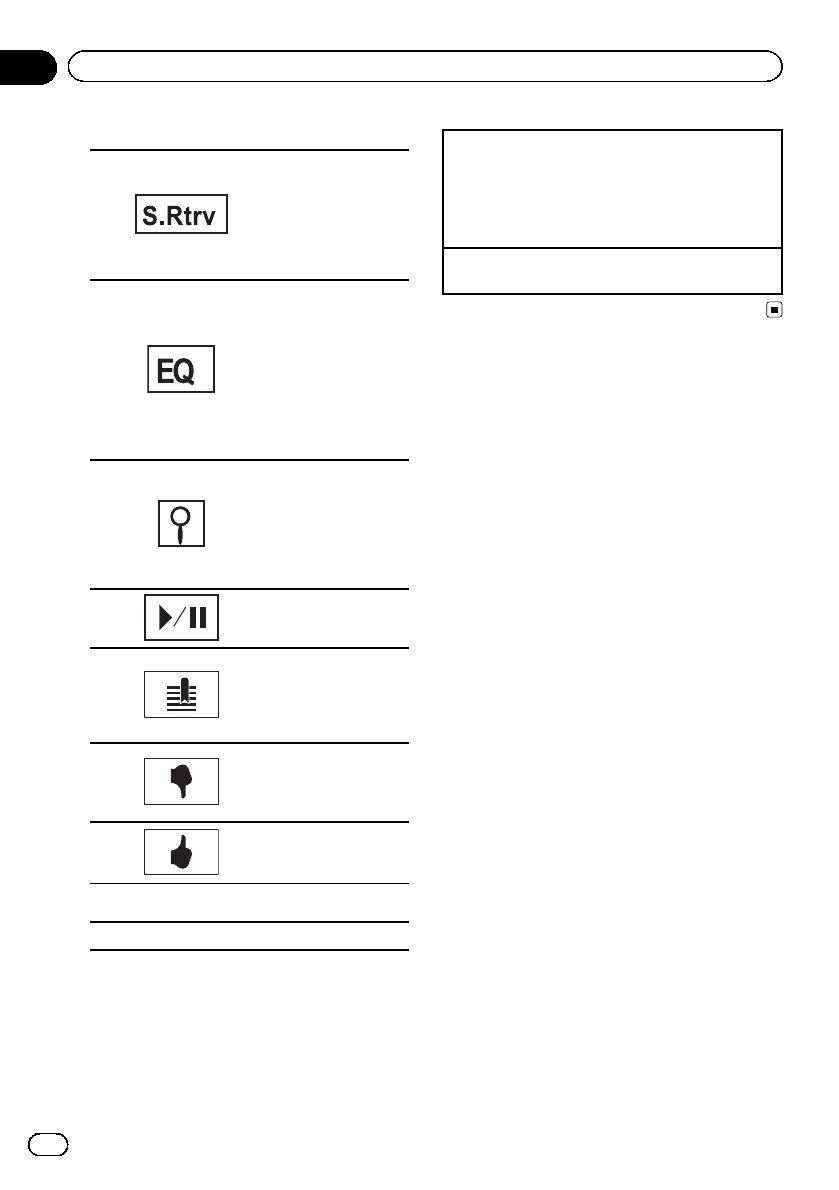
Touch panel keys
1
Switching the S.Rtrv
(sound retriever) function
setting while playing
Pandora.
Refer to Using S.Rtrv
(sound retriever) on page
39.
2
Switching the equalizer
curves.
Refer to Using the equali-
zer on page 53.
Touch and hold for more
than two seconds to turn
the auto-equalizer on or
off.
Refer to Using the auto-
equalizer on page 54.
3
Displaying the QuickMix/
station list to select
QuickMix or the desired
station.
Refer to Selecting and
playing the QuickMix/sta-
tion list on page 41.
4Pausing and starting
playback.
5
Storing song information
(Bookmark).
Refer to Storing song in-
formation (bookmarks) on
page 41.
6
Giving a “Thumbs-down”
for the song currently
playing and then skip-
ping to the next song.
7
Giving a “Thumbs-up”for
the song currently play-
ing.
Text information
8Displaying the station list.
Playing songs
1Open the USB port cover.
2Connect an iPod to the USB cable using an iPod
Dock Connector.
3Start up the Pandora application installed on the
iPod.
Skipping tracks
1Press d.
En
24
Section
08 Using Pandoraâ
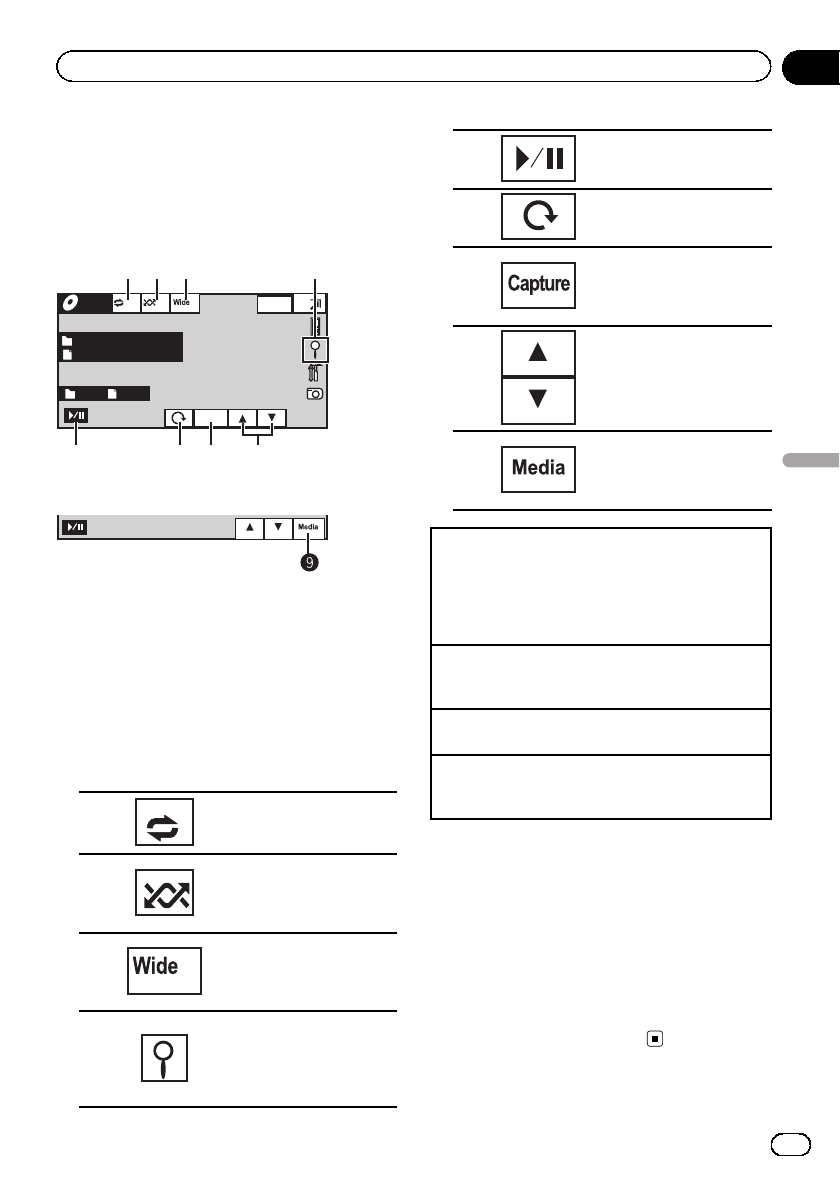
Introduction of still image
playback operations
You can view still images saved in CD-R/CD-
RW/USB/SD.
CD
Capture
Photo Wed 28 May
12:45 PM
Abcdeabcdeabcde
Abcdeabcdeabcde
Full
Off
2 2
5
1 2 34
76 8
When playing a disc containing a mixture
of various media file types
When loading a CD-R/CD-RW/USB/SD con-
taining JPEG picture files, this unit starts a sli-
deshow from the first folder/picture on the
disc/device. The player displays the pictures in
each folder on the CD-R/CD-RW in alphabeti-
cal order by file name.
The table below shows the controls for viewing
a slideshow.
Touch panel keys
1
Selecting the repeat range.
Refer to Repeating playback
on page 35.
2
Playing files in a random
order.
Refer to Random play (shuf-
fle) on page 35.
3
Changing the screen
mode.
Refer to Changing the wide
screen mode on page 40.
4
Displaying the file name
list to select the files.
Refer to Selecting files from
the file name list on page
39.
5Starting or pausing the sli-
deshow.
6Rotating the displayed pic-
ture 90° clockwise.
7
Capturing an image in
JPEG files.
Refer to Capture an image
in JPEG files on page 40.
8Selecting a folder.
9
Switching between media
file types.
Refer to Switching the
media file type on page 33.
Playing still images
1Insert the disc into the disc loading slot with the
label side up.
Playback will automatically start.
!When the source icon is not displayed, it can be
displayed by touching the screen.
Ejecting a disc.
1Refer to Ejecting a disc on page 16 or Ejecting an
SD on page 16.
Selecting a file using the buttons
1Press cor d(TRACK/SEEK).
Fast file searching
1Press and hold cor d(TRACK/SEEK).
!You can search 10 JPEG files at a time.
Notes
!This unit can play back a JPEG file recorded
on CD-R/CD-RW/SD/USB storage device.
(Please see the following section for files that
can be played back. Refer to JPEG picture files
on page 95.)
!Files are played back in file number order and
folders are skipped if they contain no files. (If
folder 01 (ROOT) contains no files, playback
commences with folder 02.)
En 25
Section
09
Playing still images
Playing still images
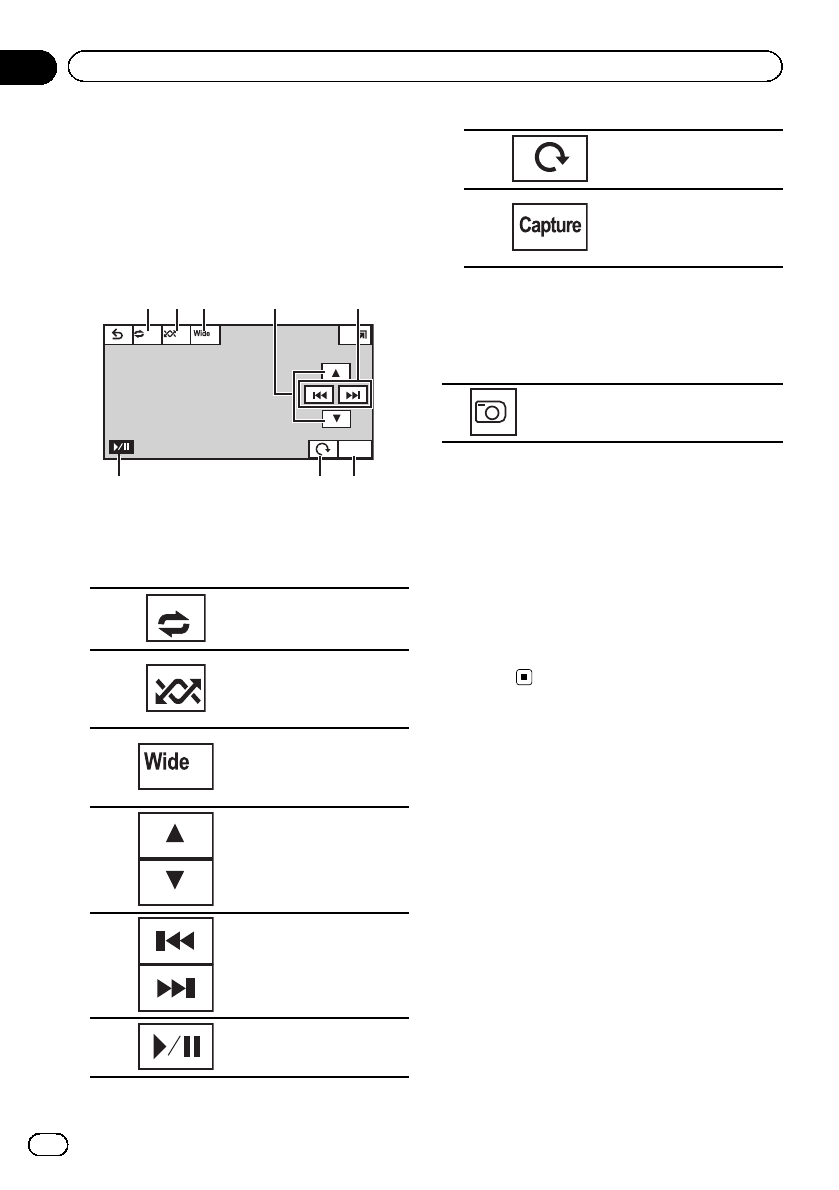
Introduction of still image
playback as a slideshow
operations
You can view still images saved in CD-R/CD-
RW/USB/SD as a slideshow when listening to
another source.
Capture
Full
Off
8
21
6
3
7
45
The table below shows the controls for viewing
a slideshow.
Touch panel keys
1
Selecting the repeat range.
Refer to Repeating playback
on page 35.
2
Playing files in a random
order.
Refer to Random play (shuf-
fle) on page 35.
3
Changing the screen
mode.
Refer to Changing the wide
screen mode on page 40.
4Selecting a folder.
5Selecting a file.
6Starting or pausing the sli-
deshow.
7Rotating the displayed pic-
ture 90° clockwise.
8
Capturing an image in
JPEG files.
Refer to Capture an image
in JPEG files on page 40.
1 Start slideshow when listening to an-
other source.
Refer to Common operations for menu set-
tings/lists on page 15.
Displaying still images as a slide
show.
2 Select the device containing the files
that you want to display.
!Disc –Built-in DVD player
!USB –USB
!SD –SD memory card
#To cancel searching, touch Cancel.
Note
When the USB or SD source is selected, this unit
cannot view still images on USB/SD as a
slideshow.
En
26
Section
09 Playing still images
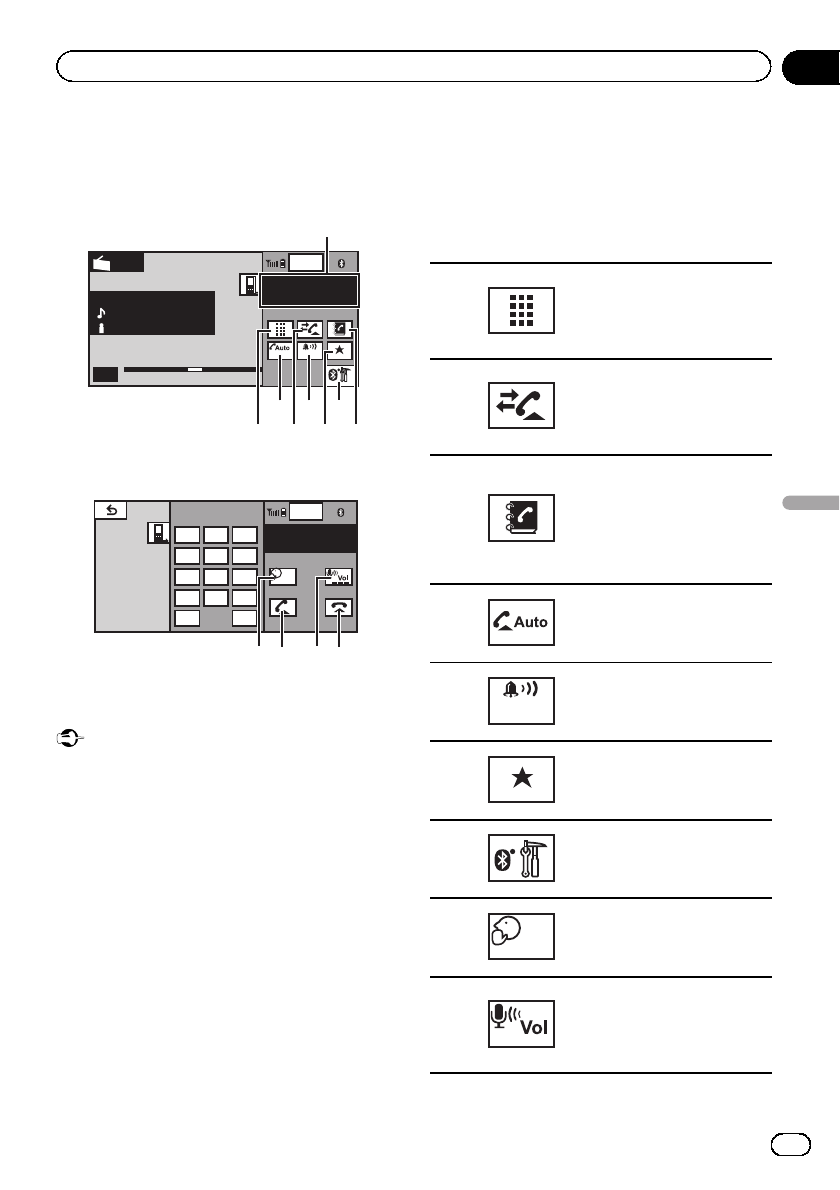
Introduction of Bluetooth
telephone operations
Telephone standby display
Wed 28 May
1
12:45 PM
87.9 MHz
P.CH
2
Band:
FM1
Radio
ABCDEHGHI
012345678901
01
Off On
Abcdeabcdeabcde
Abcdeabcdeabcde
Abcdeabcdeabcde
1
45 7
2163
When switching to the entering phone
number mode
Wed 28 May
1
12:45 PM
ABCDEHGHI
012345678901
01
123
456
789
*0#
+C
Off
8 ba9
You can use Bluetooth telephone.
Important
!Since this unit is on standby to connect with
your cellular phone via Bluetooth wireless
technology, using it without the engine run-
ning can drain the battery power.
!Advanced operations that require attention
such as dialing numbers on the monitor, etc.,
are prohibited while driving. Park your vehicle
in a safe place when using these advanced
operations.
!Operations available may be limited depend-
ing on the cellular phone connected to this
unit.
!Be sure to park your vehicle in a safe place
and apply the parking brake when performing
this operation.
1Incoming call notice
Indicates that an incoming call has been re-
ceived and has not been checked yet.
!Not displayed for calls made when your
cellular phone is disconnected from this
unit.
Touch panel keys
1
Switching the mode to enter
the phone number directly.
Refer to Making a call by en-
tering phone number on page
49.
2
Switching to the call history
list.
Refer to Using the missed, re-
ceived and dialed call lists on
page 48.
3
Switching to the phone book
mode.
Refer to Calling a number in
the phone book on page 47.
Refer to Selecting a number
by alphabet search mode on
page 47.
4
Turning automatic answering
on or off.
Refer to Setting automatic an-
swering on page 48.
5
Turning the ring tone for in-
coming calls on or off.
Refer to Switching the ring
tone on page 48.
6
Displaying the preset dial
screen.
Refer to Using the preset dial
lists on page 48.
7
Displaying the Bluetooth
connection menu.
Refer to the instructions
from page 49 to page 51.
8
Turning private mode on or
off.
Refer to Setting the private
mode on page 49.
9
Adjusting the other party’s
listening volume.
Refer to Adjusting the other
party’s listening volume on
page 48.
En 27
Section
10
Bluetooth Telephone
Bluetooth Telephone
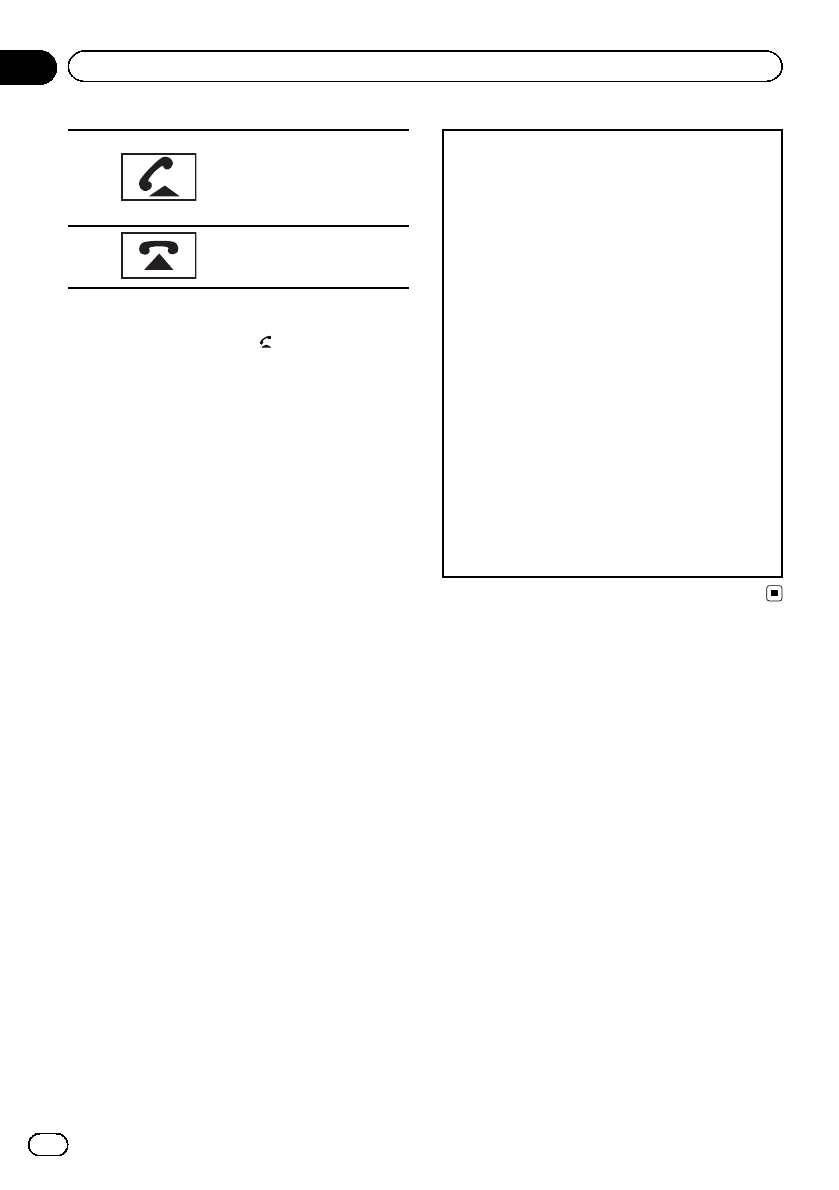
a
Accepting an incoming call.
Making a phone call, when
selecting a phone number.
Switching between callers on
hold.
b
Ending a call.
Rejecting an incoming call.
Canceling call waiting.
Notes
!You can also use MUTE/to accept an in-
coming call, end a call and reject an incoming
call.
!Private mode can only be operated while you
are talking on the phone.
!To end the call, both you and the other caller
must hang up your phones.
Setting up for hands-free phoning
Before you can use the hands-free phoning
function you must set up the unit for use with
your cellular phone. This entails establishing a
Bluetooth wireless connection between this
unit and your phone, registering your phone
with this unit, and adjusting the volume level.
1Connection
First, you need to connect a Bluetooth telephone
to this unit.
For detailed instructions on connecting your
phone to this unit via Bluetooth wireless technol-
ogy, see following section. Using a Bluetooth de-
vice to pair on page 50 and Pairing from this unit
on page 49.
2Volume adjustment
Adjust the earpiece volume of your cellular phone
to your preference. The unit will record the ad-
justed volume level as the default setting.
!The volume of the caller’s voice and ring tone
may vary depending on the type of cellular
phone.
!If there is a large volume difference between
the ring tone and caller’s voice, the overall vo-
lume level may become unstable.
!Make sure to adjust the volume to a proper
level before disconnecting the cellular phone
from the unit. If the volume is muted (zero
level) on your cellular phone, the volume level
of your cellular phone remains muted even
after the cellular phone is disconnected.
En
28
Section
10 Bluetooth Telephone
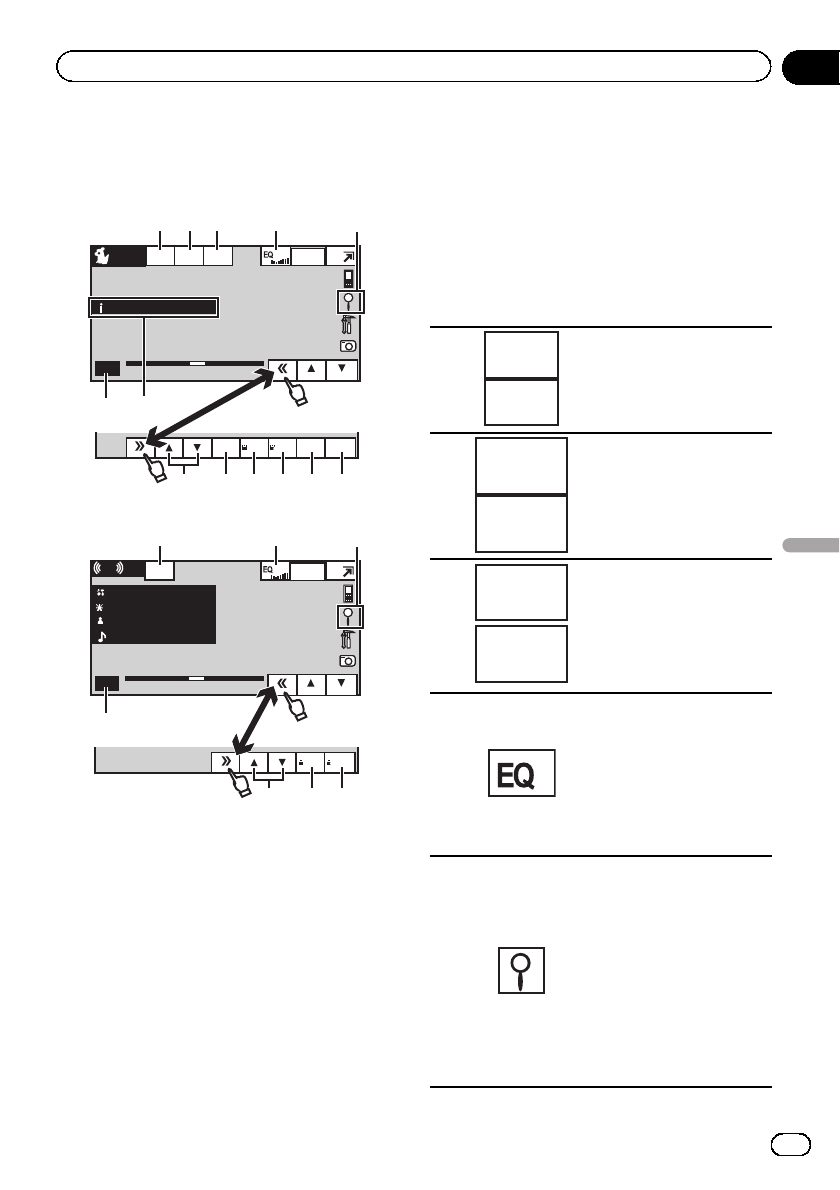
Introduction of XM/SIRIUS
tuner operations
SIRIUS tuner
Wed 28 may
12:45 PM
CH183
P.CH
2
Band:
SIRIUS
Abcdeabcdeabcde
SIRIUS
CH183
Memo
Off
Mode
All CH
Team
Off
6
54123
7
Memo
Edit
Team
Setting
Instant
Replay
Game
Info
Memo
9 a b c d8
XM tuner
Abcdeabcdeabcde
Wed 28 may
12:45 PM
CH183
P.ch
2
Band:
XM
Abcdeabcdeabcde
Abcdeabcdeabcde
Abcdeabcdeabcde CH183
Mode
All CH
XM
XM
6
541
Memo
Edit
Memo
8ab
You can use this unit to control an XM satellite
digital tuner (GEX-P920XM), which is sold se-
parately.
You can use this unit to control a SIRIUS Satel-
lite Radio tuner, which is sold separately.
For details concerning operation, refer to the
XM tuner’s operation manuals. This section
provides information on XM operations with
this unit which differs from that described in
the XM tuner’s operation manual.
When the SIRIUS tuner is used together with
this unit, some operations differ slightly from
those described in the SIRIUS operation man-
ual. This manual provides information on
these points. For all other information on
using the SIRIUS tuner, please refer to the SIR-
IUS operation manual.
!With this unit, you can operate one addi-
tional function: XM/SIRIUS channel direct
selection. Refer to Selecting an XM/SIRIUS
channel directly on page 42.
Touch panel keys
1
Mode
All CH
Mode
Category
Selecting a channel by num-
ber or category.
Refer to Switching the XM/
SIRIUS channel selection
mode on page 42.
2
Memo
On
Memo
Off
Tuning the MyMix function
on or off for the SIRIUS tuner.
Refer to Turning the MyMix
function on or off on page 44.
3
Team
On
Team
Off
Turning the Game Alert on or
off for the SIRIUS tuner.
Refer to Switching the Game
Alert on or off on page 45.
4
Switching the equalizer
curves.
Refer to Using the equalizer
on page 53.
Touch and hold for more
than two seconds to turn the
auto-equalizer on or off.
Refer to Using the auto-
equalizer on page 54.
5
Displaying the preset chan-
nel list.
Refer to Storing and recalling
stations on page 32.
Selecting a channel directly.
Refer to Selecting an XM/SIR-
IUS channel directly on page
42.
Selecting a channel from the
XM channel list.
Refer to Selecting a channel
from the XM channel list dis-
play on page 42.
En 29
Section
11
XM/SIRIUS tuner
XM/SIRIUS tuner
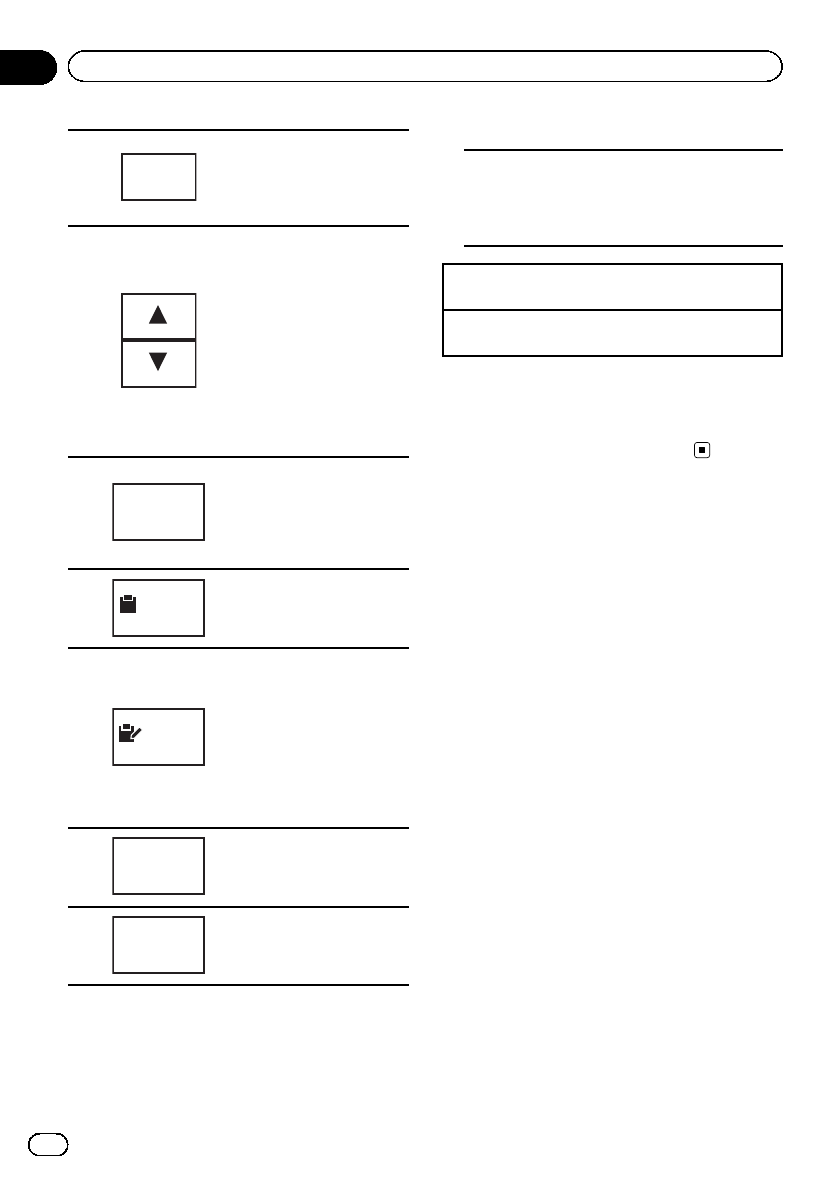
6Band:
Selecting a band (XM1,XM2
or XM3) for XM tuner.
Selecting a band (SIRIUS1,
SIRIUS2 or SIRIUS3) for the
SIRIUS tuner.
8
Recalling radio station fre-
quencies assigned to preset
tuning keys.
Refer to Storing and recalling
stations on page 32.
Selecting the channel cate-
gory when selecting Mode
Category.
Refer to Switching the XM/
SIRIUS channel selection
mode on page 42 and Select-
ing a SIRIUS channel from a
channel category on page 42.
9Instant
Replay
Selecting a track, fast for-
warding/reversing or paus-
ing/playing for the SIRIUS
tuner.
Refer to Using the Instant Re-
play function on page 46.
a
Memo
Storing the song title and ar-
tist name.
Refer to Making the MyMix
playlist on page 43.
b
Memo
Edit
Switching to memo edit
mode.
Refer to Setting up a song
alert on page 44.
Refer to Deleting a song from
the MyMix playlist for XM
tuner on page 44.
Refer to Deleting a song from
the MyMix playlist for SIRIUS
tuner on page 44.
c
Game
Info
Displaying information on
games for the SIRIUS tuner.
Refer to Displaying game in-
formation on page 45.
dTeam
Setting
Selecting teams for game
alert on the SIRIUS tuner.
Refer to Selecting teams for
Game Alert on page 45.
SIRIUS tuner information
7
Switching the SIRIUS information.
Refer to Switching the SIRIUS display on
page 46.
Touch and hold for more than two seconds
to scroll the text.
Manual tuning (step by step) using the buttons
1Press cor d(TRACK/SEEK).
Seek tuning using the buttons
1Press and hold cor d(TRACK/SEEK).
Note
You can also perform tuning from a desired chan-
nel category. (Refer to Selecting a SIRIUS channel
from a channel category on page 42.)
En
30
Section
11 XM/SIRIUS tuner
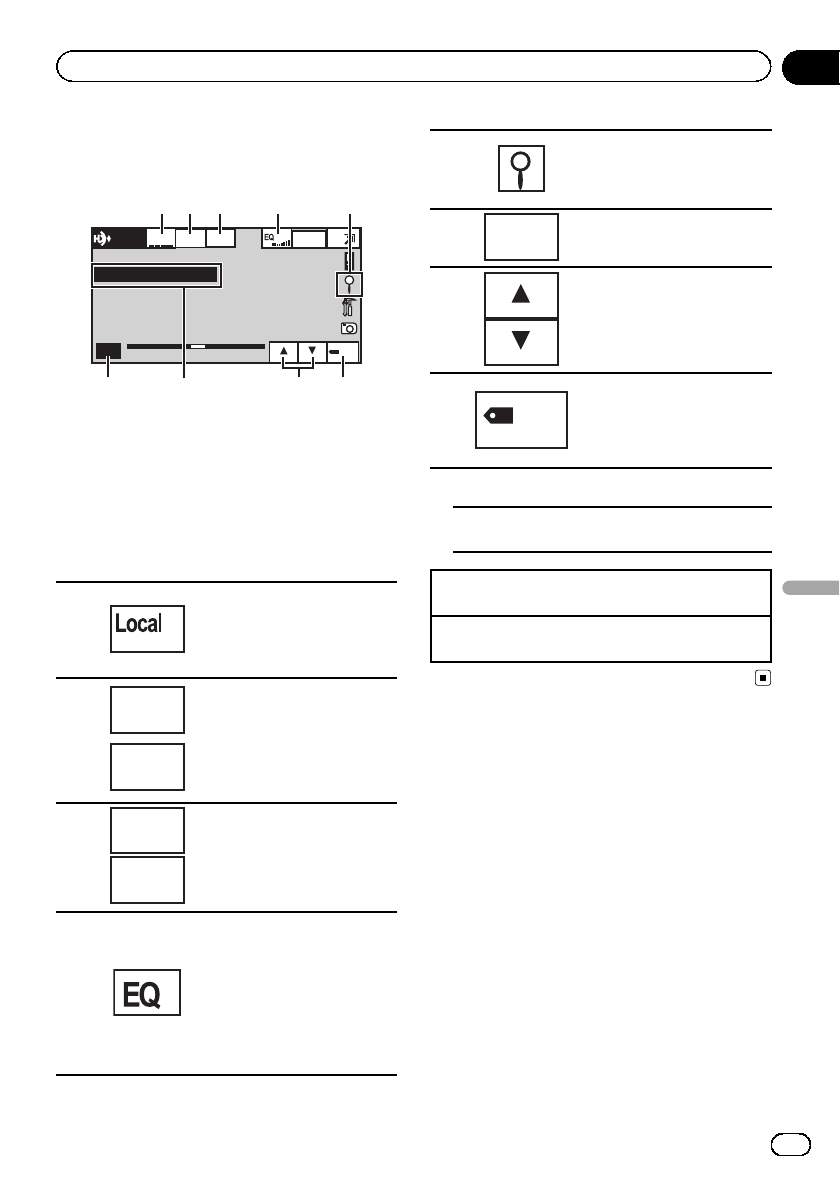
Introduction of HD Radioä
tuner operations
Abcdeabcdeabcde
Wed 28 may
12:45 PM
87.9 MHz
P.CH
2
Band:
FM1
TAG
Digital
Radio
Local
87.9
MHz
Seek
All
Blending
D/A Auto
67 89
142 35
This HD Radio Ready receiver is ready to re-
ceive HD Radio broadcasts when connected
to the HD Radio tuner (e.g. GEX-P20HD), sold
separately.
For details concerning operation, refer to the
HD Radio tuner’s operation manual.
Touch panel keys
1
Turning local seek tuning on
or off.
Refer to Tuning in to strong
HD Radio signals on the next
page.
2
Seek
All
Seek
HD
Switching between Digital
broadcasting station seek
and normal seek.
Refer to Switching the seek
mode on page 46.
3
Blending
D/A Auto
Blending
Analog
Switching to the analog
broadcast of the same fre-
quency.
Refer to Switching the recep-
tion mode on page 46.
4
Switching the equalizer
curves.
Refer to Using the equalizer
on page 53.
Touch and hold for more
than two seconds to turn the
auto-equalizer on or off.
Refer to Using the auto-
equalizer on page 54.
5
Displaying the preset chan-
nel list.
Refer to Storing and recalling
stations on the next page.
6Band: Selecting a band (FM1, FM2,
FM3 for FM or AM).
8
Recalling radio station fre-
quencies assigned to preset
tuning keys.
Refer to Storing and recalling
stations on the next page.
9TAG
Saving song information
(tag) from the broadcasting
station to your iPod.
Refer to Using iTunes tagging
on page 33.
Digital Radio tuner information
7Switching the digital radio tuner informa-
tion.
Manual tuning (step by step) using the buttons
1Press cor d(TRACK/SEEK).
Seek tuning using the buttons
1Press and hold cor d(TRACK/SEEK).
En 31
Section
12
HD Radioätuner
HD Radioätuner
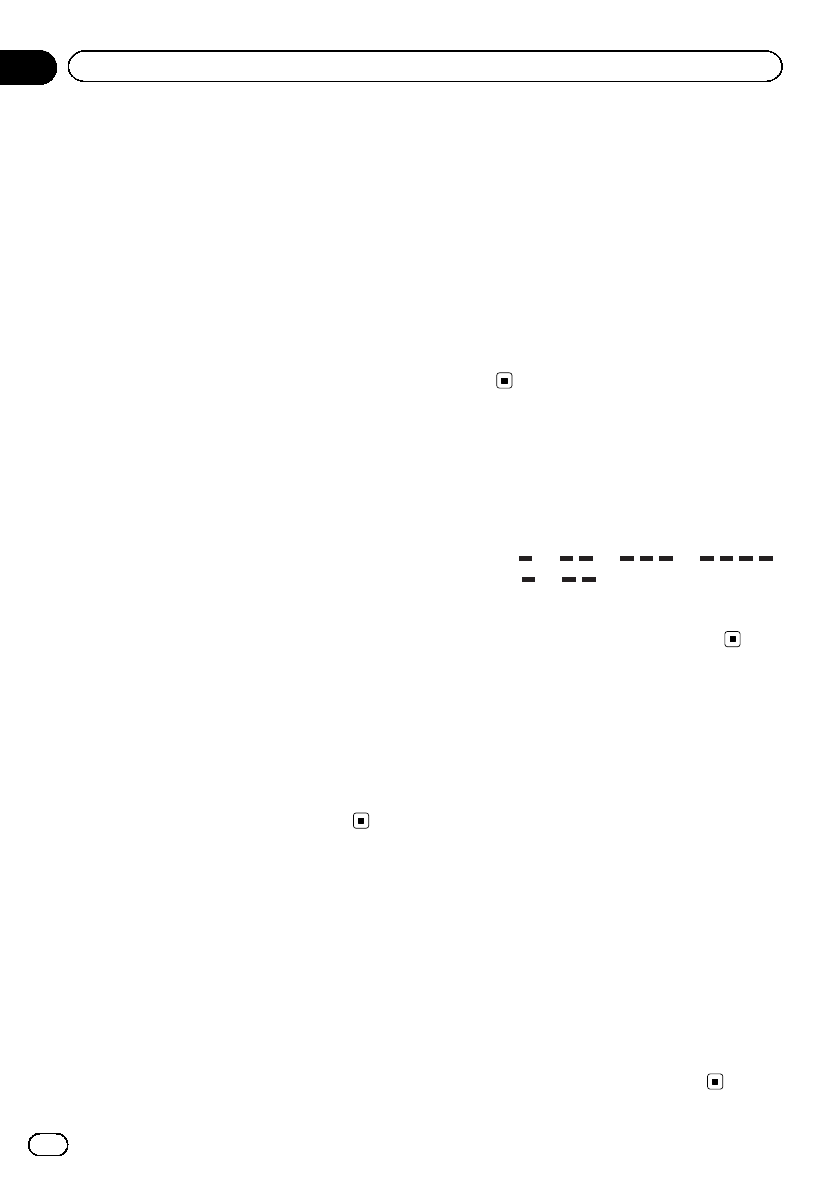
Storing and recalling stations
You can easily store up to six stations for each
band as presets.
!Six stations for each band can be stored in
memory.
!Channels are stored and recalled on a
broadcast station basis. This means that if
the broadcast station you stored has been
assigned to a different channel by SIRIUS,
you can still recall the same broadcast sta-
tion (though a different channel number
may appear in the display).
1 Display the preset screen.
Refer to Introduction of tuner operations on
page 17.
Refer to Introduction of XM/SIRIUS tuner opera-
tions on page 29.
Refer to Introduction of HD Radioätuner opera-
tions on the previous page.
The preset screen appears in the display.
2 Touch and hold one of the preset tun-
ing keys to store the selected frequency in
the memory.
The selected radio station frequency has been
stored in the memory.
3 Touch one of the preset tuning keys to
select the desired station.
#(Function of SIRIUS tuner)
You can also use aand bto recall stations as-
signed to preset tuning keys Preset1 to Preset6
when the Mode All CH mode is selected.
Storing the strongest stations
BSM (best stations memory) automatically
stores the six strongest stations in the order of
their signal strength.
Storing broadcast frequencies with BSM may
replace broadcast frequencies you have saved
using the preset tuning keys.
1 Display the preset screen.
Refer to Introduction of tuner operations on
page 17.
Refer to Introduction of HD Radioätuner opera-
tions on the previous page.
The preset screen appears in the display.
2 Touch BSM to turn BSM on.
The six strongest broadcast frequencies will
be stored under preset tuning keys in order of
their signal strength.
#To cancel the storage process, touch
Cancel.
Tuning in to strong signals
Local seek tuning lets you tune in to only
those radio stations with sufficiently strong
signals for good reception.
FM: off —— — —
AM: off — —
The highest level setting allows reception of
only the strongest stations, while lower levels
allow the reception of weaker stations.
Tuning in to strong HD
Radio signals
Local seek tuning lets you tune in to only
those radio stations with sufficiently strong
signals for good reception.
1 Display the local setting screen.
Refer to Introduction of HD Radioätuner opera-
tions on the previous page.
2 Touch On on Local to turn on.
#To turn off, touch Off.
3 Touch cor don Level to select the de-
sired level.
#Level1—Level2—Level3—Level4
#The highest level setting allows reception of
only the strongest stations, while lower levels
allow the reception of weaker stations.
En
32
Section
13 Detailed instructions
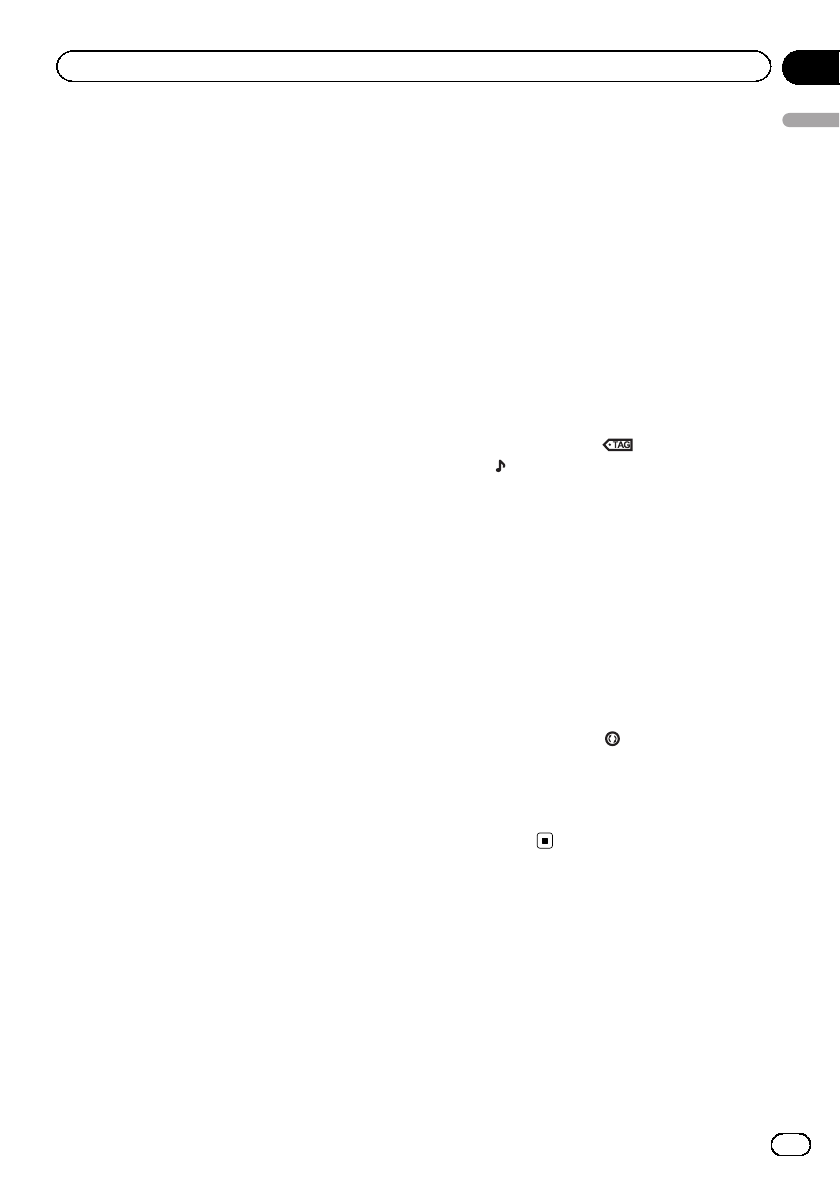
Using iTunes tagging
This function can be operated with the following
iPod models.
—iPhone 4
—iPod 6th generation
—iPod 5th generation
—iPod nano 6th generation
—iPod nano 5th generation
—iPod nano 4th generation
—iPod nano 3rd generation
—iPod classic
—iPod classic 2nd generation
—iPod touch 4th generation
—iPod touch 3rd generation
—iPod touch 2nd generation
—iPod touch 1st generation
—iPhone
—iPhone 3G
However, tag information can be stored in this
unit even while other iPod models are used.
When you want to use this function in the HD
Radio tuner source, use an HD Radio tuner
(GEX-P20HD).
The song information (tag) can be saved from
the broadcasting station to your iPod. The
songs will show up in a playlist called “Tagged
playlist”in iTunes the next time you sync your
iPod. Then you can directly buy the songs you
want from the iTunes Store.
The tagged songs and the song that you can
buy from the iTunes Store may be different.
Make sure to confirm the song before you
make the purchase.
If you cannot use this function normally, up-
date your iPod firmware.
Storing the tag information to
this unit
1 Tune in to the broadcast station.
2 Store the tag information to this unit.
Refer to Introduction of tuner operations on
page 17.
Refer to Introduction of HD Radioätuner opera-
tions on page 31.
You can store the information if the TAG indi-
cator is displayed while the desired song is
being broadcast.
#While storing the tag data on this unit, TAG
flashes.
#The tag information for up to 50 songs can be
stored on this unit.
#Depending on the timing of when the tag in-
formation is stored, the tag information for the
song played before or after the currently playing
song may also be stored.
#If an SD is selected as the source while tag in-
formation is being stored to this unit, the tag in-
formation will not be transferred to the iPod.
3 When completed, indicator turns
off and indicator is displayed.
Storing the tagged information
to your iPod
1 Connect your iPod if it's not connected
to this unit.
When your iPod is connected to this unit, your
iPod starts storing the tagged information
automatically.
#While transferring the tag, you cannot select
the SD source.
2 When completed, indicator turns off
and the tagged information is stored on
your iPod.
#Tag information cannot be transferred to the
iPod when a file on an SD device is being viewed
as a slideshow.
Switching the media file type
When playing a disc containing a mixture of
various media file types, such as DivX and
MP3, you can switch between media file types
to play.
Audio data (CD-DA) and JPEG picture files on
DVD-R/RW/ROM cannot be played back on
this unit.
En 33
Section
13
Detailed instructions
Detailed instructions
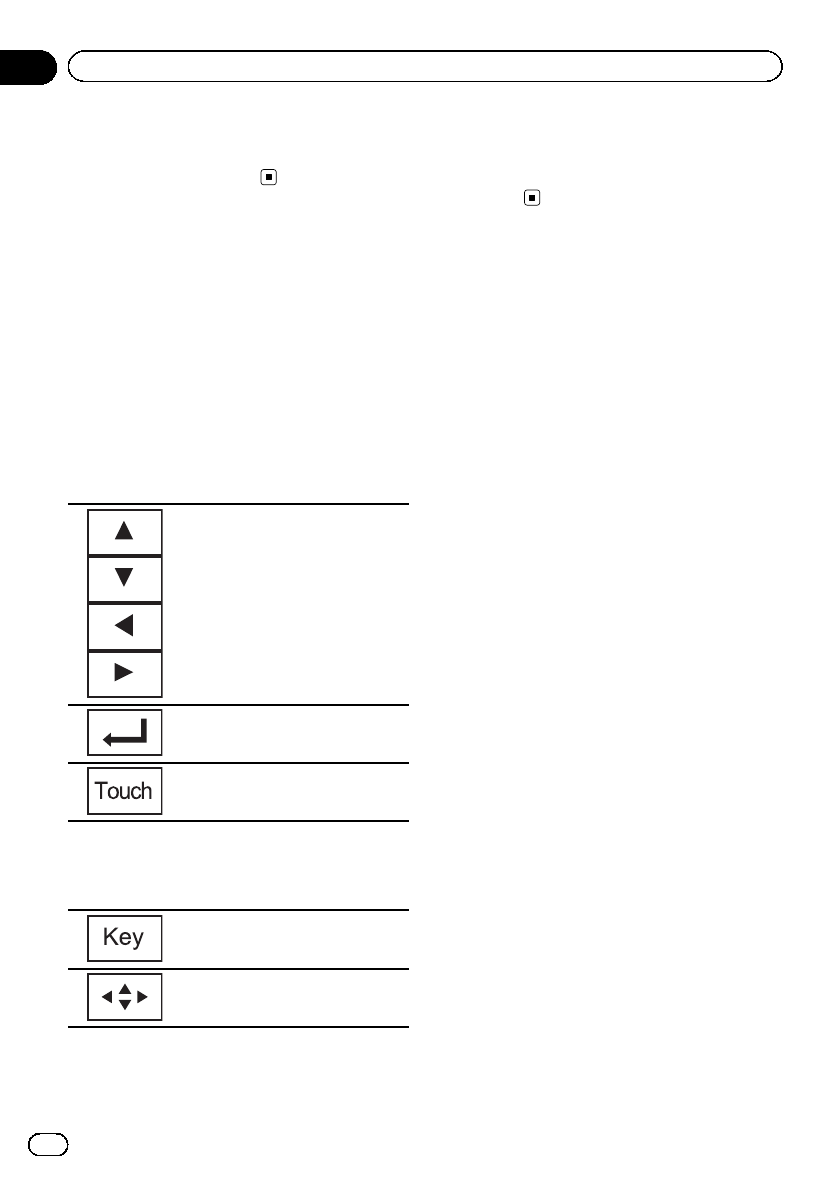
CD (audio data (CD-DA))—Music/ROM (com-
pressed audio)—Video (DivX video files)—
Photo (JPEG picture files)
Operating the DVD menu
(Function for DVD video)
Some DVDs allow you to make a selection
from the disc contents using a menu.
Using the arrow keys
1 Display arrow keys to operate the DVD
menu.
Refer to Playing moving images on page 18.
2 Select the desired menu item.
Selecting the desired menu item.
Starting playback from the se-
lected menu item.
Operating the DVD menu by di-
rectly touching the menu item.
#When operating the DVD menu by directly
touching the menu item, touch the icon to oper-
ate.
Returning to the normal DVD video
display.
Displaying arrow keys.
#Ways to display the menu will differ depend-
ing on the disc.
#Depending on the contents of the DVD disc,
this function may not work properly. In such
cases, use the touch panel keys to operate the
DVD menu.
Operating this unit’s iPod
function from your iPod
You can listen to the sound from your iPod ap-
plications using your car’s speakers, when
App Mode is selected with following iPod
models.
This function is not compatible with the follow-
ing iPod models.
!iPod nano 1st generation
!iPod 5th generation
!While this function is in use, the iPod will
not turn off even if the ignition key is turned
off. Operate the iPod to turn off the power.
1 Switch the control mode to App Mode.
Refer to Introduction of video playback opera-
tions on page 18.
Refer to Introduction of sound playback opera-
tions on page 21.
2 Operate the connected iPod to select a
video/song and play.
Notes
!The following functions are still accessible
from the unit even if the control mode is set to
App Mode.
However, the operation will depend on your
applications.
—Playing/pausing
—Fast forwarding/reversing
—Tracking up/down
—Moving to a chapter up/down
!APP mode is compatible with the following
iPod models.
—iPhone 4 (software version 4.1 or later)
—iPhone 3GS (software version 3.0 or later)
—iPhone 3G (software version 3.0 or later)
—iPhone (software version 3.0 or later)
En
34
Section
13 Detailed instructions
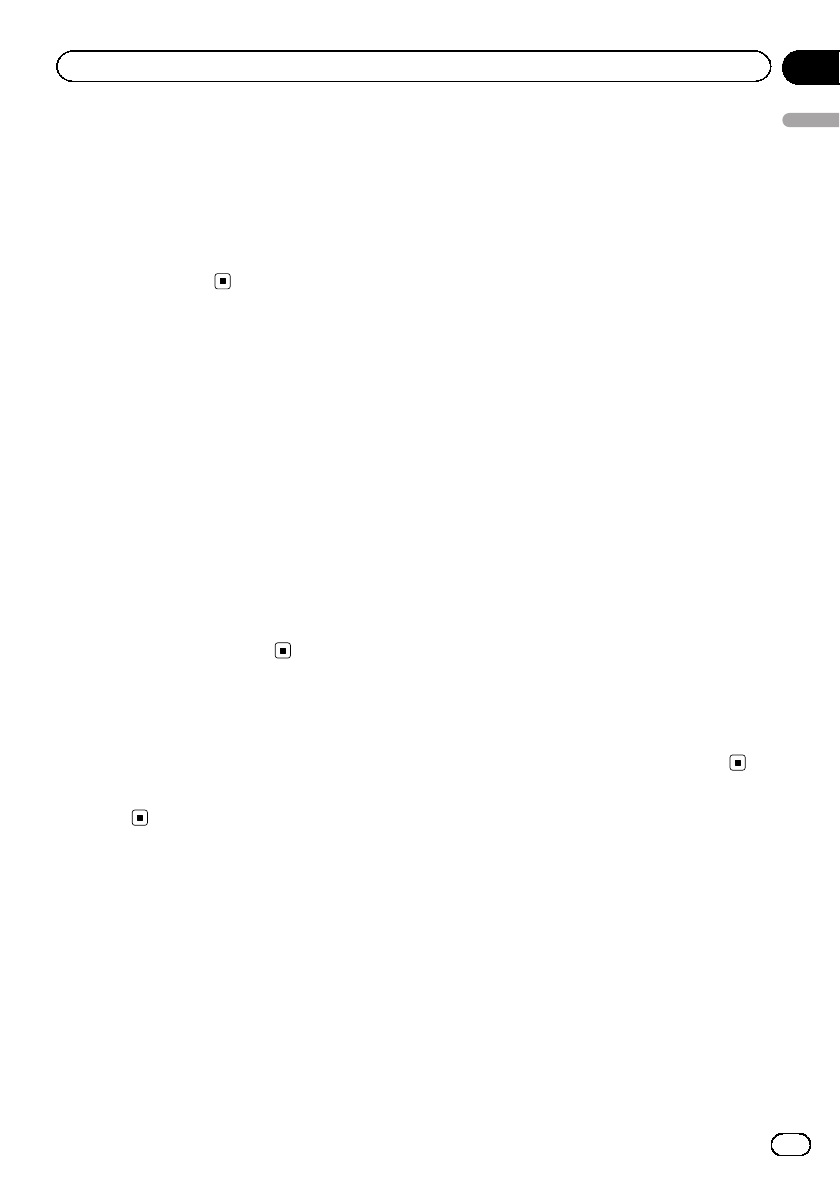
—iPod touch 4th generation (software ver-
sion 4.1 or later)
—iPod touch 3rd generation (software ver-
sion 3.0 or later)
—iPod touch 2nd generation (software ver-
sion 3.0 or later)
—iPod touch 1st generation (software ver-
sion 3.0 or later)
Random play (shuffle)
Videos/songs/files can be played back in ran-
dom order.
!Songs –Play back videos/songs in the se-
lected list in random order.
!Albums –Play back videos/songs from a
randomly selected album in order.
!Folder –Play back songs/tracks in the se-
lected folder in random order.
!Disc –Play back songs/tracks in the se-
lected disc in random order.
!On –Play back files in random order within
the repeat range, Folder and Disc.
!Off –Cancel random play.
Playing all songs in random
order (shuffle all)
(Function for iPod)
This method plays all songs on the iPod
randomly.
Repeating playback
!Disc –Play through the current disc
!Chapter –Repeat the current chapter
!Title –Repeat the current title
!Track –Repeat the current track
!File –Repeat the current file
!Folder –Repeat the current folder
!One –Repeat just the current video/song/
track
!All –Repeat all videos/songs in the se-
lected list on the iPod
Repeat all files
!This function cannot be operated during
Video CD playback featuring PBC (playback
control).
!If you perform chapter search, fast forward/
reverse, frame-by-frame playback or slow
motion playback, the title repeat play will
stop.
!When playing discs with compressed audio
and audio data (CD-DA), playback is re-
peated within the type of data currently
playing even if Disc is selected.
!If you select another folder during repeat
play, the repeat play range changes to Disc.
If you select USB or SD source, the repeat
play range changes to All.
!If you perform track search or fast forward/
reverse during File, the repeat play range
changes to Folder.
!If you perform title/chapter search, fast for-
ward/reverse, frame-by-frame playback or
slow motion playback during Chapter, the
repeat play range changes to OFF.
!If you perform track search or fast forward/
reverse during Track, the repeat play range
changes to Disc.
!When Folder is selected, it is not possible
to play back a subfolder of that folder.
Playing videos from your iPod
(Function for iPod)
Videos can be played on this unit if an iPod
with video capabilities is connected.
!This unit can play back “Movies”,“Music vi-
deos”,“Video Podcast”and “TV show”
which are downloaded from the iTunes
store.
!Before you display the video screen, be
sure to change the video setting on the
iPod so that the iPod can output the video
to an external device.
En 35
Section
13
Detailed instructions
Detailed instructions
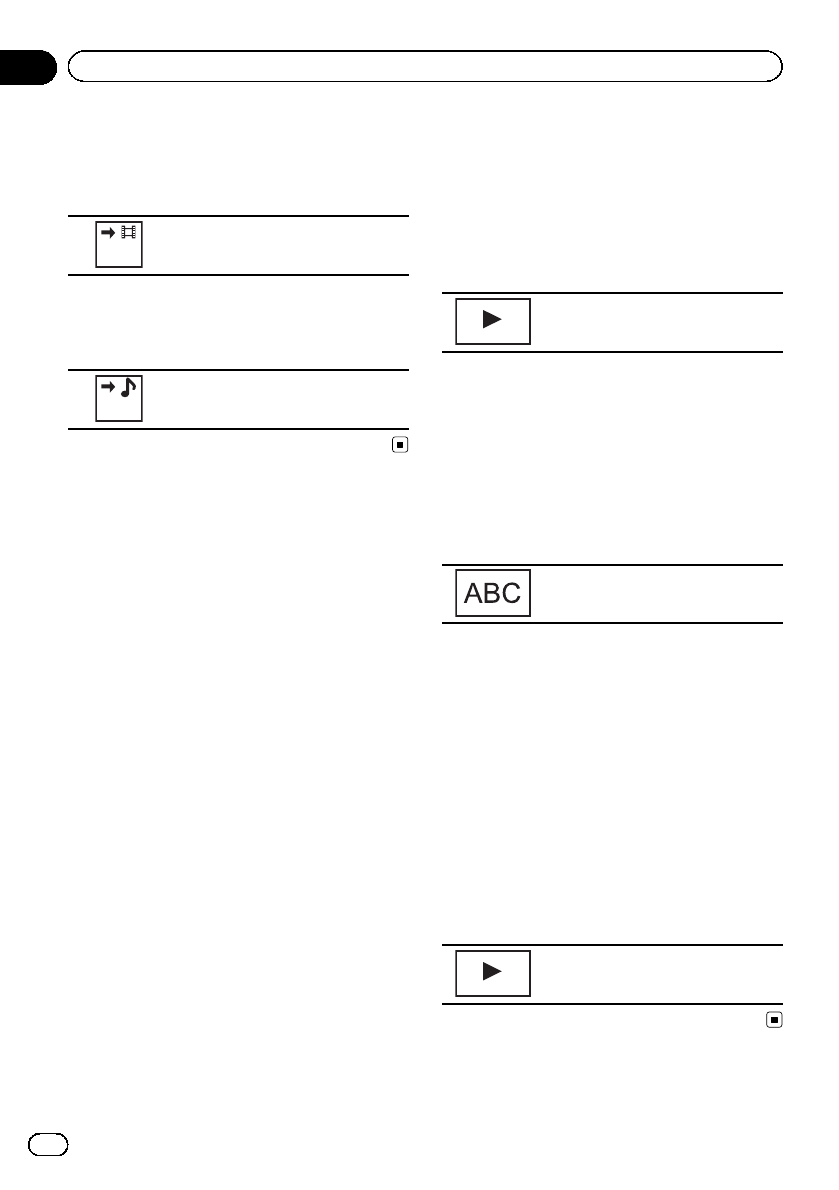
1 Display the iPod menus.
Refer to Playing moving images on page 18.
2 Switch to iPod video mode.
Video
Switching to iPod video mode.
3 Play the video from the iPod.
#If you want to switch to iPod music mode,
touch the icon.
Music
Switching to iPod music mode.
Browsing for a video/music
on the iPod
(Function for iPod)
To make operating and searching easy, opera-
tions to control an iPod with this unit are de-
signed to be as similar to the iPod as possible.
Searching for a video/music by
category
1 Display the iPod menus.
Refer to Playing moving images on page 18.
Refer to Playing audio on page 21.
2 Touch one of the categories in which
you want to search for a video/music.
!Video Playlists (video playlists)
!Movies (movies)
!Music Videos (music videos)
!Video Podcasts (video podcasts)
!TV Shows (TV shows)
!Playlists (playlists)
!Artists (artists)
!Albums (albums)
!Songs (songs)
!Podcasts (podcasts)
!Genres (genres)
!Composers (composers)
!Audiobooks (audiobooks)
3 Touch the title of the list that you want
to play.
Repeat this operation until you find the de-
sired video/music.
4 Start playback of the selected list.
Starting playback of the selected list.
Searching the list by alphabet
(Function for iPod)
1 Select a category.
Refer to Searching for a video/music by cate-
gory on this page.
2 Switch to alphabet search mode.
Switching to alphabet search mode.
Alphabet search mode is displayed.
3 Touch the first letter of the title of the
video/song you are looking for.
While searching, touch panel key operation is
not available.
#To refine the search with a different letter,
touch Cancel.
4 Touch the title of the list that you want
to play.
Repeat this operation until you find the de-
sired song/video.
5 Start playback of the selected list.
Starting playback of the selected list.
En
36
Section
13 Detailed instructions
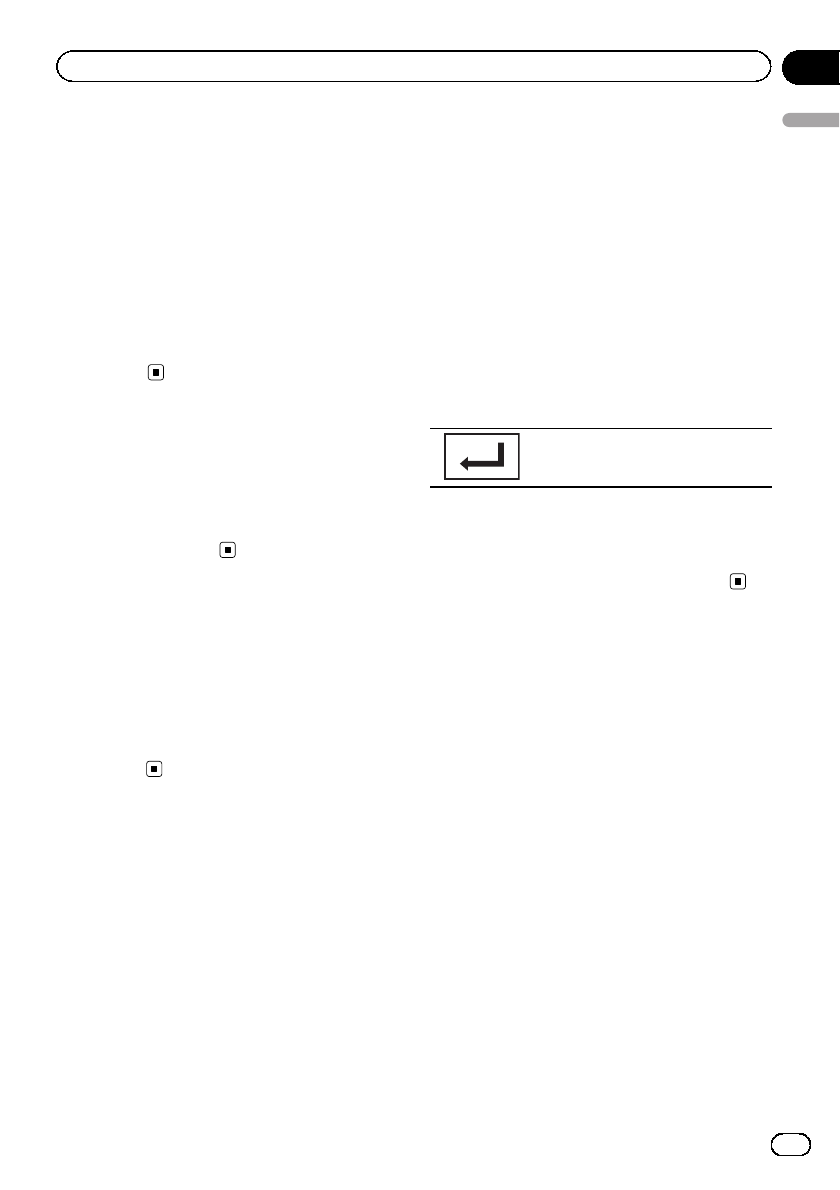
Resume playback (Bookmark)
(Function for DVD video)
By using the Bookmark function, you can re-
sume playback from a selected scene the next
time the disc is loaded.
The selected scene will be bookmarked so that
playback resumes from that point next time.
!To clear the bookmark on a disc, touch and
hold the button during playback.
!The oldest bookmark is replaced by the
new one.
Frame-by-frame playback
(Function for DVD video/video CD/DivX file)
Note
Images during frame-by-frame playback may be
unclear for some discs.
Slow motion playback
Notes
!There is no sound during slow motion play-
back.
!Images during slow motion playback may be
unclear for some discs.
!Reverse slow motion playback is not
available.
Searching for the part you
want to play
You can use the search function to find the
part you want to play.
For DVD videos, you can select Title (title),
Chapter (chapter) or 10key (numeric keypad).
For video CDs, you can select Track (track) or
10key (numeric keypad).
!Chapter search is not available when disc
playback is stopped.
!This function cannot be operated during
some DVD videos or Video CD playback
featuring PBC (playback control).
1 Start the search function.
Refer to Playing moving images on page 18.
2 Touch the desired search option (e.g.,
Chapter).
3 Touch 0 to 9 to input the desired num-
ber.
#To cancel the entered numbers, touch C.
4 Start playback from the selected part.
Registering the numbers and start-
ing playback.
Note
With discs featuring a menu, you can also use
the DVD menu to make your selection.
Refer to Playing moving images on page 18.
Changing audio language
during playback (Multi-audio)
With DVDs/DivX files that provides audio play-
back in different languages and different
audio systems (Dolby Digital, DTS, etc.), you
can switch between languages/audio systems
during playback.
Notes
!With some DVDs, switching between lan-
guages/audio systems may only be possible
using a menu display.
!You can also switch between languages/audio
systems using Video Setup menu. For details,
refer to Setting the audio language on page 56.
!Only digital output of DTS audio is possible. If
the unit’s optical digital outputs are not con-
nected, select an audio setting other than
DTS.
En 37
Section
13
Detailed instructions
Detailed instructions
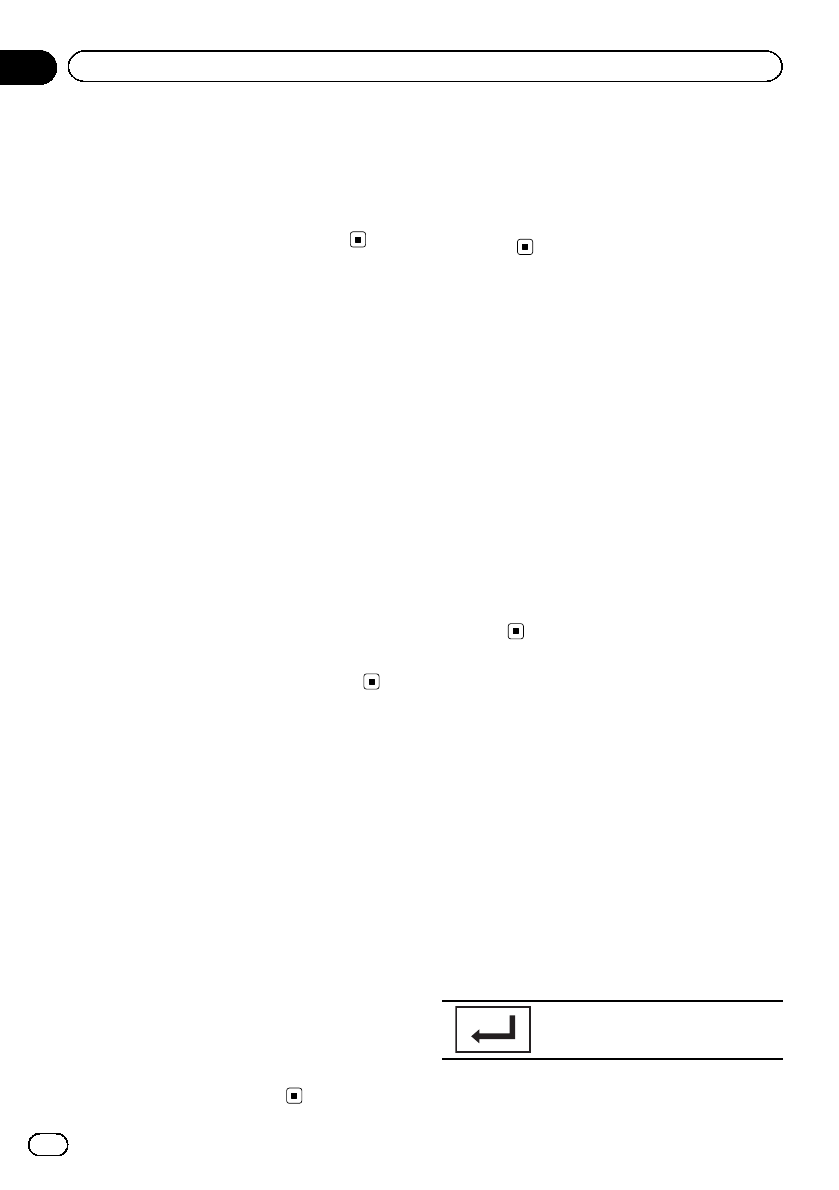
!Depending on the setting, the video may not
be played back with the audio system used to
record the DVD.
!You will return to normal playback if you
change the Audio during fast forward/fast re-
wind, pause or slow motion playback.
Changing the subtitle
language during playback
(Multi-subtitle)
With DVDs/DivX files featuring multi-subtitle
recordings, you can switch between subtitle
languages during playback.
Notes
!With some DVDs, switching between subtitle
languages may only be possible using a menu
display.
!You can also switch between subtitle lan-
guages using Video Setup menu. For details,
refer to Setting the subtitle language on page
56.
!You will return to normal playback if you
change the Subtitle during fast forward/fast
rewind, pause or slow motion playback.
Changing the viewing angle
during playback (Multi-angle)
With DVDs featuring multi-angle (scenes shot
from multiple angles) recordings, you can
switch among viewing angles during play-
back.
!During playback of a scene shot from mul-
tiple angles, the angle icon is displayed.
Use the Video Setup menu to turn the
angle icon display on or off. For details,
refer to Setting the multi-angle DVD display
on page 57.
Note
You will return to normal playback if you change
the viewing angle during fast forward/fast rewind,
pause or slow motion playback.
Return to the specified scene
(Function for DVD video)
This function cannot be used if a specified
scene has not been preprogrammed on the
DVD disc.
Selecting audio output
When playing DVD video discs recorded with
LPCM audio, you can switch the audio output.
When playing video CDs, you can switch be-
tween stereo and monaural audio output.
!This function is not available when disc
playback is stopped.
!L+R –left and right
!Left –left
!Right –right
!Mix –mixing left and right
You may not be able to select or use this func-
tion depending on the disc and the playback
location.
PBC playback
(Function for Video CDs)
During playback of Video CDs featuring PBC
(Playback Control), PBC ON is displayed.
1 Start the search function.
Refer to Playing moving images on page 18.
2 Touch 10key to display the numeric
keypad.
3 Touch 0 to 9 corresponding to a menu
number.
4 Start playback from the selected part.
Registering the numbers and start-
ing playback.
En
38
Section
13 Detailed instructions
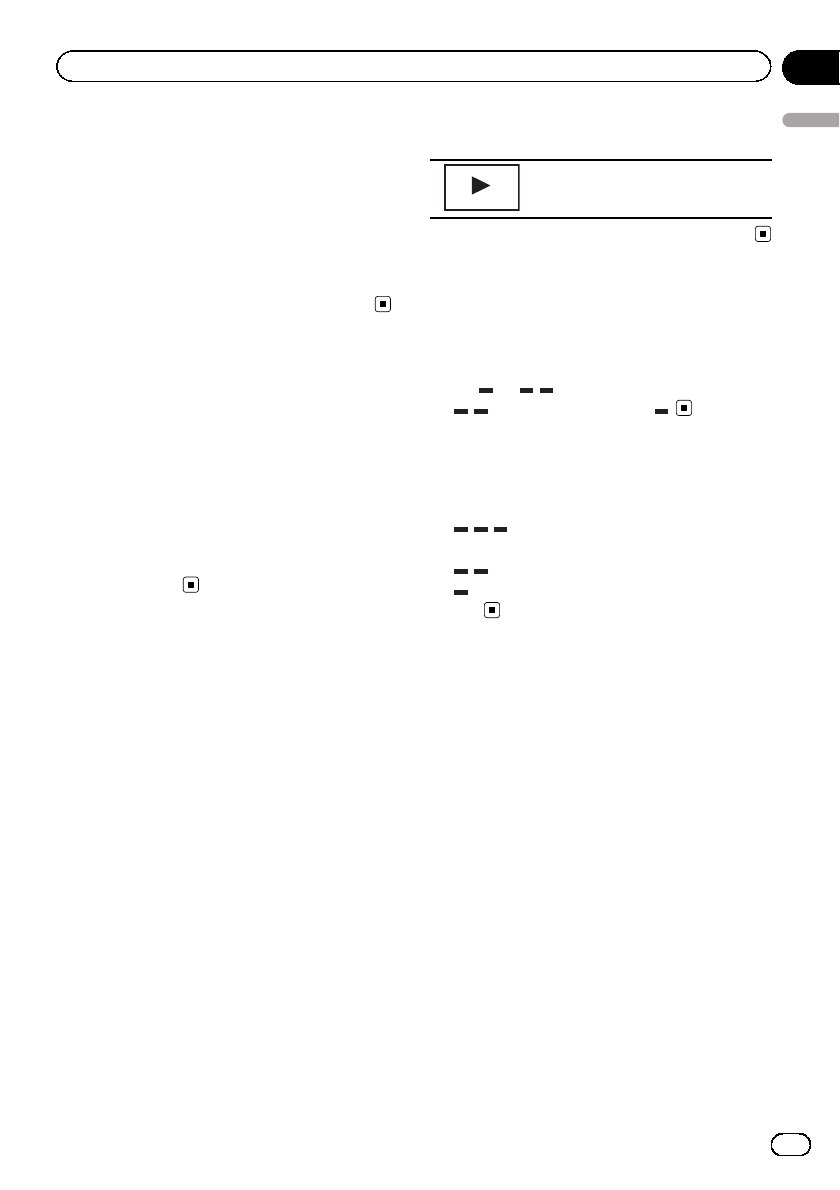
Notes
!You can display the menu by touching Return
during PBC playback. For details, refer to the
instructions provided with the disc.
!PBC playback of a Video CD cannot be can-
celed.
!During playback of Video CDs featuring PBC
(Playback Control), you cannot select the re-
peat play range or use the search function.
Selecting tracks from the
track title list
You can select tracks to playback using the
track title list which is a list of the tracks re-
corded on a disc.
1 Display the track title list.
Refer to Playing audio on page 21.
2 Touch your favorite track title.
Playback begins.
Selecting files from the file
name list
(Function for compressed audio/DivX/JPEG)
File name list is a list of file names (or folder
names) from which you can select a file (or
folder) to play back.
1 Display the file (or folder) name list.
Refer to Playing audio on page 21.
Refer to Introduction of still image playback op-
erations on page 25.
2 Touch your favorite file (or folder)
name.
#When you have selected a folder, a list of the
names of the files (or the folders) in it can be
viewed. Repeat this operation to select the de-
sired file name.
#If folder 01 (ROOT) contains no files, playback
commences with folder 02.
3 Start playback of the selected list.
Starting playback of the selected list.
Using S.Rtrv (sound retriever)
Automatically enhances compressed audio
and restores rich sound.
Off ——
!is more effective than .
Changing audiobook speed
(Function for iPod)
!–Playback at a speed faster than
normal
!–Playback at normal speed
!–Playback at a speed slower than nor-
mal
Displaying lists related to
the currently playing song
(Link Search)
(Function for iPod)
1 Start Link Search.
Refer to Introduction of sound playback opera-
tions on page 21.
2 Touch one of the categories in which
you want to play.
!Artist –Displays an album list of the artist
currently being played.
!Album –Displays a song list from the
album currently being played.
!Genre –Displays an album list from the
genre currently being played.
#To cancel searching, touch Cancel.
En 39
Section
13
Detailed instructions
Detailed instructions
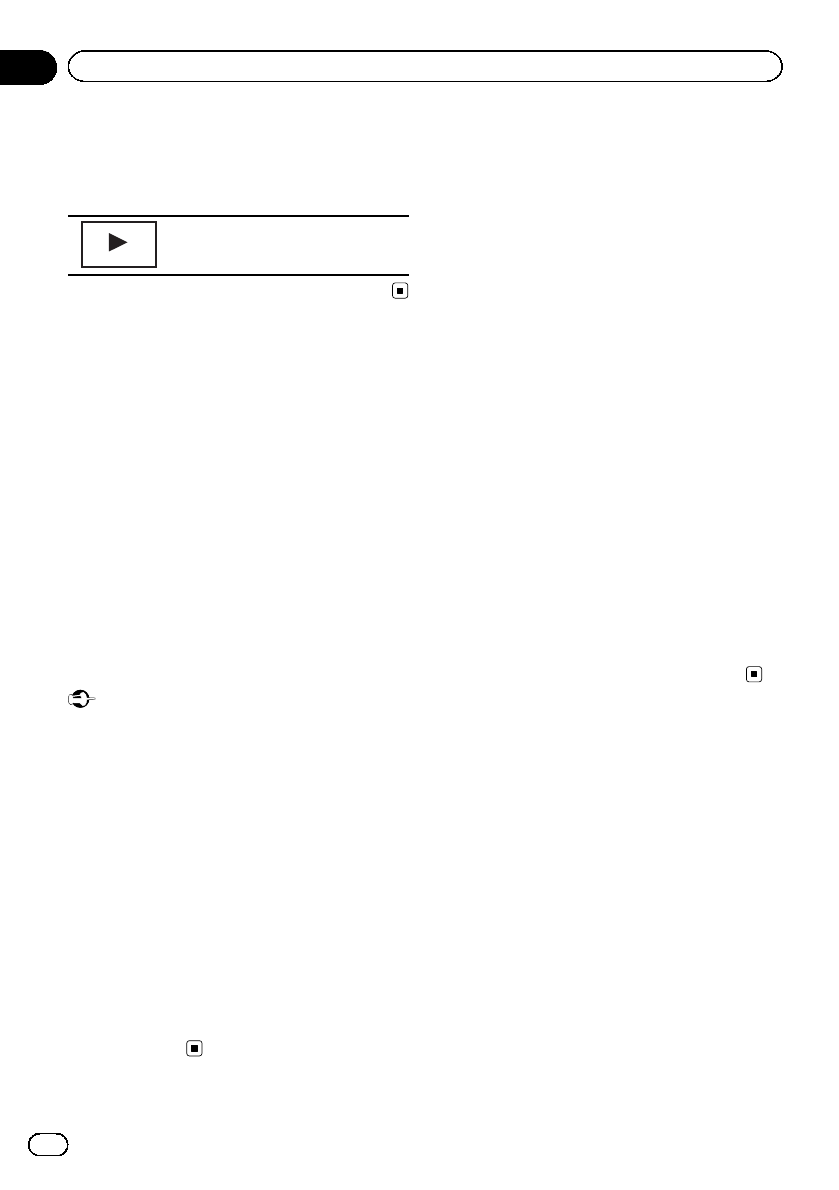
3 Touch the title of the list that you want
to play.
4 Start playback of the selected list.
Starting playback of the selected list.
Playing DivXâVOD content
Some DivX VOD (video on demand) content
may only be playable a fixed number of times.
When you load a disc containing this type of
content, the remaining number of times it can
be played is shown on-screen. You can then
decide whether or not to play the disc.
!If there is no limit to the number of times
the DivX VOD content can be viewed, then
you may load the disc into your player and
play the content as often as you like, and
no message will be displayed.
!You can confirm the number of times that
the content can be played by checking the
number displayed after Remaining Views:.
Important
!In order to play DivX VOD contents on this
unit, you first need to register the unit with
your DivX VOD contents provider. For details
on your registration code, refer to Displaying
the DivXâVOD registration code on page 59.
!DivX VOD content is protected by a DRM (Di-
gital Rights Management) system. This re-
stricts playback of content to specific,
registered devices.
%If a message is displayed after loading
a disc containing DivX VOD content, touch
Play.
Playback of the DivX VOD content will start.
#To skip to the next file, touch Next Play.
#If you do not want to play the DivX VOD con-
tent, touch Stop.
Capture an image in JPEG files
You can capture image data and use it as wall-
paper. Images can be stored and recalled ea-
sily in this unit.
!Only one image can be stored on this unit.
Old image is overwritten with the new one.
1 Pause the slideshow when the desired
image is displayed.
Refer to Introduction of still image playback op-
erations on page 25.
Refer to Introduction of still image playback as
a slideshow operations on page 26.
2 Capture the image.
Refer to Introduction of still image playback op-
erations on page 25.
Refer to Introduction of still image playback as
a slideshow operations on page 26.
3 When Do you save this image? is dis-
played, touch Yes.
While storing the image to this unit, Saving
the image Don’t switch off the battery. is
displayed. When the process is finished,
Image saved is displayed.
#To cancel the storage process, touch No.
Changing the wide screen
mode
You can select a desired mode for enlarging a
4:3 picture to a 16:9 picture.
1 Display the screen mode.
Refer to Introduction of video playback opera-
tions on page 18.
Refer to Introduction of still image playback op-
erations on page 25.
Refer to Introduction of still image playback as
a slideshow operations on page 26.
2 Touch the desired wide mode setting.
En
40
Section
13 Detailed instructions
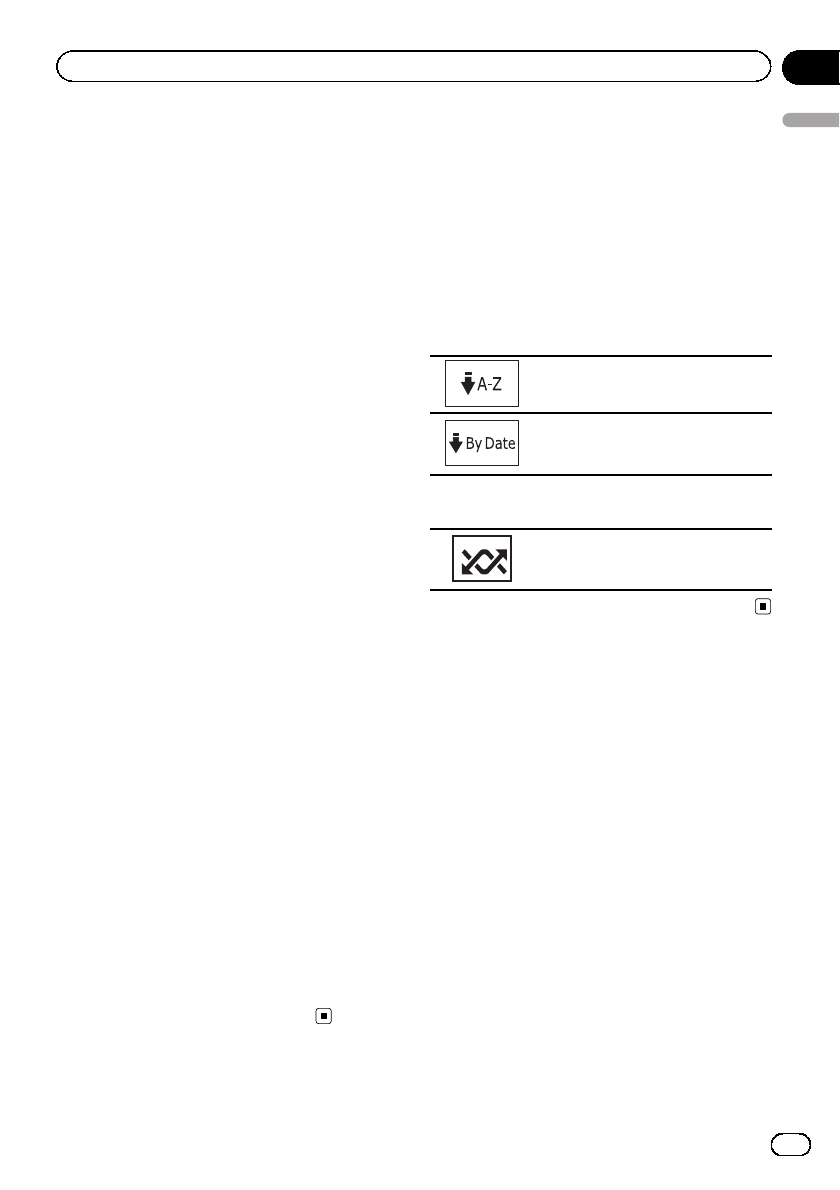
Full (full screen)
The 4:3 picture is enlarged in the horizontal direc-
tion only, giving you a 4:3 TV picture (normal pic-
ture) without any omissions.
Just (just)
The picture is enlarged slightly at the center and
the amount of enlargement increases horizontally
toward the edges of the screen, enabling you to
enjoy a 4:3 picture without sensing any disparity
even when viewing on a wide screen.
Cinema (cinema)
The picture is enlarged by the same proportion as
Full or Zoom in the horizontal direction and by
an intermediate proportion between Full and
Zoom in the vertical direction; ideal for a cinema-
sized picture (wide screen picture) where cap-
tions lie outside the picture.
Zoom (zoom)
The 4:3 picture is enlarged in the same proportion
both vertically and horizontally; ideal for a cinema
sized picture (wide screen picture).
Normal (normal)
The 4:3 picture is displayed as it is, giving you no
sense of disparity since its proportions are the
same as that of the normal picture.
Notes
!You cannot operate this function while driving.
!Different settings can be stored for each video
source.
!When a video is viewed in a wide screen mode
that does not match its original aspect ratio, it
may appear different.
!Remember that using the wide mode feature
of this system for commercial or public view-
ing purposes may constitute an infringement
on the author’s rights protected by the Copy-
right Law.
!The video image will appear coarser when
viewed in Cinema or Zoom mode.
Selecting and playing the
QuickMix/station list
Touch the list for your Pandora stations to se-
lect one of them to play.
1 Display the Quick Mix/station list.
Refer to Introduction of Pandora operations on
page 23.
2 Change the sort order.
You can sort the items in the list al-
phabetically.
You can sort the items in the list in
order of the dates on which the
items were created.
3 Select QuickMix or the desired station.
You can play only one song at a time
from a shuffled mix of several sta-
tions.
Storing song information
(bookmarks)
With the Bookmark function, you can select
an artist or a song to add to Bookmarks.
1 Switch to song information (bookmark)
storing mode.
Refer to Introduction of Pandora operations on
page 23.
The song information (bookmark) storing
mode is displayed.
En 41
Section
13
Detailed instructions
Detailed instructions
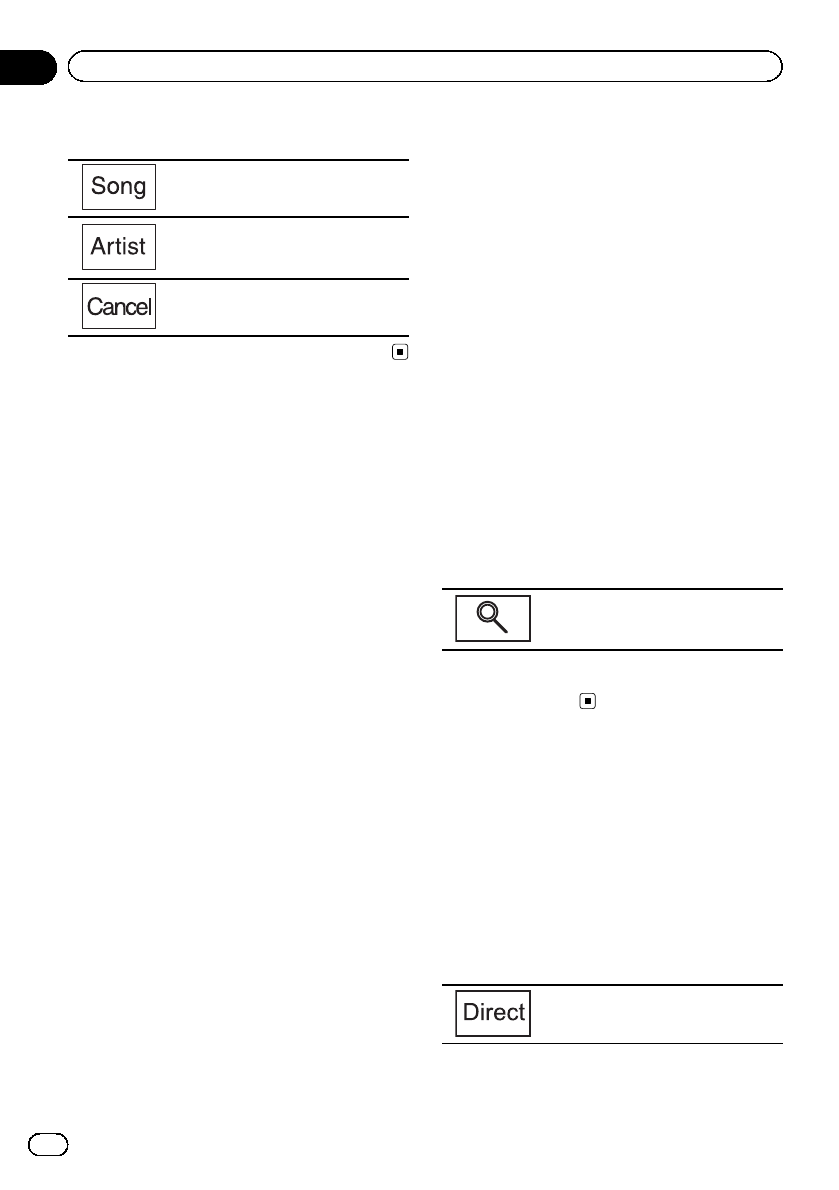
2 Storing or canceling a bookmark.
Adding information for the song cur-
rently playing to Bookmarks.
Adding artist information for the
song currently playing to Book-
marks.
Canceling a bookmark.
Switching the XM/SIRIUS
channel selection mode
You have two methods for selecting a channel:
by number and by category. When selecting
by number, channels in any category can be
selected. Select by category to narrow your
search down to only channels in a particular
category.
Mode All CH (channel number select setting)
—Mode Category (channel category select
setting)
Selecting a SIRIUS channel from
a channel category
Channels are organized into various program
categories, e.g. Rock, Classic, Jazz while lis-
tening to a SIRIUS station. You can specify
channels by selecting the desired category.
1 Select channel category selection
mode.
Refer to Introduction of XM/SIRIUS tuner opera-
tions on page 29.
Mode All CH (channel number select setting)
—Mode Category (channel category select
setting)
2 Touch aor bto select the desired chan-
nel category.
3 Touch cor don the buttons to select
the desired channel in the selected channel
category.
Selecting a channel from the
XM channel list display
The list content can be switched so you can
search for the track you want to listen to not
only by the channel name but also by the artist
name or song title.
!This function is available for GEX-P920XM.
!The channel list shows all the channels
during Mode All CH mode, and the chan-
nels included in the selected category dur-
ing Mode Category mode.
1 Display the preset channel list.
Refer to Introduction of XM/SIRIUS tuner opera-
tions on page 29.
2 Switch the channel list mode.
Switching the channel list mode to
the channel name or the artist
name/song title.
3 Touch the desired channel that you
want to listen to.
Selecting an XM/SIRIUS
channel directly
You can select an XM/SIRIUS channel directly
by entering the desired channel number.
1 Display the preset channel list.
Refer to Introduction of XM/SIRIUS tuner opera-
tions on page 29.
2 Switch to direct input display.
Switching to direct input display.
En
42
Section
13 Detailed instructions
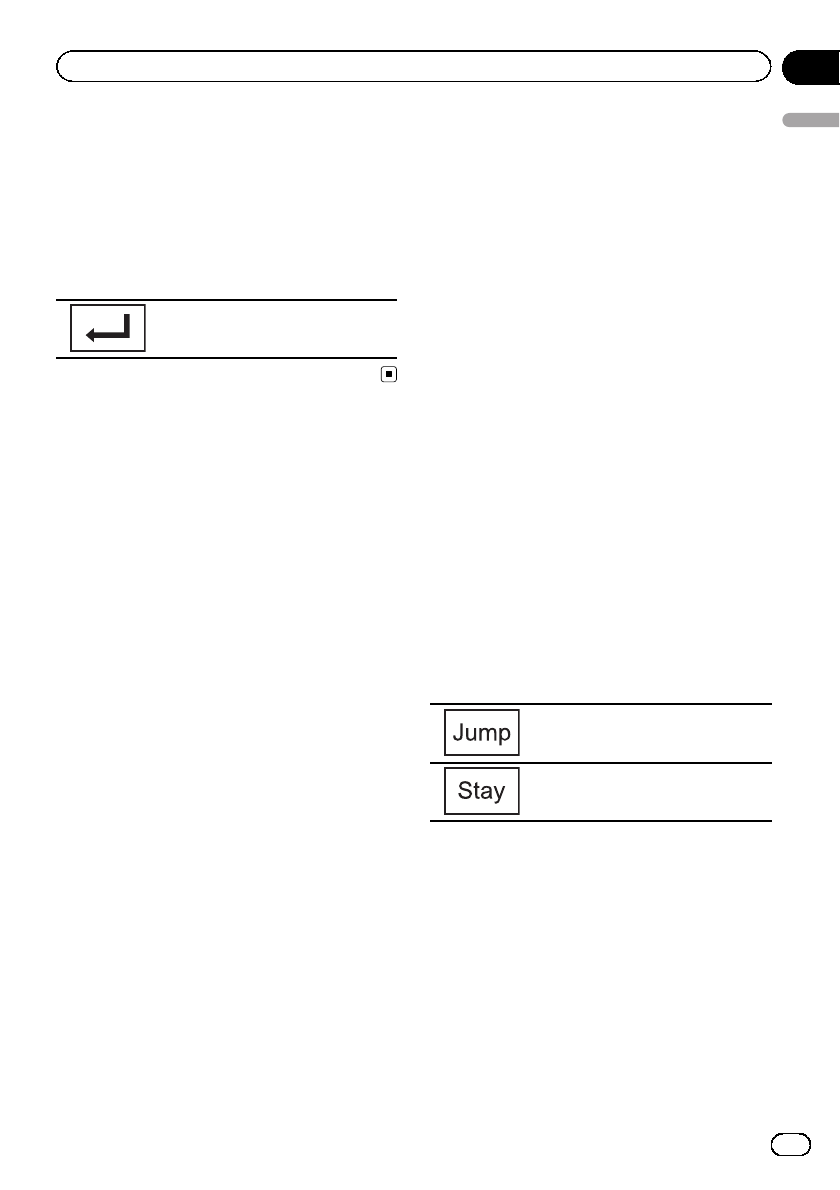
3 Touch 0 to 9 to input the desired chan-
nel number.
#To cancel the input numbers, touch C.
4 Select the XM/SIRIUS channel of the en-
tered number.
The XM/SIRIUS channel of the entered num-
ber is selected.
Selecting the XM/SIRIUS channel of
the entered number.
Using the MyMix function
The MyMix function allows you to make a
MyMix song playlist. When a song in the
MyMix playlist is being broadcast on a station
other than the one you are listening to, you
will be alerted, and you can tune in to the
other station to listen to that song.
!This function is available for GEX-P920XM/
SIRIUS tuner.
!The track itself is NOT downloaded. Only
the song title and artist name are stored.
Making the MyMix playlist
You can add a song that is being broadcast to
the MyMix playlist. When it is added, the song
title and its artist name are stored to this unit.
The MyMix function will start when you listen
to a song that matches a song title and its ar-
tist name in the MyMix playlist.
%Store the song title and artist name.
Refer to Introduction of XM/SIRIUS tuner opera-
tions on page 29.
The song title and artist name of the song you
are listening to are stored, and a confirmation
message appears.
#To delete a song from the MyMix playlist, refer
to Deleting a song from the MyMix playlist for XM
tuner on the next page and Deleting a song from
the MyMix playlist for SIRIUS tuner on the next
page.
#(XM tuner)
The song title and artist name of up to 12 tracks
can be stored. Old tracks will be overwritten
when saving more than 12 tracks.
#(SIRIUS tuner)
The song title and artist name of up to 10 tracks
can be stored. Old tracks will be overwritten
when saving more than 10 tracks.
#You cannot store the song title or the artist
name when “––––––––”is displayed for the
title information.
#You cannot store song titles or artist names
from channel 000.
#Stored titles may not be displayed correctly.
When a song in the MyMix
playlist is broadcast
(XM tuner)
As soon as a song in the MyMix playlist starts
being broadcast on a different station, a mes-
sage is displayed. Touch Yes to switch to that
station, and you can listen to that song.
(SIRIUS tuner)
As soon as a stored song starts being broad-
cast on a different station, a song alert is dis-
played.
Switching to the other station to lis-
ten to that track.
Not tuning in to the other station.
!(XM tuner)
If you would rather not to tune in to the
other station, touch No.
!If an alert for a song in the MyMix playlist is
set to off, no alert will be provided even
when the song is broadcast. Refer to Set-
ting up a song alert on the next page.
!If the stored title and the title of the song
being broadcast differ, no alert will be pro-
vided even if they are the same song.
En 43
Section
13
Detailed instructions
Detailed instructions
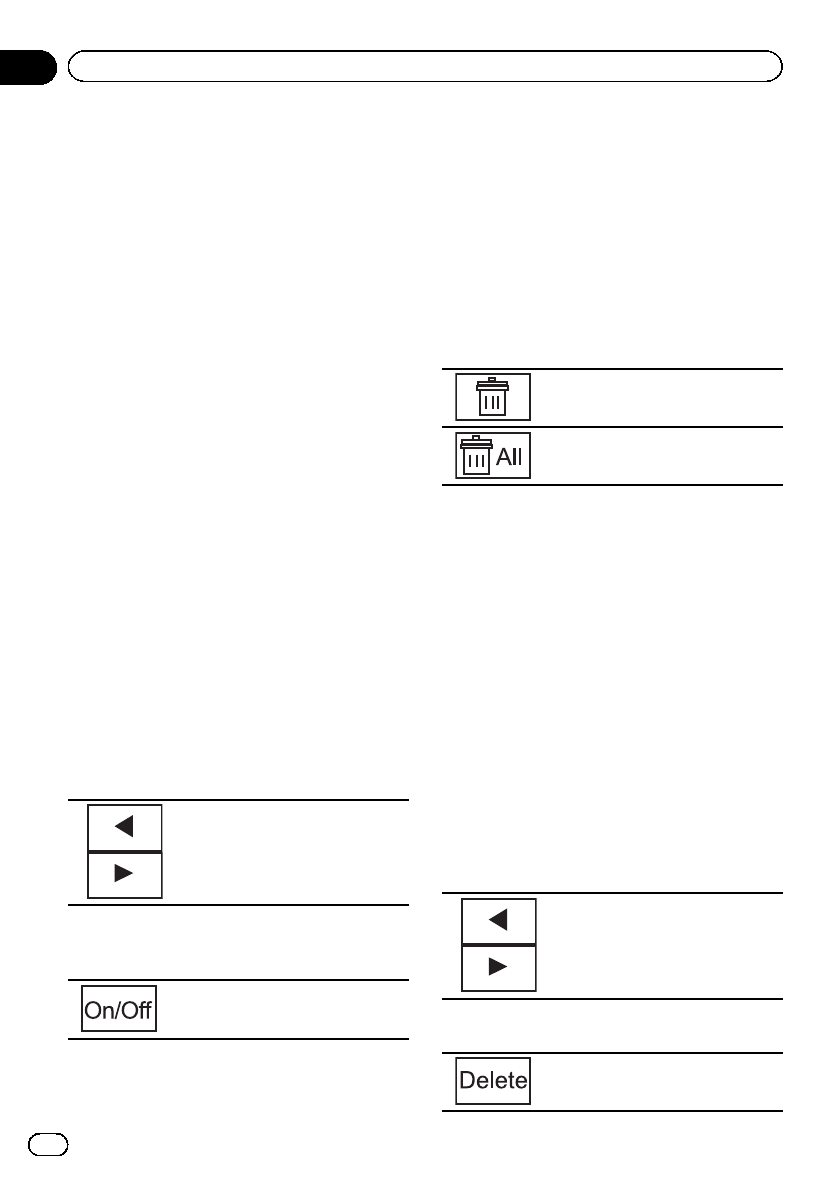
Turning the MyMix function on
or off
You can turn the MyMix function off and stop
the alerts for all the songs in the MyMix play-
list. To restart, turn this function on.
The MyMix function is on as the default set-
ting.
%Turn the MyMix function on or off.
Refer to Introduction of XM/SIRIUS tuner opera-
tions on page 29.
Setting up a song alert
You can set up an alert (on or off) for each
song in the MyMix playlist. First, display the
MyMix playlist and then change each alert set-
ting. Set the alert to on to receive an alert
when the song is broadcast, or set it to off to
stop the alert for that song.
1 Switch to memo edit mode.
Refer to Introduction of XM/SIRIUS tuner opera-
tions on page 29.
The MyMix playlist is displayed.
2 Select the song title for which you
want to turn the alert on or off.
(XM tuner)
The check mark is removed, and the alert for
that song is off.
(SIRIUS tuner)
Selecting the song title for which
you want to turn the alert off.
3 Turn the alert on or off.
(SIRIUS tuner)
Turning the alert on or off.
Deleting a song from the
MyMix playlist for XM tuner
You can delete each song in the MyMix play-
list.
1 Switch to memo edit mode.
Refer to Introduction of XM/SIRIUS tuner opera-
tions on page 29.
The MyMix playlist is displayed.
2 Delete the song title.
Deleting the song title.
Deleting all the songs in the MyMix
playlist.
That song will be deleted from the MyMix play-
list.
A message to confirm deletion will appear.
3 Touch Yes.
#To cancel deletion, touch No.
Deleting a song from the
MyMix playlist for SIRIUS tuner
You can delete each song in the MyMix play-
list.
1 Switch to memo edit mode.
Refer to Introduction of XM/SIRIUS tuner opera-
tions on page 29.
2 Select the song title that you want to
delete.
Selecting the song title that you
want to delete.
3 Delete the song title.
Deleting the song title.
En
44
Section
13 Detailed instructions
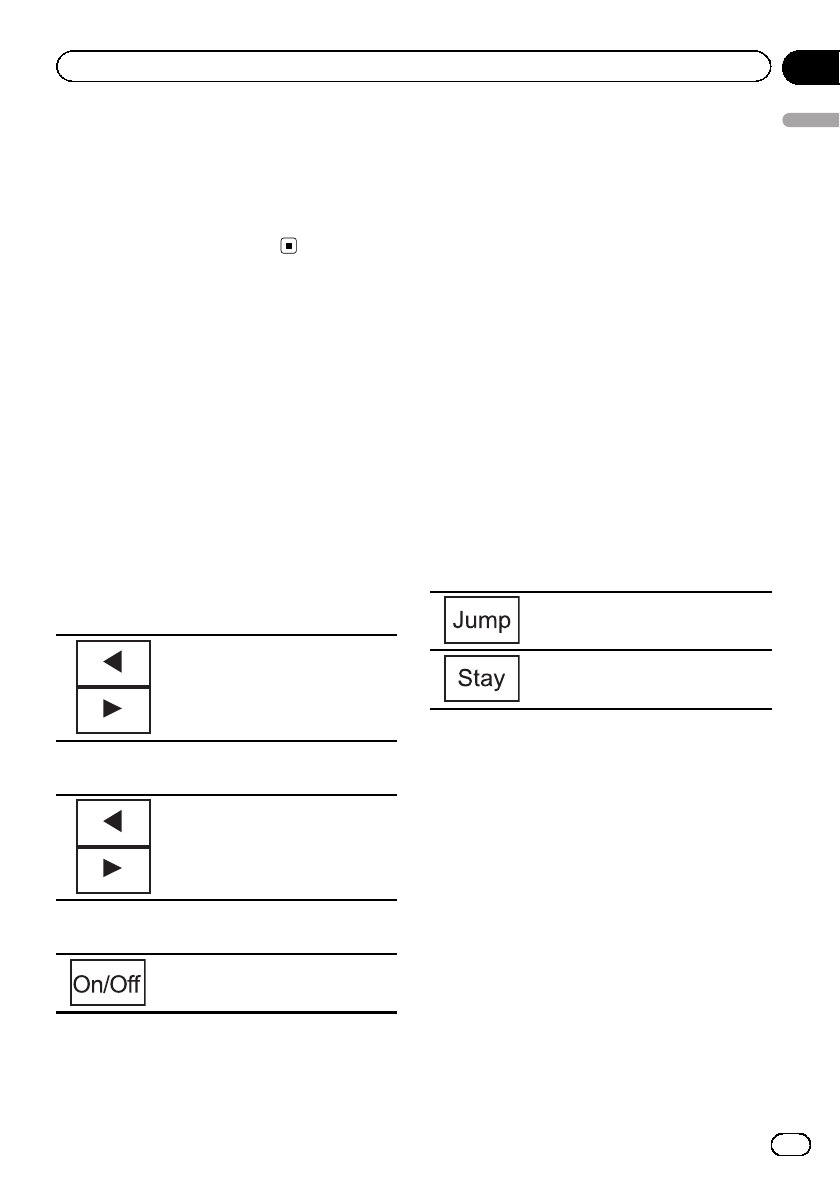
A message to confirm deletion will appear.
4 Touch Yes.
That song will be deleted from the MyMix play-
list.
#To cancel deletion, touch No.
Using the Game Alert function
This system can alert you when games invol-
ving your favorite teams are about to start. To
use this function you need to set up a game
alert for the teams in advance.
!This function is available for SIR-PNR2/SIR-
PNR2C.
Selecting teams for Game Alert
1 Start Game Alert setup.
Refer to Introduction of XM/SIRIUS tuner opera-
tions on page 29.
2 Select a desired league in League.
Switching the league name.
3 Select a desired team in Team.
Switching the team name.
4 Turn the alert on or off.
Turning the alert on or off.
The game alert function is activated for that
team.
#When you have already selected 12 teams,
FULL is displayed and additional teams cannot
be selected. In this case, first delete a selected
team and then try again.
5 Repeat these steps to select other
teams.
Up to 12 teams can be selected.
Switching the Game Alert on or off
Once you select the teams, you need to turn
the Game Alert function on.
The Game Alert function is on at the default
setting.
When a game of a selected
team starts
When a game of the selected team is about to
start (or is currently playing) on a different sta-
tion, a game alert is displayed.
Switching to the other station to lis-
ten to the game.
Not tuning in to the other station.
Displaying game information
If any games of the selected teams are cur-
rently playing, you can display information on
the games and tune in to the broadcast chan-
nel.
1 Display the game information for the
selected team.
Refer to Introduction of XM/SIRIUS tuner opera-
tions on page 29.
2 Touch cor dto select a game.
The game is displayed, followed by more de-
tailed game information.
!The game score will be updated automati-
cally.
En 45
Section
13
Detailed instructions
Detailed instructions
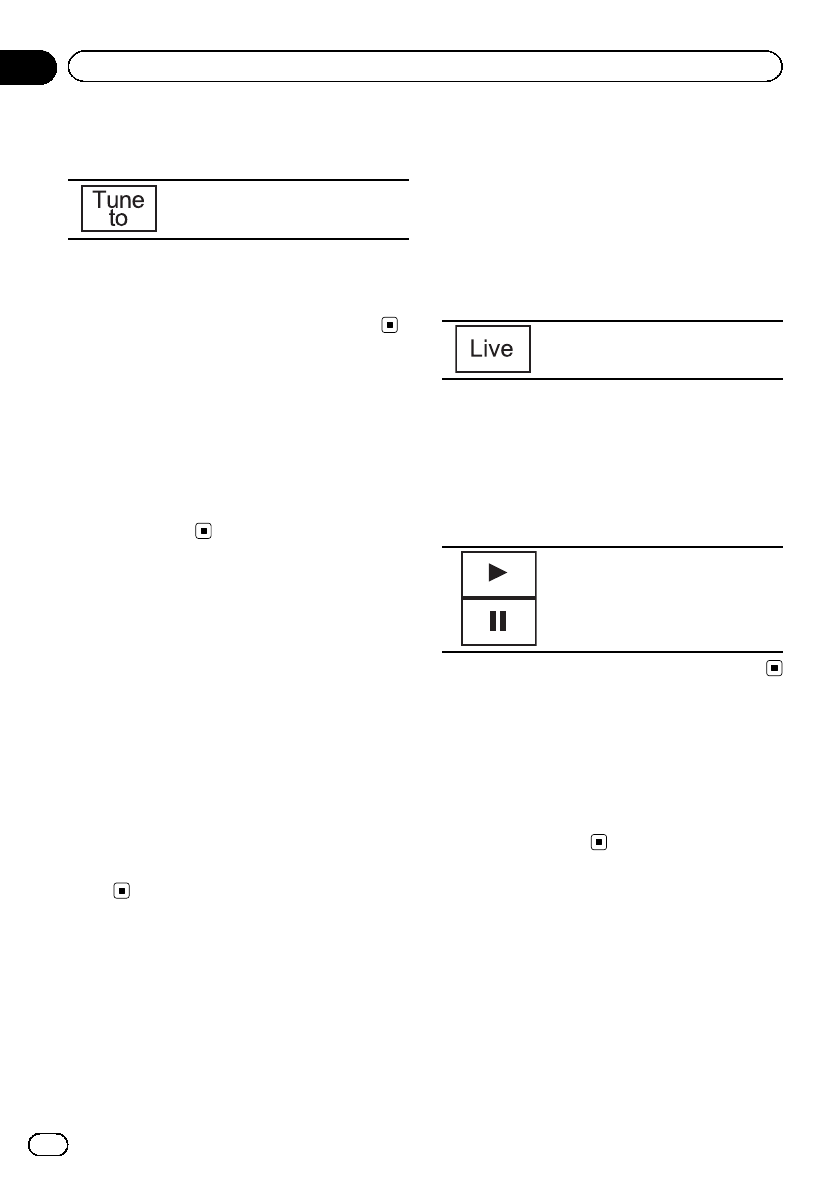
3 Switch to the other station to listen to
the game.
Switching to the other station to lis-
ten to the game.
#If you have not selected any teams, NOT SET
is displayed.
#When games involving your favorite teams are
not currently playing, NO GAME is displayed.
Displaying the Radio ID
Channel number selection setting
If you select CH000, the ID code is displayed.
%Select CH000.
Refer to Introduction of XM/SIRIUS tuner opera-
tions on page 29.
Switching the SIRIUS display
!Actions will differ depending on the con-
nected SIRIUS tuner.
%Touch SIRIUS information to switch the
SIRIUS display.
Refer to Introduction of XM/SIRIUS tuner opera-
tions on page 29.
Channel number—Channel name—Category
name—Artist name—Song title/Title name—
Composer name—Play time
Note
Play time is displayed during the Instant Replay
mode.
Using the Instant Replay
function
The following functions can be operated in In-
stant Replay mode.
!To use this function, a Pioneer SIRIUS bus
interface (e.g. CD-SB10) is required.
!To use this function, a SIRIUS plug-and-
play unit with an Instant Replay Function is
required.
!For details, refer to the SIRIUS plug-and-
play unit’s manuals.
%To exit from Instant Replay mode, se-
lect another source or touch the following
icon.
Exiting from Instant Replay mode.
%Select a track
Press cor d(TRACK/SEEK).
%Fast forward or reverse
Press and hold cor d(TRACK/SEEK).
%Pause and play
Playing and pausing.
Switching the seek mode
There are two seek tuning settings, one is
Seek HD (Digital broadcasting stations seek)
and the other is Seek All (normal seek).
Seek All—Seek HD
Switching the reception mode
If the reception for a digital broadcast be-
comes poor, this unit automatically switches
to the analog broadcast of the same fre-
quency. If this function is set to D/A Auto, the
tuner switches between digital broadcast and
analog broadcast automatically. If this func-
tion is set to Analog, the tuner will only re-
ceive analog broadcasts.
En
46
Section
13 Detailed instructions
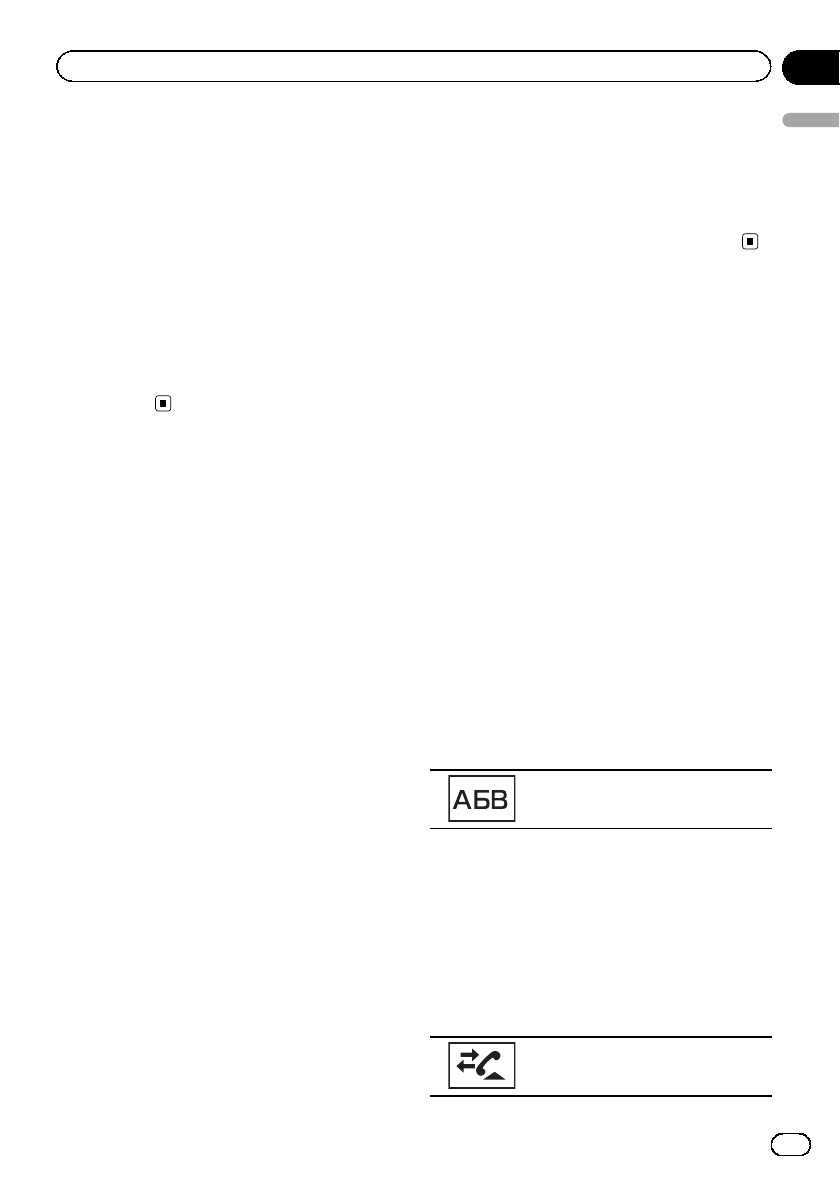
D/A Auto—Analog
Note
If SEEK MODE is set to Seek HD and BLENDING
is set to Analog, the tuner cannot receive broad-
casts. In this case, the seek mode or reception
mode is changed automatically as follows:
!When SEEK MODE is set to Seek HD, if you
switch BLENDING from D/A Auto to Analog,
SEEK MODE is changed to Seek All.
!When BLENDING is set to Analog, if you
switch SEEK MODE from Seek All to
Seek HD,BLENDING is changed to
D/A Auto.
Calling a number in the
phone book
The phone book in your cellular phone will be
transferred automatically when the phone is
connected to this unit.
After finding the number you want to call in
the phone book, you can select the entry and
make the call.
1 Switch to phone book mode.
Refer to Introduction of Bluetooth telephone op-
erations on page 27.
The phone book display appears.
2 Select the phone number list.
The detailed phone number list of the selected
entry is displayed.
3 Select the phone number.
#If you want to store the phone number, touch
and hold the list.
4 Make the call.
Refer to Introduction of Bluetooth telephone op-
erations on page 27.
5 End the call.
Refer to Introduction of Bluetooth telephone op-
erations on page 27.
Note
Depending on the cellular phone, the phone book
may not be transferred automatically. In this
case, operate your cellular phone to transfer the
phone book. The visibility of this unit should be
on. Refer to Switching visible unit on page 51.
Selecting a number by
alphabet search mode
If a lot of numbers are registered in the phone
book, you can search for the phone number by
alphabet search mode.
1 Switch to phone book mode.
Refer to Introduction of Bluetooth telephone op-
erations on page 27.
The phone book display appears.
2 Touch ABC to switch to alphabet search
mode.
3 Touch the first letter of the entry you
are looking for.
The Phone Book entries starting with that let-
ter (e.g. “Ben”,“Brian”and “Burt”when “B”is
selected) will be displayed.
#If you want to change the character to Rus-
sian, touch the icon. To return to English, touch
the icon again.
Changing the character to Russian.
#The order of the first name and last name may
be different from that of the cellular phone.
4 Touch the list to display the phone
number list of the selected entry.
#If several phone numbers are included in an
entry, select one by touching the list.
#If you want to switch to the call history list,
touch the icon.
Switching to the call history list.
En 47
Section
13
Detailed instructions
Detailed instructions
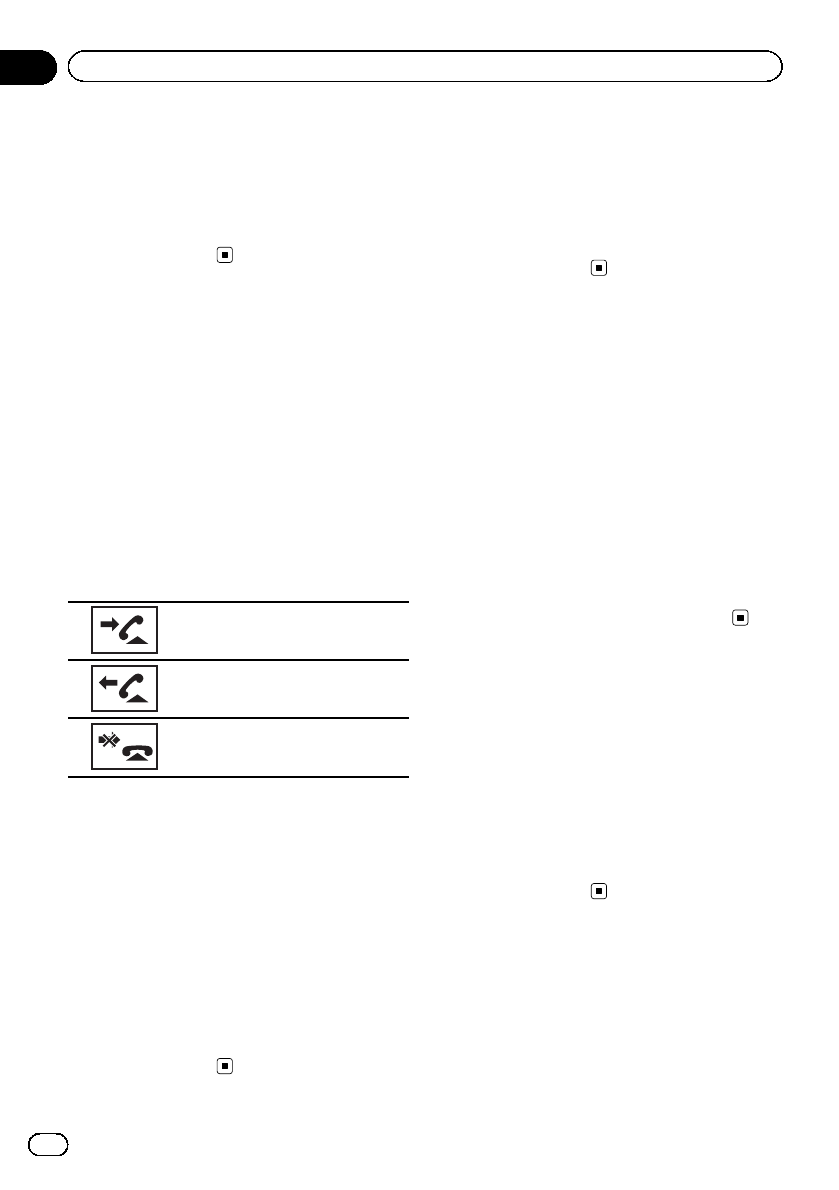
5 Make the call.
Refer to Introduction of Bluetooth telephone op-
erations on page 27.
6 End the call.
Refer to Introduction of Bluetooth telephone op-
erations on page 27.
Using the missed, received
and dialed call lists
The 80 most recent calls dialed, received, and
missed are stored in the memory. You can
browse them and call numbers from these
lists.
1 Switch to the call history list.
Refer to Introduction of Bluetooth telephone op-
erations on page 27.
2 Select Missed Calls, Dialled Calls or
Received Calls.
Displaying the received call list.
Displaying the dialed call list.
Displaying the missed call list.
3 Touch the list number to select a phone
number.
Name and phone number are displayed in the
detailed list.
#If you want to store the phone number, touch
and hold the list.
4 Make the call.
Refer to Introduction of Bluetooth telephone op-
erations on page 27.
5 End the call.
Refer to Introduction of Bluetooth telephone op-
erations on page 27.
Setting automatic answering
If this function is on, this unit automatically
answers all incoming calls.
%Turn automatic answering on or off.
Refer to Introduction of Bluetooth telephone op-
erations on page 27.
Adjusting the other party’s
listening volume
To maintain the good sound quality, this unit
can adjust the other party’s listening volume.
If the volume is not loud enough for the other
party, use this function.
%Select Far-End VOL.
Refer to Introduction of Bluetooth telephone op-
erations on page 27.
1—2—3
#This function can be performed even while
talking on the phone.
#Settings can be stored for each device.
Switching the ring tone
You can select whether or not to use this
unit’s ring tone. If this function is set to on,
the ring tone for this unit will sound.
1 Connect your cellular phone to this
unit.
2 Turn ring tone on or off.
Refer to Introduction of Bluetooth telephone op-
erations on page 27.
Using the preset dial lists
You can easily store up to six phone numbers
as presets.
1 Display the preset screen.
Refer to Introduction of Bluetooth telephone op-
erations on page 27.
En
48
Section
13 Detailed instructions
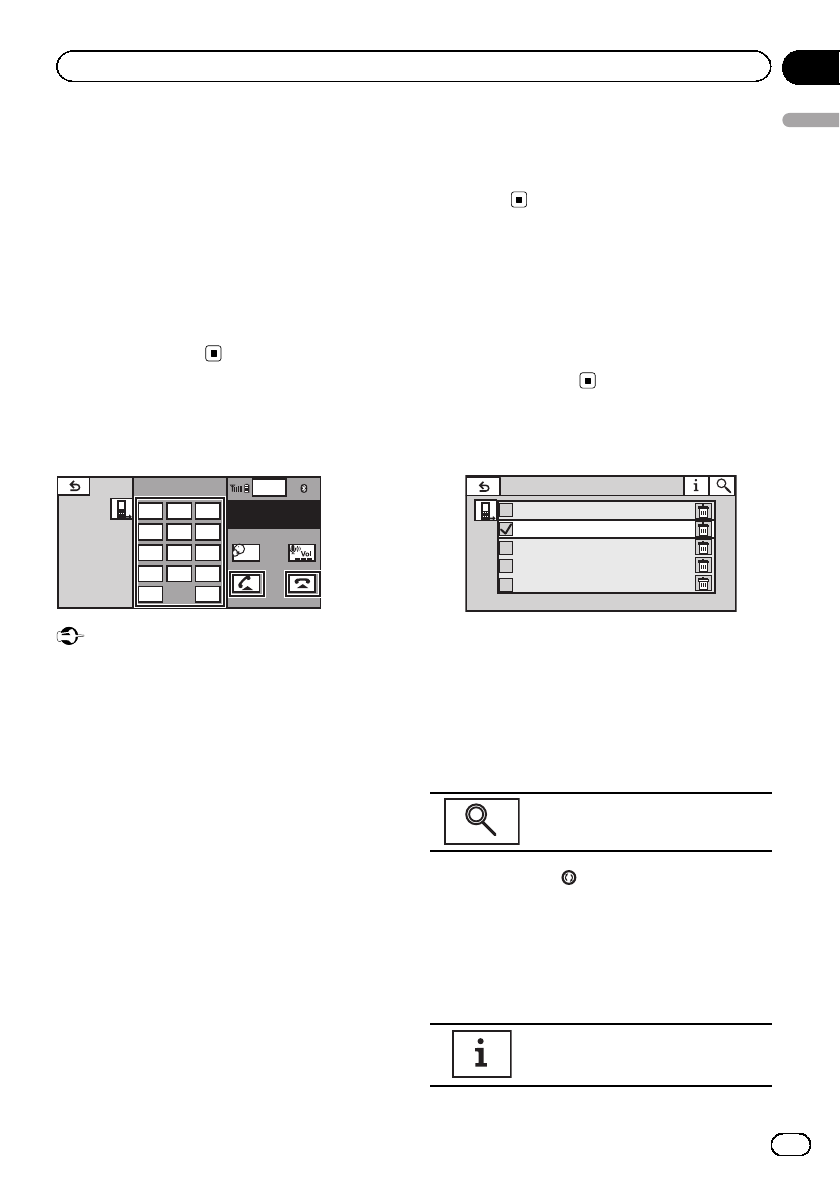
2 Touch one of preset dial keys to select
the desired phone number.
#If you want to delete a preset phone number,
touch and hold the preset dial key.
3 Make the call.
Refer to Introduction of Bluetooth telephone op-
erations on page 27.
4 End the call.
Refer to Introduction of Bluetooth telephone op-
erations on page 27.
Making a call by entering
phone number
Wed 28 may
1
12:45 PM
ABCDEHGHI
012345678901
01
123
456
789
*0#
+C
Off
Important
Be sure to park your vehicle in a safe place and
apply the parking brake when performing this op-
eration.
1 Switch to the entering phone number
mode.
Refer to Introduction of Bluetooth telephone op-
erations on page 27.
2 Touch the number icons to input the
numbers.
#Up to 24 digits can be entered.
3 Make the call.
Refer to Introduction of Bluetooth telephone op-
erations on page 27.
4 End the call.
Refer to Introduction of Bluetooth telephone op-
erations on page 27.
Note
Entering phone number mode cannot be oper-
ated unless a Bluetooth telephone is connected
to this unit.
Setting the private mode
During a conversation, you can switch to pri-
vate mode (talk directly on your cellular
phone).
Refer to Introduction of Bluetooth telephone op-
erations on page 27.
Pairing from this unit
Connection
01: Phone1
02: Phone2
03: Phone3
04: Phone4
05: Phone5
1 Display the Bluetooth Connection
Menu.
Refer to Introduction of Bluetooth telephone op-
erations on page 27.
2 Touch Connection to select a device.
3 Start to search.
Starting to search.
While searching, is displayed and when
available devices are found, the device names
or Bluetooth device addresses (if names can-
not be obtained) are displayed.
#If you want to switch between the device
names and Bluetooth device addresses, touch
the icon.
Switching between the device
names and Bluetooth device ad-
dresses.
En 49
Section
13
Detailed instructions
Detailed instructions
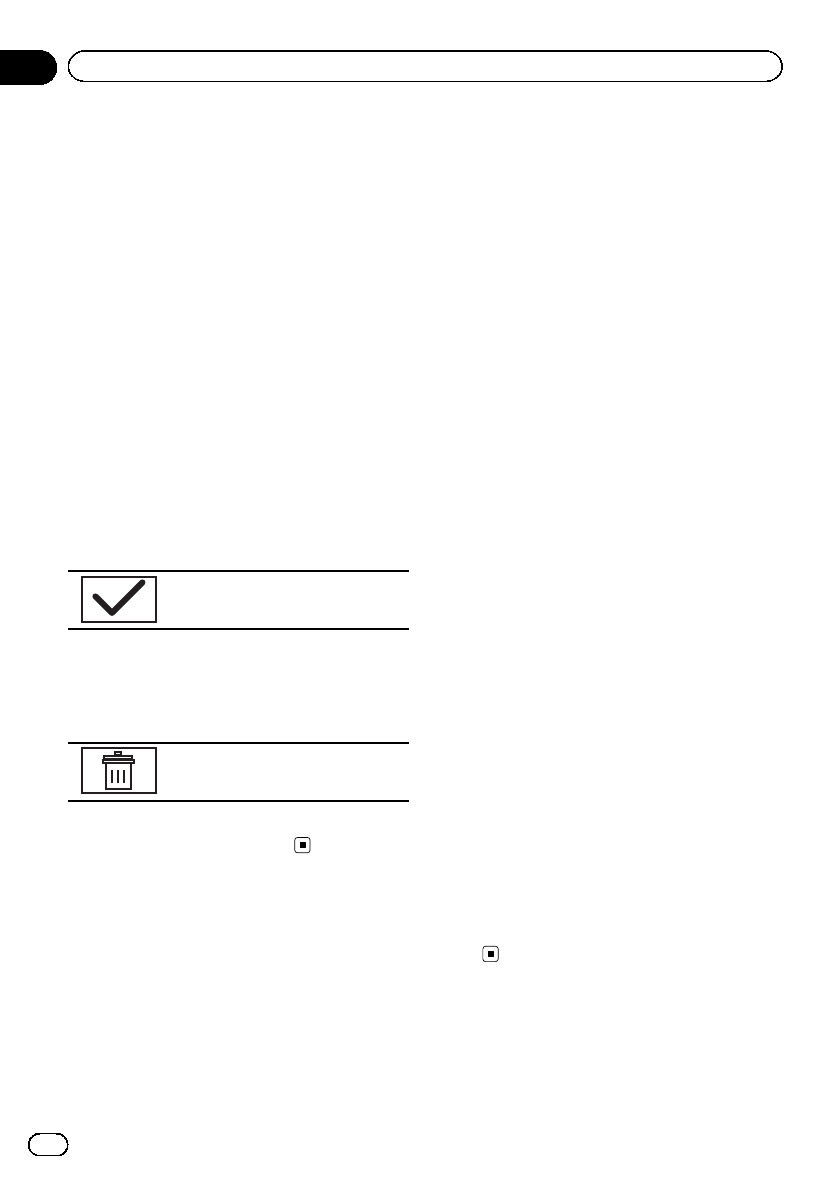
#To cancel searching, touch Stop.
#If five devices are already paired,
Memory Full is displayed and pairing cannot be
performed. In such cases, delete a paired device
first. Refer to this page.
#If no device can be found, Not Found is dis-
played. In such cases, check the status of the
Bluetooth device and search again.
4 Touch a device name to select the de-
vice you want to connect to.
While connecting, Pairing is displayed. If the
connection is established, Paired is displayed.
#If the connection fails, Error is displayed. In
such cases, try again from the beginning.
#The PIN code is set to 0000 as the default, but
can be changed. Refer to Entering PIN code for
Bluetooth wireless connection on the next page.
#When establishing connection, the icon is dis-
played.
Touch the icon to disconnect the device.
Disconnecting a Bluetooth device.
#If you want to delete a paired Bluetooth tele-
phone, display Delete OK?. Touch Yes to delete
the device.
Deleting a paired device.
#Never turn the unit off while the paired Blue-
tooth telephone is being deleted.
Using a Bluetooth device to
pair
If you cannot open the connection between
your Bluetooth device and this unit from your
Bluetooth device, you can use this function to
establish a connection.
1 Display the Bluetooth Connection
Menu.
Refer to Introduction of Bluetooth telephone op-
erations on page 27.
2 Touch Special Device to select the spe-
cial device.
#Bluetooth devices that are difficult to establish
a connection with are called special devices. If
your Bluetooth device is listed as a special device,
select the appropriate one.
3 Touch the special device list to open the
connection.
This unit is now on standby for a connection
with the Bluetooth device.
#If five devices are already paired,
Memory Full is displayed and pairing cannot be
performed. In such cases, delete a paired device
first. Refer to this page.
4 Use your Bluetooth device to establish
a connection.
The connection method is different depending
on the Bluetooth device. Refer to the manual
for your Bluetooth device to establish a con-
nection.
While connecting, Pair your phone is dis-
played. If the connection is established,
Paired is displayed.
#If the connection fails, Error is displayed. In
such cases, try again from the beginning.
#You may also need to enter a PIN code into
this unit. If your telephone requires a PIN code to
establish a connection, look for the code on the
telephone or in its accompanying documenta-
tion.
#The PIN code is set to 0000 as the default, but
can be changed. Refer to Entering PIN code for
Bluetooth wireless connection on the next
page.
En
50
Section
13 Detailed instructions
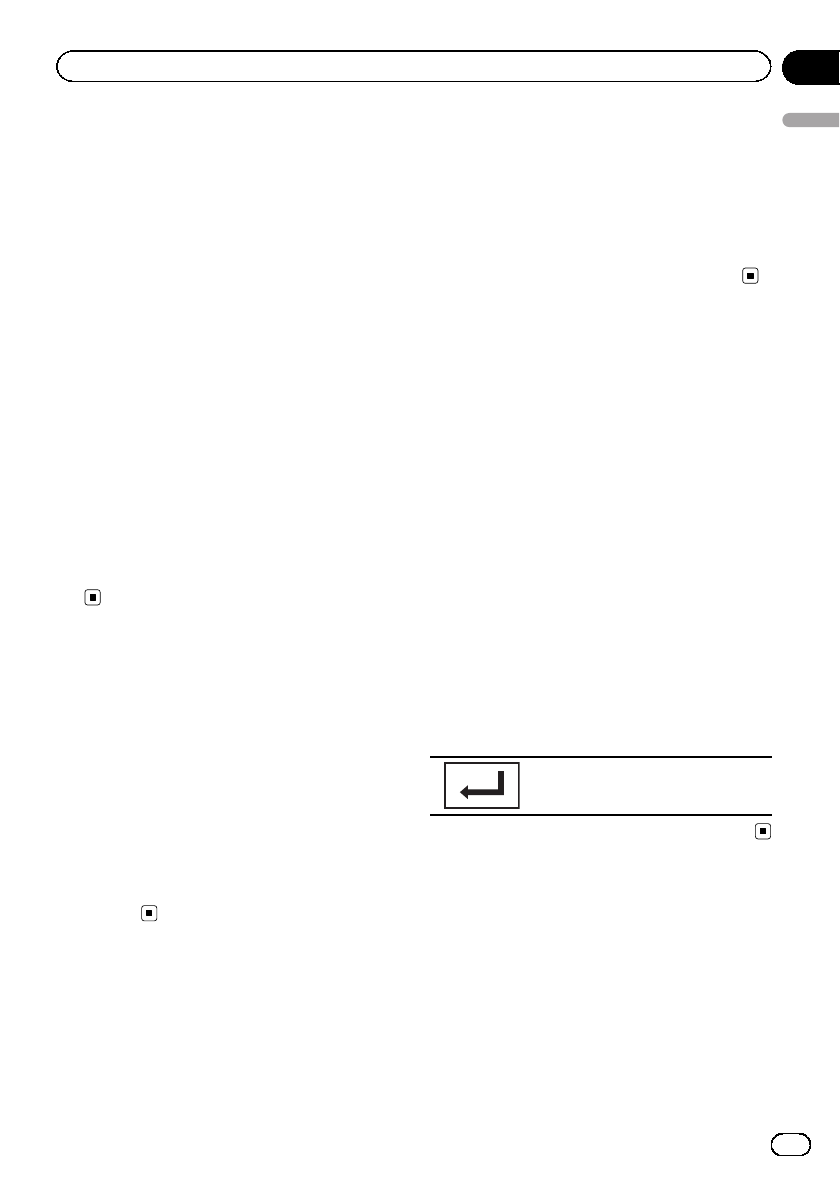
Connecting to a Bluetooth
device automatically
If this function is set to on, a connection be-
tween your Bluetooth device and this unit will
take place automatically as soon as the two
devices are less than a few meters apart.
Initially, this function is set to on.
1 Display the Bluetooth Connection
Menu.
Refer to Introduction of Bluetooth telephone op-
erations on page 27.
2 Touch Auto Connect to turn automatic
connection on.
If your Bluetooth device is ready for a Blue-
tooth wireless connection, a connection to
this unit will automatically be established.
#To turn automatic connection off, touch
Auto Connect again.
3 Turn your vehicle’s ACC switch off and
on.
Switching visible unit
This function sets whether or not to make this
unit visible to the other device.
Initially, this function is set to on.
1 Display the Bluetooth Connection
Menu.
Refer to Introduction of Bluetooth telephone op-
erations on page 27.
2 Touch Visibility to select visibility off.
!To turn visibility on, touch Visibility
again.
Displaying Bluetooth
Device address
This unit displays its Bluetooth device ad-
dress.
1 Display the Bluetooth Connection
Menu.
Refer to Introduction of Bluetooth telephone op-
erations on page 27.
2 Touch Bluetooth Version to display de-
vice information.
The Bluetooth device address is displayed.
Entering PIN code for
Bluetooth wireless connection
To connect your Bluetooth device to this unit
via Bluetooth wireless technology, you need to
enter a PIN code on your Bluetooth device to
verify the connection. The default code is
0000, but you can change it with this function.
1 Display the Bluetooth Connection
Menu.
Refer to Introduction of Bluetooth telephone op-
erations on page 27.
2 Touch PIN Code Input to select
PIN code input.
3 Touch 1 to 0 to input pin code.
4 After inputting PIN code (up to 8 di-
gits), store in this unit.
Storing the PIN code in this unit.
En 51
Section
13
Detailed instructions
Detailed instructions
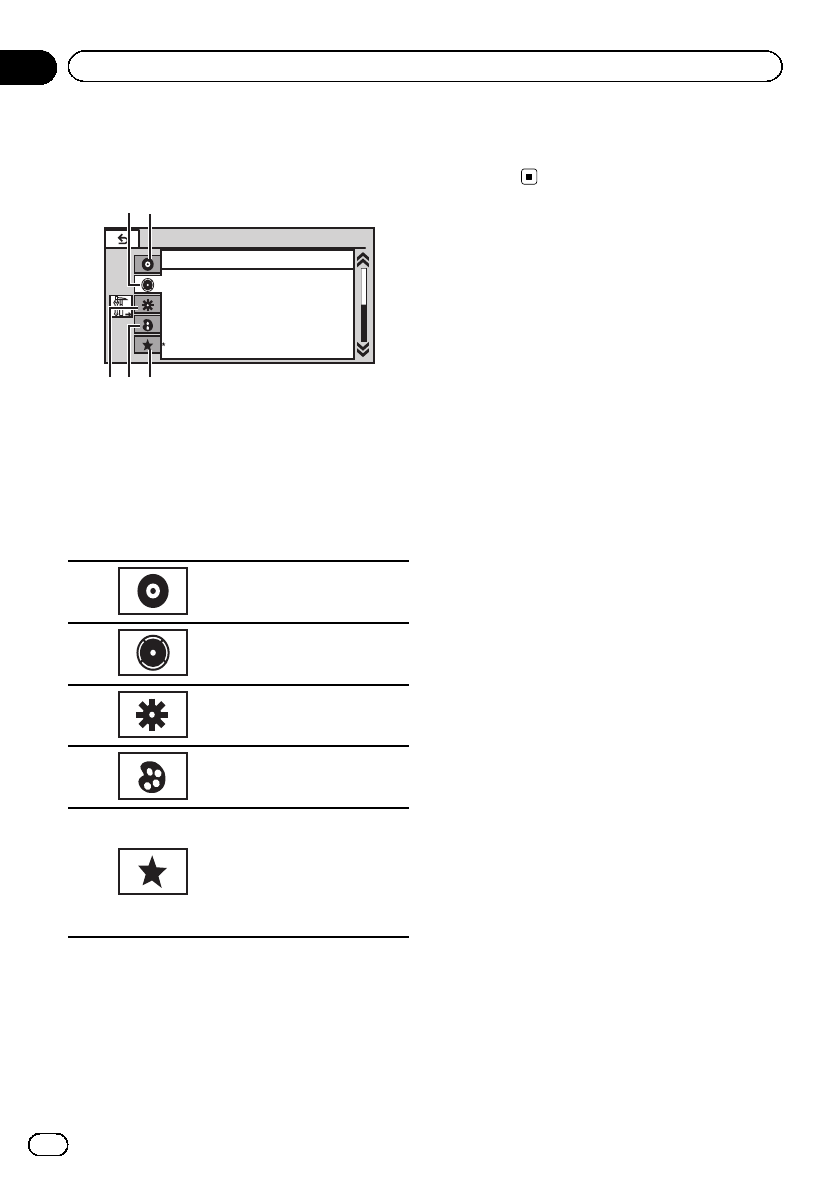
Introduction of menu
operations
Audio
Fader/Balance F/R 0 L/R 0
Super Bass
On
High
Off
L/R0
Graphic EQ
Auto EQ
Sonic Center Control
Loudness
Subwoofer
543
21
1 Display menus.
Refer to Common operations for menu set-
tings/lists on page 15.
2 Touch any of the following touch panel
keys to select the menu to be adjusted.
!Touch panel keys
1
Video Setup menu
Refer to Setting up the DVD
player on page 56.
2
Audio function menu
Refer to Audio Adjustments on
the next page.
3
System menu
Refer to System settings on
page 60.
4
Entertainment menu
Refer to Entertainment settings
on page 66.
5
Custom menu
You can choose menus within
each menu (Audio function
menu, etc.) and register them
to this custom menu.
Refer to Customizing menus
on page 67.
Notes
!You can display the Video Setup menu when
aDisc,USB or SD source is selected.
!If you start the Video Setup menu, playback
is stopped.
!You cannot display the Audio function menu
when the mute function is on or a JPEG file is
playing.
En
52
Section
14 Menu operations

Audio Adjustments
Note
When selecting FM as the source, you cannot
switch to Source Level Adjuster.
Using fader/balance adjustment
You can change the fader/balance setting to
provide an ideal listening environment for all
of the occupied seats.
1 Display the audio function menu.
Refer to Introduction of menu operations on
the previous page.
2 Touch Fader/Balance on the audio func-
tion menu.
3 Touch aor bto adjust the front/rear
speaker balance.
Range: Front:15 to Rear:15
#Select F/R: 0 L/R: 0 when only using two
speakers.
#The front/rear speaker balance cannot be ad-
justed when the rear output setting is
Subwoofer. Refer to Setting the rear output and
subwoofer controller on page 60.
4 Touch cor dto adjust the left/right
speaker balance.
Range: Left:15 to Right:15
Using the equalizer
You can adjust the equalization to match the
car’s interior acoustic characteristics as de-
sired.
Recalling equalizer curves
There are seven stored equalizer curves which
you can easily recall at any time. Here is a list
of the equalizer curves.
Display Equalizer curve
Powerful Powerful
Natural Natural
Display Equalizer curve
Vocal Vocal
Custom1 Custom 1
Custom2 Custom 2
Flat Flat
Super Bass Super bass
!The equalizer curves for Custom1 and
Custom2 can be adjusted.
!You cannot select Custom1 and Custom2
when using the auto-equalizer.
!When Flat, no changes are made to the
sound. You can check the effects of the
equalizer curves by switching alternatively
between Flat and another equalizer curve.
1 Display the audio function menu.
Refer to Introduction of menu operations on
the previous page.
2 Touch Graphic EQ on the audio function
menu.
#You can select Graphic EQ when Auto EQ
function is off.
3 Touch cor dto select the desired item.
Powerful—Natural—Vocal—Custom1—
Custom2—Flat—Super Bass
Adjusting the 8-band graphic equalizer
You can adjust the level of each band for the
equalizer curves.
!A separate Custom1 curve can be created
for each source. If you make adjustments
when a curve other than Custom2 is se-
lected, the equalizer curve settings will be
stored in Custom1.
!ACustom2 curve that is common for all
sources can be created. If you make adjust-
ments when the Custom2 curve is se-
lected, the Custom2 curve will be updated.
1 Display the audio function menu.
Refer to Introduction of menu operations on
the previous page.
En 53
Section
14
Menu operations
Menu operations

2 Touch Graphic EQ on the audio function
menu.
3 Touch cor dto select the desired item.
Powerful—Natural—Vocal—Custom1—
Custom2—Flat—Super Bass
4 Touch the Equalizer band to adjust.
5 Touch aor bto adjust the level of the
equalizer band.
Range: +12dB to –12dB
#You can then select another band and adjust
the level.
Using the auto-equalizer
The auto-equalizer is an equalizer curve cre-
ated by auto EQ (refer to Auto EQ (auto-equaliz-
ing) on page 63).
You can turn the auto-equalizer on or off.
If you connect an optional microphone to this
unit, you can use this function.
1 Display the audio function menu.
Refer to Introduction of menu operations on
page 52.
2 Touch Auto EQ to turn the auto-equali-
zer on or off.
#You cannot use this function if auto EQ has
not been carried out.
Using sonic center control
Sound that is suited for the listening position
can easily be created with this function.
1 Display the audio function menu.
Refer to Introduction of menu operations on
page 52.
2 Touch Sonic Center Control on the
audio function menu.
3 Touch cor dto select a listening posi-
tion.
Range: Left:7 to Right:7
Adjusting loudness
Loudness compensates for deficiencies in the
low- and high-frequency ranges at low volume.
1 Display the audio function menu.
Refer to Introduction of menu operations on
page 52.
2 Touch Loudness on the audio function
menu.
3 Touch cor dto select a desired level.
Off (off)—Low (low)—Mid (mid)—High
(high)
Using subwoofer output
This unit is equipped with a subwoofer output
which can be turned on or off.
!The cut-off frequency and output level can
be adjusted when the subwoofer output is
on.
1 Display the audio function menu.
Refer to Introduction of menu operations on
page 52.
2 Touch Subwoofer on the audio function
menu.
3 Touch On or Off next to Subwoofer to
turn the subwoofer output on or off.
4 Touch Normal or Reverse next to Phase
to select the phase of subwoofer output.
5 Touch cor dnext to Level to adjust
the output level of the subwoofer.
Range: +6 to –24
6 Touch cor dnext to Frequency to se-
lect the cut-off frequency.
50Hz—63Hz—80Hz—100Hz—125Hz
Only frequencies lower than those in the se-
lected range are outputted from the subwoo-
fer.
En
54
Section
14 Menu operations
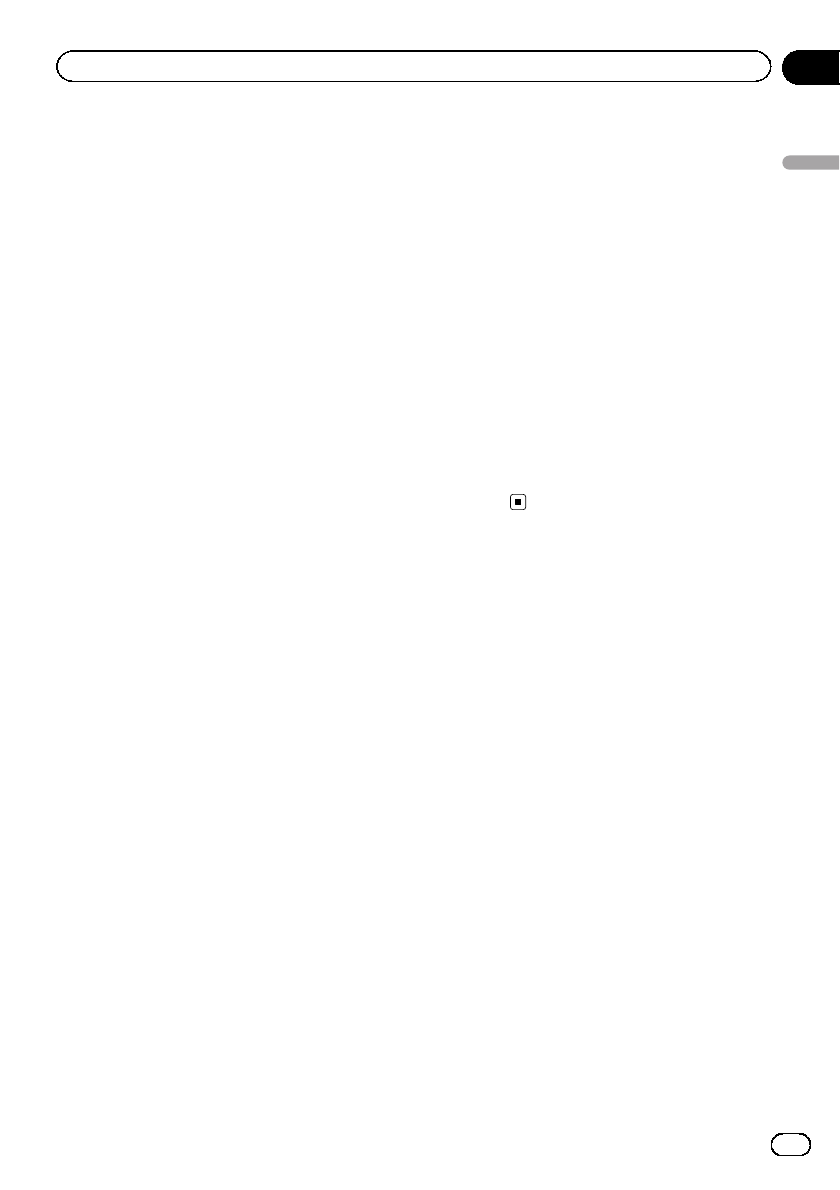
Boosting the bass
You can boost the bass level.
1 Display the audio function menu.
Refer to Introduction of menu operations on
page 52.
2 Touch cor dto select a desired level.
Range: 0to +6
Using the high pass filter
When you do not want low sounds from the
subwoofer output frequency range to play
from the front or rear speakers, turn on the
HPF (high pass filter). Only frequencies higher
than those in the selected range are output
from the front or rear speakers.
1 Display the audio function menu.
Refer to Introduction of menu operations on
page 52.
2 Touch cor dnext to Frequency to se-
lect cut-off frequency.
Off (off)—50Hz—63Hz—80Hz—100Hz—
125Hz
Only frequencies higher than those in the se-
lected range are output from the front or rear
speakers.
Adjusting source levels
With SLA (source level adjustment), the vo-
lume levels of each source can be adjusted to
prevent significant differences between
sources.
!Settings are based on the FM volume level,
which remains unchanged.
1 Display the audio function menu.
Refer to Introduction of menu operations on
page 52.
2 Compare the FM volume level with the
level of the source you wish to adjust.
3 Touch Source Level Adjuster on the
audio function menu.
4 Touch aor bto adjust the source vo-
lume.
Range: +4 to –4
Notes
!The AM volume level can also be adjusted
with this function.
!Video CD, CD, compressed audio and DivX
are automatically set to the same source level
adjustment volume.
!iPod and USB storage device are automati-
cally set to the same source level adjustment
volume.
!External unit 1 and external unit 2 are automa-
tically set to the same source level adjustment
volume.
En 55
Section
14
Menu operations
Menu operations

Setting up the DVD player
Setting the subtitle language
You can set a desired subtitle language. When
available, the subtitles will be displayed in the
selected language.
1 Display the Video Setup menu.
Refer to Introduction of menu operations on
page 52.
2 Touch Subtitle Language on the
Video Setup menu.
A subtitle language menu is displayed.
3 Touch the desired language.
The subtitle language is set.
#If you have selected Others, refer to When you
select Others on this page.
Notes
!If the selected language is not available, the
language specified on the disc is displayed.
!You can also switch the subtitle language by
touching the icon during playback. (Refer to
Playing moving images on page 18.)
!The setting made here will not be affected
even if the subtitle language is switched dur-
ing playback using Subtitle.
When you select Others
A language code input display is shown when
Others is selected. Refer to Language code
chart for DVD on page 101.
1 Touch 0 to 9 to input the language
code.
#To cancel the entered numbers, touch C.
2 Registering the code.
Registering the code.
Setting the audio language
You can set the preferred audio language.
1 Display the Video Setup menu.
Refer to Introduction of menu operations on
page 52.
2 Touch Audio Language on the Video
Setup menu.
An audio language menu is displayed.
3 Touch the desired language.
The audio language is set.
#If you have selected Others, refer to When you
select Others on this page.
Notes
!If the selected language is not available, the
language specified on the disc is used.
!You can also switch the audio language by
touching Audio during playback. (Refer to
Playing moving images on page 18.)
!The setting made here will not be affected
even if the audio language is switched during
playback using Audio.
Setting the menu language
You can set the preferred language in which
the menus recorded on a disc are displayed.
1 Display the Video Setup menu.
Refer to Introduction of menu operations on
page 52.
2 Touch Menu Language on the
Video Setup menu.
A menu language menu is displayed.
3 Touch the desired language.
The menu language is set.
#If you have selected Others, refer to When you
select Others on this page.
Note
If the selected language is not available, the lan-
guage specified on the disc is displayed.
En
56
Section
14 Menu operations

Setting the multi-angle DVD
display
The angle icon can be set so it appears on
scenes where the angle can be switched.
1 Display the Video Setup menu.
Refer to Introduction of menu operations on
page 52.
2 Touch Multi Angle on the Video Setup
menu to turn angle icon display on or off.
Setting the aspect ratio
There are two kinds of display: a wide screen
display that has a width-to-height ratio (TV as-
pect ratio) of 16:9, and regular display that has
a TV aspect of 4:3. Be sure to select the correct
TV aspect for the display connected to REAR
MONITOR OUTPUT.
!When using regular display, select either
Letter Box or Pan Scan. Selecting 16 : 9
may result in an unnatural picture.
!If you select the TV aspect ratio, the unit’s
display will change to the same setting.
1 Display the Video Setup menu.
Refer to Introduction of menu operations on
page 52.
2 Touch TV Aspect on the Video Setup
menu to select the TV aspect ratio.
Touch TV Aspect repeatedly until the desired
aspect ratio appears.
!16 : 9 –Wide screen picture (16:9) is dis-
played as is (initial setting)
!Letter Box –The picture is the shape of a
letterbox with black bands on the top and
bottom of the screen
!Pan Scan –The picture is cut short on the
right and left sides of the screen
Notes
!When playing discs that do not specify
Pan Scan, the disc is played back in
Letter Box display even if you select the
Pan Scan setting. Confirm whether the disc
package bears the 16 : 9 LB mark.
!The TV aspect ratio cannot be changed for
some discs. For details, refer to the disc’s in-
structions.
Setting the slide show interval
JPEG files can be viewed as a slide show on
this unit. In this setting, the interval between
each image can be set.
1 Display the Video Setup menu.
Refer to Introduction of menu operations on
page 52.
2 Touch Time Per Photo Slide on the
Video Setup menu to select the slide show
interval.
Touch Time Per Photo Slide repeatedly until
the desired setting appears.
!5sec –JPEG images switch at intervals of 5
seconds
!10sec –JPEG images switch at intervals of
10 seconds
!15sec –JPEG images switch at intervals of
15 seconds
!Manual –JPEG images can be switched
manually
Setting parental lock
Some DVD video discs let you use parental
lock to restrict children from viewing violent
and adult-oriented scenes. You can set paren-
tal lock to the desired level.
!When you have a parental lock level set
and play a disc featuring parental lock,
code number input indications may be dis-
played. In such cases, playback will begin
when the correct code number is entered.
En 57
Section
14
Menu operations
Menu operations
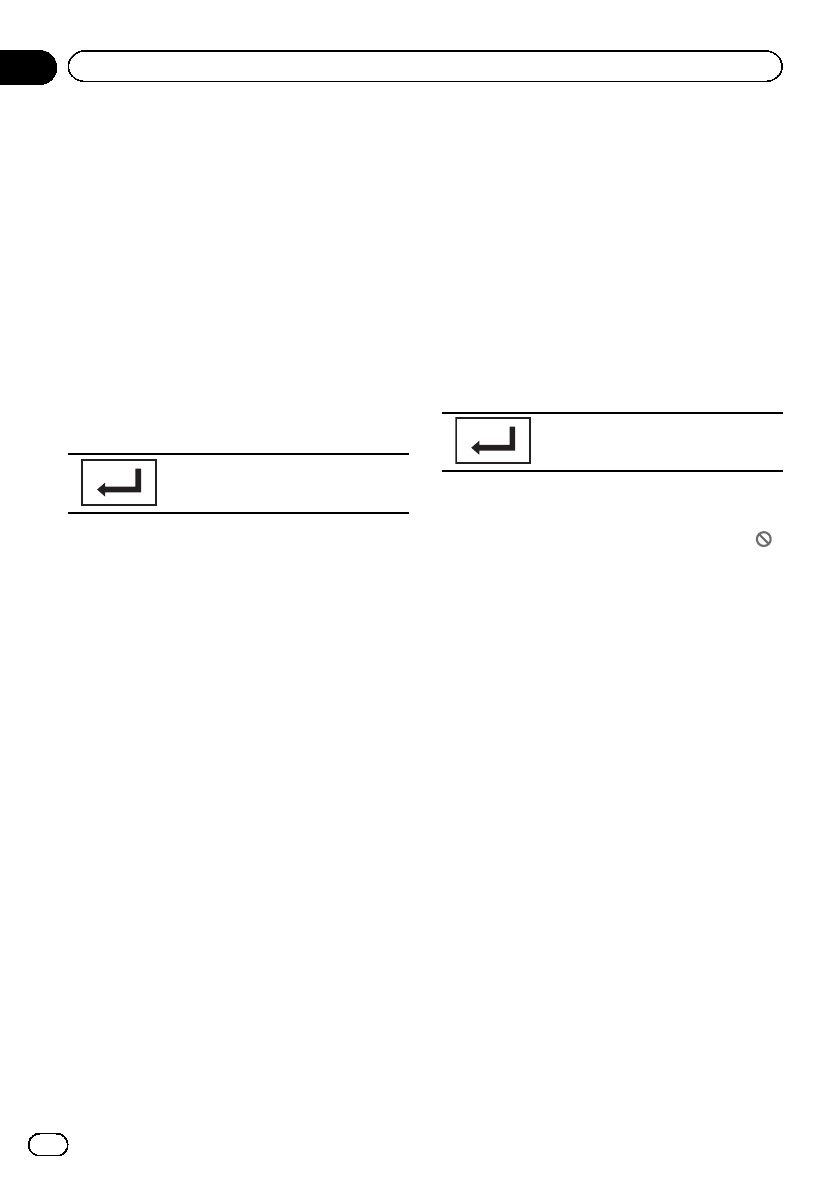
Setting the code number and level
A code number must be registered in order to
play back discs with parental lock.
1 Display the Video Setup menu.
Refer to Introduction of menu operations on
page 52.
2 Touch Parental on the Video Setup
menu.
3 Touch 0 to 9 to input a four digit code
number.
#To cancel the entered numbers, touch C.
4 Registering the code.
Registering the code.
The code number is set, and the level can now
be set.
5 Touch 1 to 8 to select the desired level.
6 Touch Enter.
The parental lock level is set.
!8–Playback of the entire disc is possible
(initial setting)
!7to 2–Playback of discs for children and
non-adult-oriented discs is possible
!1–Playback of discs for children only is
possible
Notes
!We recommend to keep a record of your code
number in case you forget it.
!The parental lock level is stored on the disc.
Look for the level indication written on the
disc package, included literature or on the
disc itself. Parental lock of this unit is not pos-
sible if a parental lock level is not stored on
the disc.
!With some discs, the parental lock may be ac-
tive only for certain levels of scenes. The play-
back of those scenes will be skipped. For
details, refer to the instruction manual that
came with the disc.
Changing the level
You can change the set parental lock level.
1 Display the Video Setup menu.
Refer to Introduction of menu operations on
page 52.
2 Touch Parental on the Video Setup
menu.
3 Touch 0 to 9 to input the registered
code number.
4 Registering the code.
Registering the code.
This sets the code number, and the level can
now be changed.
#If you enter an incorrect code number, the
icon is displayed. Touch Cand enter the correct
code number.
#If you forget your code number, refer to If you
forget your code number on this page.
5 Touch 1 to 8 to select the desired level.
6 Touch Enter.
The new parental lock level is set.
If you forget your code number
Press RESET.
Setting the DivX subtitle file
You can select whether or not to display DivX
external subtitles.
!The DivX subtitles will be displayed even
when Custom is selected if no DivX exter-
nal subtitle files exist.
1 Display the Video Setup menu.
Refer to Introduction of menu operations on
page 52.
En
58
Section
14 Menu operations

2 Touch DivX Subtitle on the Video Setup
menu to select the desired subtitle setting.
!Original –Display the DivX subtitles
!Custom –Display the DivX external subti-
tles
Notes
!Up to 42 characters can be displayed on one
line. If more than 42 characters are set, the
line breaks and the characters are displayed
on the next line.
!Up to 126 characters can be displayed on one
screen. If more than 126 characters are set,
the excess characters will not be displayed.
Displaying the DivXâVOD
registration code
In order to play DivX VOD (video on demand)
contents on this unit, the unit must first be re-
gistered with a DivX VOD contents provider.
For registration, generate a DivX VOD registra-
tion code and submit it to your provider.
!Keep a record of the code as you will need
it when you register your unit to the DivX
VOD provider.
1 Display the Video Setup menu.
Refer to Introduction of menu operations on
page 52.
2 Touch DivX VOD on the Video Setup
menu.
Registration Code and Deregistration Code
appear.
3 Touch Registration Code.
Your registration code is displayed.
Displaying the deregistration code
If your device is already activated, deregister it
by entering the deregistration code.
1 Display the Video Setup menu.
Refer to Introduction of menu operations on
page 52.
2 Touch DivX VOD on the Video Setup
menu.
3 Touch Deregistration Code.
#To cancel deregistration, touch Cancel.
4 Touch OK.
The deregistration is complete.
Automatic playback of DVDs
When a DVD disc with a DVD menu is in-
serted, this unit will cancel the menu automa-
tically and start playback from the first chapter
of the first title.
!Some DVDs may not operate properly. If
this function is not fully operated, turn this
function off and start playback.
1 Display the Video Setup menu.
Refer to Introduction of menu operations on
page 52.
2 Touch DVD Auto Play to turn automatic
playback on.
#To turn automatic playback off, touch
DVD Auto Play again.
En 59
Section
14
Menu operations
Menu operations

System settings
Switching the auxiliary setting
Activate this setting when using an auxiliary
device connected to this unit.
1 Display the system menu.
Refer to Introduction of menu operations on
page 52.
2 Touch AUX Input on the system menu
to turn AUX Input on or off.
Setting AV input
Activate this setting when using an external
video component connected to this unit.
1 Display the system menu.
Refer to Introduction of menu operations on
page 52.
2 Touch AV Input on the system menu to
turn AV Input on or off.
Setting the rear output and
subwoofer controller
This unit’s rear output (rear speaker leads out-
put and RCA rear output) can be used for full-
range speaker (Full) or subwoofer
(Subwoofer) connection. If you switch the
rear output setting to Subwoofer, you can
connect a rear speaker lead directly to a sub-
woofer without using an auxiliary amp.
Initially, the unit is set for a rear full-range
speaker connection (Full).
1 Turn the unit off.
Refer to Basic operations of this unit on page
14.
2 Display the system menu.
Refer to Introduction of menu operations on
page 52.
3 Touch Rear Speaker on the system
menu to switch the subwoofer output or
full-range speaker.
#When no subwoofer is connected to the rear
output, select Full (full-range speaker).
#When a subwoofer is connected to the rear
output, select Subwoofer (subwoofer).
Notes
!Even if you change this setting, there will be
no output unless you turn the subwoofer out-
put on (refer to Using subwoofer output on
page 54).
!If you change this setting, subwoofer output
in the audio menu will return to the factory
settings.
!Both rear speaker lead outputs and RCA rear
output are switched simultaneously in this
setting.
Switching sound muting/
attenuation
Sound from this system is automatically
muted or attenuated when a signal from
equipment with a mute function is received.
!Sound from this system returns to normal
when the muting or attenuation is can-
celed.
1 Display the system menu.
Refer to Introduction of menu operations on
page 52.
2 Touch Mute/ATT until the desired set-
ting appears.
Touch Mute/ATT until the desired setting ap-
pears in the display.
!Mute –Muting
!ATT –20dB –Attenuation (ATT –20dB has a
stronger effect than ATT –10dB)
!ATT –10dB –Attenuation
!Off –Turns the sound muting/attenuation
off
En
60
Section
14 Menu operations
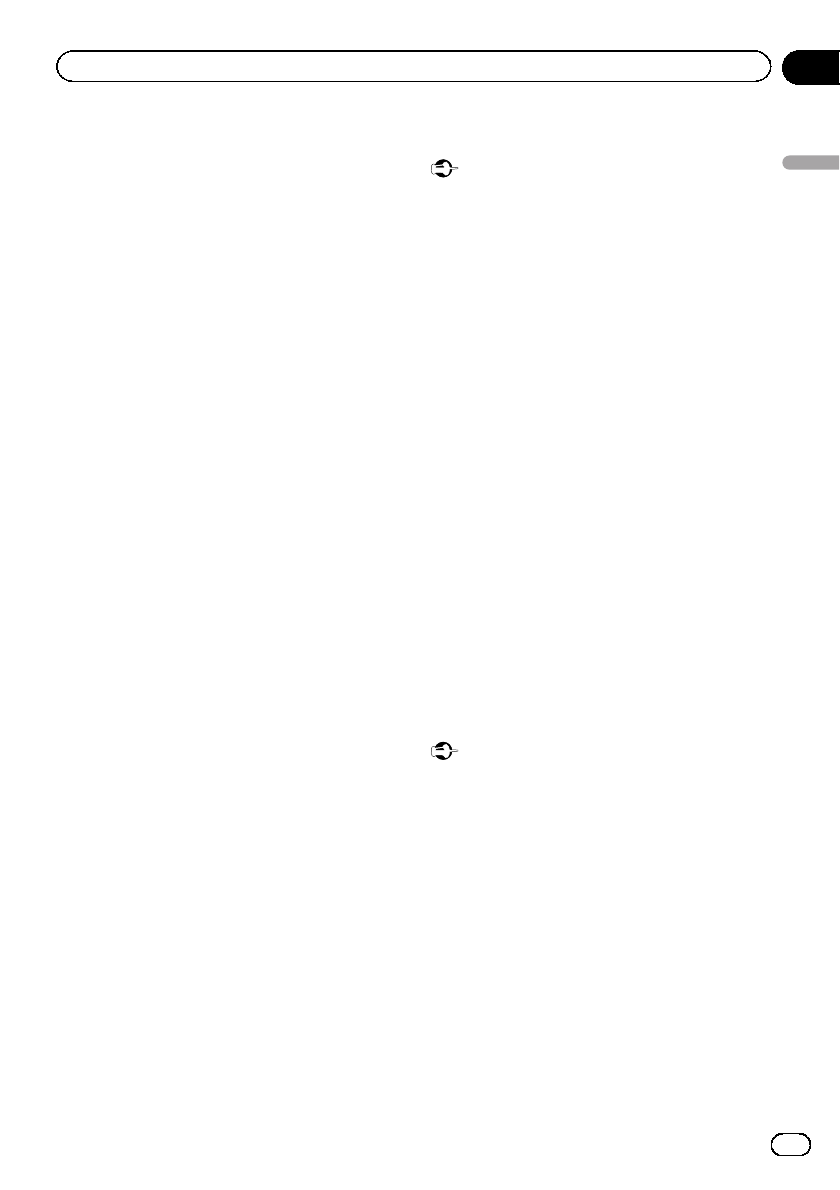
Notes
!When Mute is displayed, the sound is turned
off and no audio adjustments can be made.
!When ATT is displayed, the sound is attenu-
ated and only the volume can be adjusted.
(No other audio adjustments can be made.)
!Operation returns to normal when the phone
connection is ended.
Selecting the menu language
The menu language can be selected from four
languages.
If text information such as the title name, artist
name or a comment is embedded in a Eur-
opean language, they can also be displayed
on this unit.
!The language can be changed for the fol-
lowing:
—System menu
—Video Setup
—On-screen display
—Multi language setting for DivX
—Language for cautions
Some operations on this unit are prohib-
ited from use while driving or require
careful attention when operated. In
such cases, a caution will appear on the
display. You can change the language
for caution messages with this setting.
!If the embedded language and the selected
language setting are not the same, text in-
formation may not display properly.
!Some characters may not be displayed
properly.
1 Display the system menu.
Refer to Introduction of menu operations on
page 52.
2 Touch System Language on the system
menu to select the desired language.
3 Touch the desired language.
English (English)—Français (French)—
Español (Spanish)—Português (Portuguese)
Clearing Bluetooth memory
Important
Never turn the unit off while the Bluetooth mem-
ory is being cleared.
1 Turn the unit off.
Refer to Basic operations of this unit on page
14.
2 Display the system menu.
Refer to Introduction of menu operations on
page 52.
3 Touch Bluetooth Memory Clear on the
system menu.
4 Touch Reset.
After selecting a desired item, a confirmation
display appears. Touch Reset to delete the
memory.
#If you do not want to clear the memory, touch
Cancel.
Updating Bluetooth connection
software
This function is used to update this unit with
the latest software. For information on the soft-
ware and updating, refer to our website.
Important
Never turn the unit off and never disconnect the
phone while the software is being updated.
1 Turn the unit off.
Refer to Basic operations of this unit on page
14.
2 Display the system menu.
Refer to Introduction of menu operations on
page 52.
3 Touch Bluetooth Software Update.
4 Touch Start to display the data transfer
mode.
#Follow the on-screen instructions to finish up-
dating the software.
En 61
Section
14
Menu operations
Menu operations
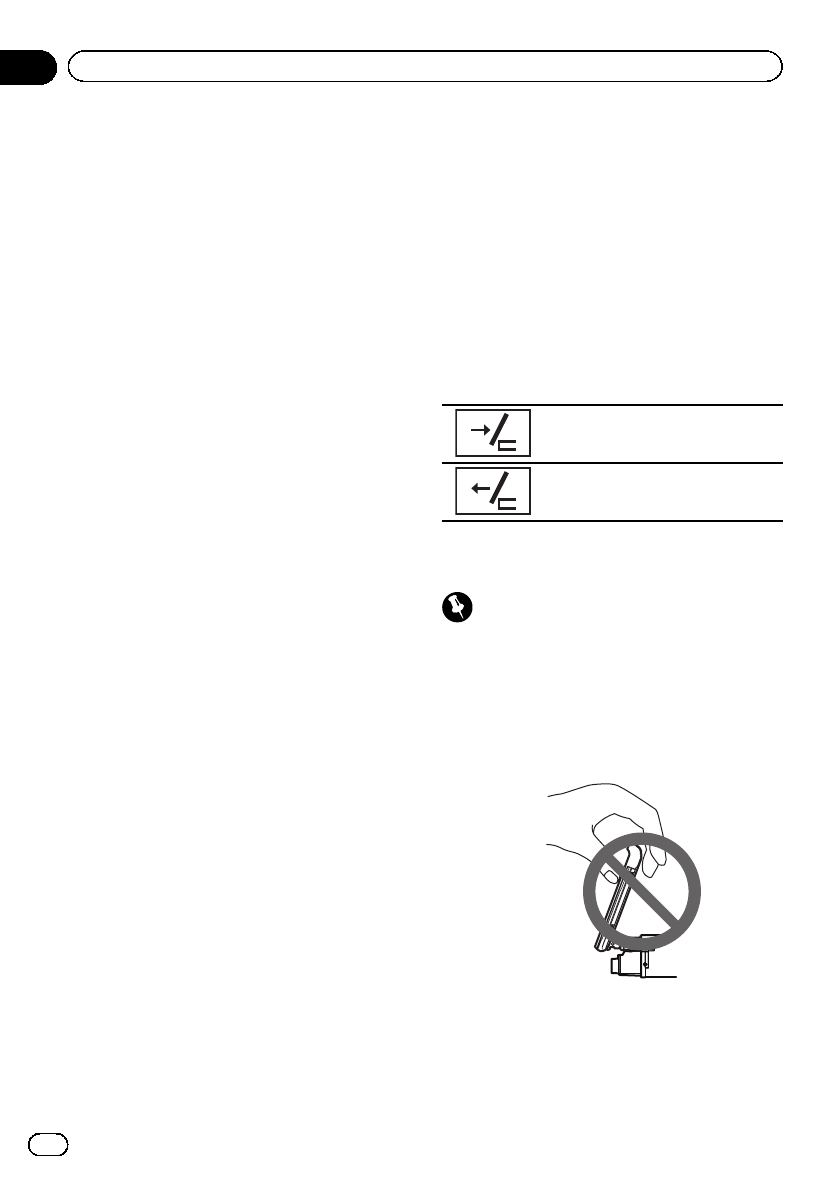
Displaying the Bluetooth
system version
If this unit fails to operate properly, you may
need to consult your dealer for repair. In such
cases, you may be asked to specify the system
version. Perform the following procedure to
check the version on this unit.
1 Turn the unit off.
Refer to Basic operations of this unit on page
14.
2 Display the system menu.
Refer to Introduction of menu operations on
page 52.
3 Touch Bluetooth Version Information to
display to the version of the Bluetooth
module of this unit.
Setting the automatic open
function
To prevent the display from hitting the shift
lever of an automatic vehicle when it is in the
P(park) position, or when you do not wish the
display to open/close automatically, you can
set the automatic open function to manual
mode.
1 Display the system menu.
Refer to Introduction of menu operations on
page 52.
2 Touch Auto Flap to select whether to
open/close the display automatically or
manually.
Each time you touch Auto Flap the setting
switches between:
!On –The LCD panel will open or close auto-
matically when the ignition switch is turned
on or off.
!Off –You have to press OPEN/CLOSE to
open/close the LCD panel.
Adjusting the LCD panel slide
position
You can adjust the LCD panel slide position so
that the panel is set back or forward.
1 Display the system menu.
Refer to Introduction of menu operations on
page 52.
2 Touch Flap Set Back.
3 Touching the Flap Set Back keys allows
you to move the LCD panel back and forth.
The LCD panel slides to the back.
The LCD panel slides to the front.
Adjusting the LCD panel angle
Important
!If you can hear the LCD panel knocking
against your vehicle’s console or dashboard,
touch and hold OPEN/CLOSE to temporarily
level the LCD panel.
!When adjusting the LCD panel angle, be sure
to touch and hold OPEN/CLOSE. Forcibly ad-
justing the LCD panel by hand may damage it.
1 Display the system menu.
Refer to Introduction of menu operations on
page 52.
2 Touch Display Tilt.
En
62
Section
14 Menu operations
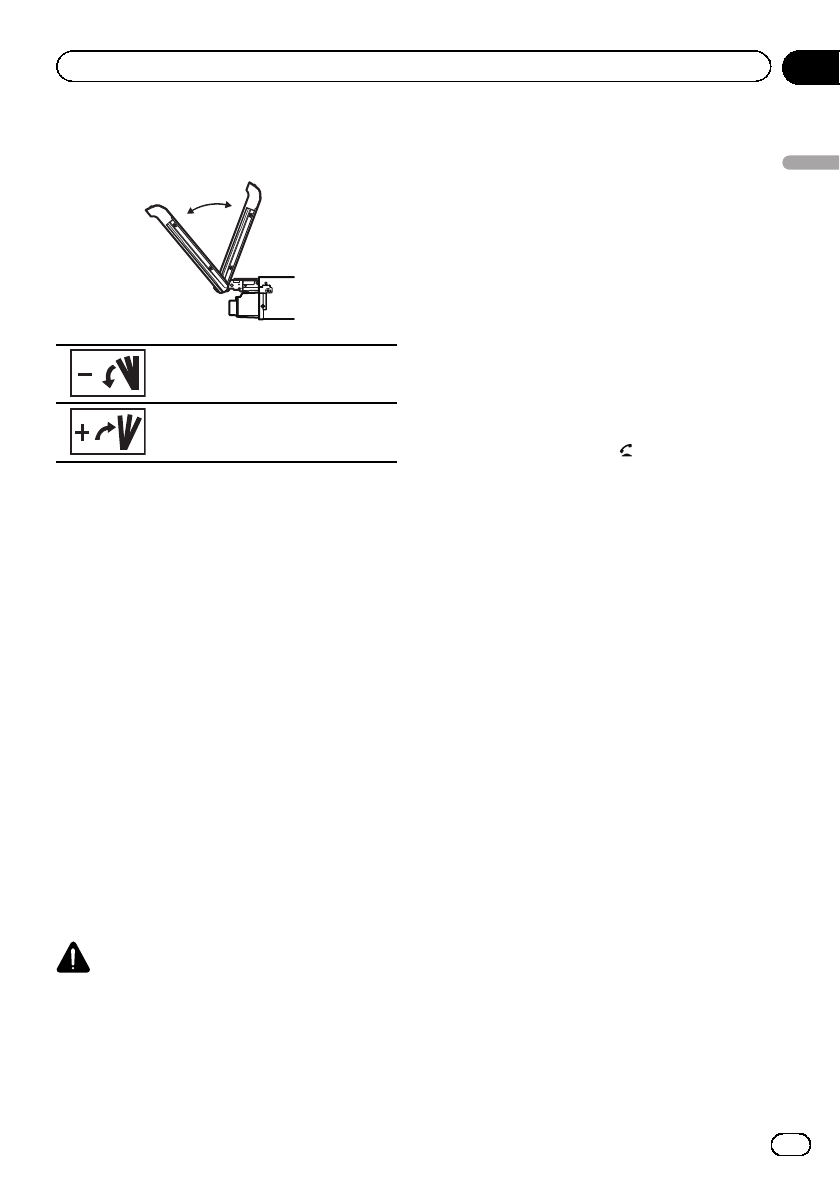
3 Touch the Display Tilt keys to adjust the
LCD panel to an easily viewable angle.
Laying the panel down.
Returning the panel to the upright
position.
#As the set angle is saved, the LCD panel will
automatically be adjusted to the same position
the next time the LCD panel is opened.
Switching the warning tone
If the front panel is not detached from the
head unit within four seconds of turning off
the ignition, a warning tone sounds. You can
turn off the warning tone.
1 Display the system menu.
Refer to Introduction of menu operations on
page 52.
2 Touch DT.WARNING to turn the warn-
ing tone on.
#To turn the warning tone off, touch
DT.WARNING again.
Setting the rear view camera
(back up camera)
CAUTION
Pioneer recommends the use of a camera
which outputs mirror-reversed images.
Otherwise, the screen image will appear re-
versed.
This unit features a function that automatically
switches to the rear view camera video (REAR
VIEW CAMERA IN) when a rear view camera
is installed on your car and the gear shift is
moved to the REVERSE (R) position. (For
more details, consult your dealer.)
!After you set up the rear view camera set-
ting, move the gear shift to REVERSE (R)
and confirm that the rear view camera
video is shown on the display.
!Change this setting if the display switches
to the rear view camera video by error while
you are driving forward.
!To stop watching the rear view camera
video and return to the source display,
press and hold MUTE/.
!Touch the RearView source icon to display
the rear view camera image while driving.
Touch the source icon again to turn the
rear view camera off. For details, refer to Se-
lecting a source using the touch panel keys
on page 14.
1 Display the system menu.
Refer to Introduction of menu operations on
page 52.
2 Touch Camera Polarity on the system
menu to select the appropriate setting.
!Battery –When the polarity of the con-
nected lead is positive while the gear shift
is in REVERSE (R) position
!Ground –When the polarity of the con-
nected lead is negative while the gear shift
is in REVERSE (R) position
!Off –When a rear view camera is not con-
nected to this unit
Auto EQ (auto-equalizing)
The auto-equalizer automatically measures
the car’s interior acoustic characteristics, and
then creates an auto-equalizer curve based on
that information.
En 63
Section
14
Menu operations
Menu operations

WARNING
As a loud tone (noise) may be emitted from the
speakers when measuring the car's interior
acoustic characteristics, never perform auto EQ
while driving.
CAUTION
!Thoroughly check the conditions before per-
forming auto EQ as the speakers may be da-
maged if these functions are performed when:
—The speakers are incorrectly connected.
(For example, when a rear speaker is con-
nected as a subwoofer output.)
—A speaker is connected to a power amp de-
livering output higher than the speaker’s
maximum input power capability.
!If the microphone is placed in an unsuitable
position the measurement tone may become
loud and measurement may take a long time,
resulting in battery drainage. Be sure to place
the microphone in the specified location.
Before operating the auto EQ function
!Carry out auto EQ in as quiet a place as
possible, with the car engine and air condi-
tioning switched off. Also cut power to car
phones or portable telephones in the car, or
remove them from the car before carrying
out auto EQ. Sounds other than the mea-
surement tone (surrounding sounds, en-
gine sound, telephones ringing etc.) may
prevent correct measurement of the car in-
terior acoustic characteristics.
!Be sure to carry out auto EQ using the op-
tional microphone. Using another micro-
phone may prevent measurement, or result
in incorrect measurement of the car inter-
ior acoustic characteristics.
!In order to perform auto EQ, the front
speaker must be connected.
!When this unit is connected to a power
amp with input level control, auto EQ may
not be possible if the power amp’s input
level is set below the standard level.
!When this unit is connected to a power
amp with an LPF, turn this LPF off before
performing auto EQ. Also set the cut-off fre-
quency for the built-in LPF of an active sub-
woofer to the highest frequency.
!The distance has been calculated by com-
puter to be the optimum delay to give accu-
rate results for the circumstances, so
please continue to use this value.
—The reflected sound within the car is
strong and delays occur.
—The LPF on active subwoofers or exter-
nal amps delay the lower sounds.
!Auto EQ changes the audio settings as fol-
lows:
—The fader/balance settings return to the
center position. (Refer to Using fader/
balance adjustment on page 53.)
—The equalizer curve switches to Flat.
(Refer to Recalling equalizer curves on
page 53.)
—The front, center and rear speakers will
automatically be adjusted to a high
pass filter setting.
!Previous settings for auto EQ will be over-
written.
Performing auto EQ
1 Stop the car in a place that is quiet,
close all the doors, windows and sun roof,
and then turn the engine off.
If the engine is left running, engine noise may
prevent correct auto EQ.
2 Fix the optional microphone in the cen-
ter of the headrest of the driver’s seat, fa-
cing forward.
The auto EQ may differ depending on where
you place the microphone. If desired, place
the microphone on the front passenger seat to
carry out auto EQ.
En
64
Section
14 Menu operations
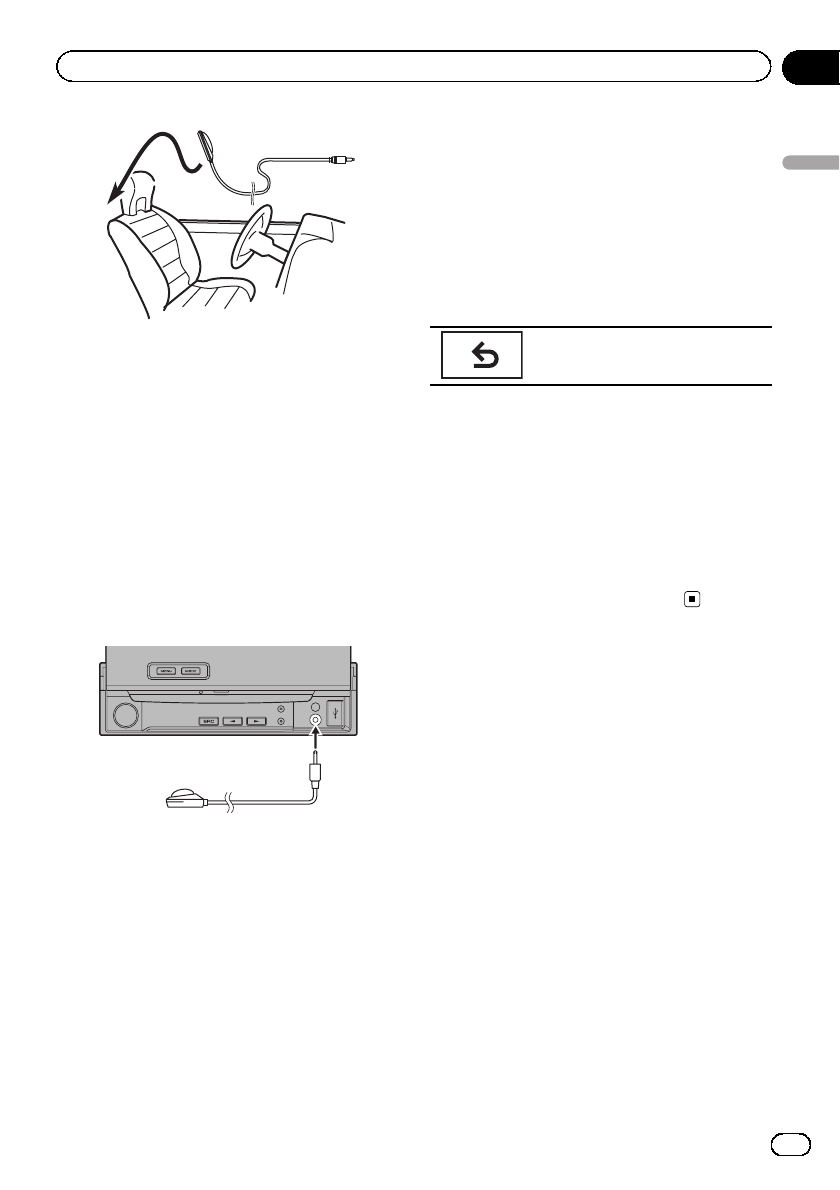
3 Turn the ignition switch to ON or ACC.
If the car’s air conditioner or heater is turned
on, turn it off. Noise from the fan in the air
conditioner or heater may prevent correct auto
EQ.
4 Display the system menu.
Refer to Introduction of menu operations on
page 52.
5 Touch Auto EQ Measurement to enter
auto EQ measurement mode.
6 Plug the microphone into the micro-
phone input jack on this unit.
7 Touch Start to start auto EQ.
8 When the 10-second countdown starts,
get out of the car and close the door within
10 seconds.
A measurement tone (noise) is emitted from
the speakers, and auto EQ measurement be-
gins.
When auto EQ is completed, Complete is dis-
played.
When the car’s interior acoustic characteris-
tics cannot be measured correctly, an error
message will be displayed. (Refer to Under-
standing auto EQ error messages on page 90.)
#It takes about nine minutes for auto EQ mea-
surement to be completed when all the speakers
are connected.
#To stop auto EQ, touch Stop.
#To cancel auto EQ measurement mode during
this procedure, touch the following touch panel
key.
Canceling auto EQ measurement
mode.
9 Store the microphone carefully in the
glove compartment or another safe place.
If the microphone is subjected to direct sun-
light for an extended period, high tempera-
tures may cause distortion, color change or
malfunction.
Note
Do not press h(eject) to open or close the panel
when you are using the microphone.
En 65
Section
14
Menu operations
Menu operations
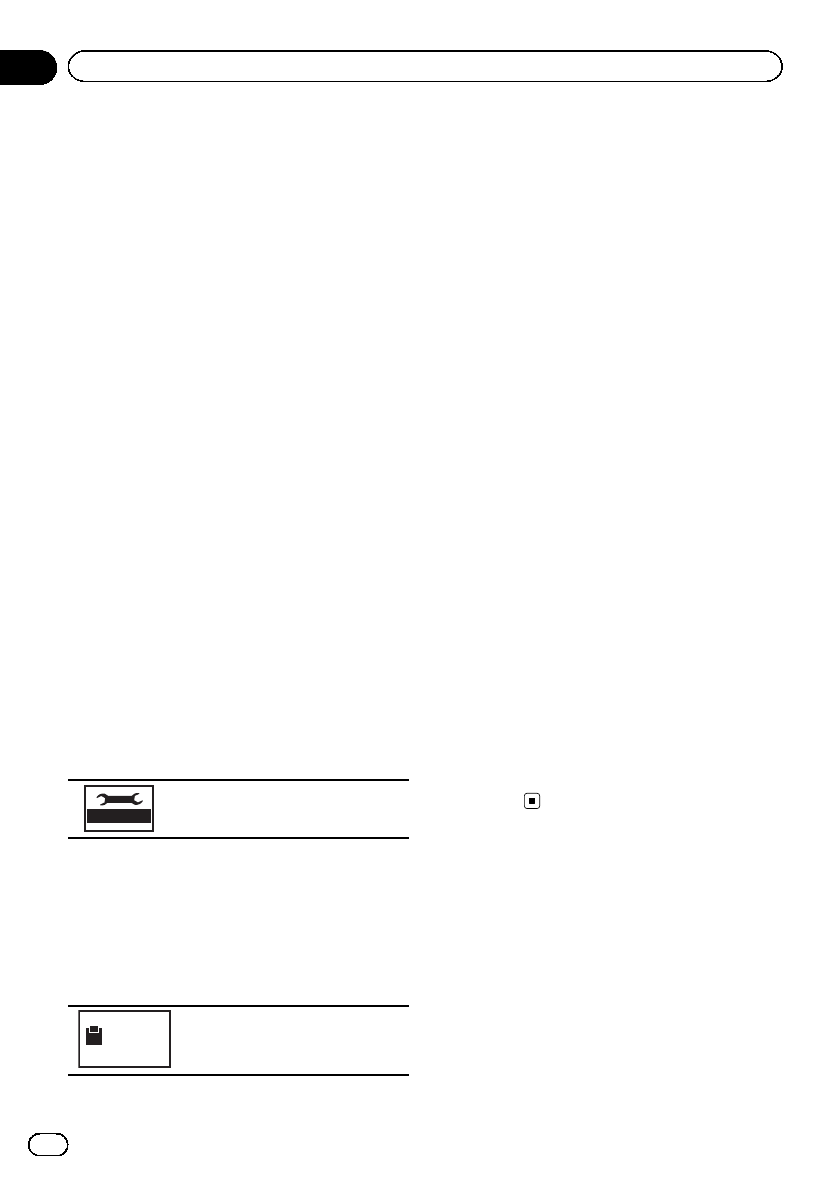
Entertainment settings
Selecting the illumination color
This unit is equipped with multiple-color illu-
mination.
Direct selection from preset
illumination colors
You can select an illumination color from the
color list.
1 Display the entertainment menu.
Refer to Introduction of menu operations on
page 52.
2 Touch Appearance.
3 Touch Illumination and then touch a
color on the list.
Customizing the illumination color
1 Display the entertainment menu.
Refer to Introduction of menu operations on
page 52.
2 Touch Appearance.
3 Touch Illumination and then touch
Custom.
4 Display the customizing menu.
Displaying the customizing menu.
5 Touch the color bar to customize the
color.
6 Touch cor dto fine-tune the color.
7 Touch the icon and hold to store the
customized color in the memory.
Memo
Storing the customized color in
the memory.
The customized color has been stored in the
memory.
The set color will be recalled from the memory
the next time you touch the same icon.
Selecting the OSD color
The OSD color can be changed.
1 Display the entertainment menu.
Refer to Introduction of menu operations on
page 52.
2 Touch Appearance.
3 Touch Screen.
4 Touch one of the colors on the list.
Selecting the background display
You can switch the background that is dis-
played when listening to a source.
1 Display the entertainment menu.
Refer to Introduction of menu operations on
page 52.
2 Touch Background.
3 Touch the desired setting.
#If no JPEG images are stored in this unit, you
cannot select photo. To store a JPEG image to
this unit, refer to Capture an image in JPEG files
on page 40.
En
66
Section
14 Menu operations

Customizing menus
1 Display menu columns to register.
Refer to Introduction of menu operations on
page 52.
You can customize menus except
Video Setup menu.
2 Touch and hold the menu column to
register it.
#To cancel registration, touch and hold the
menu column again.
3 Display the custom menu and choose a
registered menu.
Refer to Introduction of menu operations on
page 52.
Note
You can register up to 12 columns.
En 67
Section
14
Menu operations
Menu operations
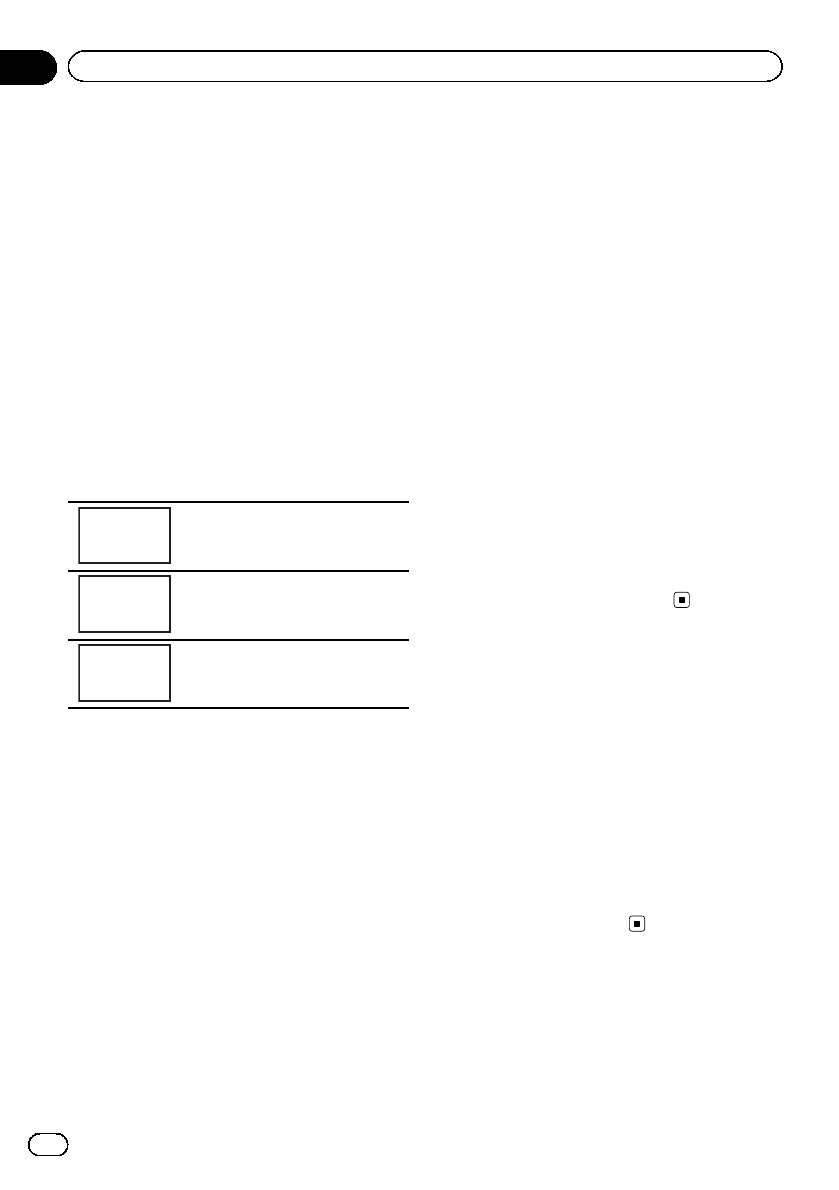
Changing the picture
adjustment
You can adjust the Brightness (brightness),
Contrast (contrast), Color (color) , Hue (hue),
Dimmer (dimmer), Temperature (tempera-
ture), Black Level (black level) and
RGB Dot Adjust (RGB dot clock adjustment)
for each source and rear view camera.
!You cannot adjust Color,Hue,Black Level
and RGB Dot Adjust for the audio source.
1 Press and hold MENU to display
Picture Adjustment.
The adjustment function names are displayed.
2 If you are adjusting the
Picture Adjustment, select the unit.
NAVI Adjusting the Picture Adjustment
for the Navigation system.
Rear
View Adjusting the Picture Adjustment
for the rear view camera.
Source Adjusting the Picture Adjustment
for the source.
3 Touch any of the following touch panel
keys to select the function to be adjusted.
Picture Adjustment items are displayed.
!Brightness –Adjusts the black intensity
!Contrast –Adjusts the contrast
!Color –Adjusts the color saturation
!Hue –Adjusts the tone of color (red or
green is emphasized)
!Dimmer –Adjusts the brightness of the dis-
play
!Temperature –Adjusts the color tempera-
ture, resulting in a better white balance
!Black Level –Emphasizes the dark portions
of images making the difference between
bright and dark more distinct
!RGB Dot Adjust –Adjusts phase shifting
by dot clock when a Navigation system is
connected
#You cannot adjust the picture adjustment for
the rear view camera when Camera Polarity is
set to Off. (Refer to Setting the rear view camera
(back up camera) on page 63.)
#With some rear view cameras, picture adjust-
ment may not be possible.
4 Touch cor dto adjust the selected
item.
Each time you touch cor d, the level of the
selected item increases or decreases.
#Dimmer can be adjusted from +1 to +48.
#Temperature can be adjusted from +3 to –3.
5 Touch Black Level and RGB Dot Adjust
to adjust.
#Black Level can be set on or off.
#RGB Dot Adjust can be set to 1or 2.
Notes
!You cannot operate this function while driving.
!Different Brightness/Contrast/Dimmer set-
tings can be set for when the illumination
switch is on and when it is off.
Setting rear monitor output
The output source for the rear monitor can be
switched to the following:
!Front –The source on the front screen of
this unit
Disc –The video and sound from the DVD
AV –The video and sound from AV input
AUX–The source for AUX input
Off–No source
Note
You cannot play DivX files on the rear and front
monitors at the same time.
En
68
Section
15 Other Functions

Adjusting the response
positions of the touch panels
(Touch Panel Calibration)
If you feel that the touch panel keys on the
screen deviate from the actual positions that
respond to your touch, adjust the response po-
sitions of the touch panel. There are two ad-
justment methods: 4-point adjustment, in
which you touch four corners of the screen;
and 16-point adjustment, in which you make
fine-adjustments on the entire screen.
!Touch the screen gently for adjustment.
Forcefully pressing the touch panel may da-
mage the touch panel. Do not use a sharp
pointed tool such as a ballpoint pen or me-
chanical pen. Doing so may damage the
screen.
!If the touch panel cannot be adjusted prop-
erly, consult your local Pioneer dealer.
1 Turn the unit off.
Refer to Basic operations of this unit on page
14.
2 Press and hold MENU to display
Picture Adjustment.
3 Press and hold MENU to start Touch
Panel Calibration.
The 4-point touch panel adjustment screen ap-
pears.
4 Touch each of the arrows on the four
corners of the screen.
#To cancel the adjustment, press and hold
MENU.
5 Press MENU to complete 4-point adjust-
ment.
Data for the adjusted position is saved.
#Do not turn off the engine while the data is
being saved.
6 Press MENU to proceed to 16-point ad-
justment.
The 16-point touch panel adjustment screen
appears.
#To cancel the adjustment, press and hold
MENU.
7 Gently touch the center of the + mark
displayed on the screen.
After you touch all the marks, the data for the
adjusted position is saved.
#Do not turn off the engine while the data is
being saved.
8 Press and hold MENU to complete the
adjustment.
Using an AUX source
A separately sold auxiliary device such as a
VCR or portable device can be connected to
this unit. When connected, the auxiliary device
is automatically recognized as an AUX source
and is assigned to AUX.
About AUX connection methods
You can connect auxiliary devices to this unit.
Mini pin plug cable (AUX)
When connecting an auxiliary device using a
mini plug cable
iPods and portable audio/video players can be
connected to this unit via mini plug cable.
!If an iPod with video capabilities is con-
nected to this unit via 3.5 mm plug (4 pole)
cable (such as the CD-V150M), you can
enjoy the video contents of the connected
iPod.
!A portable audio/video player can be con-
nected by using a 3.5 mm plug (4 pole) with
an RCA cable (sold separately). However,
depending on the cable, a reverse connec-
tion between the red (right side audio)
cable and yellow (video) cable may be re-
quired in order for the sound and video
image to be reproduced correctly.
En 69
Section
15
Other Functions
Other Functions
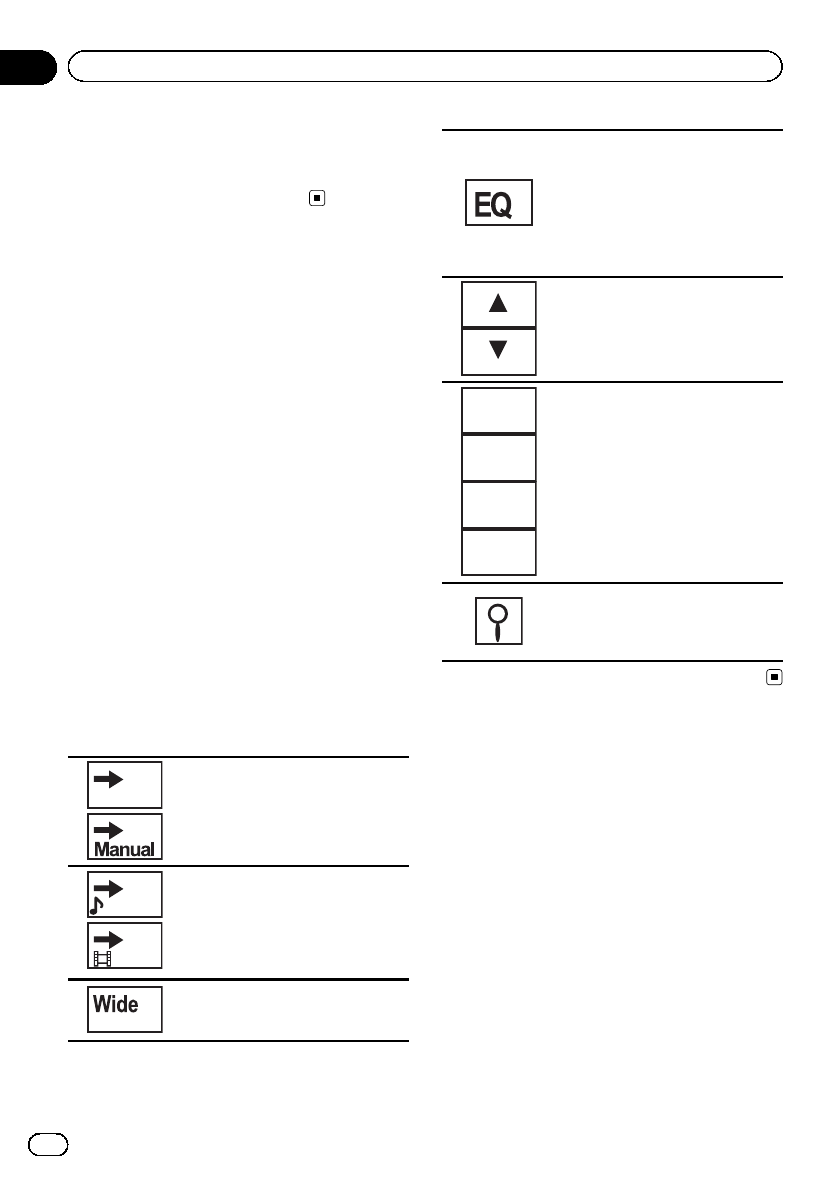
%Insert the stereo mini plug into the
AUX input jack on this unit.
Refer to Installation on the next page.
Refer to What’s what on page 12.
Using an external unit
An external unit refers to a Pioneer product,
such as those which will be available in the fu-
ture. Although incompatible as a source, the
basic functions of up to two external units can
be controlled with this unit. When two external
units are connected, the external units are
automatically allocated to external unit 1 or ex-
ternal unit 2.
The basic operations of the external unit are
explained below. The allocated functions will
differ depending on the connected external
unit. For details concerning these functions,
refer to the owner’s manual for the external
unit.
Basic operations
The functions allocated to the following opera-
tions will differ depending on the connected
external unit. For details concerning these
functions, refer to the owner’s manual for the
connected external unit.
Auto Switching to auto or manual.
Audio
Video
Switching to video and audio.
Changing the screen mode.
Refer to Changing the wide screen
mode on page 40.
Switching the equalizer curves.
Refer to Using the equalizer on
page 53.
Touch and hold for more than two
seconds to turn the auto-equalizer
on or off.
Refer to Using the auto-equalizer
on page 54.
Actions will differ depending on
the connected external unit.
F1
F2
F3
F4
Function 1 to 4
Actions will differ depending on
the connected external unit.
Using the functions allocated to 1
to 6 keys.
Actions will differ depending on
the connected external unit.
En
70
Section
15 Other Functions
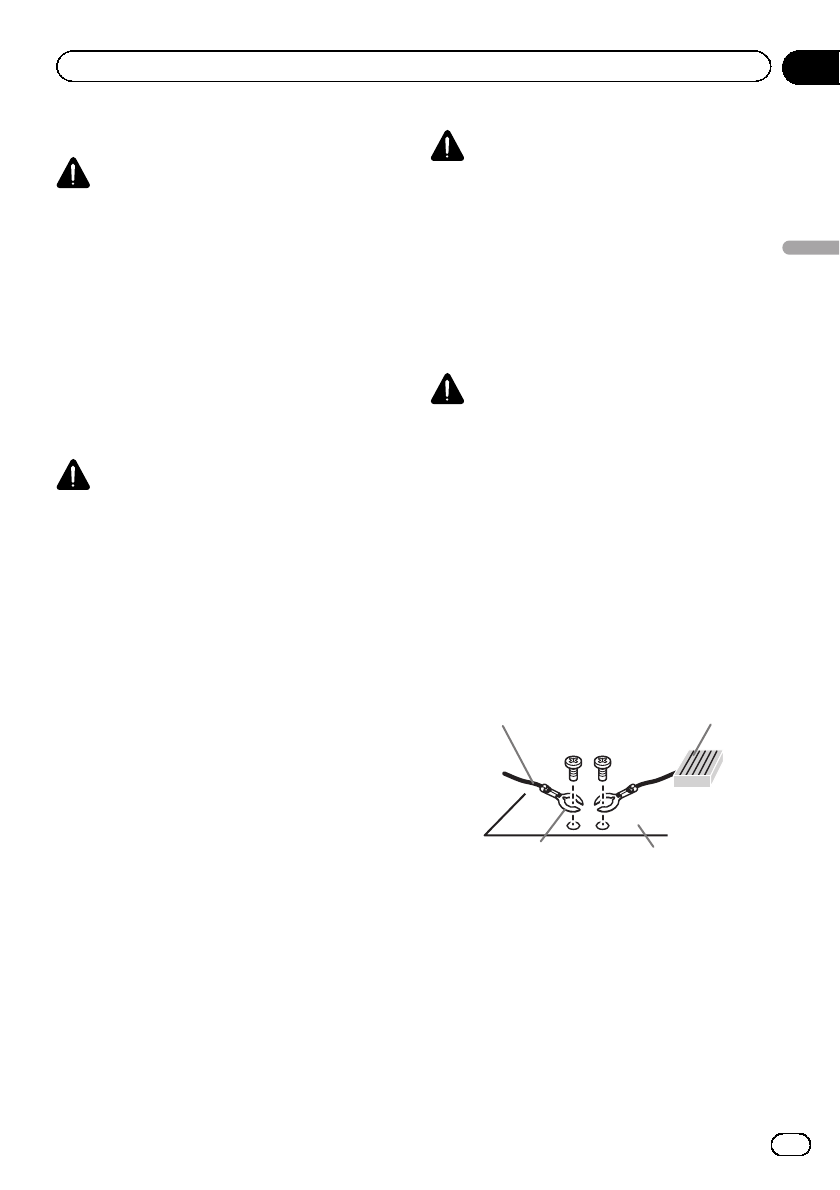
Connecting the units
WARNING
!To avoid the risk of accident and the potential
violation of applicable laws, no viewing of
front seat video should ever occur while the
vehicle is being driven. Also, rear displays
should not be in a location where they are visi-
bly distracting to the driver.
!In some countries or states the viewing of
images on a display inside a vehicle even by
persons other than the driver may be illegal.
Where such regulations apply, they must be
obeyed and this unit’s DVD features should
not be used.
CAUTION
!PIONEER does not recommend that you in-
stall or service your display unit yourself. In-
stalling or servicing the product may expose
you to risk of electric shock or other hazards.
Refer all installation and servicing of your dis-
play unit to authorized Pioneer service person-
nel.
!Secure all wiring with cable clamps or electri-
cal tape. Do not allow any bare wiring to re-
main exposed.
!Do not drill a hole into the engine compart-
ment to connect the yellow cable of the dis-
play unit to the vehicle battery. Engine
vibration may eventually cause the insulation
to fail at the point where the wire passes from
the passenger compartment into the engine
compartment. Take extra care in securing the
wire at this point.
!It is extremely dangerous to allow the micro-
phone lead to become wound around the
steering column or gearstick. Be sure to in-
stall the unit in such a way that it will not ob-
struct driving.
!Make sure that cables will not interfere with
moving parts of the vehicle, such as the gear-
shift, parking brake or seat sliding mechan-
ism.
!Do not shorten any cables. If you do, the pro-
tection circuit may fail to work properly.
WARNING
!LIGHT GREEN LEAD AT POWER CON-
NECTOR IS DESIGNED TO DETECT
PARKED STATUS AND MUST BE CON-
NECTED TO THE POWER SUPPLY SIDE
OF THE PARKING BRAKE SWITCH. IM-
PROPER CONNECTION OR USE OF
THIS LEAD MAY VIOLATE APPLICABLE
LAW AND MAY RESULT IN SERIOUS IN-
JURY OR DAMAGE.
WARNING
!Use speakers over 50 W (output value) and be-
tween 4 Wto 8 W(impedance value). Do not
use 1 Wto 3 Wspeakers for this unit.
!The black cable is ground. When installing
this unit or power amp (sold separately), make
sure to connect the ground wire first. Ensure
that the ground wire is properly connected to
metal parts of the car’s body. The ground wire
of the power amp and the one of this unit or
any other device must be connected to the car
separately with different screws. If the screw
for the ground wire loosens or falls out, it
could result in fire, generation of smoke or
malfunction.
Ground wire
Metal parts of car’s body
POWER AMP
Other devices
(Another electronic
device in the car)
En 71
Section
16
Installation
Installation

Important
!This unit cannot be installed in a vehicle with-
out ACC (accessory) position on the ignition
switch.
O
N
S
T
A
R
T
O
F
F
ACC position No ACC position
!Use this unit with a 12-volt battery and nega-
tive grounding only. Failure to do so may result
in a fire or malfunction.
!To prevent a short-circuit, overheating or mal-
function, be sure to follow the directions
below.
—Disconnect the negative terminal of the
battery before installation.
—Secure the wiring with cable clamps or ad-
hesive tape. Wrap adhesive tape around
wiring that comes into contact with metal
parts to protect the wiring.
—Place all cables away from moving parts,
such as the gear shift and seat rails.
—Place all cables away from hot places,
such as near the heater outlet.
—Do not connect the yellow cable to the bat-
tery by passing it through the hole to the
engine compartment.
—Cover any disconnected cable connectors
with insulating tape.
—Do not shorten any cables.
—Never cut the insulation of the power cable
of this unit in order to share the power
with other devices. The current capacity of
the cable is limited.
—Use a fuse of the rating prescribed.
—Never wire the negative speaker cable di-
rectly to ground.
—Never band together negative cables of
multiple speakers.
!When this unit is on, control signals are sent
through the blue/white cable. Connect this
cable to the system remote control of an exter-
nal power amp or the vehicle’s auto-antenna
relay control terminal (max. 300 mA 12 V DC).
If the vehicle is equipped with a glass anten-
na, connect it to the antenna booster power
supply terminal.
!Never connect the blue/white cable to the
power terminal of an external power amp.
Also, never connect it to the power terminal of
the auto antenna. Doing so may result in bat-
tery drain or a malfunction.
!IP-BUS connectors are color-coded. Be sure
to connect connectors of the same color.
En
72
Section
16 Installation

En 73
Section
16
Installation
Installation
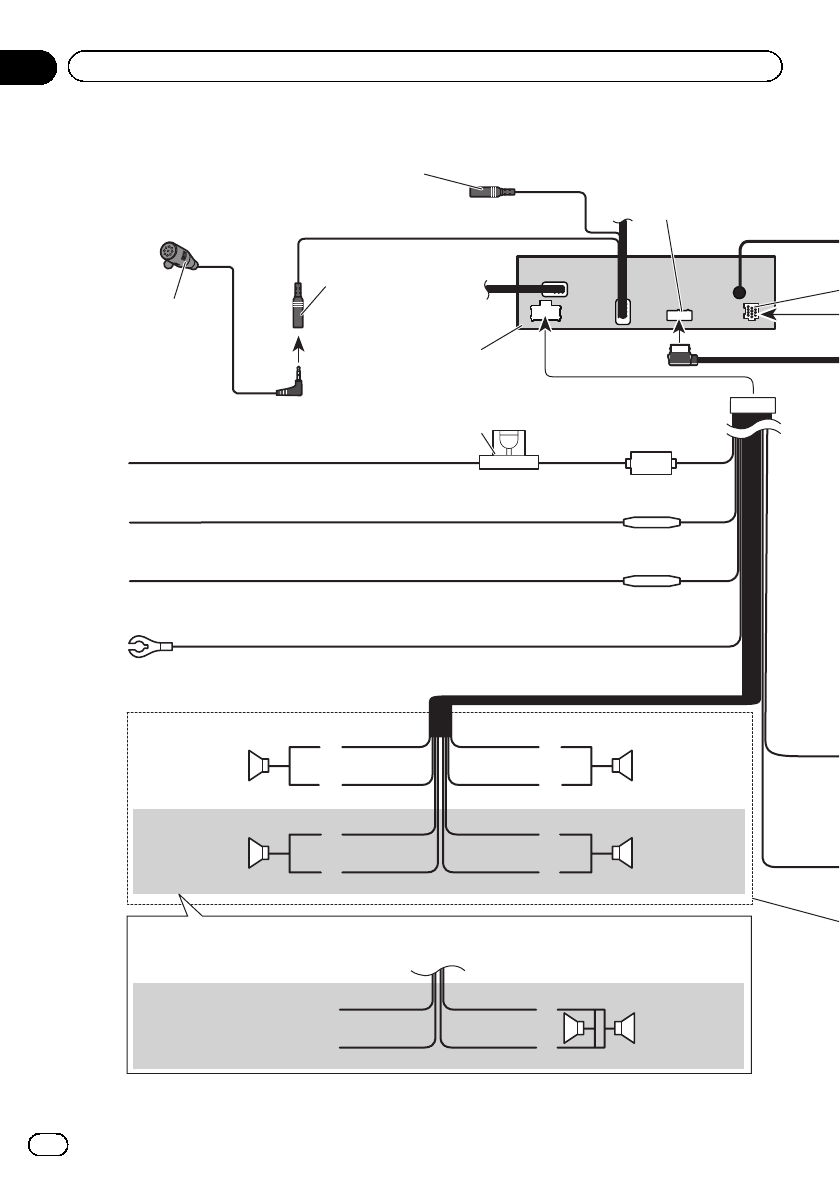
Connecting the power cord
This product
Microphone
(supplied)
4 m (13 ft. 1 in.) Fuse (10 A)
RGB input
Wired remote input (WIRED REMOTE INPUT)
Hard-wired remote control adaptor can be
connected (sold separately).
Microphone input Jack (MIC)
17 cm (6-3/4 in.)
17 cm (6-3/4 in.)
Yellow
Connect to the constant 12 V supply terminal.
Fuse resistor
Red
Connect to terminal controlled by ignition switch (12 V DC).
Black (chassis ground)
Connect to a clean, paint-free metal location.
Left Right
Front speaker Front speaker
Rear speaker or
Subwoofer (4 Ω)
White Gray
Gray/blackWhite/black
Green Violet
Green/black Violet/black
Violet
Violet/black
Not used.
Green
Green/black
When using a subwoofer of 70 W (2 Ω), be sure to connect with Violet and Violet/black leads of this unit.
Do not connect anything to Green and Green/black leads.
Subwoofer (4 Ω)
× 2
Rear speaker or
Subwoofer (4 Ω)
Orange/white
Connect to lighting switch terminal.
Fuse resistor
En
74
Section
16 Installation
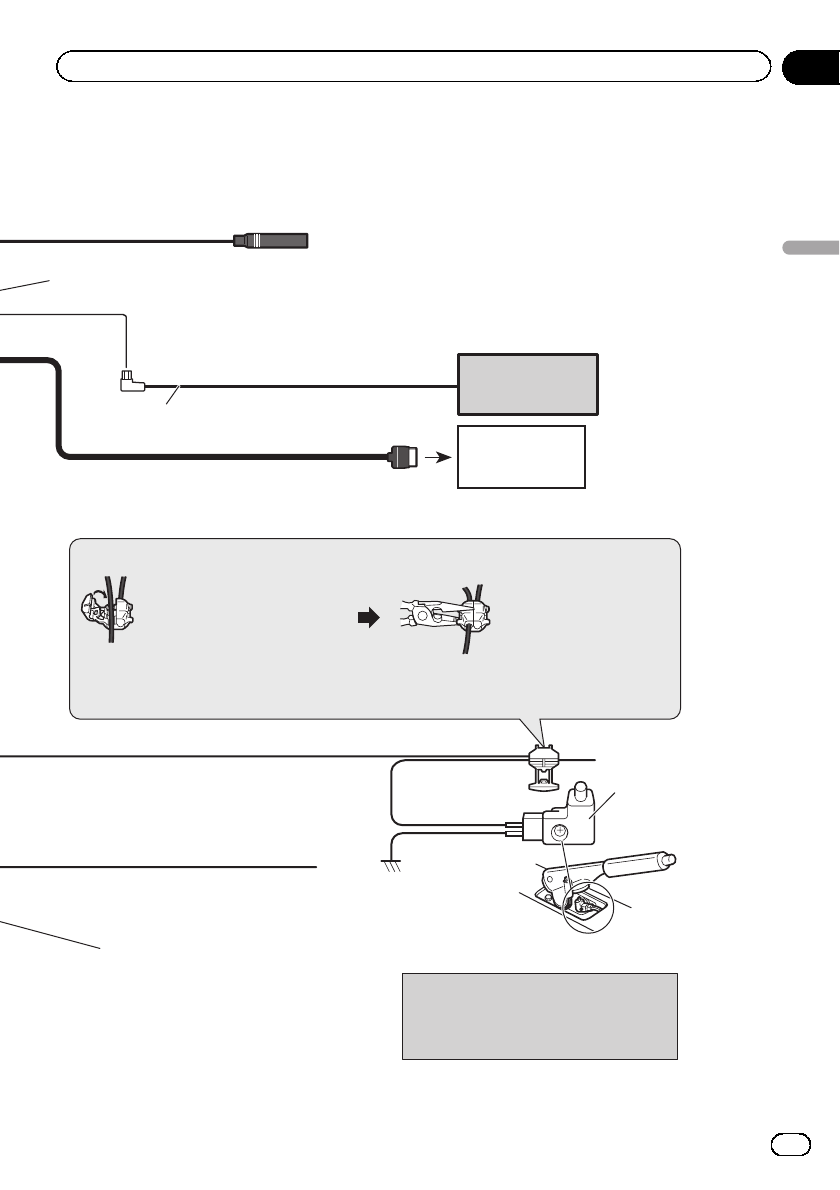
Pioneer IP-BUS
accessories
Navigation system
(AVIC-U220 (sold
separately)).
Antenna input
IP-BUS cable
IP-BUS input
(Blue)
26 pin cable (Supplied with Navigation system)
Insert the 26 pin cable in the direction
indicated in the figure. Please contact your dealer to inquire
about the connectable navigation system.
Connection method
1. Clamp the lead. 2. Clamp firmly with
needle-nosed pliers.
Note:
· The position of the parking brake switch depends on the vehicle model. For details,
consult the vehicle Owner’s Manual or dealer.
Light green
Used to detect the ON/OFF status of the parking
brake. This lead must be connected to the power
supply side of the parking brake switch.
Blue/white
Connect to system control terminal of the power amp or
auto-antenna relay control terminal (max. 300 mA 12 V DC).
Ground side
Power supply side
Parking brake
switch
With a 2 speaker system, do not connect anything to the speaker leads
that are not connected to speakers.
Note:
· Change the initial setting of this unit. The
subwoofer output of this unit is monaural.
En 75
Section
16
Installation
Installation
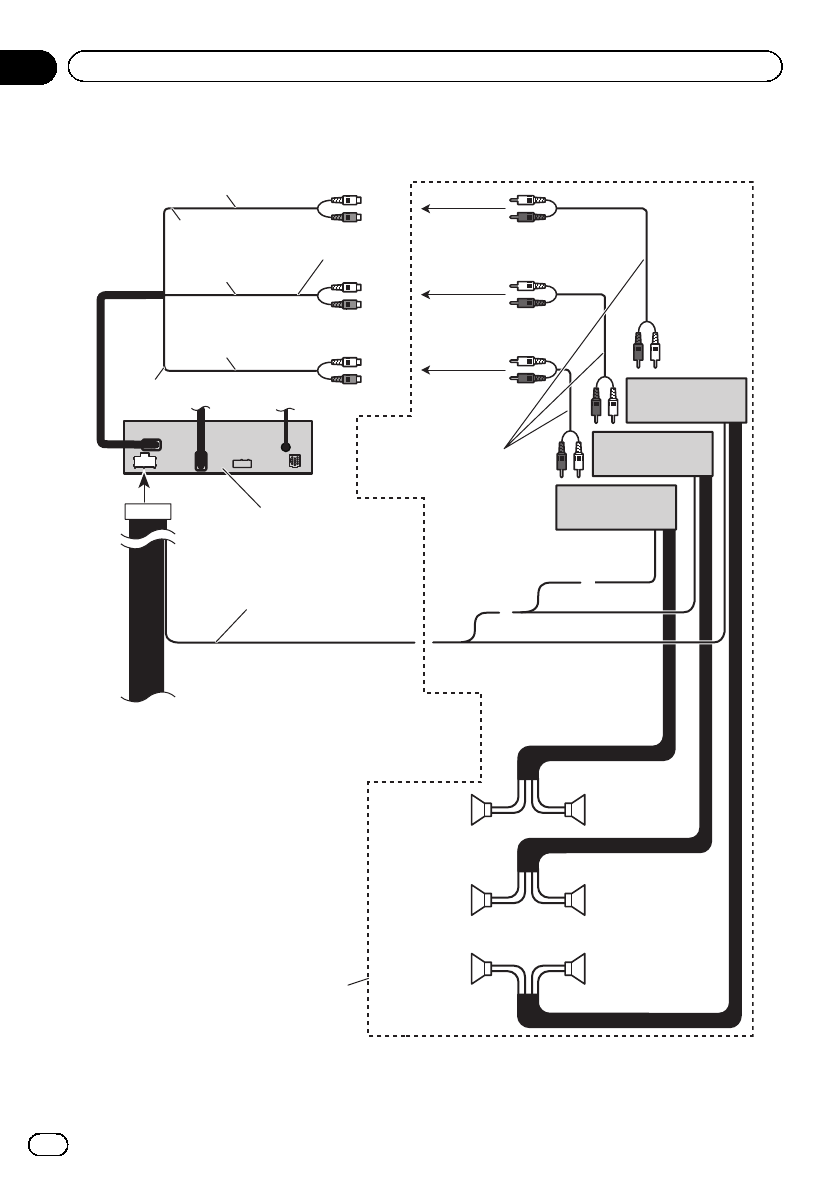
When connecting to separately sold power amp
Blue/white
Connect to system control
terminal of the power amp
(max. 300 mA 12 V DC).
Connect with RCA cables
(sold separately)
Rear speaker
Perform these connections when
using the optional amplifier.
System remote control
Front speaker Front speaker
Left Right
Rear speaker
Power amp
(sold separately)
Power amp
(sold separately)
Power amp
(sold separately)
Subwoofer Subwoofer
To front
output
To rear
output
To subwoofer
output
This product
Rear output
(REAR OUTPUT)
Front output
(FRONT OUTPUT)
Subwoofer output
(SUBWOOFER OUTPUT)
13 cm (5-1/8 in.)
17 cm (6-3/4 in.)
13 cm (5-1/8 in.)
En
76
Section
16 Installation
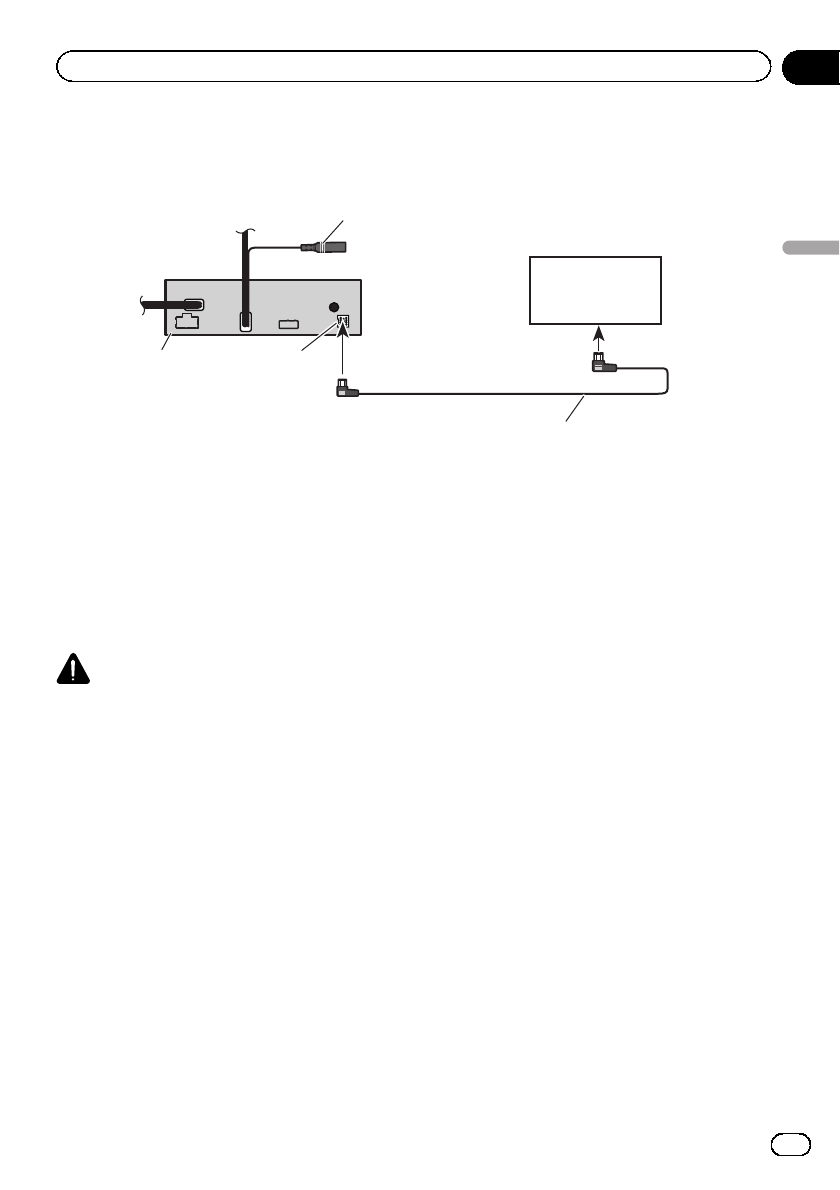
Connecting the system
This product
Wired remote input (WIRED REMOTE INPUT)
Hard-wired remote control adaptor can be
connected (sold separately).
IP-BUS input
HD Radio tuner
(sold separately)
IP-BUS cable
(Supplied with HD Radio tuner)
When connecting the external video component and the display
When using a display connected to rear video output
This product’s rear video output and rear
audio output are for connection of a display to
enable passengers in the rear seats to watch
the DVD, etc.
WARNING
!Never install the display in a location where it
is visible to the driver while driving.
En 77
Section
16
Installation
Installation
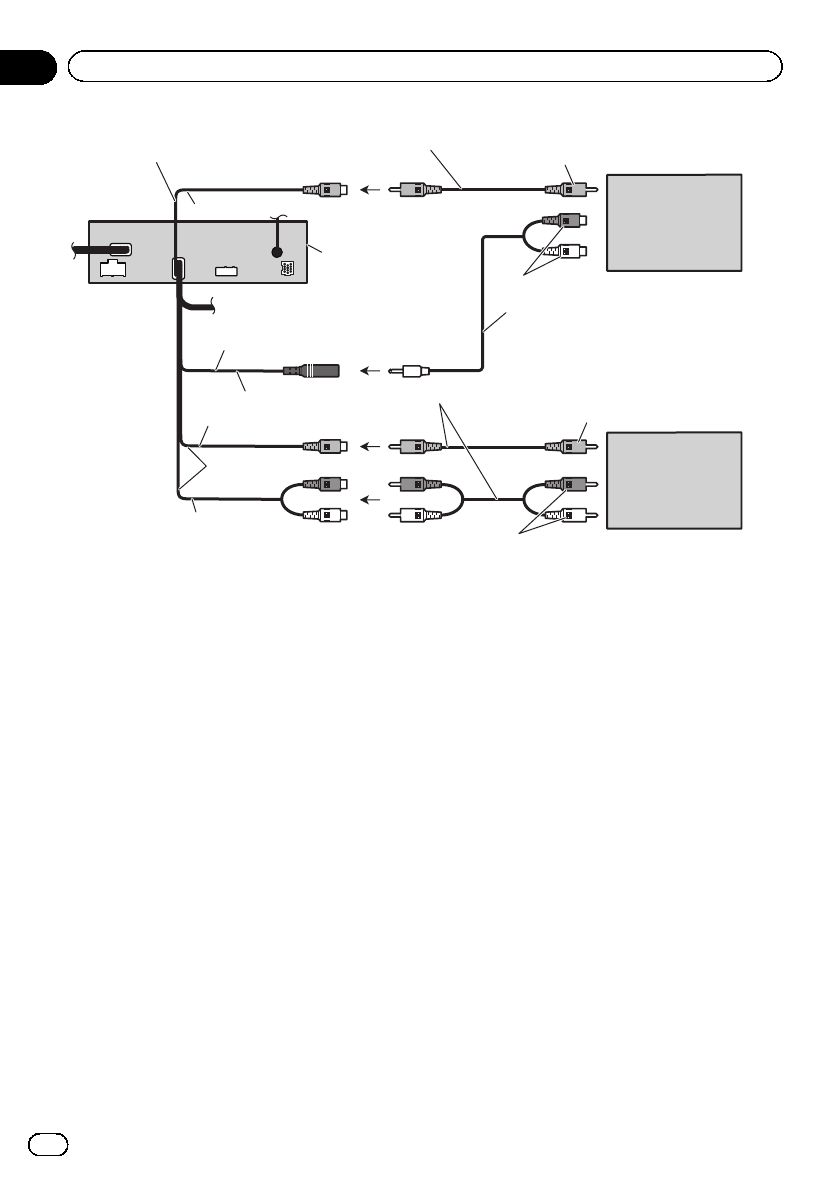
This product
External video
component (sold
separately)
RCA cables (sold separately)
Audio inputs
(AUDIO INPUT)
Video input (VIDEO INPUT)
Display with RCA
input jacks (sold
separately)
Rear monitor output
(REAR MONITOR OUTPUT)To video input
To video output
To audio outputs
13 cm (5-1/8 in.)
Rear audio output
(REAR MONITOR OUTPUT(AUDIO))
To audio inputs
RCA cables (sold separately)
17 cm (6-3/4 in.)
Mini pin plug cable
(sold separately)
13 cm (5-1/8 in.)
!It is necessary to change AV Input in
System Menu when connecting the exter-
nal video component.
En
78
Section
16 Installation
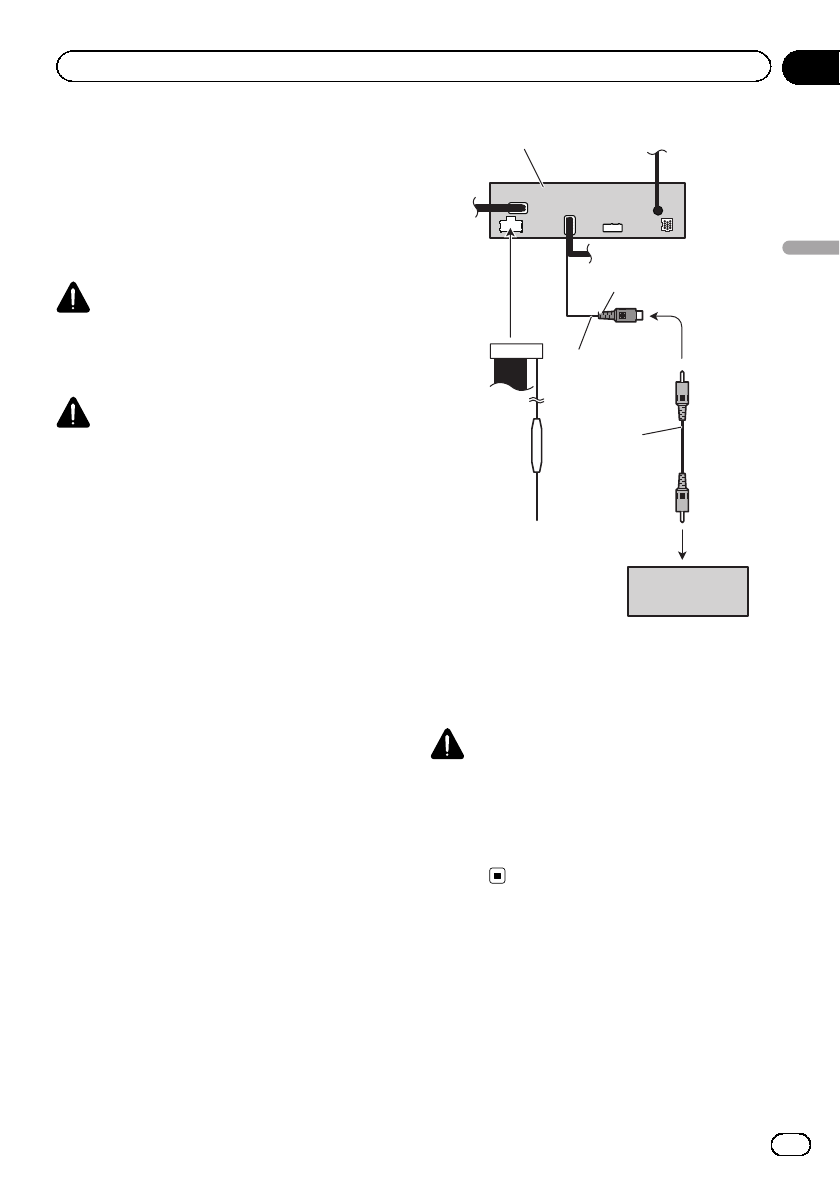
When connecting with a rear
view camera
When this product is used with a rear view
camera, it is possible to automatically switch
from the video to rear view image when the
gear shift is moved to REVERSE (R).
WARNING
USE INPUT ONLY FOR REVERSE OR MIR-
ROR IMAGE REAR VIEW CAMERA. OTHER
USE MAY RESULT IN INJURY OR DAMAGE.
CAUTION
!The screen image may appear reversed.
!The rear view camera function is to be used
as an aid to keep an eye on trailers, or while
backing up. Do not use for entertainment pur-
poses.
!Objects in the rear view may appear closer or
more distant than they actually are.
Rear view camera input
(REAR VIEW CAMERA IN)
This product
13 cm (5-1/8 in.)
To video output
Rear view camera
(sold separately)
Violet/white
Of the two lead wires
connected to the back lamp,
connect the one in which the
voltage changes when the
gear shift is in the REVERSE
(R) position. This connection
enables the unit to
sense whether the car is
moving forwards or
backwards.
Fuse resistor RCA cable
(sold separately)
CAUTION
You must use a camera which outputs mirror
reversed images.
It is necessary to set Camera Polarity properly in
System Menu when connecting the rear view
camera.
En 79
Section
16
Installation
Installation
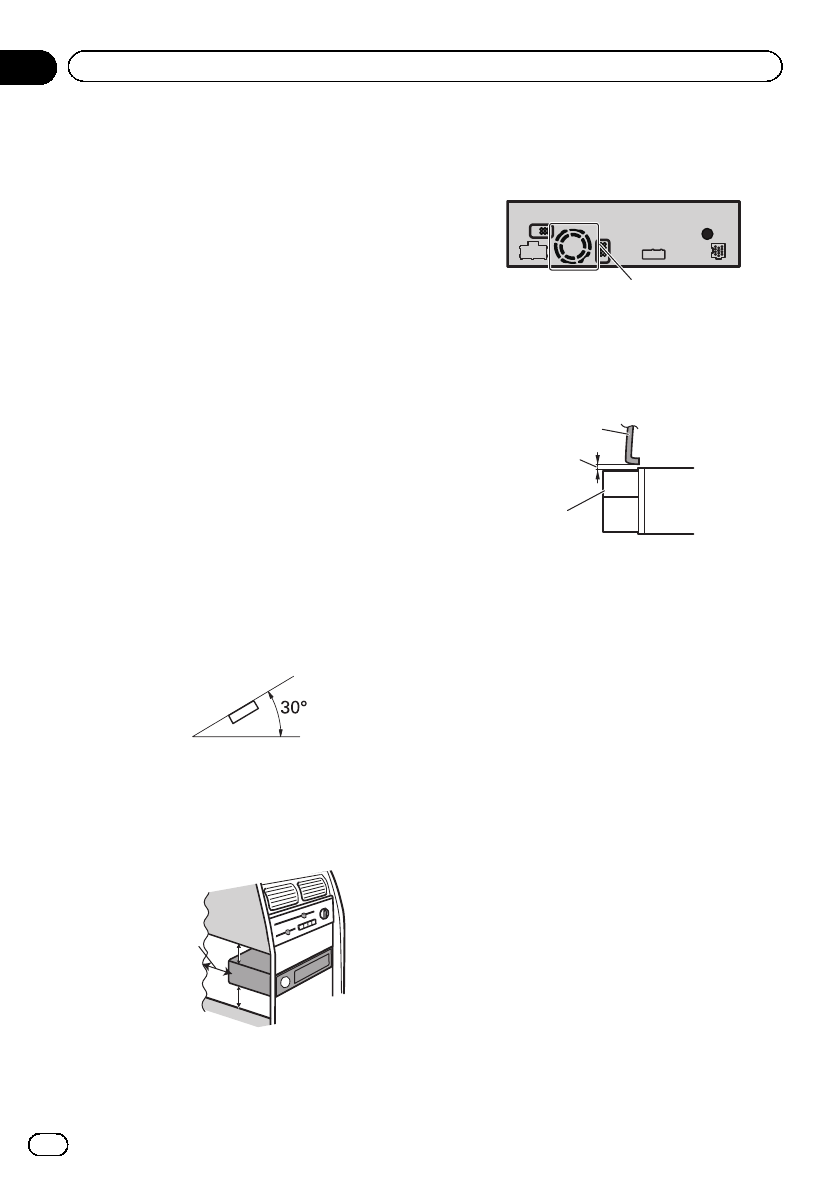
Installation
Notes
!Check all connections and systems before
final installation.
!Do not use unauthorized parts as this may
cause malfunctions.
!Consult your dealer if installation requires dril-
ling of holes or other modifications to the vehi-
cle.
!Do not install this unit where:
—it may interfere with operation of the vehi-
cle.
—it may cause injury to a passenger as a re-
sult of a sudden stop.
!Do not install the display where it may (i) ob-
struct the driver’s vision, (ii) impair the perfor-
mance of any of the vehicle’s operating
systems or safety features, including air bags,
hazard lamp buttons or (iii) impair the driver’s
ability to safely operate the vehicle.
!The semiconductor laser will be damaged if it
overheats. Install this unit away from hot
places such as near the heater outlet.
!Optimum performance is obtained when the
unit is installed at an angle of less than 30°.
!To ensure proper heat dispersal when using
this unit, make sure you leave ample space
behind the rear panel and wrap any loose
cables so they are not blocking the vents
when installing the unit.
5cmcm
Leave ample
space 5 cm
5 cm
!The cords must not cover up the area shown
in the figure below. This is necessary to allow
the amplifiers to radiate freely.
1
1Do not cover this area.
!Make sure you leave enough gap between the
dashboard and the LCD panel of this unit so
the LCD panel can be opened and closed with-
out contacting with the dashboard.
1
2
3
1Dashboard
2Leave gap
3LCD panel
!To some types of vehicles, this unit cannot be
properly installed. In such case, use the op-
tional installation kit (ADT-VA133).
DIN front/rear-mount
This unit can be properly installed using either
front-mount or rear-mount installation.
Use commercially available parts when instal-
ling.
DIN Front-mount
1 Decide the position of the side brack-
ets.
When installing in a shallow space, change
the position of side brackets (small).
En
80
Section
16 Installation
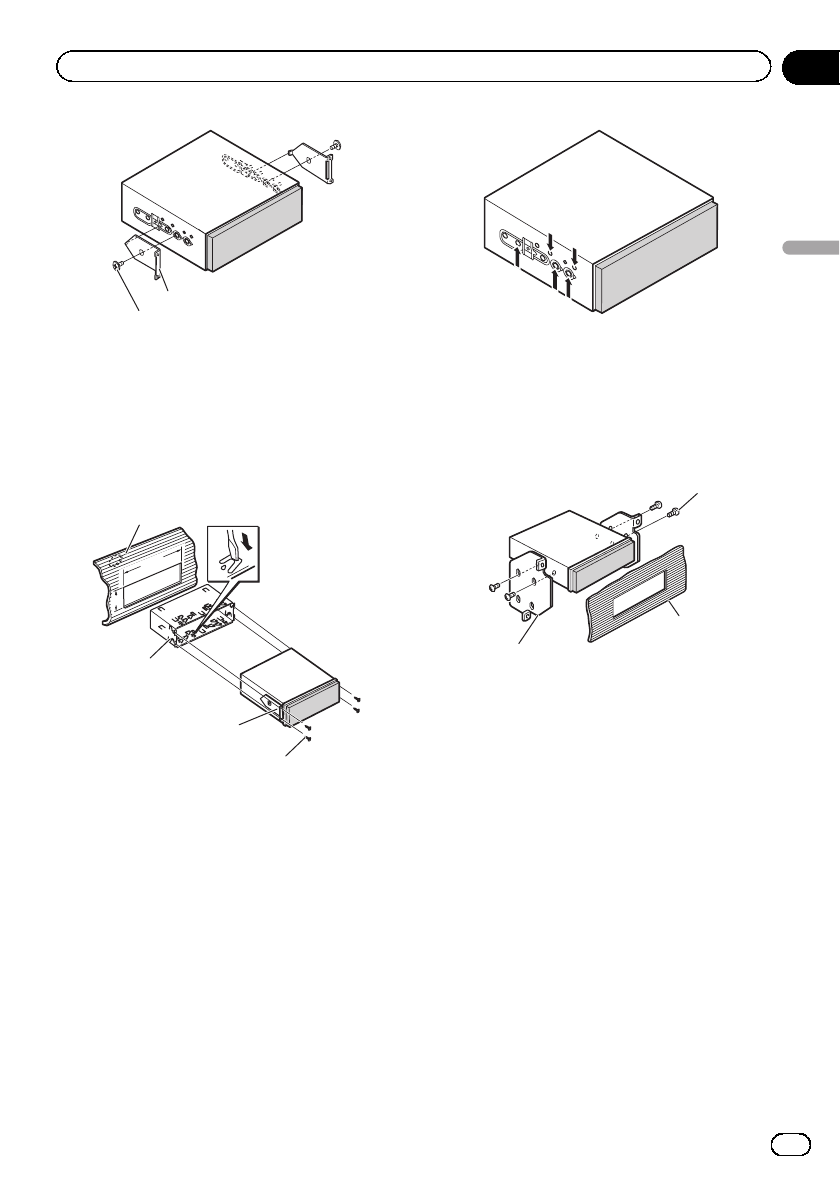
2
1
1Side bracket (small)
2Flush surface screw (5 mm × 6 mm)
2 Install the unit into the dashboard.
Insert the mounting sleeve into the dashboard.
And then secure the mounting sleeve by using
a screwdriver to bend the metal tabs (90°) into
place.
182
53
1
3
4
2
1Dashboard
2Mounting sleeve
3Side bracket
4Screw (2 mm × 3 mm)
DIN Rear-mount
1 Determine the appropriate position
where the holes on the bracket and the
side of the unit match.
When installing in a shallow space, use the
following screw holes.
1
1
1Use binding screws (4 mm × 3 mm) only.
2 Tighten two screws on each side.
Use any of binding screws (4 mm × 3 mm),
binding screws (5 mm × 6 mm) or flush sur-
face screws (5 mm × 6 mm), depending on
the shape of screw holes in the bracket.
1
2
3
1Screw
2Dashboard or console
3Factory radio mounting bracket
Removing the unit
Extend top and bottom of the trim ring out-
wards to remove the trim ring. And then loos-
en the screws (2 mm × 3 mm) to remove the
mounting sleeve.
!When reattaching the trim ring, push the
trim ring onto the unit until it clicks. (If the
trim ring is attached upside down, the trim
ring will not fit properly.)
En 81
Section
16
Installation
Installation
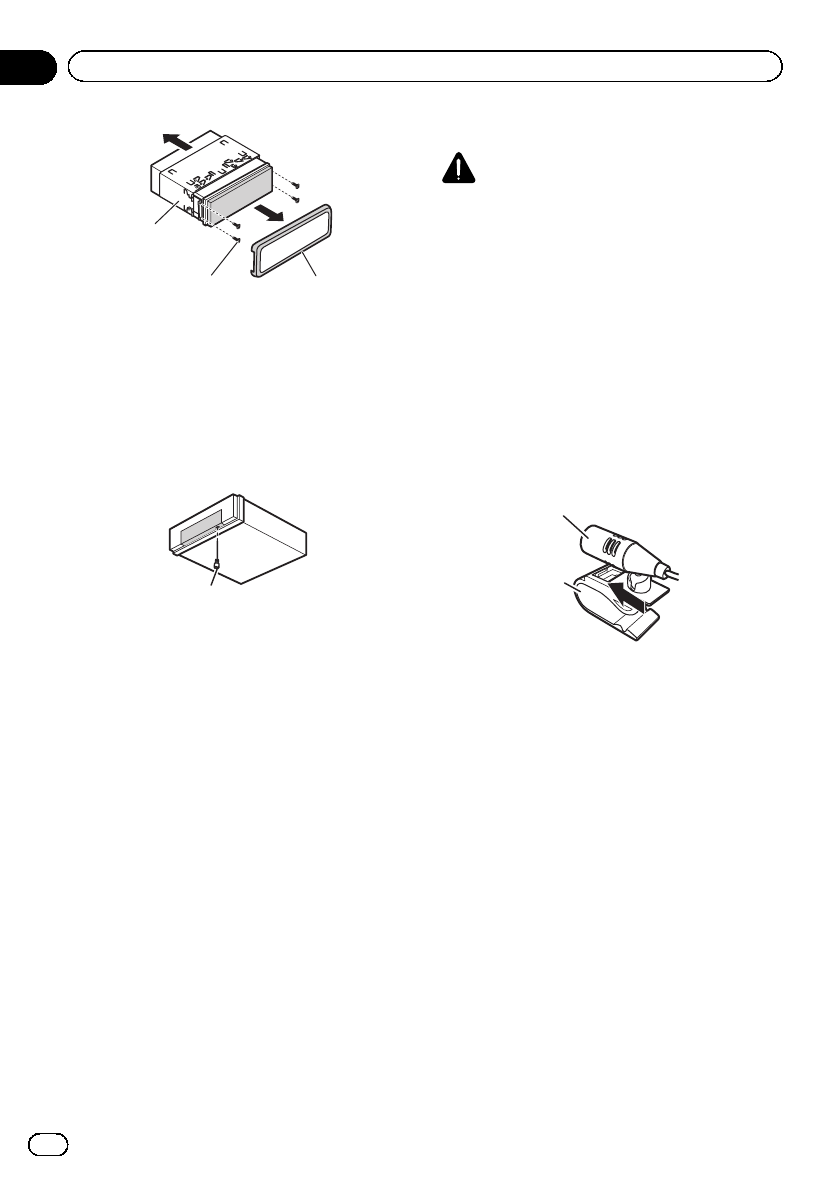
1
3
2
1Mounting sleeve
2Screw (2 mm × 3 mm)
3Trim ring
Fastening the front panel
If you do not plan to detach the front panel,
the front panel can be fastened with supplied
screw.
1
1Screw
Installing the microphone
CAUTION
It is extremely dangerous to allow the micro-
phone lead to become wound around the steer-
ing column or gearstick. Be sure to install the
unit in such a way that it will not obstruct driving.
Note
Install the microphone in a position and orienta-
tion that will enable it to pick up the voice of the
person operating the system.
When installing the microphone on
the sun visor
1 Install the microphone on the micro-
phone clip.
1
2
1Microphone
2Microphone clip
2 Install the microphone clip on the sun
visor.
With the sun visor up, install the microphone
clip. (Lowering the sun visor reduces the voice
recognition rate.)
En
82
Section
16 Installation
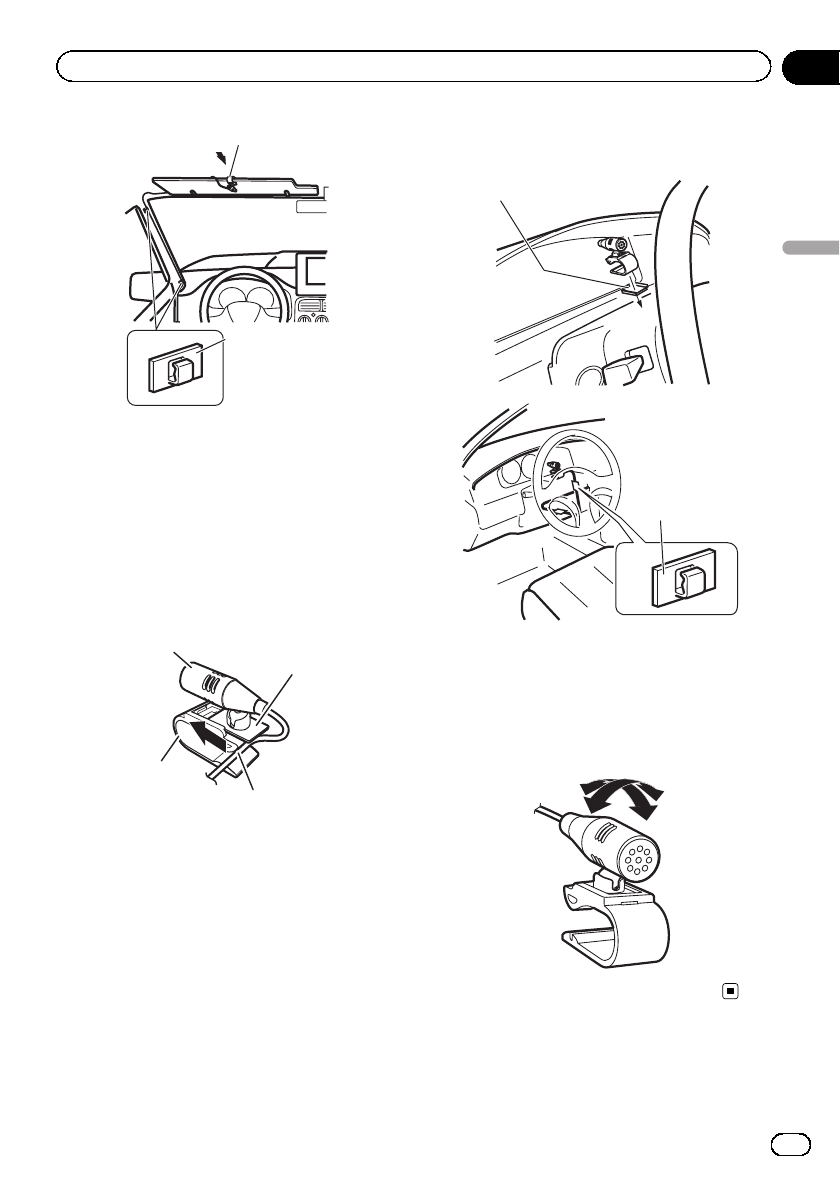
1
2
1Microphone clip
2Clamp
Use separately sold clamps to secure the
lead where necessary inside the vehicle.
When installing the microphone on
the steering column
1 Install the microphone on the micro-
phone clip.
2
1
3
4
1Microphone
2Microphone base
3Microphone clip
4Fit the microphone lead into the groove.
#Microphone can be installed without using
microphone clip. In this case, detach the micro-
phone base from the microphone clip. To detach
the microphone base from the microphone clip,
slide the microphone base.
2 Install the microphone clip on the rear
side of the steering column.
1
2
1Double-sided tape
2Clamp
Use separately sold clamps to secure the
lead where necessary inside the vehicle.
Adjusting the microphone angle
The microphone angle can be adjusted.
En 83
Section
16
Installation
Installation

Troubleshooting
Common
Symptom Cause Action (Refer-
ence page)
The power will
not turn on.
The unit will
not operate.
Leads and con-
nectors are incor-
rectly connected.
Confirm once more
that all connec-
tions are correct.
The fuse is
blown.
Rectify the cause
and then replace
the fuse. Be sure to
install a fuse with
the same rating.
Noise and/or
other factors are
causing the built-
in microproces-
sor to operate in-
correctly.
Press RESET.(Page
12)
Operation with
the remote
control is not
possible.
The unit does
not operate
correctly even
when the ap-
propriate re-
mote control
buttons are
pressed.
Battery power is
low.
Load a new battery.
Some operations
are prohibited
with certain
discs.
Try operating with
another disc.
Playback is not
possible.
The disc is dirty. Clean the disc.
The type of disc
loaded cannot be
played on this
unit.
Check the disc
type.
The disc loaded
is not compatible
with this video
system.
Change the disc to
one that is compa-
tible with your
video system.
There is no
sound.
The volume
level will not
rise.
Cables are not
connected cor-
rectly.
Connect the cables
correctly.
The unit is per-
forming still,
slow motion or
frame-by-frame
playback.
There is no sound
during still, slow
motion or frame-
by-frame playback.
Symptom Cause Action (Refer-
ence page)
There is no
image dis-
played.
The parking
brake cable is
not connected.
Connect the park-
ing brake cable,
and apply the park-
ing brake.
The parking
brake is not ap-
plied.
Connect the park-
ing brake cable,
and apply the park-
ing brake.
The icon is
displayed, and
operation is not
possible.
The operation is
prohibited for the
disc.
This operation is
not possible.
The operation is
not compatible
with the config-
uration of the
disc.
This operation is
not possible.
The image dis-
played stops
(pauses) and
the unit cannot
be operated.
The data could
no longer be
read during play-
back.
Stop playback
once, and start
playback again.
There is no
sound.
The volume
level is low.
The volume level
is low.
Adjust the volume
level.
The attenuator is
on.
Turn the attenuator
off.
The sound and
video skip.
The unit is not
firmly secured.
Firmly secure the
unit.
File size and
transmission rate
are above recom-
mended rates.
Create a DivX file
that is within the
recommended size
and transmission
rate.
The aspect
ratio is incor-
rect and the
image is
stretched.
The aspect ratio
setting is incor-
rect for the dis-
play.
Select the appro-
priate setting for
your display. (Page
57)
The motor
sounds when
the ignition
switch is
turned ON (or
is turned to
ACC).
The unit is con-
firming whether
or not a disc is
loaded.
This is a normal
operation.
En
84
Appendix
Additional Information

Symptom Cause Action (Refer-
ence page)
Nothing is dis-
played.
The touch
panel keys can-
not be used.
The rear view
camera is not
connected.
Connect a rear
view camera.
Camera Polarity
is at incorrect
setting.
Press and hold
MENU to return to
the source display
and then select the
correct setting for
Camera Polarity.
(Page 63)
No xxxx ap-
pears when a
display is chan-
ged (No Title,
for example).
There is no em-
bedded text infor-
mation.
Switch the display
or play another
track/file.
Sub-folders
cannot be
played back.
Folder repeat
play has been se-
lected.
Select the repeat
range again.
The repeat
range changes
automatically.
Another folder
was selected dur-
ing repeat play.
Select the repeat
range again.
Track search or
fast forward/re-
verse was per-
formed during
file repeat play.
Select the repeat
range again.
DVD
Symptom Cause Action (Refer-
ence page)
Playback is not
possible.
The loaded disc
has a different re-
gion number
from this unit.
Replace the disc
with one featuring
the same region
number as this
unit.
A parental lock
message is dis-
played and
playback is not
possible.
Parental lock is
activated.
Turn parental lock
off or change the
level. (Page 57)
Parental lock
cannot be can-
celed.
The code number
is incorrect.
Enter the correct
code number.
(Page 57)
You have forgot-
ten your code
number.
Press RESET.(Page
58)
Symptom Cause Action (Refer-
ence page)
Dialog lan-
guage (and
subtitle lan-
guage) cannot
be switched.
The DVD being
played does not
feature multiple
language record-
ings.
The language can-
not be switched if
they are not re-
corded on the disc.
You can only
switch between
items indicated
in the disc menu.
Switch the lan-
guage using the
disc menu.
No subtitles
are displayed.
The DVD being
played does not
feature subtitles.
Subtitles are not
displayed if they
are not recorded
on the disc.
You can only
switch between
items indicated
in the disc menu.
Switch the lan-
guage using the
disc menu.
Playback is not
performed with
the audio lan-
guage and sub-
title language
settings se-
lected in Video
Setup menu.
The DVD being
played does not
feature dialog or
subtitles in the
selected lan-
guage.
The language can-
not be switched if
the selected lan-
guage is not re-
corded on the disc.
The viewing
angle cannot
be switched.
The DVD being
played does not
feature scenes
shot from multi-
ple angles.
The viewing angle
cannot be
switched if the
DVD does not fea-
ture scenes re-
corded from
multiple angles.
You are trying to
switch to multi-
angle viewing for
a scene that was
not recorded
from multiple an-
gles.
Switch between
multiple angles
when watching
scenes recorded
from multiple an-
gles.
En 85
Appendix
Additional Information
Additional Information

Symptom Cause Action (Refer-
ence page)
The image is
extremely un-
clear/distorted
and dark dur-
ing playback.
Some discs fea-
ture a signal to
prohibit copying.
Since this unit is
compatible with
the analog copy
generation man-
agement system,
when playing a
disc that has a sig-
nal prohibiting
copying, horizontal
stripes or other im-
perfections may
appear when
viewed on some
displays. This is
not a malfunction.
Video CD
Symptom Cause Action
The PBC (play-
back control)
menu cannot
be called up.
The Video CD
being played
does not feature
PBC.
This operation is
not available for
Video CDs that do
not feature PBC.
Repeat play
and track/time
search are not
possible.
The Video CD
being played fea-
tures PBC.
This operation is
not available for
Video CDs that fea-
ture PBC.
iPod
Symptom Cause Action
The iPod does
not operate
correctly.
The cables are in-
correctly con-
nected.
Disconnect the
cable from the
iPod. Once the
iPod’s main menu
is displayed, recon-
nect the iPod and
reset it.
The iPod version
is old.
Update the iPod
version.
Error messages
When you contact your dealer or your nearest
Pioneer Service Center, be sure to note the
error message.
Tuner
Message Cause Action
No Data Pro-
vided
This unit cannot
receive artist
name/song title
information.
Move to the desir-
able location with
good reception.
No Data This unit cannot
receive program
service name in-
formation.
Move to the desir-
able location with
good reception.
DVD
Message Cause Action
Different Re-
gion Disc
The disc does not
have the same
region number
as this unit.
Replace the DVD
with one bearing
the correct region
number.
Error-02-XX/
FF-FF
The disc is dirty. Clean the disc.
The disc is
scratched.
Replace the disc.
The disc is
loaded upside
down.
Check that the disc
is loaded correctly.
There is an elec-
trical or mechan-
ical error.
Press RESET.
Unplayable
Disc
This type of disc
cannot be played
on this unit.
Replace the disc
with one that can
be played on this
unit.
The inserted disc
does not contain
any playable
files.
Replace the disc.
Protect All the files on
the inserted disc
are embedded
with DRM.
Replace the disc.
Skipped The inserted disc
contains DRM
protected files.
Play an audio file
not embedded with
Windows Media
DRM 9/10.
TEMP The temperature
of the unit is out-
side the normal
operating range.
Wait until the unit
returns to a tem-
perature within the
normal operating
limits.
En
86
Appendix
Additional Information

Message Cause Action
Rental Ex-
pired.
The inserted disc
contains expired
DivX VOD con-
tent.
Select a file that
can be played.
Video resolu-
tion not sup-
ported
The inserted disc
contains a high
definition DivX
file.
Select a file that
can be played.
It is not possi-
ble to write it
in the flash.
Flash memory
error.
Replace the flash
memory.
Your device is
not author-
ized to play
this DivX pro-
tected video.
This unit’s DivX
registration code
has not been
authorized by the
DivX VOD con-
tents provider.
Register this unit
to the DivX VOD
contents provider.
Unplayable
File
This type of file
cannot be played
on this unit.
Select a file that
can be played.
Format Read Sometimes there
is a delay be-
tween the start of
playback and
when you start to
hear any sound.
Wait until the mes-
sage disappears
and you hear
sound.
Video frame
rate not sup-
ported.
DivX file’s frame
rate is more than
30 fps.
Select a file that
can be played.
Audio Format
not sup-
ported.
This type of file is
not supported on
this unit.
Select a file that
can be played.
External storage device (USB, SD)
Message Cause Action
Unplayable
File
This type of file
cannot be played
on this unit.
Select a file that
can be played.
There are no
songs.
Transfer the audio
files to the external
storage device and
connect.
Security for the
connected USB
memory is en-
abled.
Follow the USB
memory instruc-
tions to disable se-
curity.
Message Cause Action
Format Read Sometimes there
is a delay be-
tween the start of
playback and
when you start to
hear any sound.
Wait until the mes-
sage disappears
and you hear
sound.
Skipped The connected
external storage
device contains
WMA files that
are protected by
Windows Med-
iaäDRM 9/10.
Play an audio file
not embedded with
Windows Media
DRM 9/10.
Protect All the files on
the connected
external storage
device is pro-
tected by
Windows Media
DRM 9/10.
Transfer audio files
not protected by
Windows Media
DRM 9/10 to the
external storage
device and con-
nect.
Incompatible
USB
The USB device
connected to is
not supported by
this unit.
Connect a USB
portable audio
player or USB
memory that is
USB Mass Storage
Class compliant.
The USB device
is not formatted
with FAT16 or
FAT32.
The connected
USB device should
be formatted with
FAT16 or FAT32.
Incompatible
SD
Unsupported SD
card is inserted.
Use the supported
SD card.
Non-compatible
SD storage de-
vice
Remove your de-
vice and replace it
with a compatible
SD storage device.
En 87
Appendix
Additional Information
Additional Information

Message Cause Action
Check USB The USB connec-
tor or USB cable
has short-
circuited.
Check that the
USB connector or
USB cable is not
caught in some-
thing or damaged.
The connected
USB portable
audio player/
USB memory
consumes more
than maximum
allowable cur-
rent.
Disconnect the
USB portable
audio player/USB
memory and do
not use it. Turn the
ignition switch to
OFF, then to ACC
or ON and then
connect a compli-
ant USB portable
audio player/USB
memory.
Error-02-9X/-
DX
Communication
failed.
Perform one of the
following opera-
tions.
–Turn the ignition
switch OFF and
back ON.
–Disconnect the
USB portable
audio player/USB
memory.
–Change to a dif-
ferent source.
Then, return to the
USB portable
audio player/USB
memory.
Rental Ex-
pired.
The inserted ex-
ternal storage de-
vice contains
expired DivX
VOD content.
Select a file that
can be played.
Video resolu-
tion not sup-
ported
The inserted ex-
ternal storage de-
vice contains a
high definition
DivX file.
Select a file that
can be played.
It is not possi-
ble to write it
in the flash.
Flash memory
error.
Replace the flash
memory.
Your device is
not author-
ized to play
this DivX pro-
tected video.
This unit’s DivX
registration code
has not been
authorized by the
DivX VOD con-
tents provider.
Register this unit
to the DivX VOD
contents provider.
Message Cause Action
Format Read Sometimes there
is a delay be-
tween the start of
playback and
when you start to
hear any sound.
Wait until the mes-
sage disappears
and you hear
sound.
Video frame
rate not sup-
ported.
DivX file’s frame
rate is more than
30 fps.
Select a file that
can be played.
Audio Format
not sup-
ported.
This type of file is
not supported on
this unit.
Select a file that
can be played.
iPod
Message Cause Action
Format Read Sometimes there
is a delay be-
tween the start of
playback and
when you start to
hear any sound.
Wait until the mes-
sage disappears
and you hear
sound.
Error-02-6X/-
9X/-DX
Communication
failed.
Disconnect the
cable from the
iPod. Once the
iPod’s main menu
is displayed, recon-
nect the iPod and
reset it.
iPod failure. Disconnect the
cable from the
iPod. Once the
iPod’s main menu
is displayed, recon-
nect the iPod and
reset it.
Error-02-67 The iPod firm-
ware version is
old.
Update the iPod
version.
Stop There are no
songs.
Transfer songs to
the iPod.
There are no
songs in the cur-
rent list.
Select a list that
contains songs.
Not Found No related
songs.
Transfer songs to
the iPod.
En
88
Appendix
Additional Information

iTunes tagging
Message Cause Action
iPod full. Tags
not trans-
ferred.
Memory used for
tag information
on the iPod is
full.
Sync the iPod with
iTunes and clean
up the tagged play-
list.
Memory full.
Tags not
stored.
This unit’s flash
memory used as
the temporary
storage area is
full.
Connect the iPod
to this unit and
transfer this unit’s
tag information to
the iPod.
Tags trans-
ferred failed.
This unit’s tag in-
formation cannot
transfer to the
iPod.
Check the iPod
and try again.
Tag store
failed.
Tag information
cannot be stored
in this unit.
Try again.
Error-8D Built-in FLASH
ROM encoun-
tered an error
Turn the ignition
OFF and ON.
SD source can-
not be se-
lected during
tag transfer.
Tag information
is being trans-
ferred to the
iPod.
Wait until tag
transfer is com-
plete.
Bluetooth
Message Cause Action
Error-10 The power failed
for the Bluetooth
module of this
unit.
Turn the ignition
switch OFF and
then to ACC or ON.
If the error mes-
sage is still dis-
played after
performing the
above action,
please contact
your dealer or an
authorized Pioneer
Service Station.
Pandora
Message Cause Action
Error-19 Communication
failed.
Disconnect the
cable from the
iPod. Once the
iPod’s main menu
is displayed, recon-
nect the iPod and
reset it.
Message Cause Action
Start up the
Pandora Ap-
plication from
your Device.
The Pandora ap-
plication has not
started running
yet.
Start up the
Pandora applica-
tion from your
iPod/iPhone.
Unable to
save thumb
rating. Try
again later.
Unable to save
thumb rating.
Try again later.
Unable to
save Book-
mark. Try
again later.
Unable to save
Bookmark.
Try again later.
Pandora sys-
tem mainte-
nance. Try
again later.
Pandora system
is undergoing
maintenance.
Try again later.
Skip limit
reached.
Skip limit
reached.
Do not exceed the
skip limit.
This version
of the
Pandora Ap-
plication is
not sup-
ported.
This version of
the Pandora ap-
plication is not
supported.
Connect an iPod/
iPhone that has a
compatible version
of the Pandora ap-
plication installed.
Check Device Device error mes-
sage displayed in
Pandora Applica-
tion.
Please check your
iPod/iPhone.
Pandora is un-
able to play
music. Please
see your De-
vice.
Unable to play
music from
Pandora.
Please check your
iPod/iPhone.
Create station
within the
Pandora Ap-
plication on
Device.
No station found. Create a station in
the Pandora appli-
cation on your
iPod/iPhone.
No Active Sta-
tion
No station se-
lected.
Select a station.
En 89
Appendix
Additional Information
Additional Information

Understanding auto EQ
error messages
When correct measurement of the car’s inter-
ior acoustic characteristics is not possible
using auto EQ, an error message may appear
on the display. In such cases, refer to the table
below to see what the problem is and how it
may be corrected. After checking, try again.
Message Cause Action
Error. Please
check MIC.
The microphone
is not connected.
Plug the optional
microphone se-
curely into the
jack.
Error. Please
check xxxx
speaker.
The microphone
cannot pick up
the measuring
tone of a speaker.
!Confirm that the
speakers are con-
nected correctly.
!Correct the input
level setting of the
power amp con-
nected to the
speakers.
!Plug the micro-
phone securely
into the jack.
Error. Please
check noise.
The surrounding
noise level is too
high.
!Stop your car in
a place that is
quiet, and switch
off the engine, air
conditioner and
heater.
!Set the micro-
phone correctly.
Error. Please
check battery.
Power is not
being supplied
from the battery
to this unit.
!Connect the bat-
tery correctly.
!Check the battery
voltage.
Understanding messages
Messages Translation
Screen image may ap-
pear reversed.
Pioneer recommends
the use of a camera
which outputs mirror-
reversed images.
Otherwise, the screen
image will appear re-
versed.
En
90
Appendix
Additional Information
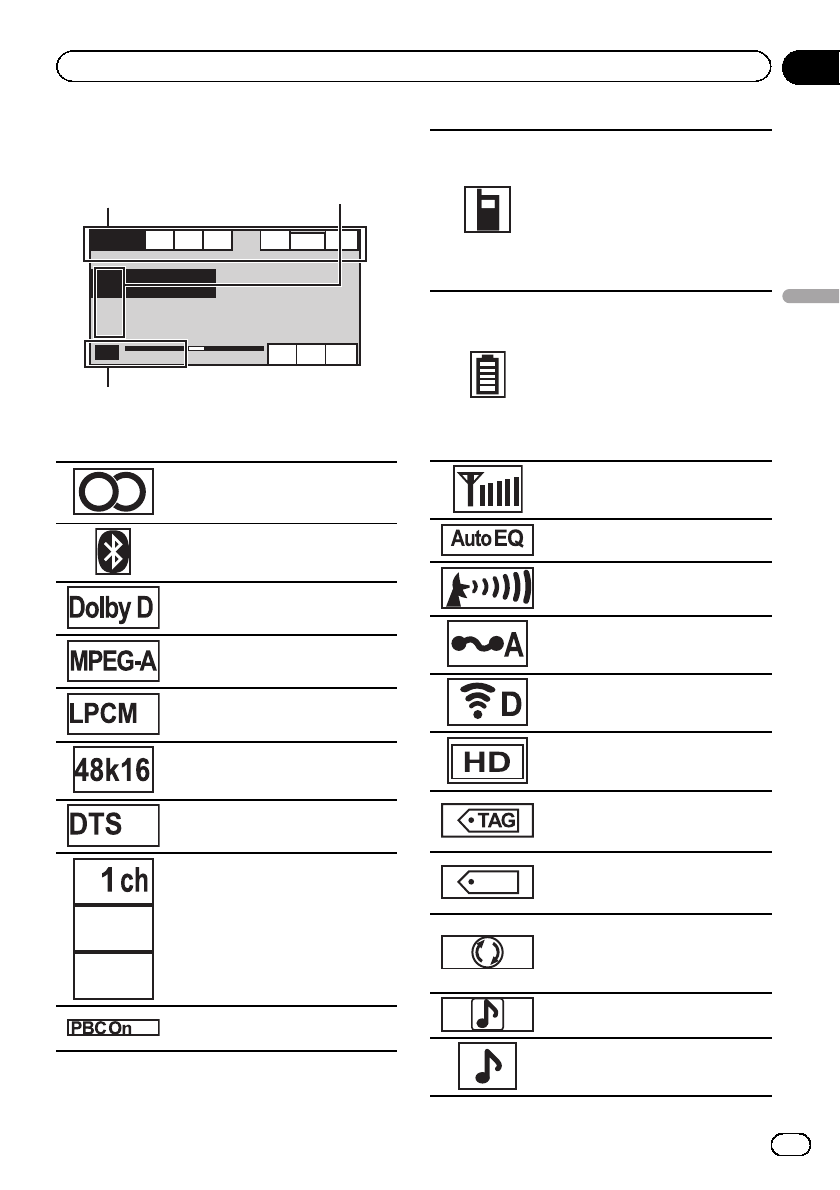
Indicator list
Area 1 Area 2
Area 3
Area 1
Indicates that the selected fre-
quency is being broadcast in
stereo.
Indicates that a Bluetooth tele-
phone is connected.
Indicates that the digital format is
Dolby Digital.
Indicates that the digital format is
MPEG Audio.
Indicates that the digital format is
Linear PCM.
Indicates the sampling frequency.
Indicates that the digital format is
DTS.
2
ch
Mch
Indicates the audio channel.
Indicates that a disc with PBC On
is being played.
!Indicates that a cellular phone
is connected.
!Indicates that an incoming call
has been received and has not
been checked yet.
!Not displayed for calls made
when your cellular phone is
disconnected from this unit.
Indicates the battery strength of
the cellular phone.
!The level shown on the indica-
tor may differ from the actual
battery strength.
!If the battery strength is not
available, nothing is displayed
in the battery strength indica-
tor area.
Indicates the signal strength of the
cellular phone.
Indicates that Auto EQ is on.
Shows when HD Radio signal is re-
ceived.
Shows when analog audio of HD
Radio signal is received.
Shows when digital audio of HD
Radio signal is received.
Shows when HD Radio station in-
formation is received.
Shows when downloadable song
information (tag) from a radio sta-
tion is received.
Shows when song information
(tag) from an HD Radio station is
being saved to this unit.
Shows while searching a song/
video in alphabet search mode.
Shows when song information
(tag) is being saved to your iPod.
Shows when this unit has the song
information (tag).
Shows which audio language has
been selected.
En 91
Appendix
Additional Information
Additional Information
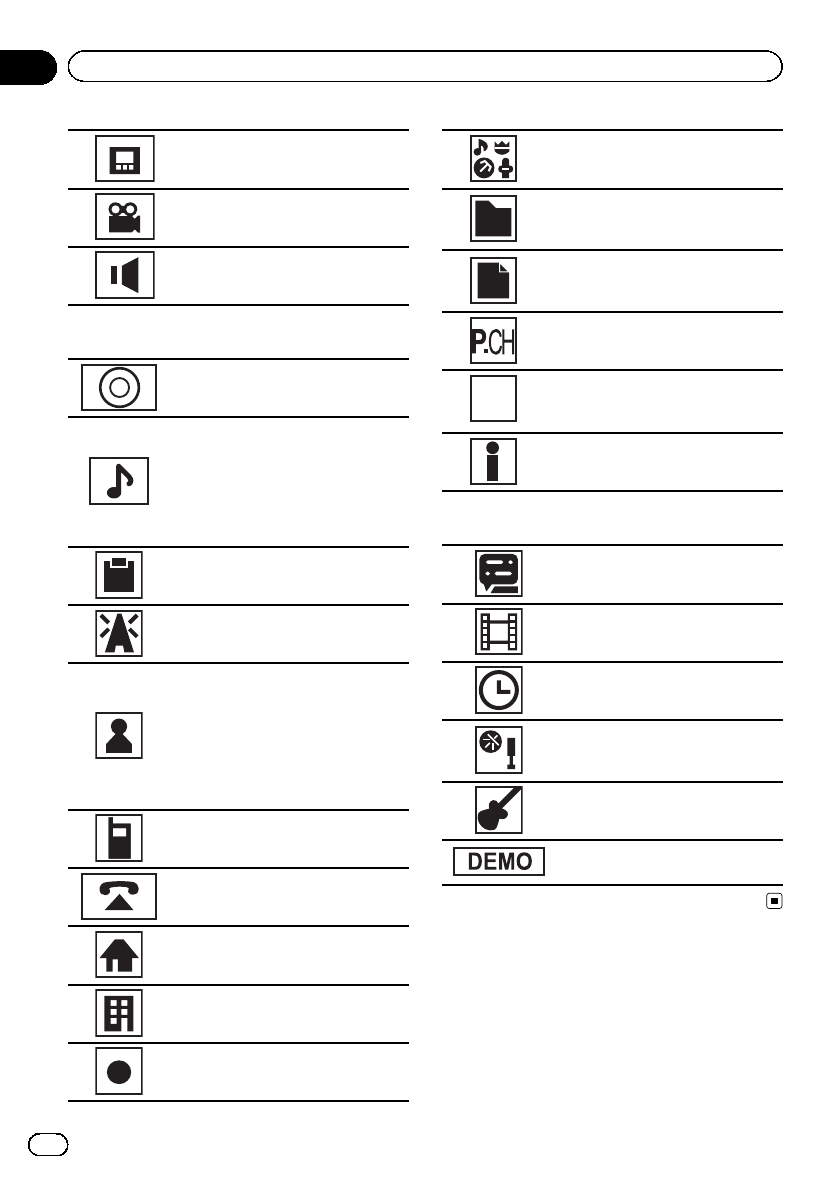
Shows which subtitle language
has been selected.
Shows which viewing angle has
been selected.
Shows which audio output has
been selected.
Area 2
Shows the disc title of the CD text
disc currently being played.
Shows the song title when receiving
the tag information.
Shows the track title of the track cur-
rently being played for CD text discs.
Shows the song title of the song cur-
rently being played for MP3/WMA/
AAC files.
Shows the comment currently being
played.
Shows the station name currently
tuned in to.
Shows the artist name when receiv-
ing the tag information.
Shows the artist name of the track/
song currently being played for CD
text discs.
Shows the artist name of the artist
currently being played for MP3/
WMA/AAC files.
Shows cellular phone information.
Shows general phone information.
Shows home phone information.
Shows office phone information.
Shows other phone information.
Shows the category name.
Shows the folder name of the folder
containing the MP3/WMA/AAC file
currently being played.
Shows the file name of the MP3/
WMA/AAC file currently being
played.
Shows the preset number of the sta-
tion currently being tuned in to.
CH
Shows the channel currently being
tuned in to.
Shows SIRIUS information.
Area 3
Shows the title number currently
being played.
Shows the chapter number cur-
rently being played.
Shows the replay time currently
being played.
Shows when the game alert func-
tion is on while receiving SIRIUS
stations.
Shows the genre of the track/song
currently being played.
Indicates that the feature demo is
on.
En
92
Appendix
Additional Information
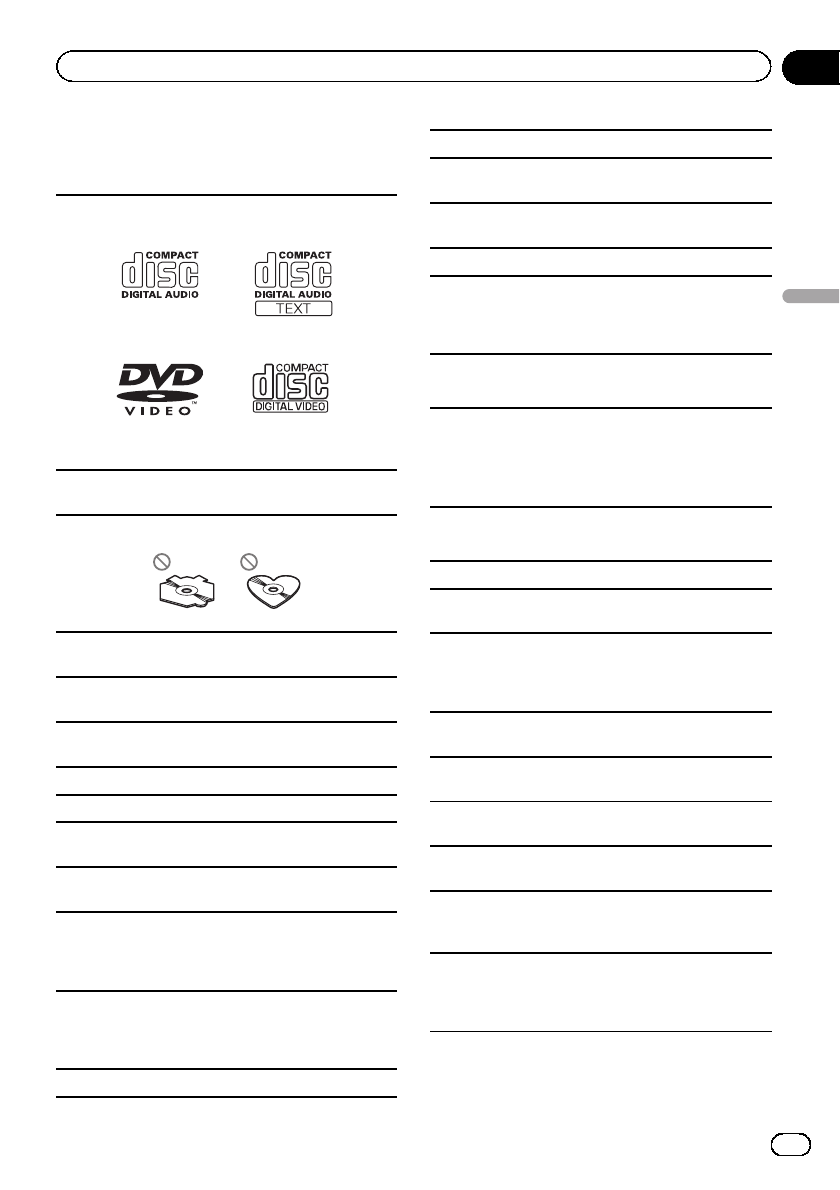
Handling guidelines
Discs and player
Use only discs featuring any of following logos.
Use 12-cm discs. Do not use 8-cm discs or an adapter
for 8-cm discs.
Use only conventional, fully circular discs. Do not use
shaped discs.
Do not insert anything other than a DVD (-R/-RW) or
CD (-R/-RW) into the disc loading slot.
Do not use cracked, chipped, warped, or otherwise
damaged discs as they may damage the player.
Unfinalized CD-R/CD-RW discs cannot be played
back.
Do not touch the recorded surface of the discs.
Store discs in their cases when not in use.
Do not attach labels, write on or apply chemicals to
the surface of the discs.
To clean a disc, wipe the disc with a soft cloth out-
ward from the center.
Condensation may temporarily impair the player’s
performance. Let it rest for about one hour to adjust
to a warmer temperature. Also, wipe any damp discs
off with a soft cloth.
Playback of discs may not be possible because of
disc characteristics, disc format, recorded applica-
tion, playback environment, storage conditions, and
so on.
Road shocks may interrupt disc playback.
Read the precautions for discs before using them.
Certain functions may not be available for some DVD
video discs.
It may not be possible to play back some DVD video
discs.
It is not possible to play back DVD-RAM discs.
This unit is not compatible with discs recorded in
AVCHD (Advanced Video Codec High Definition) for-
mat. Do not insert AVCHD discs as you may not be
able to eject the disc.
External storage device (USB, SD)
Depending on the external storage device (USB, SD),
the following problems may occur.
!Operations may vary.
!The storage device may not be recognized.
!Files may not be played back properly.
USB storage device
Connections via USB hub are not supported.
Do not connect anything other than a USB storage
device.
Firmly secure the USB storage device when driving.
Do not let the USB storage device fall onto the floor,
where it may become jammed under the brake or ac-
celerator pedal.
Depending on the USB storage device, the device
may cause noise to occur in the radio.
Copyright protected files that are stored in the USB
devices cannot be played back.
You cannot connect a USB portable audio player/USB
memory to this unit via USB hub.
Partitioned USB memory is not compatible with this
unit.
Depending on the kind of USB portable audio player/
USB memory you use, the device may not be recog-
nized or audio files may not be played back properly.
Do not leave the USB portable audio player/USB
memory in direct sunlight for extended amounts of
time. Doing so may cause the device to malfunction
from the extreme rise in temperature.
En 93
Appendix
Additional Information
Additional Information

SD memory card
This unit supports only the following types of SD
memory cards.
!SD
!SDHC
Keep the SD memory card out of the reach of chil-
dren. Should the SD memory card be swallowed, con-
sult a doctor immediately.
Do not touch the connectors of the SD memory card
directly with your fingers or with any metal device.
Do not insert anything other than an SD memory card
into the SD card slot. If a metal object (such as a
coin) is inserted into the slot, the internal circuits may
break and cause malfunctions.
Do not insert a damaged SD memory card (e.g.
warped, label peeled off) as it may not be ejected
from the slot.
Do not try to force an SD memory card into the SD
card slot as the card or this unit may be damaged.
When ejecting an SD memory card, press it and hold
it until it clicks. It is dangerous for you to release your
finger immediately after you press on the card as the
card may shoot out of the slot and hit you in the face,
etc. If the card shoots out of the slot, it may become
lost.
iPod
To ensure proper operation, connect the dock connec-
tor cable from the iPod directly to this unit.
Firmly secure the iPod when driving. Do not let the
iPod fall onto the floor, where it may become jammed
under the brake or accelerator pedal.
About iPod settings
!When an iPod is connected, this unit changes the
EQ (equalizer) setting of the iPod to off in order to
optimize the acoustics. When you disconnect the
iPod, the EQ returns to the original setting.
!You cannot set Repeat to off on the iPod when
using this unit. Repeat is automatically changed
to All when the iPod is connected to this unit.
Incompatible text saved on the iPod will not be dis-
played by the unit.
DVD-R/DVD-RW discs
Unfinalized DVD-R/-RW discs which have been re-
corded in the Video format (video mode) cannot be
played back.
Playback of DVD-R/DVD-RW discs may not be possi-
ble, due to disc characteristics, scratches or dirt on
the disc, or dirt, condensation, etc. on the lens of this
unit.
Depending on the application settings and the envir-
onment, playback of discs recorded on a personal
computer may not be possible. (For details, contact
the manufacturer of the application.)
CD-R/CD-RW discs
When CD-R/CD-RW discs are used, playback is possi-
ble only for discs which have been finalized.
Playback of CD-R/CD-RW discs recorded on a music
CD recorder or a personal computer may not be pos-
sible due to disc characteristics, scratches or dirt on
the disc, or dirt, condensation, etc., on the lens of this
unit.
Depending on the application settings and the envir-
onment, playback of discs recorded on a personal
computer may not be possible. (For details, contact
the manufacturer of the application.)
Playback of CD-R/CD-RW discs may become impossi-
ble in case of direct exposure to sunlight, high tem-
peratures, or the storage conditions in the vehicle.
Titles and other text information recorded on a CD-R/
CD-RW disc may not be displayed by this unit (in the
case of audio data (CD-DA)).
DualDiscs
DualDiscs are two-sided discs that have a recordable
CD for audio on one side and a recordable DVD for
video on the other.
Playback of the DVD side is possible with this unit.
However, since the CD side of DualDiscs is not physi-
cally compatible with the general CD standard, it may
not be possible to play the CD side with this unit.
Frequent loading and ejecting of a DualDisc may re-
sult in scratches on the disc. Serious scratches can
lead to playback problems on this unit. In some
cases, a DualDisc may become stuck in the disc load-
ing slot and will not eject. To prevent this, we recom-
mend you refrain from using DualDisc with this unit.
Please refer to the information from the disc manu-
facturer for more detailed information about
DualDiscs.
En
94
Appendix
Additional Information

JPEG picture files
JPEG is short for Joint Photographic Experts Group
and refers to a still image compression technology
standard.
Files are compatible with Baseline JPEG and EXIF 2.1
still images up to a resolution of 8 192 × 7 680. (EXIF
format is used most commonly with digital still cam-
eras.)
Playback of EXIF format files that were processed by a
personal computer may not be possible.
There is no progressive JPEG compatibility.
DivX video files
Depending on the composition of the file information,
such as the number of audio streams or file size,
there may be a slight delay when playing back discs.
Some special operations may be prohibited due to
the composition of the DivX files.
Only DivX files downloaded from a DivX partner site
are guarantee for proper operation. Unauthorized
DivX files may not operate properly.
DRM rental files cannot be operated until playback is
started.
Recommended file size: 2 Mbps or less with a trans-
mission rate of 2 GB or less.
The ID code of this unit must be registered to a DivX
VOD provider in order to playback DivX VOD files. For
information on ID codes, refer to Displaying the DivXâ
VOD registration code on page 59.
For more details about DivX, visit the following site:
http://www.divx.com/
Important
!When naming a JPEG image file, add the cor-
responding filename extension (.jpg, .jpeg, .
jpe or .jfif).
!This unit plays back files with these filename
extensions (.jpg, .jpeg, .jpe or .jfif) as a JPEG
image file. To prevent malfunctions, do not
use these extensions for files other than JPEG
image files.
Compressed audio
compatibility (disc, USB, SD)
WMA
File extension: .wma
Bit rate: 5 kbps to 320 kbps (CBR), VBR
Sampling frequency: 8 kHz to 48 kHz
Windows Media Audio Professional, Lossless, Voice/
DRM Stream/Stream with video: Not compatible
MP3
File extension: .mp3
Bit rate: 8 kbps to 320 kbps
Sampling frequency: 8 kHz to 48 kHz (32 kHz, 44.1 kHz,
48 kHz for emphasis)
Compatible ID3 tag version: 1.0, 1.1, 2.2, 2.3 (ID3 tag
Version 2.x is given priority over Version 1.x.)
M3u playlist: Not compatible
MP3i (MP3 interactive), mp3 PRO: Not compatible
AAC
Compatible format: AAC encoded by iTunes
File extension: .m4a
Sampling frequency: 8 kHz to 44.1 kHz
Bit rate: 8 kbps to 320 kbps
Apple Lossless: Not compatible
AAC file bought from the iTunes Store (.m4p file ex-
tension): Not compatible
DivX compatibility
Compatible format: DivX video format implemented in
relation to DivX standards
File extensions: .avi or .divx
DivX Ultra format: Not compatible
DivX HD format: Not compatible
DivX files without video data: Not compatible
DivX plus HD format: Not compatible
Compatible audio codec: MP2, MP3, Dolby Digital
En 95
Appendix
Additional Information
Additional Information

LPCM: Not compatible
Bit rate: 8 kbps to 320 kbps (CBR), VBR
Sampling frequency: 8 kHz to 48 kHz
Compatible external subtitle file extension: .srt
Supplemental information
Some characters in a file name (including the file ex-
tension) or a folder name may not be displayed.
This unit may not operate correctly depending on the
application used to encode WMA files.
There may be a slight delay at the start of playback of
audio files embedded with image data or audio files
stored on an external storage device (USB/SD) that
has numerous folder hierarchies.
Disc
Playable folders: up to 700
Playable files: up to 999 for CD-R/CD-RW
Playable files: up to 3 500 for DVD-R/DVD-RW
File system: ISO 9660 Level 1 and 2, Romeo, Joliet,
UDF 1.02 (DVD-R/DVD-RW)
Multi-session playback: Compatible
Packet write data transfer: Not compatible
Regardless of the length of blank sections between
the songs from the original recording, compressed
audio discs play with a short pause between songs.
External storage device (USB, SD)
Playable folders: up to 6 000
Playable files: up to 65 535, up to 255 for one folder
Playback of copyright-protected files: Not compatible
Partitioned external storage device (USB, SD): Only
the first playable partition can be played.
There is no compatibility for Multi Media Cards
(MMC).
Compatibility with all SD memory cards is not guaran-
teed.
This unit is not compatible with SD-Audio/SD-Video.
CAUTION
!Pioneer accepts no responsibility for data lost
on the USB memory/USB portable audio
player/SD memory card even if that data is
lost while using this unit.
!Do not leave the discs/external storage device
(USB, SD) or iPod in places with high
temperatures.
iPod compatibility
This unit supports only the following iPod models.
Supported iPod software versions are shown below.
Older versions may not be supported.
!iPhone 4 (software version 4.1)
!iPhone 3GS (software version 4.1)
!iPhone 3G (software version 4.1)
!iPhone (software version 3.1.3)
!iPod nano 6th generation (software version 1.0)
!iPod nano 5th generation (software version 1.0.2)
!iPod nano 4th generation (software version 1.0.4)
!iPod nano 3rd generation (software version 1.1.3)
!iPod nano 2nd generation (software version 1.1.3)
!iPod nano 1st generation (software version 1.3.1)
!iPod touch 4th generation (software version 4.1)
!iPod touch 3rd generation (software version 4.0)
!iPod touch 2nd generation (software version 4.0)
!iPod touch 1st generation (software version 3.1.3)
!iPod classic 160GB (software version 2.0.4)
!iPod classic 120GB (software version 2.0.1)
!iPod classic (software version 1.1.2)
!iPod 5th generation (software version 1.3)
Depending on the generation or version of the iPod,
some functions may not be available.
Operations may vary depending on the software ver-
sion of iPod.
When using an iPod, an iPod Dock Connector to USB
Cable is required.
When you use Pioneer CD-IU50V/CD-IU200V interface
cable, consult your dealer for details.
About the file/format compatibility, refer to the iPod
manuals.
Audio Book, Podcast: Compatible
En
96
Appendix
Additional Information
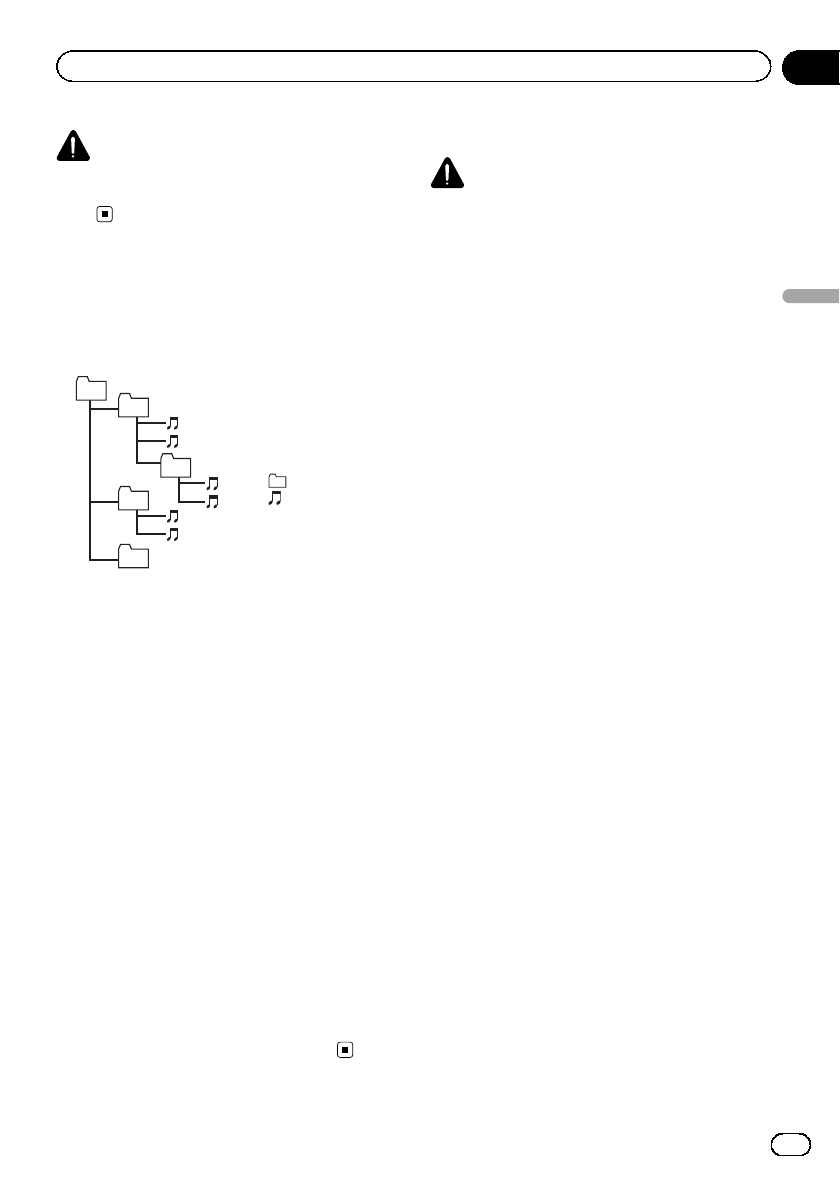
CAUTION
Pioneer accepts no responsibility for data lost on
the iPod, even if that data is lost while this unit is
used.
Sequence of audio files
The user cannot assign folder numbers and
specify playback sequences with this unit.
Example of a hierarchy
Level 1 Level 2 Level 3 Level 4
01
02
03
04
05
: Folder
: Compressed
audio file
01 to 05: Folder
number
1to 6: Playback
sequence
Disc
Folder selection sequence or other operation
may differ depending on the encoding or writ-
ing software.
External storage device (USB, SD)
The playback sequence is the same as the re-
corded sequence in the external storage de-
vice (USB, SD).
To specify the playback sequence, the follow-
ing method is recommended.
1Create a file name that includes numbers that
specify the playback sequence (e.g., 001xxx.
mp3 and 099yyy.mp3).
2Put those files into a folder.
3Save the folder that contains the files to the
external storage device (USB, SD).
However, depending on the system environ-
ment, you may not be able to specify the play-
back sequence.
For USB portable audio players, the sequence
is different and depends on the player.
Using the display correctly
CAUTION
!If liquid or foreign matter should get inside
this unit, turn off the power immediately and
consult your dealer or the nearest authorized
PIONEER Service Station. Do not use the unit
in this condition because doing so may result
in fire, electric shock, or other failure.
!If you notice smoke, a strange noise or smell,
or any other abnormal signs from the display,
turn off the power immediately and consult
your dealer or the nearest authorized
PIONEER Service Station. Using this unit in
this condition may result in permanent da-
mage to the system.
!Do not disassemble or modify this unit, as
there are high-voltage components inside
which may cause electric shock. Be sure to
consult your dealer or the nearest authorized
PIONEER Service Station for internal inspec-
tion, adjustments, or repairs.
Handling the display
!Never touch the screen with anything be-
sides your finger when operating the touch
panel function. The screen can scratch ea-
sily.
!When the display is subjected to direct sun-
light for a long period of time, it will be-
come very hot resulting in possible
damage to the LCD screen. You should
avoid exposing the display unit to direct
sunlight as much as possible.
!The display should be used within the tem-
perature range of –10°C to +60°C (14 °F to
140 °F).
At temperatures higher or lower than this
operating temperature range, the display
may not operate normally.
!The LCD screen is exposed in order to in-
crease its visibility within the vehicle. Do
not press it strongly on it as this may da-
mage it.
!Do not push the LCD screen forcefully as
this may scratch it.
En 97
Appendix
Additional Information
Additional Information
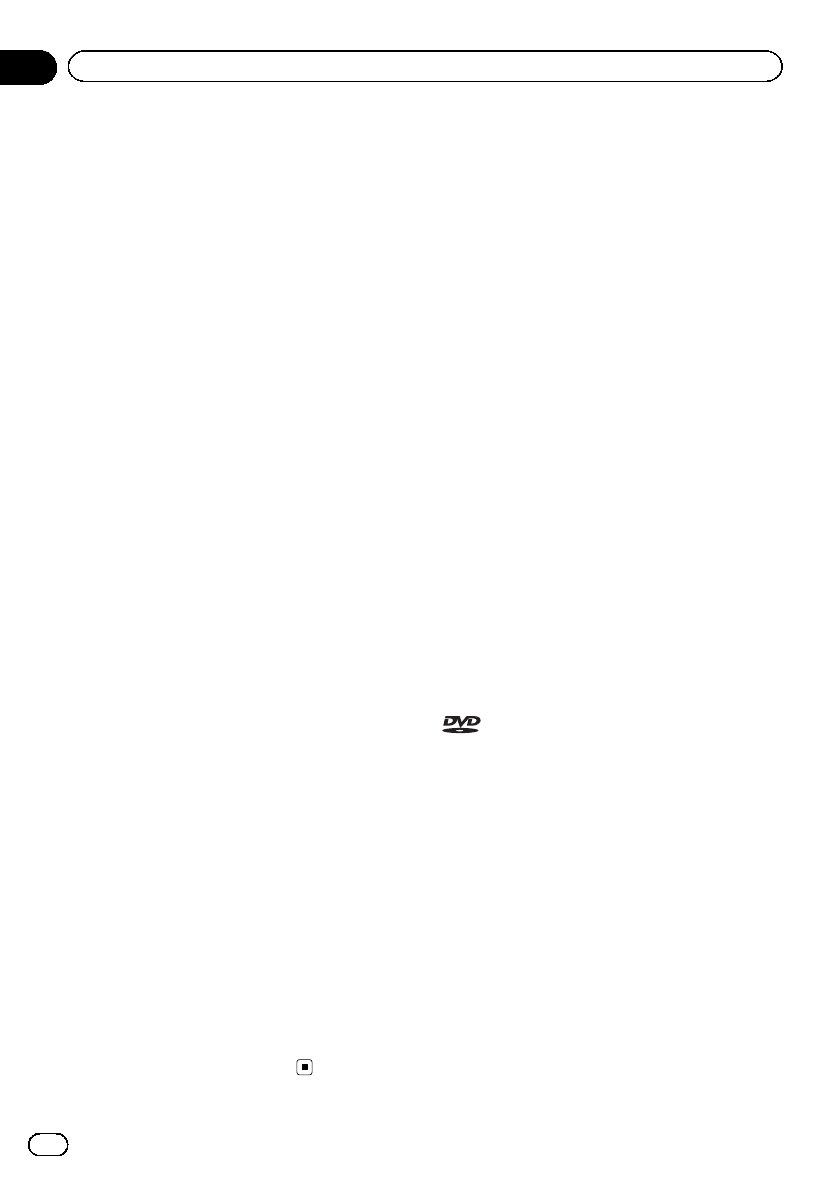
Liquid crystal display (LCD) screen
!Heat from the heater may damage the LCD
screen, and cool air from the cooler may
cause moisture to form inside the display
resulting in possible damage.
!Small black dots or white dots (bright dots)
may appear on the LCD screen. These are
due to the characteristics of the LCD
screen and do not indicate a malfunction.
!When using a cellular phone, keep the an-
tenna away from the display to prevent dis-
ruption of the video image by the
appearance of spots, colored stripes, etc.
LED (light-emitting diode)
backlight
!At low temperatures, using the LED back-
light may increase image lag and degrade
the image quality due to the characteristics
of the LCD screen. Image quality will im-
prove with an increase in temperature.
!To protect the LED backlight, the display
will darken in the following environments:
—In the direct sunlight
—Near the heater vent
!The product lifetime of the LED backlight is
more than 10 000 hours. However, it may
decrease if used in high temperatures.
!If the LED backlight reaches the end of its
product lifetime, the screen will become
dark and the image will no longer be pro-
jected. In such cases, please consult your
dealer or the nearest authorized PIONEER
Service Station.
Keeping the display in good
condition
!When removing dust from the screen or
cleaning the display, first turn the system
power off, then wipe with a soft dry cloth.
!When wiping the screen, take care not to
scratch the surface. Do not use harsh or
abrasive chemical cleaners.
Copyright and trademark
This item incorporates copy protection tech-
nology that is protected by U.S. patents and
other intellectual property rights of Rovi
Corporation. Reverse engineering and disas-
sembly are prohibited.
Bluetooth
The Bluetoothâword mark and logos are regis-
tered trademarks owned by Bluetooth SIG, Inc.
and any use of such marks by Pioneer
Corporation is under license. Other trade-
marks and trade names are those of their re-
spective owners.
!Bluetooth is a short-range wireless radio
connectivity technology that is developed
as a cable replacement for mobile phones,
handheld PCs and other devices. Bluetooth
operates in 2.4 GHz frequency range and
transmits voice and data at speeds up to 1
megabit per second. Bluetooth was
launched by a special interest group (SIG)
that comprises of Ericsson Inc., Intel Corp.,
Nokia Corp., Toshiba and IBM in 1998, and
it is currently developed by nearly 2 000
companies worldwide.
DVD video
is a trademark of DVD Format/Logo
Licensing Corporation.
iTunes
Apple and iTunes are trademarks of Apple
Inc., registered in the U.S. and other coun-
tries.
En
98
Appendix
Additional Information
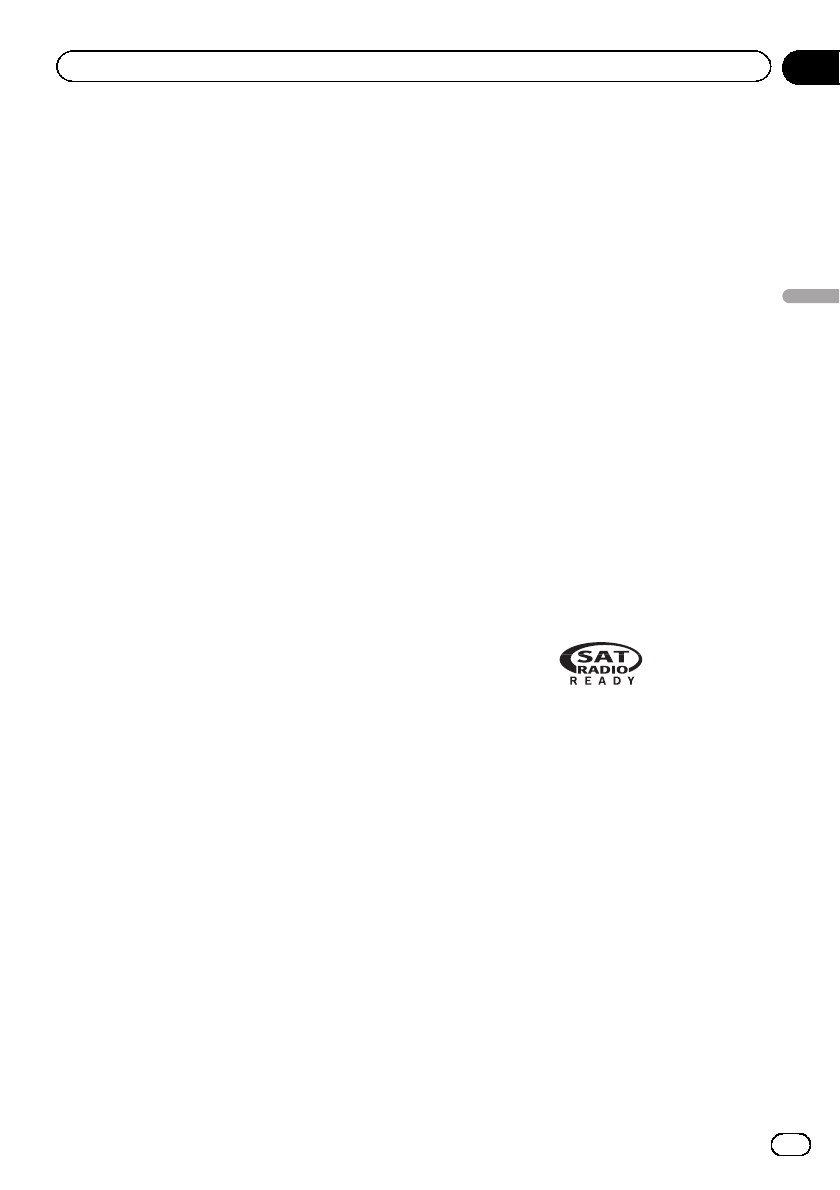
MP3
Supply of this product only conveys a license
for private, non-commercial use and does not
convey a license nor imply any right to use
this product in any commercial (i.e. revenue-
generating) real time broadcasting (terrestrial,
satellite, cable and/or any other media), broad-
casting/streaming via internet, intranets and/
or other networks or in other electronic con-
tent distribution systems, such as pay-audio or
audio-on-demand applications. An indepen-
dent license for such use is required. For de-
tails, please visit
http://www.mp3licensing.com.
WMA
Windows Media is either a registered trade-
mark or trademark of Microsoft Corporation in
the United States and/or other countries.
This product includes technology owned by
Microsoft Corporation and cannot be used or
distributed without a license from Microsoft
Licensing, Inc.
SD memory card
SD Logo is a trademark of SD-3C, LLC.
SDHC Logo is a trademark of SD-3C, LLC.
iPod & iPhone
iPhone, iPod, iPod classic, iPod nano, and
iPod touch are trademarks of Apple Inc., regis-
tered in the U.S. and other countries.
“Made for iPod”and “Made for iPhone”mean
that an electronic accessory has been de-
signed to connect specifically to iPod or
iPhone, respectively, and has been certified by
the developer to meet Apple performance
standards.
Apple is not responsible for the operation of
this device or its compliance with safety and
regulatory standards.
Please note that the use of this accessory with
iPod or iPhone may affect wireless perfor-
mance.
Dolby Digital
Manufactured under license from Dolby
Laboratories. “Dolby”and the double-D symbol
are trademarks of Dolby Laboratories.
DivX
DivXâis a registered trademark of DivX, Inc.,
and is used under license.
ABOUT DIVX VIDEO: DivXâis a digital
video format created by DivX, Inc. This is an of-
ficial DivX Certifiedâdevice that plays DivX
video. Visit divx.com for more information and
software tools to convert your files into DivX
video.
ABOUT DIVX VIDEO-ON-DEMAND: This
DivX Certifiedâdevice must be registered in
order to play purchased DivX Video-on-De-
mand (VOD) movies. To obtain your registra-
tion code, locate the DivX VOD section in
Menu operations. Go to vod.divx.com for more
information on how to complete your registra-
tion.
About the SAT RADIO READY mark
The SAT RADIO READY mark indicates that
the Satellite Radio Tuner for Pioneer (i.e., XM
tuner and Sirius satellite tuner which are sold
separately) can be controlled by this unit.
Please inquire to your dealer or nearest
authorized Pioneer service station regarding
the satellite radio tuner that can be connected
to this unit. For satellite radio tuner operation,
please refer to the satellite radio tuner owner’s
manual.
!The system will use direct satellite-to-recei-
ver broadcasting technology to provide lis-
teners in their cars and at home with
crystal-clear sound seamlessly from coast
to coast. Satellite radio will create and
package over 100 channels of digital-quality
music, news, sports, talk and children’s
programming.
En 99
Appendix
Additional Information
Additional Information

!“SAT Radio”, the SAT Radio logo and all re-
lated marks are trademarks of Sirius Satel-
lite Radio Inc., and XM Satellite Radio Inc.
HD RadioäTechnology
!This HD Radio Ready receiver is ready to re-
ceive HD Radio broadcasts when con-
nected to the HD Radio tuner (e.g. GEX-
P20HD), sold separately.
HD Radioä, HD Radio Readyä, and the
HD Radio Ready logo are proprietary trade-
marks of iBiquity Digital Corporation.
En
100
Appendix
Additional Information

Language code chart for DVD
Language (code), input code
Japanese (ja), 1001 Dzongkha (dz), 0426 Kurdish (ku), 1121 Kinyarwanda (rw), 1823
English (en), 0514 Ewe (ee), 0505 Komi (kv), 1122 Sanskrit (sa), 1901
French (fr), 0618 Esperanto (eo), 0515 Cornish (kw), 1123 Sardinian (sc), 1903
Spanish (es), 0519 Estonian (et), 0520 Kirghiz, Kyrgyz (ky), 1125 Sindhi (sd), 1904
German (de), 0405 Basque (eu), 0521 Latin (la), 1201 Northern Sami (se), 1905
Italian (it), 0920 Persian (fa), 0601 Luxembourgish (lb), 1202 Sangho (sg), 1907
Chinese (zh), 2608 Fulah (ff), 0606 Ganda (lg), 1207 Sinhala (si), 1909
Dutch, Flemish (nl), 1412 Finnish (fi), 0609 Limburgan (li), 1209 Slovak (sk), 1911
Portuguese (pt), 1620 Fijian (fj), 0610 Lingala (ln), 1214 Slovenian (sl), 1912
Swedish (sv), 1922 Faroese (fo), 0615 Lao (lo), 1215 Samoan (sm), 1913
Russian (ru), 1821 Western Frisian (fy), 0625 Lithuanian (lt), 1220 Shona (sn), 1914
Korean (ko), 1115 Irish (ga), 0701 Luba-Katanga (lu), 1221 Somali (so), 1915
Greek (el), 0512 Gaelic (gd), 0704 Latvian (lv), 1222 Albanian (sq), 1917
Afar (aa), 0101 Galician (gl), 0712 Malagasy (mg), 1307 Serbian (sr), 1918
Abkhazian (ab), 0102 Guarani (gn), 0714 Marshallese (mh), 1308 Swati (ss), 1919
Avestan (ae), 0105 Gujarati (gu), 0721 Maori (mi), 1309 Sotho, Southern (st), 1920
Afrikaans (af), 0106 Manx (gv), 0722 Macedonian (mk), 1311 Sundanese (su), 1921
Akan (ak), 0111 Hausa (ha), 0801 Malayalam (ml), 1312 Swahili (sw), 1923
Amharic (am), 0113 Hebrew (he), 0805 Mongolian (mn), 1314 Tamil (ta), 2001
Aragonese (an), 0114 Hindi (hi), 0809 Marathi (mr), 1318 Telugu (te), 2005
Arabic (ar), 0118 Hiri Motu (ho), 0815 Malay (ms), 1319 Tajik (tg), 2007
Assamese (as), 0119 Croatian (hr), 0818 Maltese (mt), 1320 Thai (th), 2008
Avaric (av), 0122 Haitian (ht), 0820 Burmese (my), 1325 Tigrinya (ti), 2009
Aymara (ay), 0125 Hungarian (hu), 0821 Nauru (na), 1401 Turkmen (tk), 2011
Azerbaijani (az), 0126 Armenian (hy), 0825 Bokmal (nb), 1402 Tagalog (tl), 2012
Bashkir (ba), 0201 Herero (hz), 0826 Ndebele, North (nd), 1404 Tswana (tn), 2014
Belarusian (be), 0205 Interlingua (ia), 0901 Nepali (ne), 1405 Tonga (to), 2015
Bulgarian (bg), 0207 Indonesian (id), 0904 Ndonga (ng), 1407 Turkish (tr), 2018
Bihari (bh), 0208 Interlingue (ie), 0905 Nynorsk (nn), 1414 Tsonga (ts), 2019
Bislama (bi), 0209 Igbo (ig), 0907 Norwegian (no), 1415 Tatar (tt), 2020
Bambara (bm), 0213 Sichuan Yi (ii), 0909 Ndebele, South (nr), 1418 Twi (tw), 2023
Bengali (bn), 0214 Inupiaq (ik), 0911 Navajo, Navaho (nv), 1422 Tahitian (ty), 2025
Tibetan (bo), 0215 Ido (io), 0915 Chichewa (ny), 1425 Uighur, Uyghur (ug), 2107
Breton (br), 0218 Icelandic (is), 0919 Occitan (oc), 1503 Ukrainian (uk), 2111
Bosnian (bs), 0219 Inuktitut (iu), 0921 Ojibwa (oj), 1510 Urdu (ur), 2118
Catalan (ca), 0301 Javanese (jv), 1022 Oromo (om), 1513 Uzbek (uz), 2126
Chechen (ce), 0305 Georgian (ka), 1101 Oriya (or), 1518 Venda (ve), 2205
Chamorro (ch), 0308 Kongo (kg), 1107 Ossetian (os), 1519 Vietnamese (vi), 2209
Corsican (co), 0315 Kikuyu, Gikuyu (ki), 1109 Panjabi, Punjabi (pa),
1601 Volapük (vo), 2215
Cree (cr), 0318 Kuanyama (kj), 1110 Pali (pi), 1609 Walloon (wa), 2301
Czech (cs), 0319 Kazakh (kk), 1111 Polish (pl), 1612 Wolof (wo), 2315
Church Slavic (cu), 0321 Kalaallisut (kl), 1112 Pashto, Pushto (ps), 1619 Xhosa (xh), 2408
Chuvash (cv), 0322 Central Khmer (km), 1113 Quechua (qu), 1721 Yiddish (yi), 2509
Welsh (cy), 0325 Kannada (kn), 1114 Romansh (rm), 1813 Yoruba (yo), 2515
Danish (da), 0401 Kanuri (kr), 1118 Rundi (rn), 1814 Zhuang, Chuang (za),
2601
Divehi (dv), 0422 Kashmiri (ks), 1119 Romanian (ro), 1815 Zulu (zu), 2621
En 101
Appendix
Additional Information
Additional Information

Specifications
General
Power source ............................. 14.4 V DC (10.8 V to 15.1 V
allowable)
Grounding system ................... Negative type
Maximum current consumption
..................................................... 10.0 A
Dimensions (W × H × D):
D
Chassis ..................... 178 mm × 50 mm ×
165 mm
(7 in. × 2 in. × 6-1/2 in.)
Nose ........................... 170 mm × 46 mm × 27 mm
(6-3/4 in. × 1-3/4 in. × 1 in.)
Weight .......................................... 2.2 kg (4.84 lbs)
Display
Screen size/aspect ratio ....... 7.0 inch wide/16:9
(effective display area:
154.0 mm × 86.9 mm)
Pixels ............................................. 345 600 (1 440 × 240)
Display method ........................ TFT active matrix, driving
type
Color system .............................. NTSC
Durable temperature range (power off)
..................................................... –20 °C to +80 °C
Angle adjustment .................... 50° to 110°
(initial settings: 90°)
Audio
Maximum power output ....... 50 W × 4
70 W × 1/2 W(for subwoo-
fer)
Continuous power output ... 22 W × 4 (1 kHz, 5 % THD, 4
Wload, both channels dri-
ven)
Load impedance ...................... 4W(4 Wto 8 W(2 Wfor 1 ch)
allowable)
Preout maximum output level
..................................................... 4.0 V
Equalizer (8-Band Graphic Equalizer):
Frequency .......................... 40 Hz/80 Hz/200 Hz/400 Hz/
1 kHz/2.5 kHz/8 kHz/10 kHz
Gain ...................................... ±12 dB
HPF:
Frequency .......................... 50 Hz/63 Hz/80 Hz/100 Hz/
125 Hz
Slope .................................... –12 dB/oct
Subwoofer (mono):
Frequency .......................... 50 Hz/63 Hz/80 Hz/100 Hz/
125 Hz
Slope .................................... –18 dB/oct
Gain ...................................... +6 dB to –24 dB
Phase .................................. Normal/Reverse
Bass boost:
Gain ...................................... +12 dB to 0 dB
DVD Player
System .......................................... DVD video, Video CD, CD,
WMA, MP3, AAC, DivX,
JPEG system
Usable discs .............................. DVD video, Video CD, CD,
CD-R/RW, DVD-R/RW/R DL
Region number ........................ 1
Frequency response ............... 5 Hz to 44 000 Hz (with DVD,
at sampling frequency
96 kHz)
Signal-to-noise ratio ............... 96 dB (1 kHz) (IHF-A net-
work) (RCA level)
Output level:
Video .................................... 1.0 Vp-p/75 W(±0.2 V)
Number of channels .............. 2 (stereo)
MP3 decoding format ........... MPEG-1 & 2 Audio Layer 3
WMA decoding format ......... Ver. 7, 7.1, 8, 9, 10, 11, 12
(2 ch audio)
(Windows Media Player)
AAC decoding format ............ MPEG-4 AAC (iTunes en-
coded only) (.m4a)
(Ver. 9.0.3 and earlier)
DivX decoding format ............ Home Theater Ver. 3, 4, 5.2,
6 (.avi, .divx)
USB
USB standard specification
..................................................... USB 1.1, USB 2.0 full speed
Maximum current supply .... 500 mA
USB Class ................................... MSC (Mass Storage Class)
File system .................................. FAT16, FAT32
MP3 decoding format ........... MPEG-1 & 2 Audio Layer 3
WMA decoding format ......... Ver. 7, 7.1, 8, 9, 10, 11, 12
(2 ch audio)
(Windows Media Player)
AAC decoding format ............ MPEG-4 AAC (iTunes en-
coded only)
(Ver. 9.0.3 and earlier)
DivX decoding format ............ Home Theater Ver. 3, 4, 5.2,
6 (.avi, .divx)
SD
Compatible physical format
..................................................... Version 1.1
File system .................................. FAT12, FAT16, FAT32
MP3 decoding format ........... MPEG-1 & 2 Audio Layer 3
WMA decoding format ......... Ver. 7, 7.1, 8, 9, 10, 11, 12
(2 ch audio)
(Windows Media Player)
En
102
Appendix
Additional Information
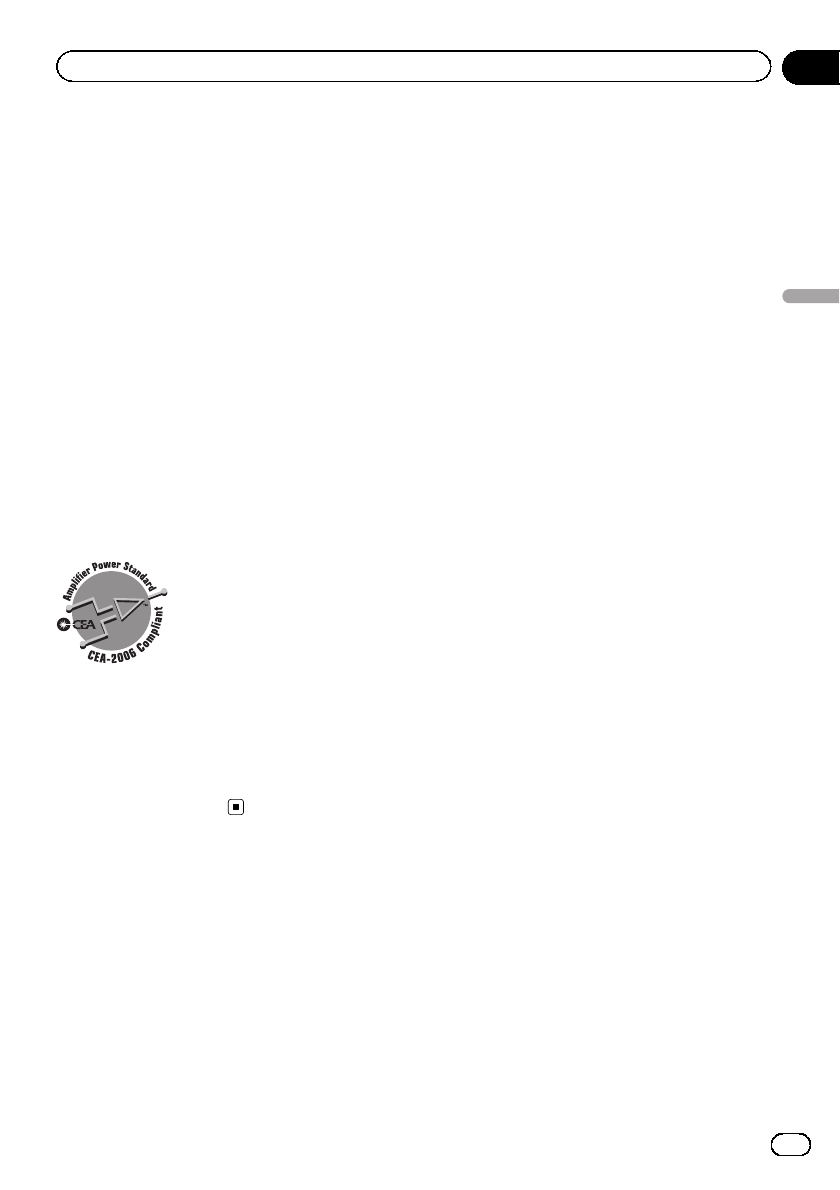
AAC decoding format ............ MPEG-4 AAC (iTunes en-
coded only)
(Ver. 9.0.3 and earlier)
DivX decoding format ............ Home Theater Ver. 3, 4, 5.2,
6 (.avi, .divx)
FM tuner
Frequency range ...................... 87.9 MHz to 107.9 MHz
Usable sensitivity ..................... 9 dBf (0.8 µV/75 W, mono,
S/N: 30 dB)
Signal-to-noise ratio ............... 72 dB (IHF-A network)
AM tuner
Frequency range ...................... 530 kHz to 1 710 kHz
(10 kHz)
Usable sensitivity ..................... 25 µV (S/N: 20 dB)
Signal-to-noise ratio ............... 62 dB (IHF-A network)
Bluetooth
Version .......................................... Bluetooth 2.0 certified
Output power ............................ +4 dBm Maximum
(Power class 2)
CEA2006 Specifications
Power output ............................. 14 W RMS × 4 Channels
(4 Wand ≦1 % THD+N)
S/N ratio ....................................... 91 dBA (reference: 1 W into
4W)
Note
Specifications and the design are subject to mod-
ifications without notice.
En 103
Appendix
Additional Information
Additional Information
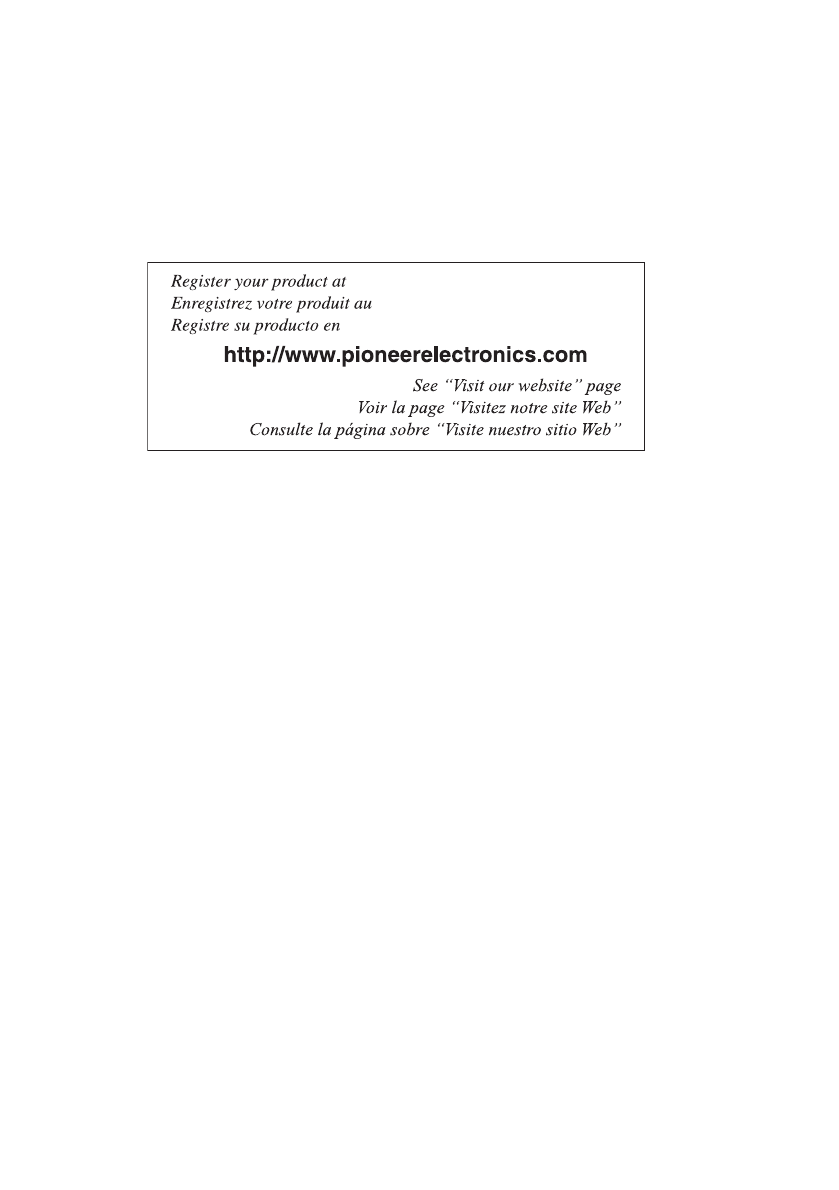
PIONEER CORPORATION
1-1, Shin-ogura, Saiwai-ku, Kawasaki-shi,
Kanagawa 212-0031, JAPAN
PIONEER ELECTRONICS (USA) INC.
P.O. Box 1540, Long Beach, California 90801-1540, U.S.A.
TEL: (800) 421-1404
PIONEER EUROPE NV
Haven 1087, Keetberglaan 1, B-9120 Melsele, Belgium/Belgique
TEL: (0) 3/570.05.11
PIONEER ELECTRONICS ASIACENTRE PTE. LTD.
253 Alexandra Road, #04-01, Singapore 159936
TEL: 65-6472-7555
PIONEER ELECTRONICS AUSTRALIA PTY. LTD.
5 Arco Lane, Heatherton, Victoria, 3202 Australia
TEL: (03) 9586-6300
PIONEER ELECTRONICS OF CANADA, INC.
300 Allstate Parkway, Markham, Ontario L3R 0P2, Canada
TEL: 1-877-283-5901
TEL: 905-479-4411
PIONEER ELECTRONICS DE MEXICO, S.A. de C.V.
Blvd.Manuel Avila Camacho 138 10 piso
Col.Lomas de Chapultepec, Mexico, D.F. 11000
TEL: 55-9178-4270
先鋒股份有限公司
台北市內湖區瑞光路407號8樓
電話:(02) 2657-3588
先鋒電子(香港)有限公司
香港九龍尖沙咀海港城世界商業中心
9樓901-6室
電話:(0852) 2848-6488
Published by Pioneer Corporation.
Copyright ã2010 by Pioneer Corporation.
All rights reserved.
Printed in Thailand
<CRB3570-A/N> UC
<KOMZX> <10K00000>
